March of the Machine Release Notes
Compiled by Jess Dunks, Eric Levine, and Matt Tabak
Document last modified March 13, 2023
PDF Download Links:
English | 中国话,汉语;中文 | Français | Deutsch
Italiano | Português | Español | 日本語
The Release Notes include information concerning the release of a new Magic: The Gathering set, as well as a collection of clarifications and rulings involving that set's cards. It's intended to make playing with the new cards more fun by clearing up the common misconceptions and confusion inevitably caused by new mechanics and interactions. As future sets are released, updates to the Magic rules may cause some of this information to become outdated. Go to Magic.Wizards.com/Rules to find the most up-to-date rules.
The "General Notes" section includes information about card legality and explains some of the mechanics and concepts in the set.
The "Card-Specific Notes" sections contain answers to the most important, most common, and most confusing questions players might ask about cards in the set. Items in the "Card-Specific Notes" sections include full card text for your reference. Not all cards in the set are listed.
GENERAL NOTES
Card Legality
March of the Machine cards with the expansion code MOM are permitted in the Standard, Pioneer, and Modern formats, as well as in Commander and other formats. At the time of the set's Prerelease events, the following card sets will be permitted in the Standard format: Innistrad: Midnight Hunt, Innistrad: Crimson Vow, Streets of New Capenna, Kamigawa: Neon Dynasty, Dominaria United, The Brothers' War, Phyrexia: All Will Be One, and March of the Machine.
March of the Machine Commander cards with the expansion code MOC and numbered 1–79 (and their alternate versions numbered 80–138) are permitted in the Commander, Legacy, and Vintage formats. Returning cards with the expansion code MOC and numbered 139–444 are legal for play in any format that already allows those cards.
Three new March of the Machine Prerelease promo cards with expansion code MOC and numbered 445–447 (and their alternate versions numbered 448–450) are permitted in the Commander, Legacy, and Vintage formats.
There are 65 returning cards with the MUL set code numbered 1–65 that are part of the Multiverse Legends supplementary set. These returning cards are legal for play in any format that already allows those cards. Additionally, Multiverse Legends cards that are opened in a Sealed Deck event are part of your card pool. The same is true for any that are drafted in a Draft event.
Go to Magic.Wizards.com/Formats for a complete list of formats and their permitted card sets and banned lists.
Go to Magic.Wizards.com/Commander for more information on the Commander variant.
Go to Locator.Wizards.com to find an event or store near you.
New Card Type: Battles
Returning Mechanic: Transforming Double-Faced Cards
Phyrexians are invading the whole Multiverse at once, and March of the Machine is representing that with battle cards, a new type of permanent card that can be attacked, like planeswalkers. The battles in this set are all Sieges, the first battle subtype.

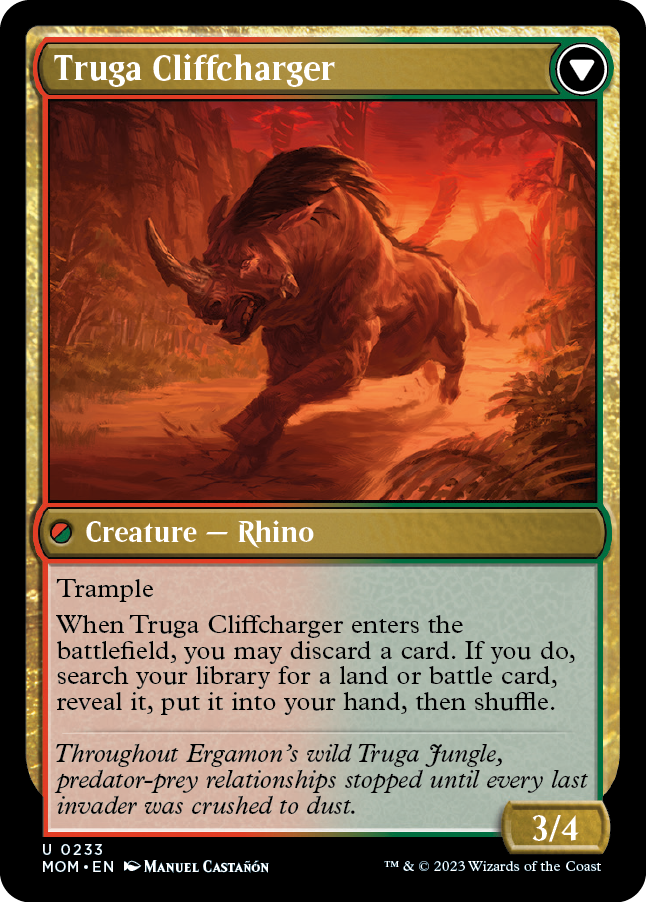
Invasion of Ergamon
{R}{G}
Battle — Siege
5
(As a Siege enters, choose an opponent to protect it. You and others can attack it. When it's defeated, exile it, then cast it transformed.)
When Invasion of Ergamon enters the battlefield, create a Treasure token. Then you may discard a card. If you do, draw a card.
////
Truga Cliffcharger
Creature — Rhino
3/4
Trample
When Truga Cliffcharger enters the battlefield, you may discard a card. If you do, search your library for a land or battle card, reveal it, put it into your hand, then shuffle.
Battles begin the game in your deck and can be cast as a spell during their controller's main phase when the stack is empty. They enter the battlefield with a number of defense counters on them equal to the defense value displayed in the lower righthand corner of the card. Damage can be dealt to battles, and damage dealt to a battle causes it to lose that many defense counters. It is defeated when the last defense counter is removed from it. Siege battles, like the ones in March of the Machine, have an inherent ability that triggers when they are defeated. When that ability resolves, the Siege's controller exiles it and may cast it transformed without paying its mana cost. Notably, battles can be the target of spells and abilities that use the words "any target." For example, a player can target a battle with Lightning Bolt.
Sieges and Combat
Like planeswalkers, battles can be attacked, but there is an important difference. As a battle enters the battlefield, its controller chooses a player to be its protector. For a Siege, the protector must be one of that player's opponents. That battle's protector acts as its defending player in combat, and all other players in the game can attack the battle. That's right, this means that a Siege's controller can attack it with their creatures, and the opponent they chose as its protector can assign their own creatures to block those attackers. Any rule or effect that needs to determine the defending player in relation to a battle refers to that battle's protector rather than its controller. A battle's protector can never attack it, and no other players can block for it, including its controller.
Otherwise, attacking a Siege works the same way that attacking a player or planeswalker works. As a player declares a creature as an attacker, they may choose to have it attack a battle if its protector (not its controller) is a defending player. In most games, this means everyone other than the battle's protector can attack it. If they do, then as blockers are declared in the combat phase, that battle's protector chooses which, if any, creatures they control will block that attacking creature. If the creature is blocked, the attacking and blocking creature deal combat damage to each other as normal. If the creature is unblocked, the attacking creature deals combat damage to the battle it is attacking. If the attacking creature has trample, it must first assign lethal damage to the blocking creature, but then any excess damage may be assigned to that battle.
Below is some more detailed general info about how battles and Sieges work. This section will repeat some of the information above for completeness. Even more detailed information will be available in the Magic Comprehensive Rules.
- Battle is a new card type. Siege is a battle subtype. Sieges have some special rules that limit who can protect them, and they let their controller exile them and cast them transformed when they are defeated. All battles that currently exist are Sieges, but future battles may have different subtypes with different rules about who can protect them and what happens when they are defeated.
- Sieges each have an intrinsic triggered ability. That ability is "When the last defense counter is removed from this permanent, exile it, then you may cast it transformed without paying its mana cost."
- As a Siege enters the battlefield, its controller chooses an opponent to be its protector.
- A Siege's controller can't be its protector. If a Siege's protector ever gains control of it, they choose a new player to be its protector. This is a state-based action.
- If a non-battle permanent that is already on the battlefield become a copy of a Siege, its controller chooses one of their opponents to be that battle's protector. However, it will most likely be put into its owner's graveyard because it has no defense counters (see below).
- A battle's "defense" is displayed in the bottom right corner of the card. A battle enters the battlefield with that number of defense counters. If another permanent enters the battlefield as a copy of a battle, it also enters with that number of defense counters.
- Only creatures controlled by a battle's protector can block creatures that are attacking that battle. This means a Siege's controller can never assign creatures to block for it.
- A battle can be dealt damage and be target of spells and/or abilities that target "any target."
- Damage dealt to a battle causes that many defense counters to be removed from it.
- A battle can be attacked by all players other than its protector. Notably, this means a Siege's controller can attack it.
- If a battle has no defense counters, and it isn't the source of a triggered ability that has triggered but not yet left the stack, that battle is put into its owner's graveyard. This is a state-based action. This doesn't cause a Siege's intrinsic triggered ability to trigger.
- Notably, if a Siege never had defense counters on it (perhaps because a permanent became a copy of one), it can't have its last defense counter removed. It will be put into its owner's graveyard. You won't exile it or cast the other face.
- If a token or a card that isn't represented by a transforming double-faced card becomes a copy of a Siege, it can't be cast as its triggered ability resolves. It will remain in exile. If it's a token, it will cease to exist the next time state-based actions are performed.
- If a permanent that is represented by a transforming double-faced card becomes a copy of a Siege, it will be exiled as that Siege's triggered ability resolves, then it will be cast transformed. Note that this applies only to transforming double-faced cards, not to modal double-faced cards that can normally be played using either face.
- In a multiplayer game, if the protector of a battle leaves the game and that battle is not currently being attacked, its controller chooses a new protector for it as a state-based action. If it is being attacked, its controller chooses a new protector for it once no creatures are attacking it. This means that it continues to be attacked and can be dealt combat damage as normal.
- If a battle that's being attacked somehow stops being a battle, it is removed from combat. Similarly, if its controller changes in the middle of combat, it is removed from combat.
- Battles can't attack or block, even if one also becomes a creature. If an attacking or blocking creature somehow becomes a battle in addition to being a creature, it is removed from combat.
New Keyword Ability: Backup
We have to support each other in the fight against Phyrexia, and the new backup keyword ability allows creatures to do just that when they enter the battlefield.

Bola Slinger
{3}{W}
Creature — Cat Soldier
2/2
Backup 1 (When this creature enters the battlefield, put a +1/+1 counter on target creature. If that's another creature, it gains the following ability until end of turn.)
Whenever this creature attacks, tap target artifact or creature an opponent controls.
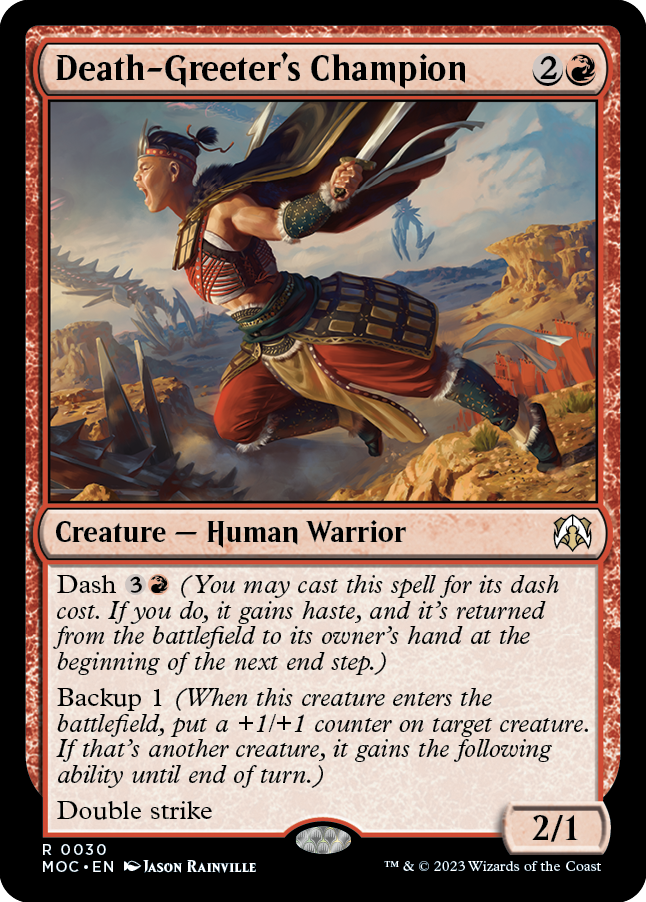
Death-Greeter's Champion
{2}{R}
Creature — Human Warrior
2/1
Dash {3}{R} (You may cast this spell for its dash cost. If you do, it gains haste, and it's returned from the battlefield to its owner's hand at the beginning of the next end step.)
Backup 1 (When this creature enters the battlefield, put a +1/+1 counter on target creature. If that's another creature, it gains the following ability until end of turn.)
Double strike
Each backup ability has a number, representing the number of +1/+1 counters that will be put on the target creature as the ability resolves. If the target creature isn't the source of the ability, the target also gains all the abilities of the creature with backup that are printed below its backup abilities. For example, if Death-Greeter's Champion enters the battlefield and its controller chooses a Grizzly Bears as the target creature, the Grizzly Bears gets one +1/+1 counter put on it as the ability resolves and it gains double strike, but it doesn't gain dash.
General Backup Notes:
- If a backup ability targets the creature with backup, that creature will get +1/+1 counters, but it won't gain additional abilities.
- If a backup ability causes another creature to gain abilities, the creature with backup will still have those abilities.
- If a permanent enters the battlefield as a copy of a card with a backup ability or a token is created that is a copy of that card, the order of the printed abilities is maintained.
- Backup confers only abilities that are actually printed below it. Any abilities that are gained by the permanent are ignored, including abilities gained due to a resolving spell or ability or copy effects.
- The abilities that backup grants to the target creature are determined only once, at the time the ability triggers. They won't change if the permanent with backup loses any abilities before the backup ability resolves.
New Keyword Action: Incubate
New Mechanic: Transforming Tokens
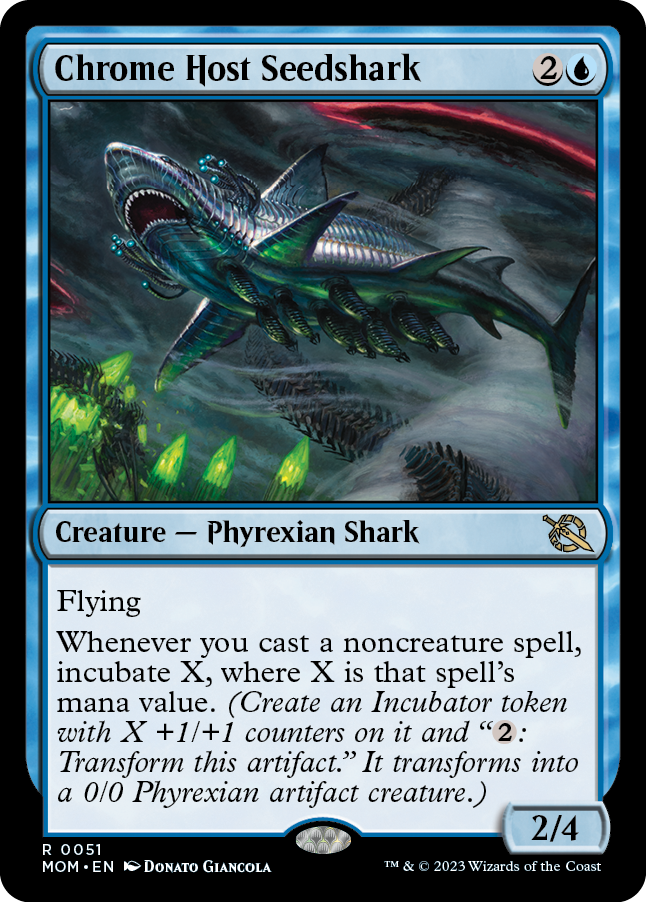
Chrome Host Seedshark
{2}{U}
Creature — Phyrexian Shark
2/4
Flying
Whenever you cast a noncreature spell, incubate X, where X is that spell's mana value. (Create an Incubator token with X +1/+1 counters on it and "{2}: Transform this artifact." It transforms into a 0/0 Phyrexian artifact creature.)
Incubate is a new keyword action that always has a number next to it. To "incubate N" means to create an Incubator token that enters the battlefield with N +1/+1 counters on it. An Incubator token is a transforming double-faced token. Its front face is a colorless Incubator artifact with "{2}: Transform this artifact." Its back face is a colorless 0/0 Phyrexian artifact creature.
Previously, only transforming double-faced cards could transform. Since Incubator tokens aren't cards, the rules are broadening slightly to allow "transforming double-faced permanents" to transform, which includes Incubator tokens. Similarly, tokens that are created as copies of transforming double-faced permanents will themselves be transforming double-faced permanents. This way, a token that is created as a copy of an Incubator token functions the same way as the original token. It will enter the battlefield with the same face up as the permanent it is a copy of. Watch out, though. For Incubator tokens, this won't include any +1/+1 counters, so this may result in the creature immediately dying!
This change will also apply to tokens that are created as copies of other transforming double-faced permanents or as copies of transforming double-faced cards in zones other than the battlefield. For example, if you control a Flame Channeler and an effect creates a token that's a copy of it, the resulting permanent is a transforming double-faced token that is a copy of Flame Channeler. It enters the battlefield with its front face up, and it can transform. If it does, it will become an Embodiment of Flame, the back face of Flame Channeler. Similarly, if you controlled an Embodiment of Flame and created a token that is a copy of it, the token would be the same transforming double-faced token, but it would enter with its back face up.
The rules for a permanent that's already on the battlefield becoming a copy of another permanent haven't changed, regardless of whether either one is a transforming permanent. Notably, a permanent that isn't a transforming permanent can't become one due to a copy effect, and it can't ever transform even if an effect instructs a player to transform it.
New Planechase Rules Term: Chaos Ensues
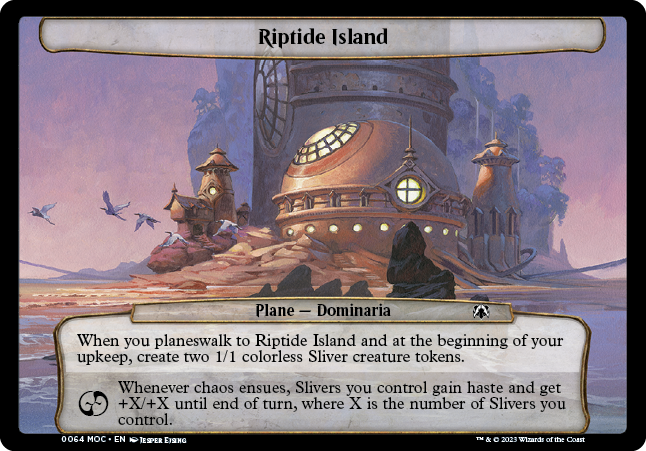
Riptide Island
Plane — Dominaria
When you planeswalk to Riptide Island and at the beginning of your upkeep, create two 1/1 colorless Sliver creature tokens.
Whenever chaos ensues, Slivers you control gain haste and get +X/+X until end of turn, where X is the number of Slivers you control.
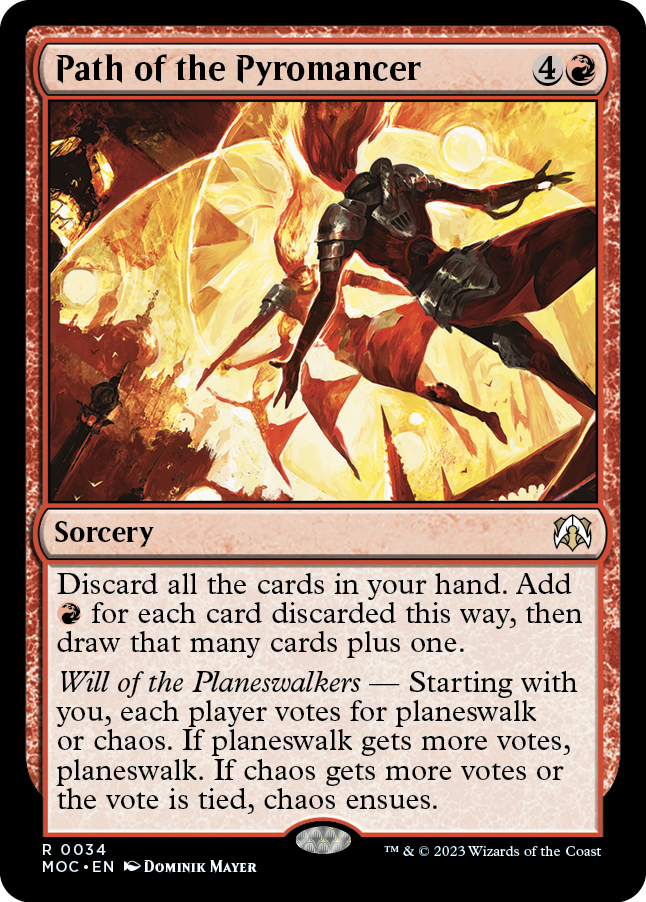
Path of the Pyromancer
{4}{R}
Sorcery
Discard all the cards in your hand. Add {R} for each card discarded this way, then draw that many cards plus one.
Will of the Planeswalkers — Starting with you, each player votes for planeswalk or chaos. If planeswalk gets more votes, planeswalk. If chaos gets more votes or the vote is tied, chaos ensues.
On previous plane cards, chaos abilities had the trigger condition "Whenever you roll [CHAOS]." Starting with March of the Machine, this condition has been replaced by "whenever chaos ensues." With respect to the planar die, nothing has changed; rolling [CHAOS] will still cause these abilities to trigger. However, now there are ways to have these abilities trigger that don't involve the planar die at all, such as voting for chaos with cards like Path of the Pyromancer.
MARCH OF THE MACHINE MAIN SET CARD-SPECIFIC NOTES
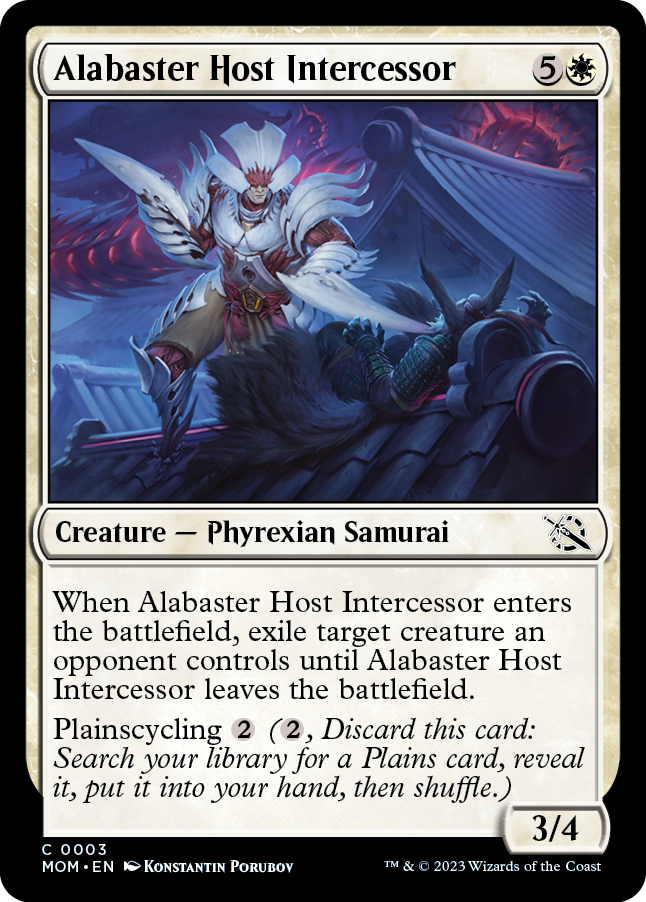
Alabaster Host Intercessor
{5}{W}
Creature — Phyrexian Samurai
3/4
When Alabaster Host Intercessor enters the battlefield, exile target creature an opponent controls until Alabaster Host Intercessor leaves the battlefield.
Plainscycling {2} ({2}, Discard this card: Search your library for a Plains card, reveal it, put it into your hand, then shuffle.)
- If Alabaster Host Intercessor leaves the battlefield before its enters-the-battlefield ability resolves, the target creature won't be exiled at all.
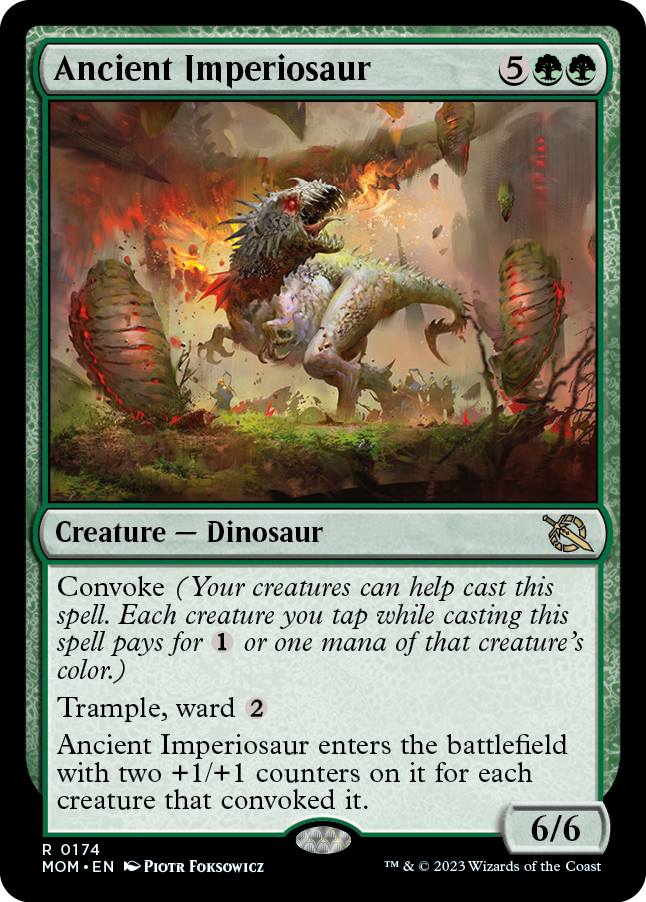
Ancient Imperiosaur
{5}{G}{G}
Creature — Dinosaur
6/6
Convoke (Your creatures can help cast this spell. Each creature you tap while casting this spell pays for {1} or one mana of that creature's color.)
Trample, ward {2}
Ancient Imperiosaur enters the battlefield with two +1/+1 counters on it for each creature that convoked it.
- You can't tap more creatures to convoke Ancient Imperiosaur than is necessary to pay for the spell. In most cases, this means seven creatures. However, if there are any additional costs to cast Ancient Imperiosaur, you may use convoke to pay those additional costs as well.
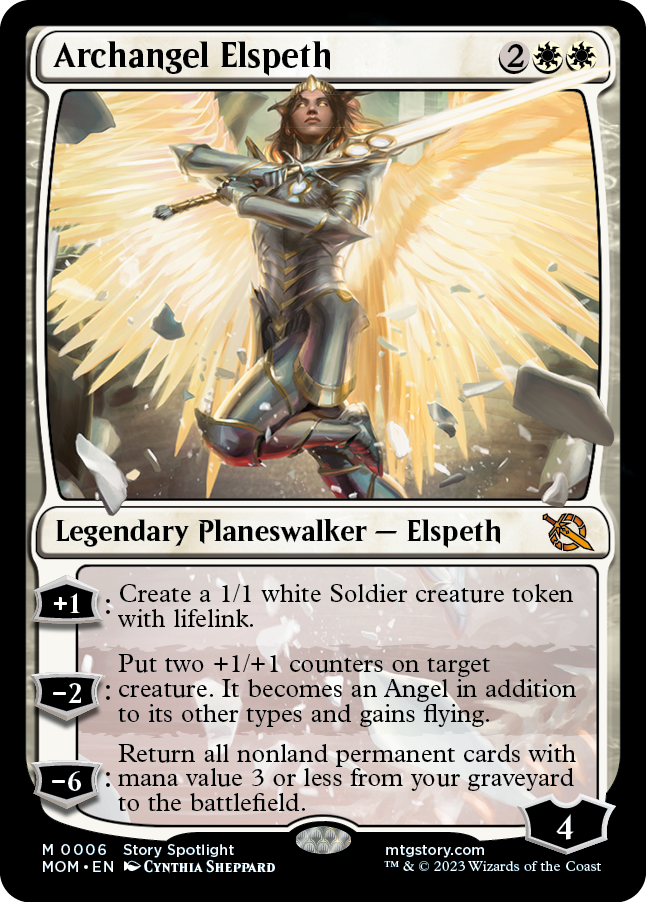
Archangel Elspeth
{2}{W}{W}
Legendary Planeswalker — Elspeth
4
+1: Create a 1/1 white Soldier creature token with lifelink.
−2: Put two +1/+1 counters on target creature. It becomes an Angel in addition to its other types and gains flying.
−6: Return all nonland permanent cards with mana value 3 or less from your graveyard to the battlefield.
- The second ability doesn't have a duration. It lasts until the creature leaves the battlefield.
- If the target of the second ability stops being a creature after the ability has resolved, it will also stop being an Angel until it becomes a creature again, if applicable.
- For the last ability, if a card in your graveyard has {X} in its mana cost, X is 0.
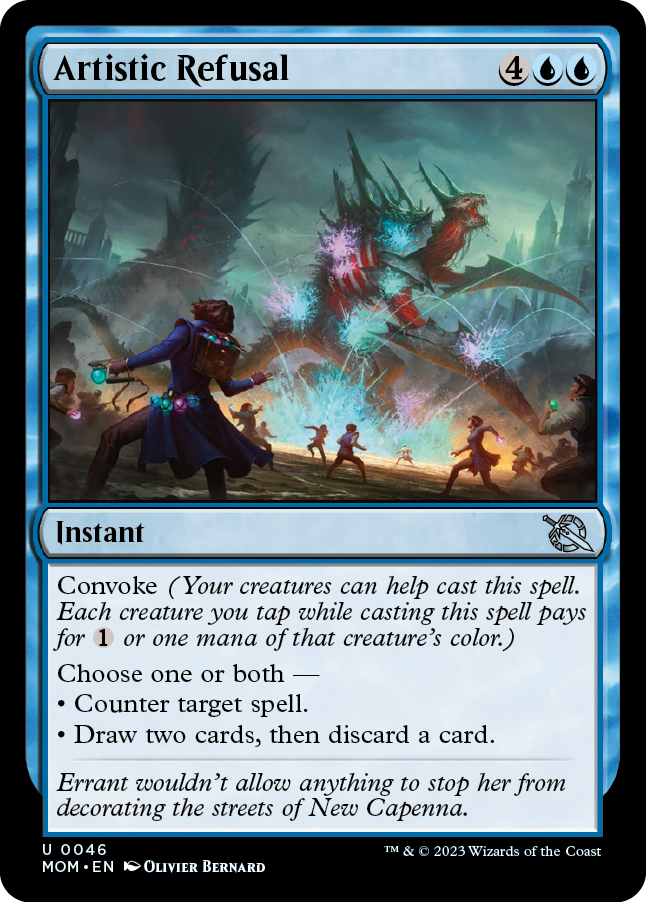
Artistic Refusal
{4}{U}{U}
Instant
Convoke (Your creatures can help cast this spell. Each creature you tap while casting this spell pays for {1} or one mana of that creature's color.)
Choose one or both —
• Counter target spell.
• Draw two cards, then discard a card.
- If you choose both modes, and the target of the first mode is an illegal target at the time Artistic Refusal tries to resolve (probably because that spell has been countered by something else), Artistic Refusal won't resolve and none of its effects will happen. You won't draw or discard any cards.
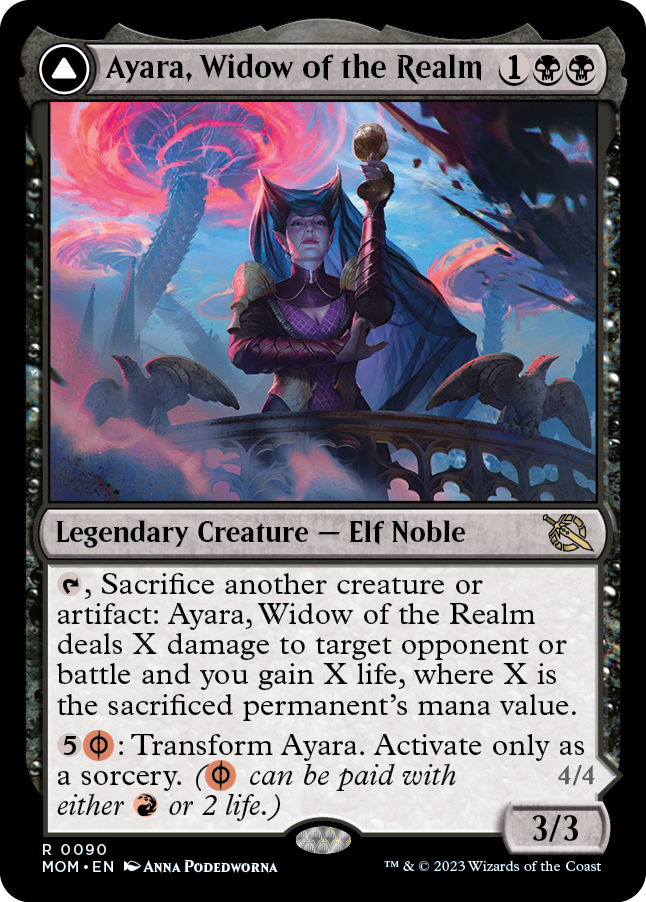
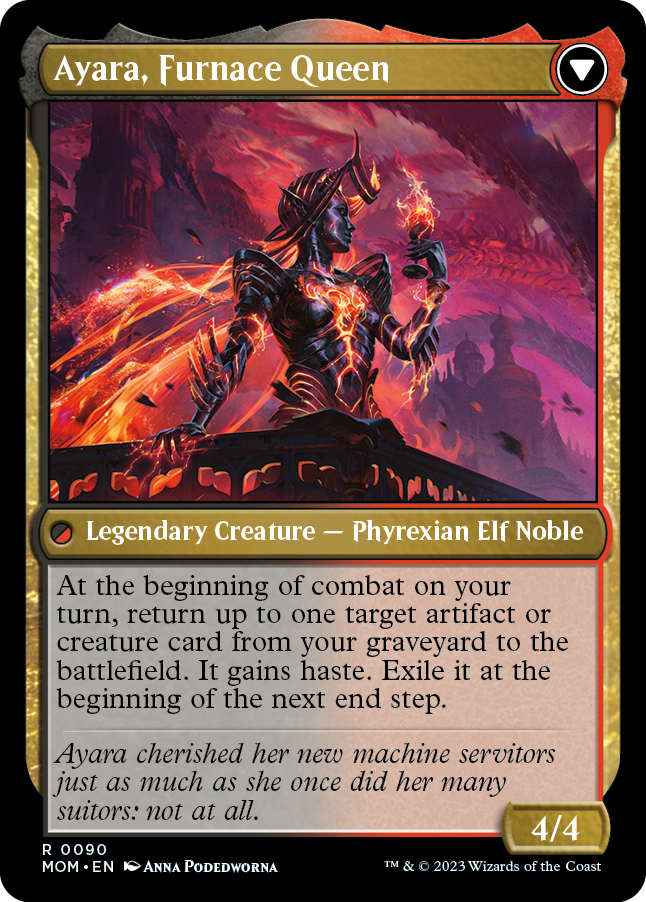
Ayara, Widow of the Realm
{1}{B}{B}
Legendary Creature — Elf Noble
3/3
{T}, Sacrifice another creature or artifact: Ayara, Widow of the Realm deals X damage to target opponent or battle and you gain X life, where X is the sacrificed permanent's mana value.
{5}{R/P}: Transform Ayara. Activate only as a sorcery. ({R/P} can be paid with either {R} or 2 life.)
////
Ayara, Furnace Queen
Legendary Creature — Phyrexian Elf Noble
4/4
At the beginning of combat on your turn, return up to one target artifact or creature card from your graveyard to the battlefield. It gains haste. Exile it at the beginning of the next end step.
- The first activated ability of Ayara, Widow of the Realm uses the mana value of the permanent you sacrificed as it last existed on the battlefield, not its mana value in the graveyard.
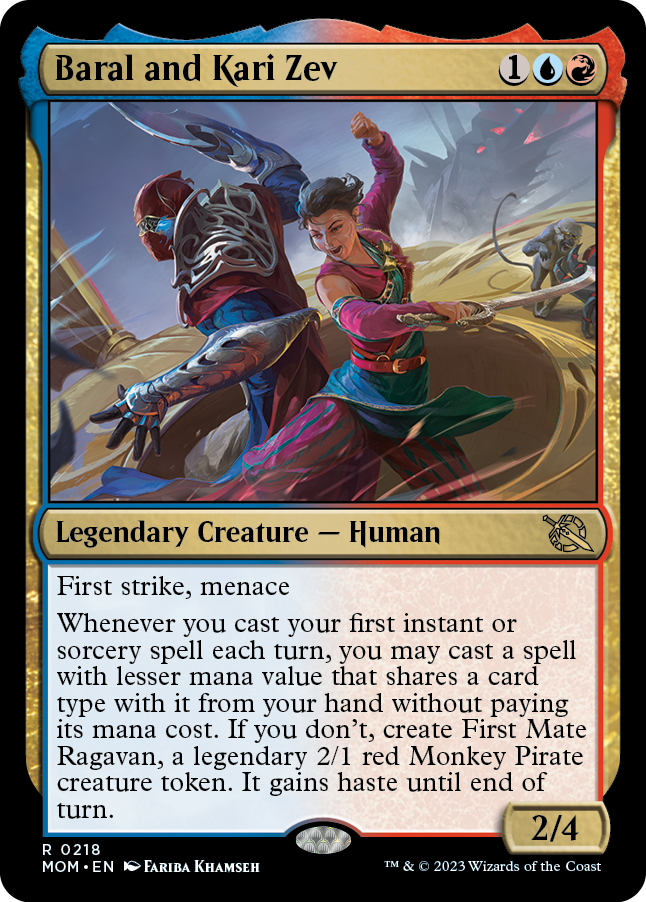
Baral and Kari Zev
{1}{U}{R}
Legendary Creature — Human
2/4
First strike, menace
Whenever you cast your first instant or sorcery spell each turn, you may cast a spell with lesser mana value that shares a card type with it from your hand without paying its mana cost. If you don't, create First Mate Ragavan, a legendary 2/1 red Monkey Pirate creature token. It gains haste until end of turn.
- Baral and Kari Zev will count any instant or sorcery spell you cast during a turn, even if it wasn't on the battlefield at the time. This means if you cast an instant or sorcery spell, then Baral and Kari Zev comes under your control, its triggered ability won't trigger that turn.
- The spell you cast from your hand without paying its mana cost is cast during the resolution of the triggered ability. Timing restrictions of that spell based on card type are ignored. It will resolve before the spell that caused the ability to trigger.
- If you cast a spell without paying its mana cost, you can't choose to cast it for any alternative costs. You can, however, pay any additional costs. If the spell has any mandatory additional costs, you must pay those.
- If the spell has {X} in its mana cost, you must choose 0 as the value of X when casting it without paying its mana cost.
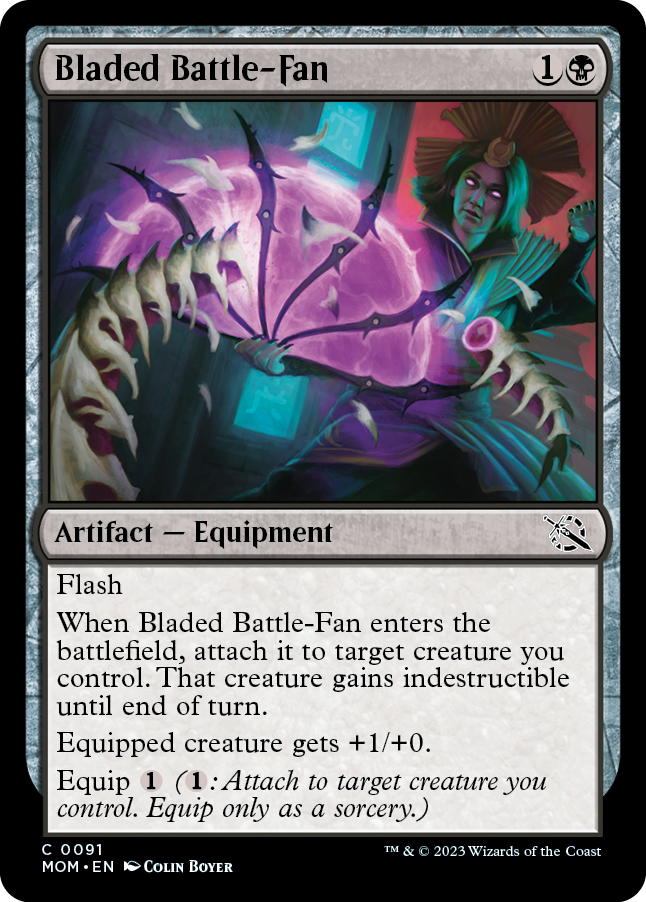
Bladed Battle-Fan
{1}{B}
Artifact — Equipment
Flash
When Bladed Battle-Fan enters the battlefield, attach it to target creature you control. That creature gains indestructible until end of turn.
Equipped creature gets +1/+0.
Equip {1} ({1}: Attach to target creature you control. Equip only as a sorcery.)
- The creature that gains indestructible due to Bladed Battle-Fan's triggered ability will keep indestructible for the duration of the turn, even if Bladed Battle-Fan later becomes unattached.
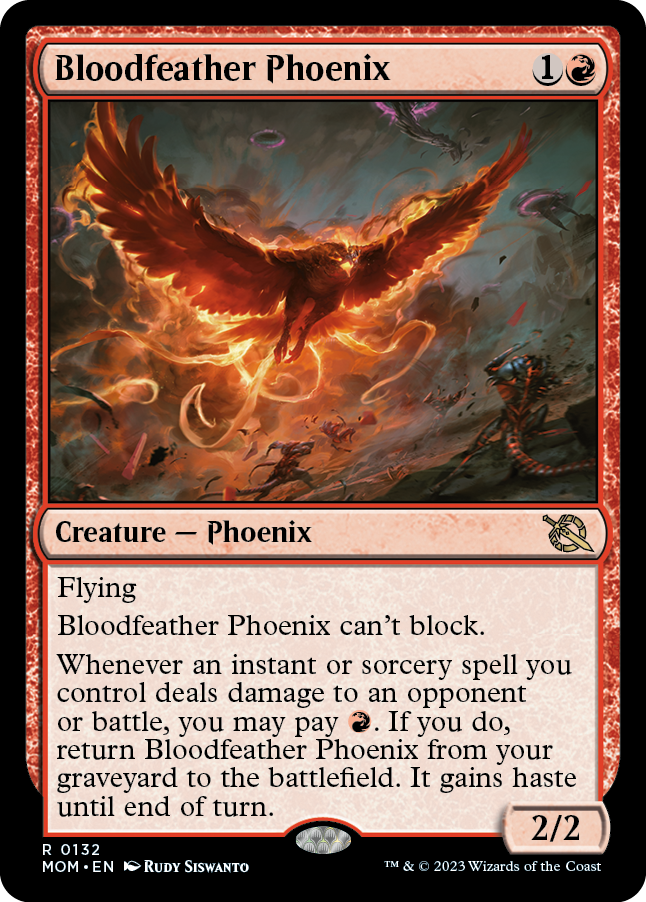
Bloodfeather Phoenix
{1}{R}
Creature — Phoenix
2/2
Flying
Bloodfeather Phoenix can't block.
Whenever an instant or sorcery spell you control deals damage to an opponent or battle, you may pay {R}. If you do, return Bloodfeather Phoenix from your graveyard to the battlefield. It gains haste until end of turn.
- Bloodfeather Phoenix's last ability triggers only if Bloodfeather Phoenix is in your graveyard at the moment the instant or sorcery spell you control deals damage to an opponent or battle. For example, if you cast a sorcery spell that deals damage to an opponent and also enough damage to Bloodfeather Phoenix to destroy it at the same time, Bloodfeather Phoenix's ability won't trigger.
- You choose whether to pay {R} as the triggered ability is resolving. Once the ability starts resolving, it's too late for anyone to respond by removing Bloodfeather Phoenix from your graveyard to stop you from bringing it back.
- Most instant or sorcery spells deal damage themselves, but a few cause other sources to deal damage. For example, a sorcery spell that says "Target creature you control deals damage equal to its power to any target" wouldn't cause Bloodfeather Phoenix's ability to trigger even if an opponent or battle was dealt damage, as it's the creature dealing the damage, not the spell.
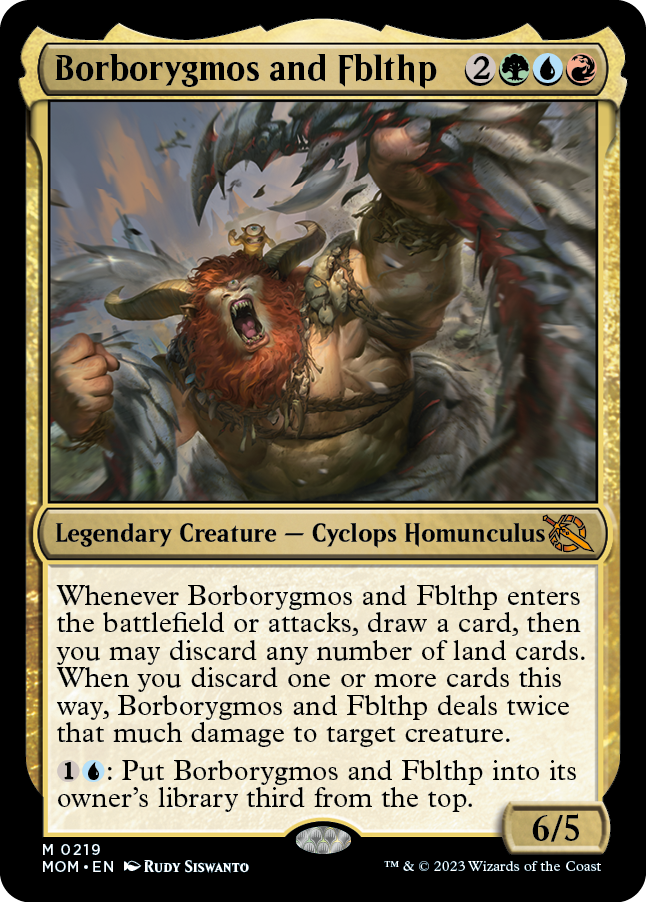
Borborygmos and Fblthp
{2}{G}{U}{R}
Legendary Creature — Cyclops Homunculus
6/5
Whenever Borborygmos and Fblthp enters the battlefield or attacks, draw a card, then you may discard any number of land cards. When you discard one or more cards this way, Borborygmos and Fblthp deals twice that much damage to target creature.
{1}{U}: Put Borborygmos and Fblthp into its owner's library third from the top.
- The first ability of Borborygmos and Fblthp triggers and goes on the stack without a target. If you discard one or more land cards, the second "reflexive" triggered ability will trigger. You'll choose the target creature for that second ability at that time.
- You can't discard nonland cards, even if you want to.
- Only the controller of Borborygmos and Fblthp can activate its last ability, and only if it's on the battlefield.
- If there are one or fewer cards in your library, Borborygmos and Fblthp is put on the bottom of your library.
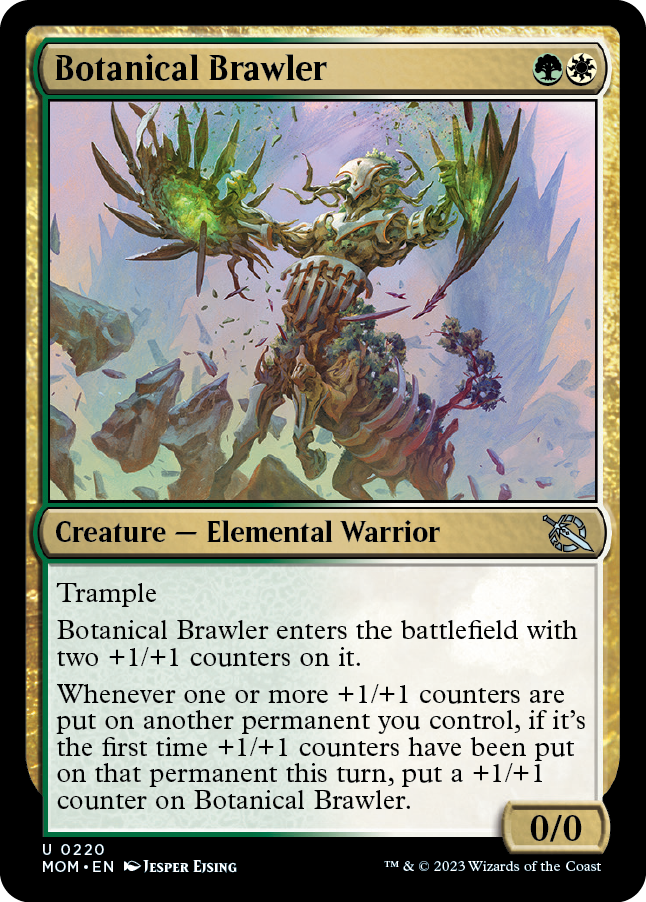
Botanical Brawler
{G}{W}
Creature — Elemental Warrior
0/0
Trample
Botanical Brawler enters the battlefield with two +1/+1 counters on it.
Whenever one or more +1/+1 counters are put on another permanent you control, if it's the first time +1/+1 counters have been put on that permanent this turn, put a +1/+1 counter on Botanical Brawler.
- For each other permanent you control, Botanical Brawler will count +1/+1 counters having been put on that permanent at any time during that turn, even if Botanical Brawler wasn't on the battlefield at that time. For example, if a +1/+1 counter is put on a creature you control, then you cast Botanical Brawler, then another +1/+1 counter is put on that first creature, Botanical Brawler's last ability won't trigger.
- Whenever another permanent enters the battlefield under your control with one or more +1/+1 counters on it, Botanical Brawler's last ability will trigger.
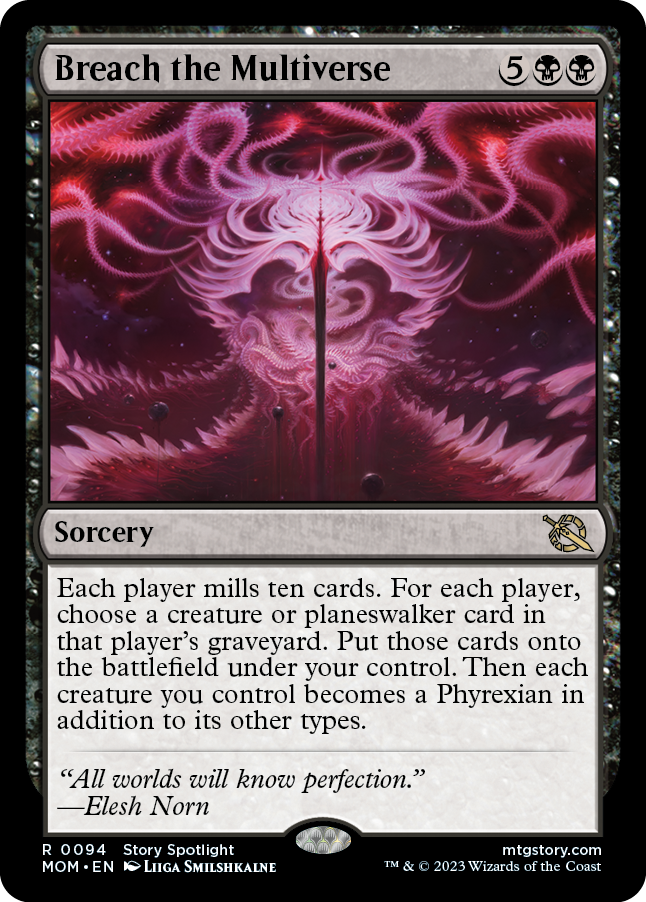
Breach the Multiverse
{5}{B}{B}
Sorcery
Each player mills ten cards. For each player, choose a creature or planeswalker card in that player's graveyard. Put those cards onto the battlefield under your control. Then each creature you control becomes a Phyrexian in addition to its other types.
- The cards you choose can be ones that were just milled or ones that were already in the graveyard.
- The creatures you control will be Phyrexians until they leave the battlefield. Any of them that stops being a creature will also stop being a Phyrexian until it becomes a creature again, if applicable.
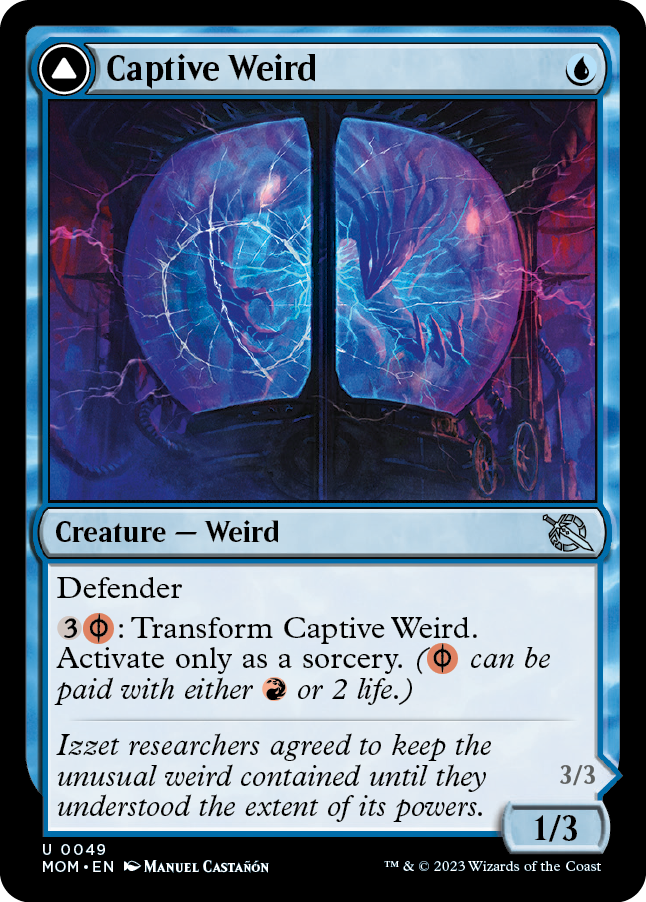
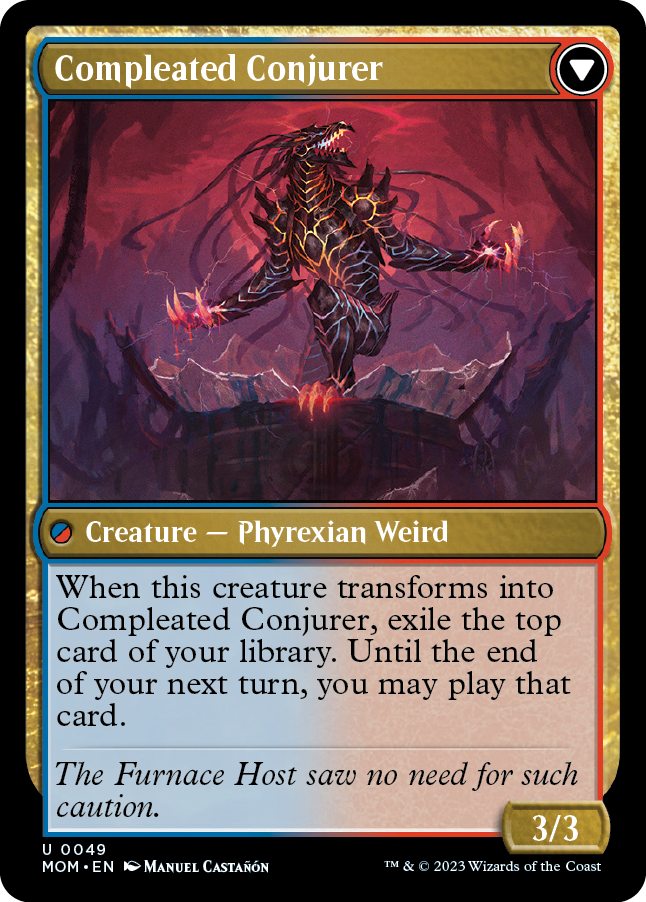
Captive Weird
{U}
Creature — Weird
1/3
Defender
{3}{R/P}: Transform Captive Weird. Activate only as a sorcery. ({R/P} can be paid with either {R} or 2 life.)
////
Compleated Conjurer
Creature — Phyrexian Weird
3/3
When this creature transforms into Compleated Conjurer, exile the top card of your library. Until the end of your next turn, you may play that card.
- You may play the card exiled with Compleated Conjurer even if Compleated Conjurer leaves the battlefield or you lose control of it.
- Playing the card exiled with Compleated Conjurer follows the normal rules for playing that card. You must pay its costs, and you must follow all applicable timing rules. For example, if the card is a creature card, you can cast that card by paying its mana cost only during your main phase while the stack is empty.
- Unless an effect allows you to play additional lands that turn, you can play a land card exiled with Compleated Conjurer only if you haven't played a land yet that turn.
- If you don't play the card, it will remain exiled.
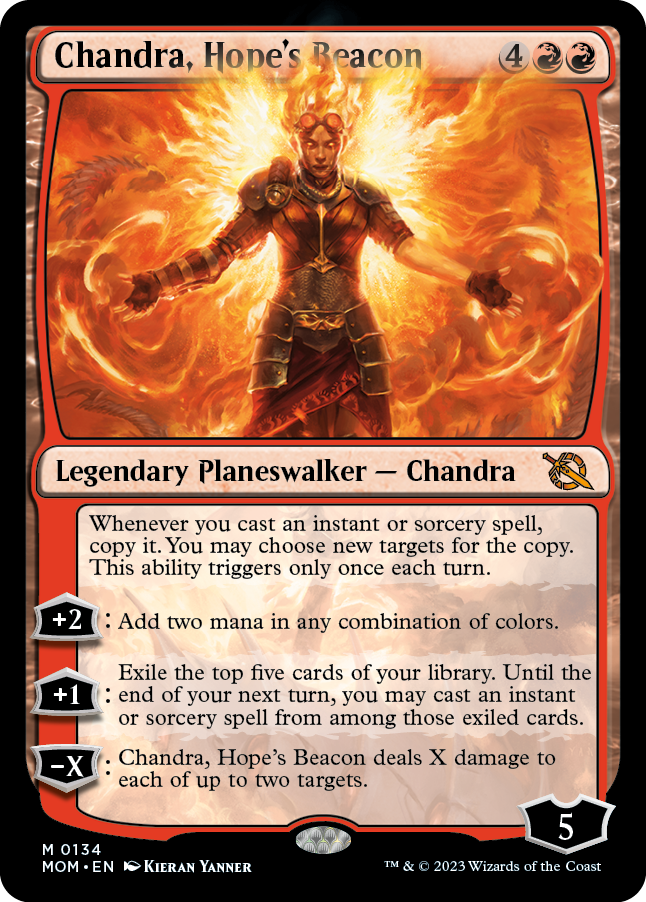
Chandra, Hope's Beacon
{4}{R}{R}
Legendary Planeswalker — Chandra
5
Whenever you cast an instant or sorcery spell, copy it. You may choose new targets for the copy. This ability triggers only once each turn.
+2: Add two mana in any combination of colors.
+1: Exile the top five cards of your library. Until the end of your next turn, you may cast an instant or sorcery spell from among those exiled cards.
−X: Chandra, Hope's Beacon deals X damage to each of up to two targets.
- A copy of a spell is created on the stack, so it's not "cast." Abilities that trigger when a player casts a spell won't trigger.
- If you copy a spell, you control the copy. It will resolve before the original spell does.
- The copy will have the same targets as the spell it's copying unless you choose new ones. You may change any number of the targets, including all of them or none of them. If, for one of the targets, you can't choose a new legal target, then it remains unchanged (even if the current target is illegal).
- If the spell that's copied is modal (that is, it includes a choice from a bulleted list of effects), the copy will have the same mode. A different mode can't be chosen.
- If the spell that's copied has an X whose value was determined as it was cast, the copy will have the same value of X.
- If the spell has damage divided as it was cast, the division can't be changed (although the targets receiving that damage still can). The same is true of spells that distribute counters.
- You can't choose to pay any alternative or additional costs for the copy. However, effects based on any alternative or additional costs that were paid for the original spell are copied as though those same costs were paid for the copy.
- For the second loyalty ability, the spell you cast must be an instant or sorcery spell, although the exiled card doesn't necessarily have to be. For example, if you exile a creature card that has an Adventure, you can cast that Adventure spell.
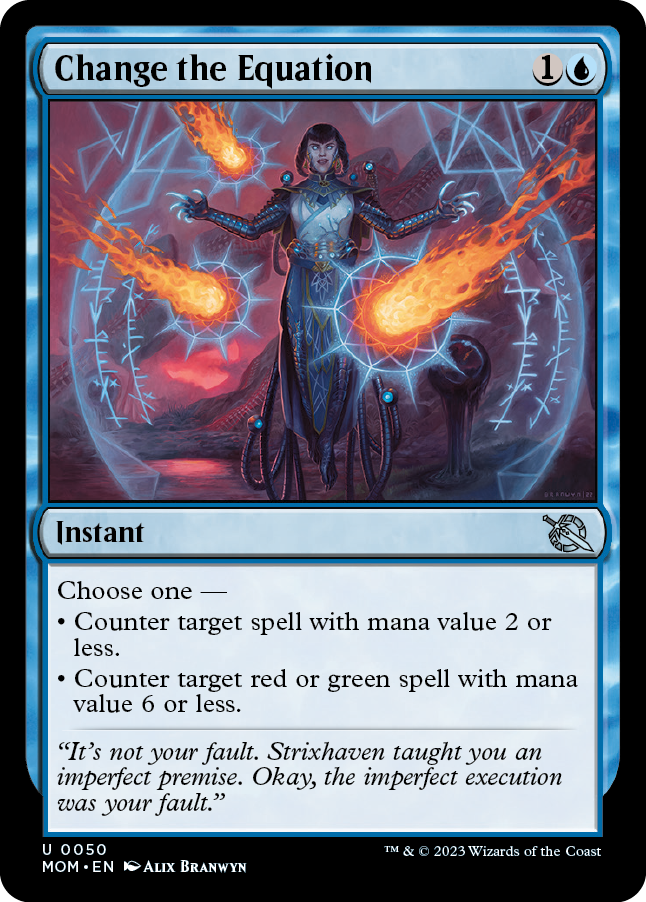
Change the Equation
{1}{U}
Instant
Choose one —
• Counter target spell with mana value 2 or less.
• Counter target red or green spell with mana value 6 or less.
- If a spell has {X} in its mana cost, use the value chosen for X when calculating that spell's mana value.
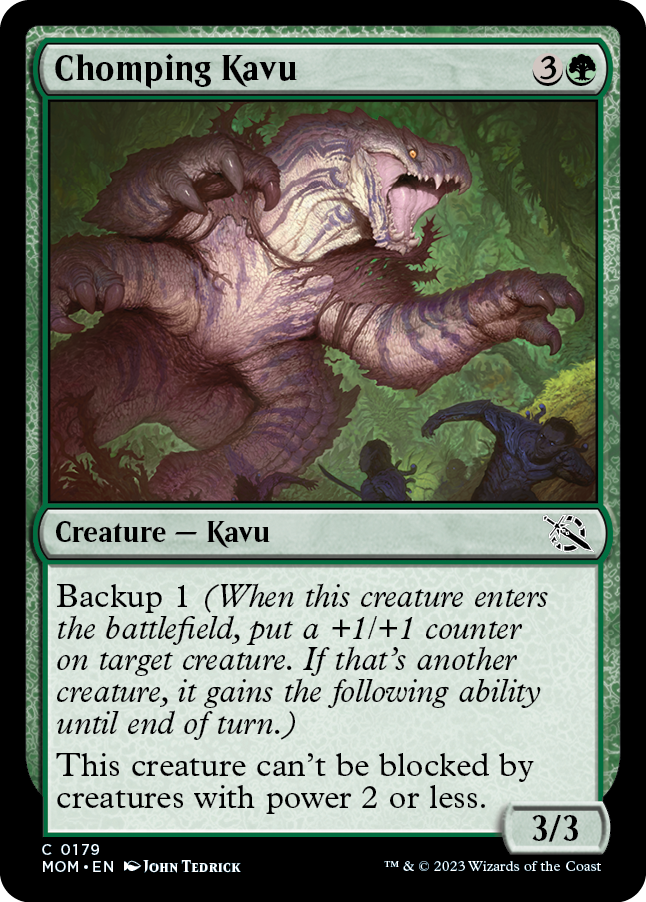
Chomping Kavu
{3}{G}
Creature — Kavu
3/3
Backup 1 (When this creature enters the battlefield, put a +1/+1 counter on target creature. If that's another creature, it gains the following ability until end of turn.)
This creature can't be blocked by creatures with power 2 or less.
- Once Chomping Kavu has been legally blocked by a creature, changing that creature's power to 2 or less won't undo that block.

Chrome Host Seedshark
{2}{U}
Creature — Phyrexian Shark
2/4
Flying
Whenever you cast a noncreature spell, incubate X, where X is that spell's mana value. (Create an Incubator token with X +1/+1 counters on it and "{2}: Transform this artifact." It transforms into a 0/0 Phyrexian artifact creature.)
- If the noncreature spell has {X} in its mana cost, use the value chosen for X when calculating that spell's mana value.
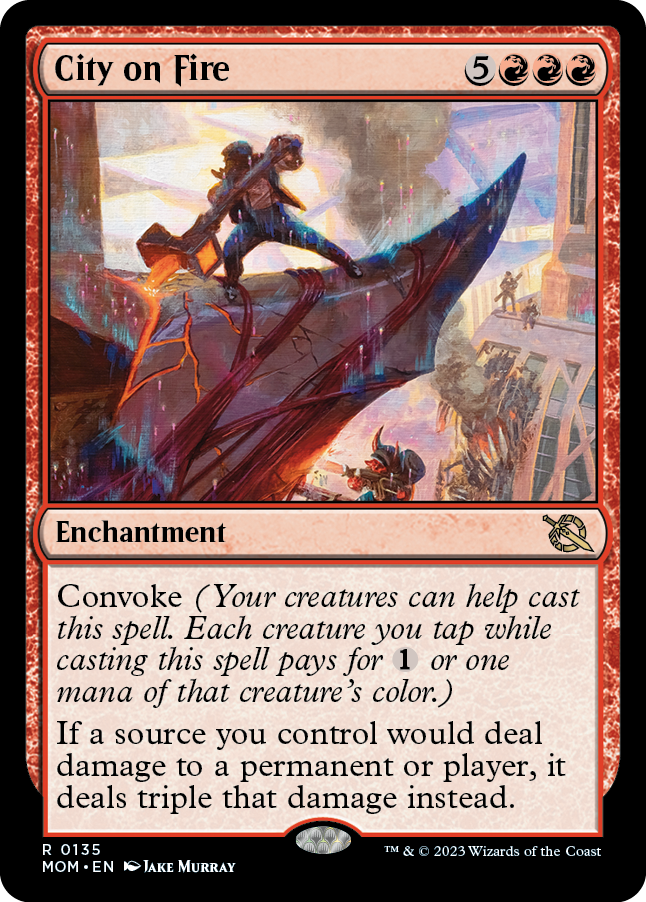
City on Fire
{5}{R}{R}{R}
Enchantment
Convoke (Your creatures can help cast this spell. Each creature you tap while casting this spell pays for {1} or one mana of that creature's color.)
If a source you control would deal damage to a permanent or player, it deals triple that damage instead.
- While you control City on Fire, if a creature you control with trample would deal combat damage to a blocking creature, you must assign its unmodified damage. For example, a 3/3 creature with trample blocked by a 2/2 creature can have 1 damage assigned to the defending player. It will then deal 6 damage to the blocking creature (2 tripled) and 3 to the defending player (1 tripled).
- If an effect such as that of Chandra's Pyrohelix asks you to divide damage among targets, you must divide the unmodified damage before tripling it.
- If you control two Cities on Fire, damage dealt by sources you control will be multiplied by 9. If you control three, it will be multiplied by 27, and so on.
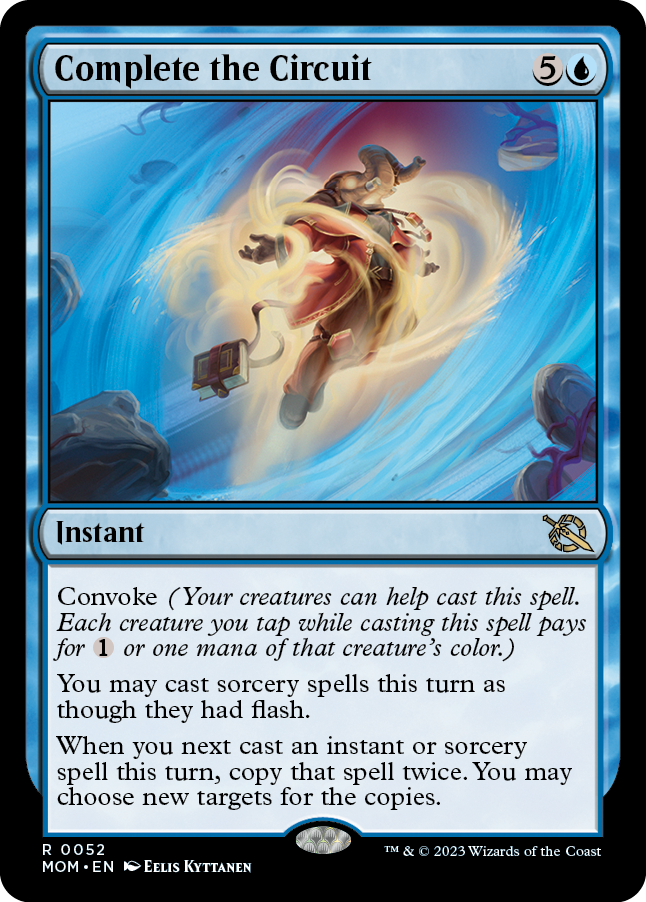
Complete the Circuit
{5}{U}
Instant
Convoke (Your creatures can help cast this spell. Each creature you tap while casting this spell pays for {1} or one mana of that creature's color.)
You may cast sorcery spells this turn as though they had flash.
When you next cast an instant or sorcery spell this turn, copy that spell twice. You may choose new targets for the copies.
- The "as though they had flash" effect applies only to casting sorcery spells. It does not, for example, change when you may activate abilities that can be activated "only as a sorcery."
- You may choose different new targets for each of the copies.
- A copy of a spell is created on the stack, so it's not "cast." Abilities that trigger when a player casts a spell won't trigger.
- If you copy a spell, you control the copy. It will resolve before the original spell does.
- The copy will have the same targets as the spell it's copying unless you choose new ones. You may change any number of the targets, including all of them or none of them. If, for one of the targets, you can't choose a new legal target, then it remains unchanged (even if the current target is illegal).
- If the spell that's copied is modal (that is, it includes a choice from a bulleted list of effects), the copy will have the same mode. A different mode can't be chosen.
- If the spell that's copied has an X whose value was determined as it was cast, the copy will have the same value of X.
- If the spell has damage divided as it was cast, the division can't be changed (although the targets receiving that damage still can). The same is true of spells that distribute counters.
- You can't choose to pay any alternative or additional costs for the copy. However, effects based on any alternative or additional costs that were paid for the original spell are copied as though those same costs were paid for the copy.
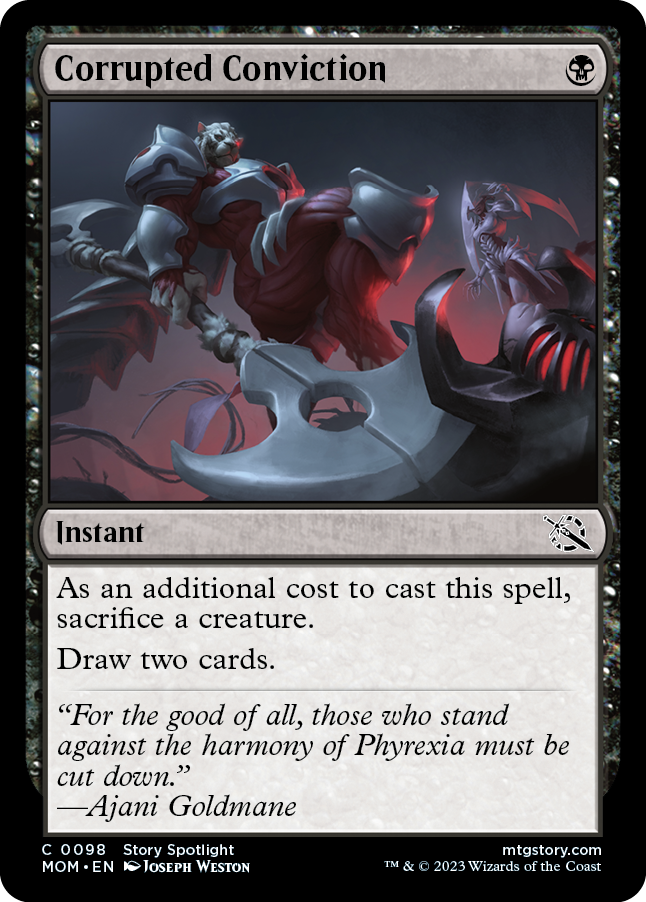
Corrupted Conviction
{B}
Instant
As an additional cost to cast this spell, sacrifice a creature.
Draw two cards.
- You must sacrifice exactly one creature to cast this spell; you can't cast it without sacrificing a creature, and you can't sacrifice additional creatures.
- Players can't respond to this spell until it's been cast and all its costs have been paid. No one can try to interfere with the creature you sacrificed to prevent you from casting this spell.
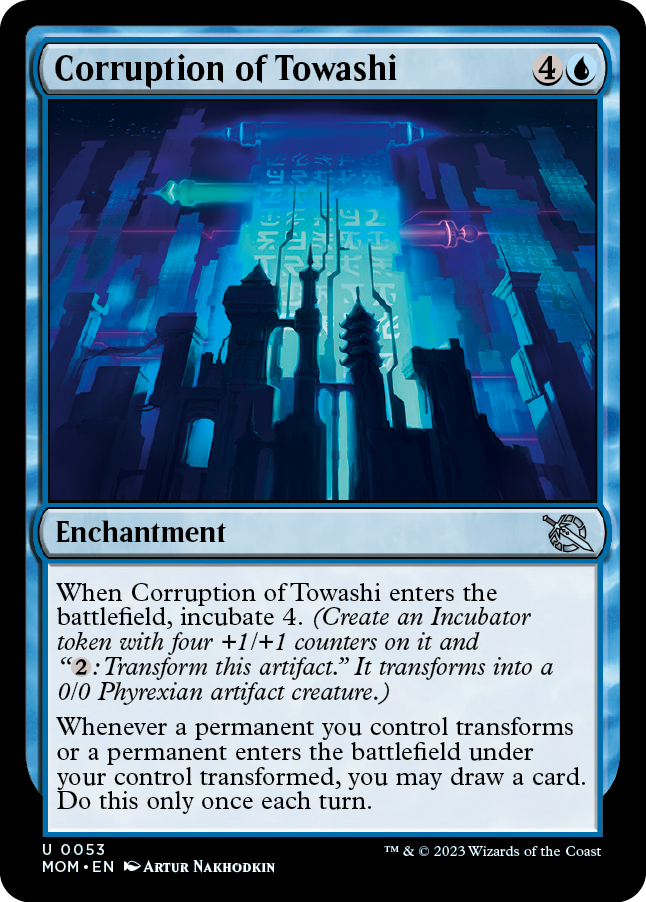
Corruption of Towashi
{4}{U}
Enchantment
When Corruption of Towashi enters the battlefield, incubate 4. (Create an Incubator token with four +1/+1 counters on it and "{2}: Transform this artifact." It transforms into a 0/0 Phyrexian artifact creature.)
Whenever a permanent you control transforms or a permanent enters the battlefield under your control transformed, you may draw a card. Do this only once each turn.
- Only a transforming double-faced permanent can enter the battlefield "transformed," and only if it enters with its back face up. Notably, melded permanents can't enter transformed, and modal double-faced permanents can't enter transformed, even if they enter with their back faces up.
- Similarly, only transforming double-faced permanents (including transforming double-faced cards and Incubator tokens) can transform. A face-up permanent turning face down doesn't count as transforming, nor does a face-down permanent turning face up.
- The last ability of Corruption of Towashi will trigger if a permanent you control transforms in either direction, going from front face up to back face up or vice versa.
- Once you've chosen to draw a card because of the last ability (which is likely as soon as possible, but there may be situations in which you don't want to draw immediately), that ability will stop triggering for the duration of that turn.
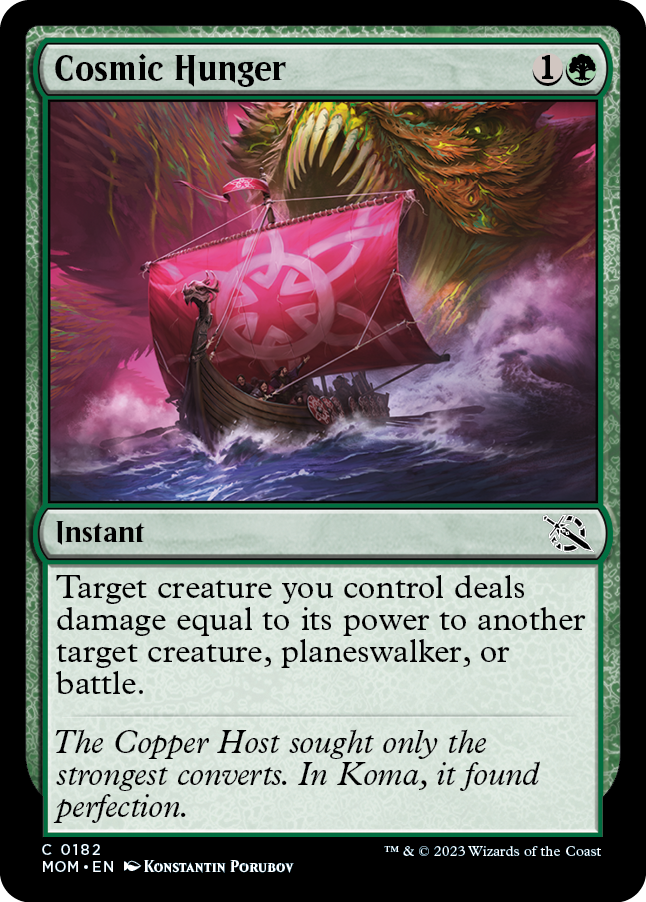
Cosmic Hunger
{1}{G}
Instant
Target creature you control deals damage equal to its power to another target creature, planeswalker, or battle.
- If either target is an illegal target as Cosmic Hunger tries to resolve, the creature you control won't deal damage.
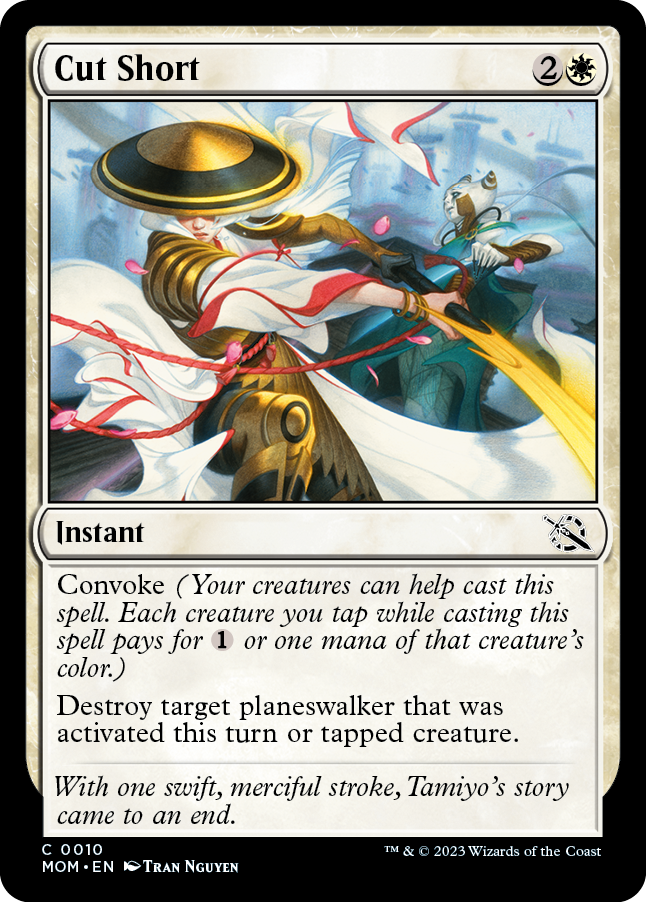
Cut Short
{2}{W}
Instant
Convoke (Your creatures can help cast this spell. Each creature you tap while casting this spell pays for {1} or one mana of that creature's color.)
Destroy target planeswalker that was activated this turn or tapped creature.
- A planeswalker was "activated" during a turn if one of its abilities was activated that turn. This includes its loyalty abilities and any other activated abilities it may have. That ability may still be on the stack, or it could have resolved, failed to resolve, been countered, or have been removed from the stack some other way.
- Once an ability of a planeswalker is activated, it doesn't matter if the planeswalker loses that ability. That planeswalker has still been "activated" that turn.
- Emblems are separate from the planeswalkers you got them from. Activating an ability of an emblem doesn't cause any planeswalker to be "activated."
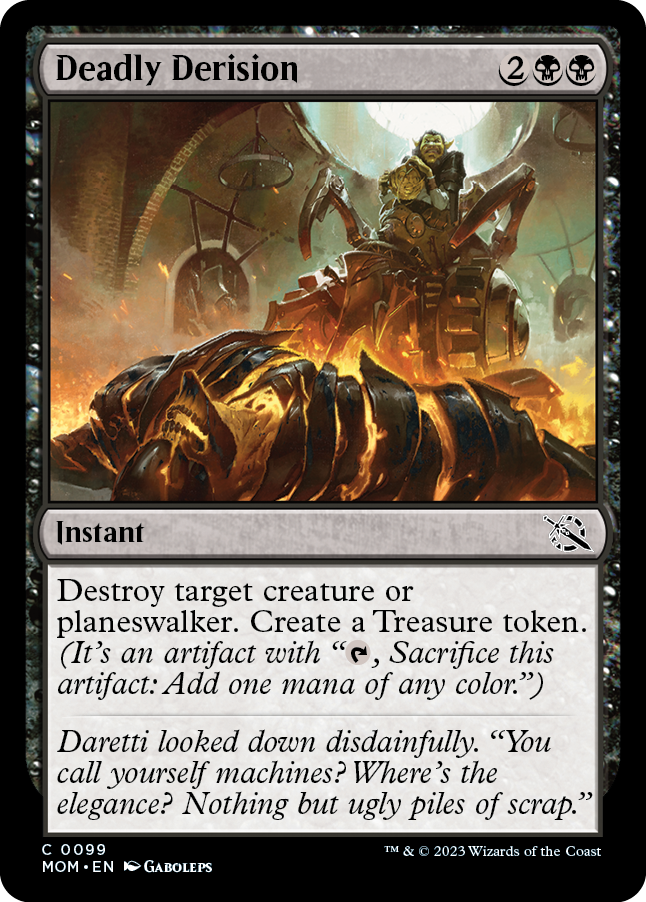
Deadly Derision
{2}{B}{B}
Instant
Destroy target creature or planeswalker. Create a Treasure token. (It's an artifact with "{T}, Sacrifice this artifact: Add one mana of any color.")
- If the target of Deadly Derision is illegal as the spell tries to resolve, it won't resolve and none of its effects will happen. You won't create a Treasure token.

Deeproot Wayfinder
{1}{G}
Creature — Merfolk Scout
2/3
Whenever Deeproot Wayfinder deals combat damage to a player or battle, surveil 1, then you may return a land card from your graveyard to the battlefield tapped. (To surveil 1, look at the top card of your library. You may put that card into your graveyard.)
- The land card you return from your graveyard, if any, isn't a target of the ability. You choose that card as the ability is resolving, after you surveil 1. It can be a land card you just put into your graveyard or one that was already there.
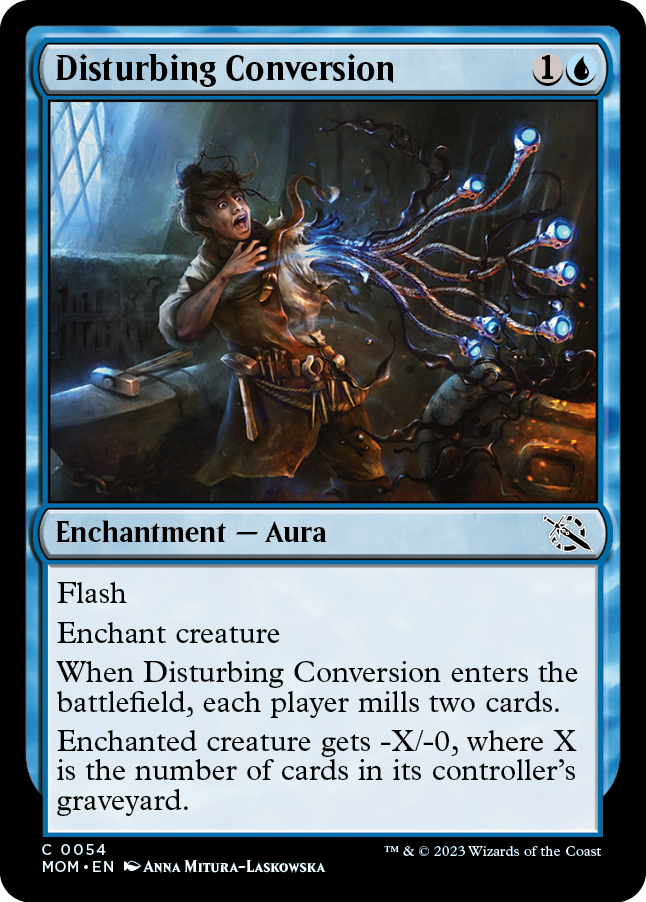
Disturbing Conversion
{1}{U}
Enchantment — Aura
Flash
Enchant creature
When Disturbing Conversion enters the battlefield, each player mills two cards.
Enchanted creature gets -X/-0, where X is the number of cards in its controller's graveyard.
- The value of X will change as the number of cards in the appropriate graveyard changes.
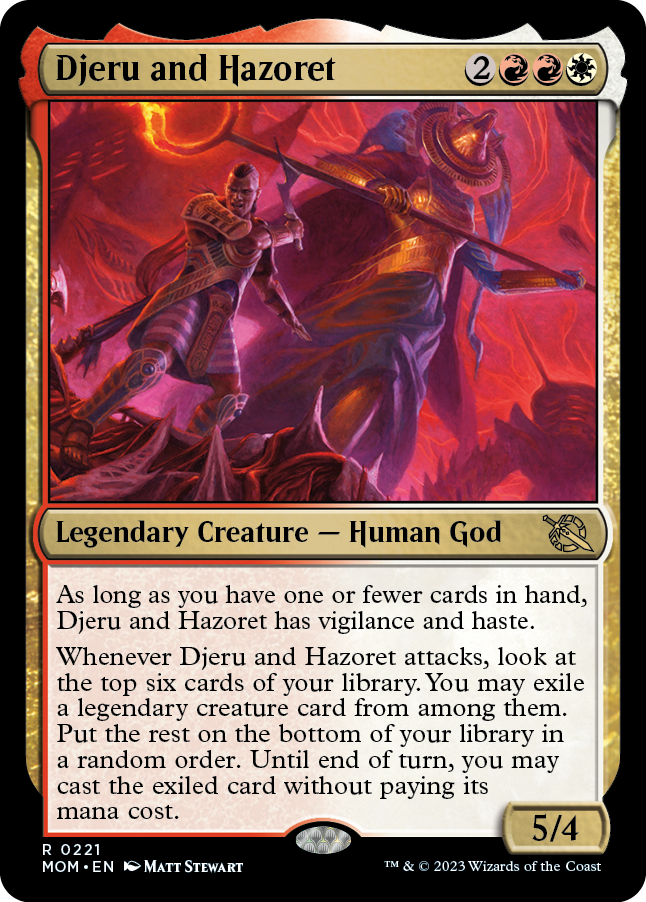
Djeru and Hazoret
{2}{R}{R}{W}
Legendary Creature — Human God
5/4
As long as you have one or fewer cards in hand, Djeru and Hazoret has vigilance and haste.
Whenever Djeru and Hazoret attacks, look at the top six cards of your library. You may exile a legendary creature card from among them. Put the rest on the bottom of your library in a random order. Until end of turn, you may cast the exiled card without paying its mana cost.
- Once Djeru and Hazoret has legally attacked during the turn it came under your control, causing it to lose haste by adding cards to your hand won't cause it to stop attacking. Similarly, causing it to lose vigilance after it has attacked won't cause it to become tapped.
- If you cast a spell without paying its mana cost, you can't choose to cast it for any alternative costs. You can, however, pay any additional costs. If the spell has any mandatory additional costs, you must pay those.
- If the spell has {X} in its mana cost, you must choose 0 as the value of X when casting it without paying its mana cost.
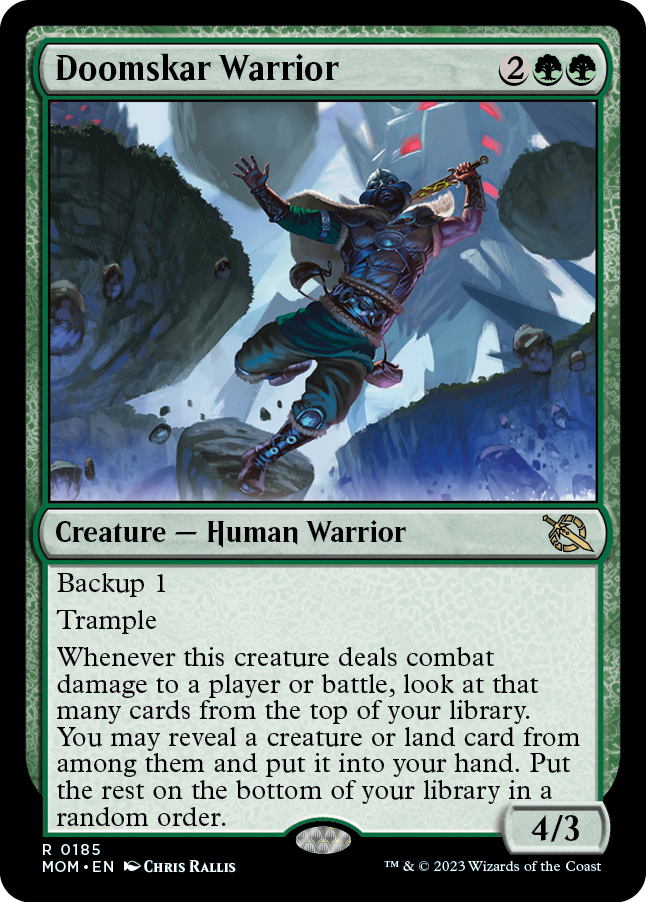
Doomskar Warrior
{2}{G}{G}
Creature — Human Warrior
4/3
Backup 1
Trample
Whenever this creature deals combat damage to a player or battle, look at that many cards from the top of your library. You may reveal a creature or land card from among them and put it into your hand. Put the rest on the bottom of your library in a random order.
- In some unusual situations (mostly involving damage redirection), Doomskar Warrior may deal combat damage to multiple players and/or battles at the same time. If this happens, its ability will trigger for each of those players and/or battles. Each ability will resolve separately, allowing you to look at a number of cards equal to the damage dealt to that specific player or battle.
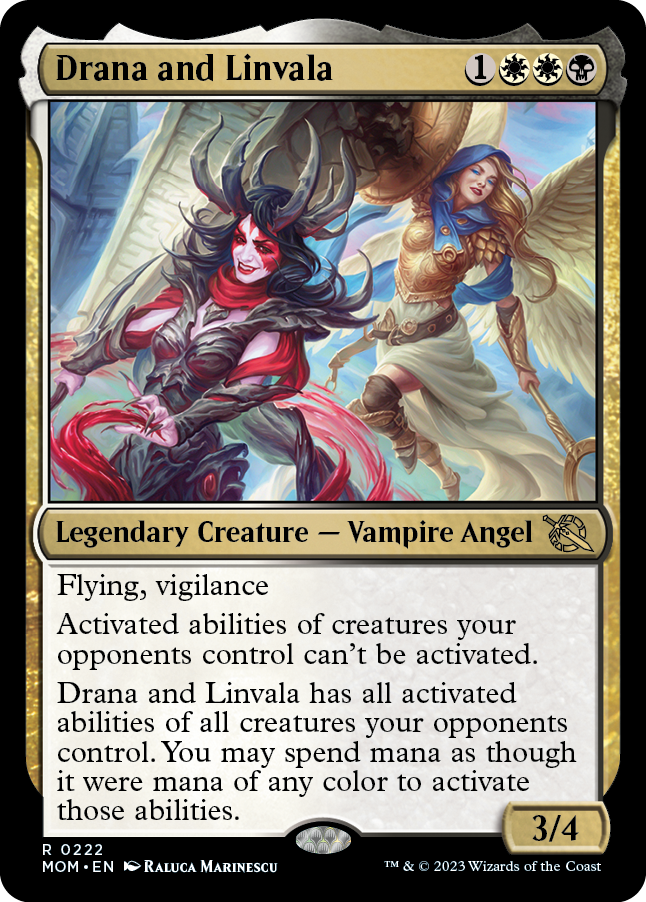
Drana and Linvala
{1}{W}{W}{B}
Legendary Creature — Vampire Angel
3/4
Flying, vigilance
Activated abilities of creatures your opponents control can't be activated.
Drana and Linvala has all activated abilities of all creatures your opponents control. You may spend mana as though it were mana of any color to activate those abilities.
- Drana and Linvala gains only activated abilities. It doesn't gain triggered abilities or static abilities. Activated abilities contain a colon. They're generally written "[Cost]: [Effect]." Some keywords are activated abilities; they have colons in their reminder texts.
- If an activated ability references the creature that has it by name, treat Drana and Linvala's version of that ability as though it referenced Drana and Linvala by name instead. For example, if an opponent controls Onakke Javelineer, Drana and Linvala has the ability "{T}: Drana and Linvala deals 2 damage to target player or battle."
- Once an ability has been activated, it doesn't matter if Drana and Linvala loses that ability because the opposing creature with that ability leaves the battlefield (or, more optimistically, you gain control of it).
- If multiple players control a Drana and Linvala, exactly what abilities each of them has can get complex, based on what order they entered the battlefield. However, as none of those abilities can be activated, we won't waste a lot of your time getting into it.
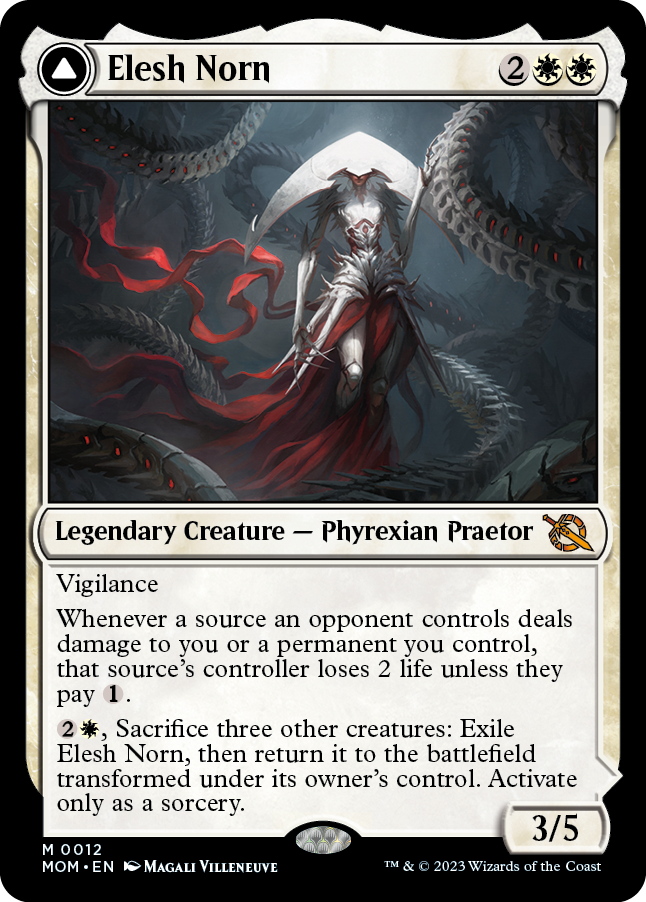
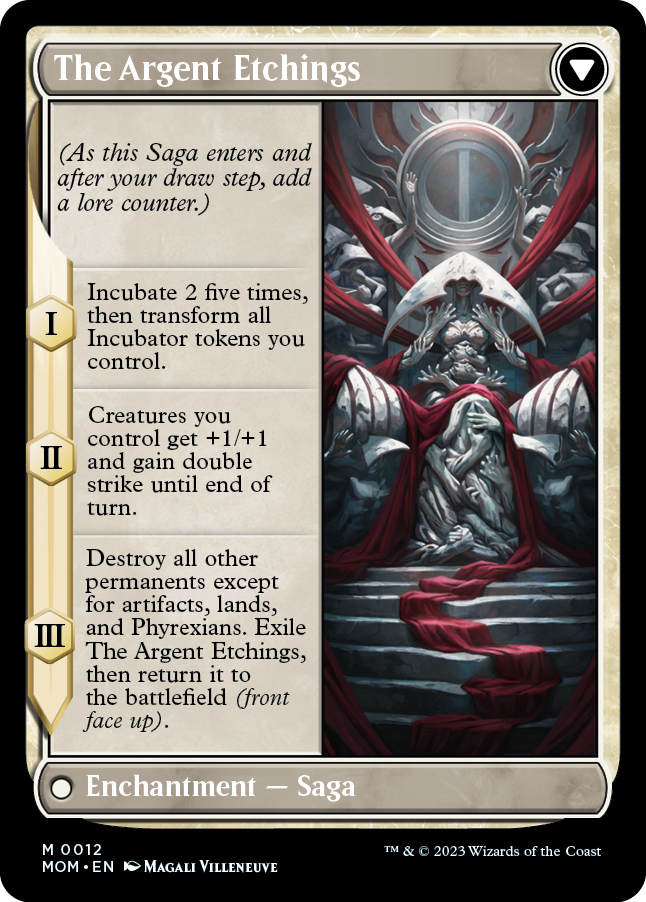
Elesh Norn
{2}{W}{W}
Legendary Creature — Phyrexian Praetor
3/5
Vigilance
Whenever a source an opponent controls deals damage to you or a permanent you control, that source's controller loses 2 life unless they pay {1}.
{2}{W}, Sacrifice three other creatures: Exile Elesh Norn, then return it to the battlefield transformed under its owner's control. Activate only as a sorcery.
////
The Argent Etchings
Enchantment — Saga
(As this Saga enters and after your draw step, add a lore counter.)
I — Incubate 2 five times, then transform all Incubator tokens you control.
II — Creatures you control get +1/+1 and gain double strike until end of turn.
III — Destroy all other permanents except for artifacts, lands, and Phyrexians. Exile The Argent Etchings, then return it to the battlefield (front face up).
- Elesh Norn's triggered ability will trigger separately for each permanent dealt damage by a source an opponent controls, plus once if you're dealt damage by that source. For example, if an opponent casts a spell that deals damage to you and two creatures you control, Elesh Norn's ability will trigger three times. Each of those abilities will cause that opponent to lose 2 life unless they pay {1}.
- Similarly, the triggered ability will trigger separately for each source an opponent controls that deals damage to you or a permanent you control. For example, if three creatures controlled by an opponent block and deal damage to an attacking creature you control, Elesh Norn's ability will trigger three times.
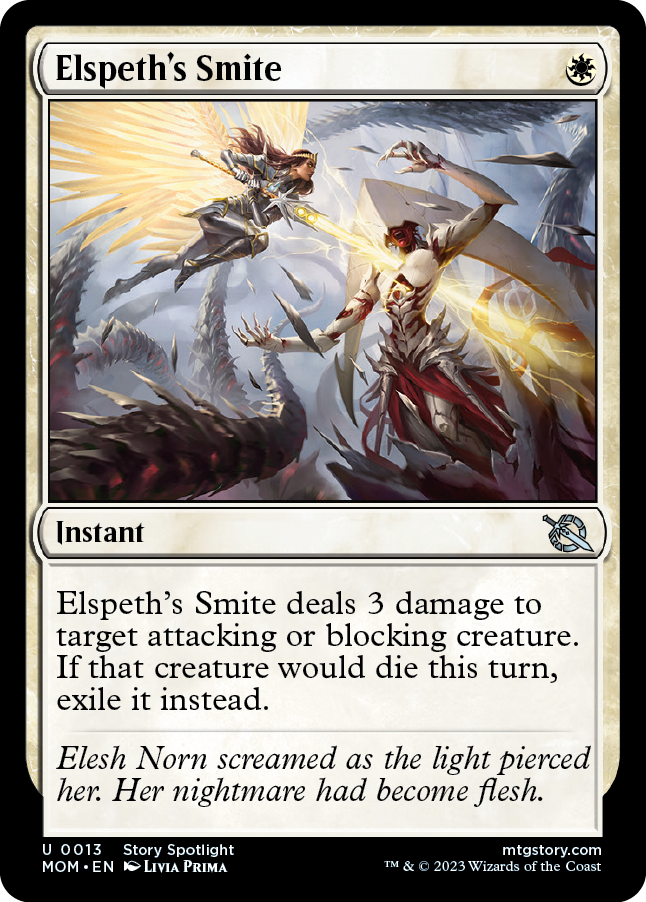
Elspeth's Smite
{W}
Instant
Elspeth's Smite deals 3 damage to target attacking or blocking creature. If that creature would die this turn, exile it instead.
- Creatures don't necessarily have to be dealt lethal damage by Elspeth's Smite to be exiled. After being dealt damage, if they would die for any reason that turn, they'll be exiled instead.
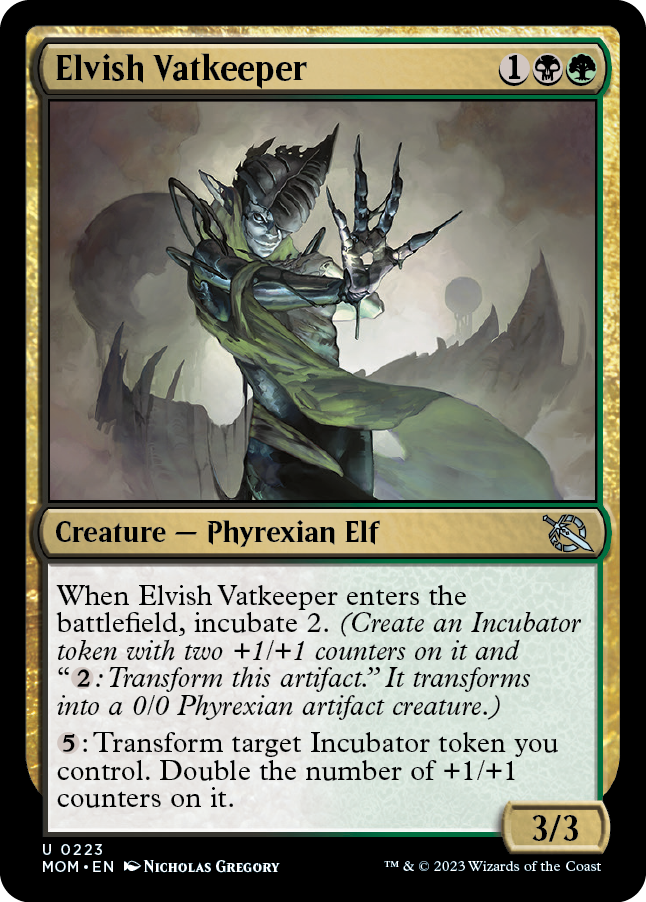
Elvish Vatkeeper
{1}{B}{G}
Creature — Phyrexian Elf
3/3
When Elvish Vatkeeper enters the battlefield, incubate 2. (Create an Incubator token with two +1/+1 counters on it and "{2}: Transform this artifact." It transforms into a 0/0 Phyrexian artifact creature.)
{5}: Transform target Incubator token you control. Double the number of +1/+1 counters on it.
- The target Incubator token transforms before its +1/+1 counters are doubled, so anything that cares about +1/+1 counters being placed on a creature will see them being placed on the Phyrexian artifact creature.
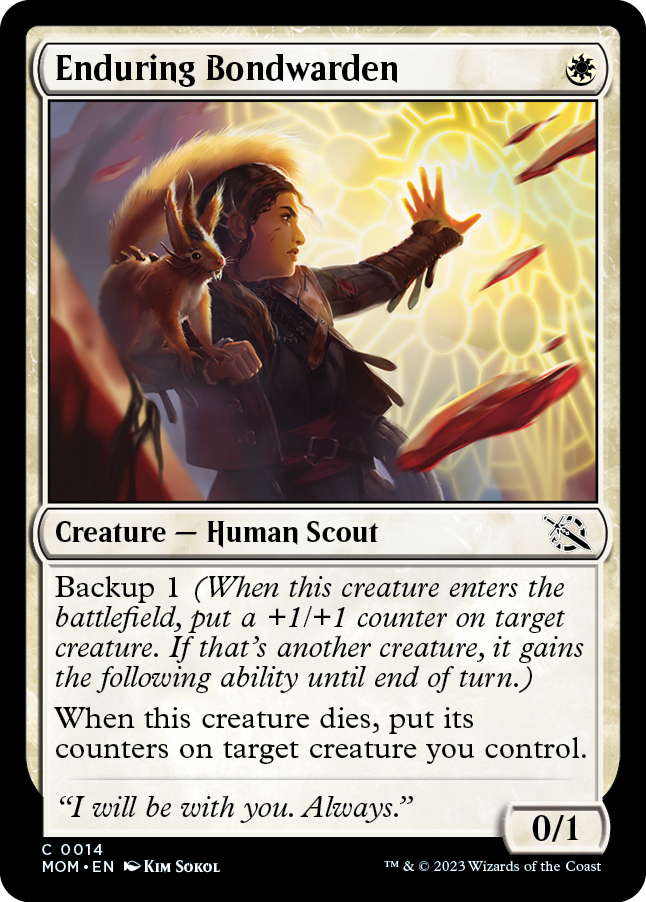
Enduring Bondwarden
{W}
Creature — Human Scout
0/1
Backup 1 (When this creature enters the battlefield, put a +1/+1 counter on target creature. If that's another creature, it gains the following ability until end of turn.)
When this creature dies, put its counters on target creature you control.
- Enduring Bondwarden's last ability puts counters that were on the creature with the ability onto the target creature, not just its +1/+1 counters.
- Enduring Bondwarden's last ability doesn't cause you to move counters from the creature with the ability onto the target creature. Rather, you put the same number of each kind of counter the first creature had when it died onto the target creature.
- In some unusual cases, you may end up putting the appropriate counters on more than one permanent. For example, if you control The Ozolith when Enduring Bondwarden dies, you'll put the appropriate number of each kind of counter onto both The Ozolith and the target creature.
- If the creature with Enduring Bondwarden's last ability has -1/-1 counters on it when it dies, that ability will include those as well. This may result in the recipient also dying.

Ephara's Dispersal
{2}{U}
Instant
This spell costs {2} less to cast if it targets an attacking creature.
Return target creature to its owner's hand. Surveil 2. (Look at the top two cards of your library, then put any number of them into your graveyard and the rest on top of your library in any order.)
- The cost reduction ability of Ephara's Dispersal doesn't affect its mana cost or mana value. It affects only the total cost you pay. Specifically, its mana value is always 3.
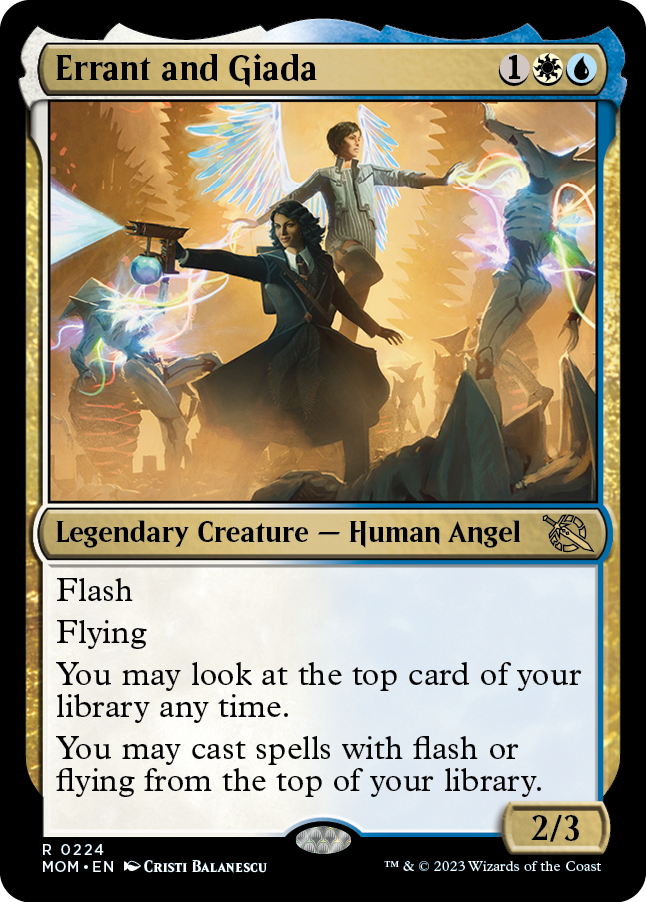
Errant and Giada
{1}{W}{U}
Legendary Creature — Human Angel
2/3
Flash
Flying
You may look at the top card of your library any time.
You may cast spells with flash or flying from the top of your library.
- Errant and Giada lets you look at the top card of your library whenever you want (with one restriction—see below), even if you don't have priority. This action doesn't use the stack. Knowing what that card is becomes part of the information you have access to, just like you can look at the cards in your hand.
- If the top card of your library changes while you're casting a spell, playing a land, or activating an ability, you can't look at the new top card until you finish doing so. This means that if you cast the top card of your library, you can't look at the next one until you're done paying for that spell.
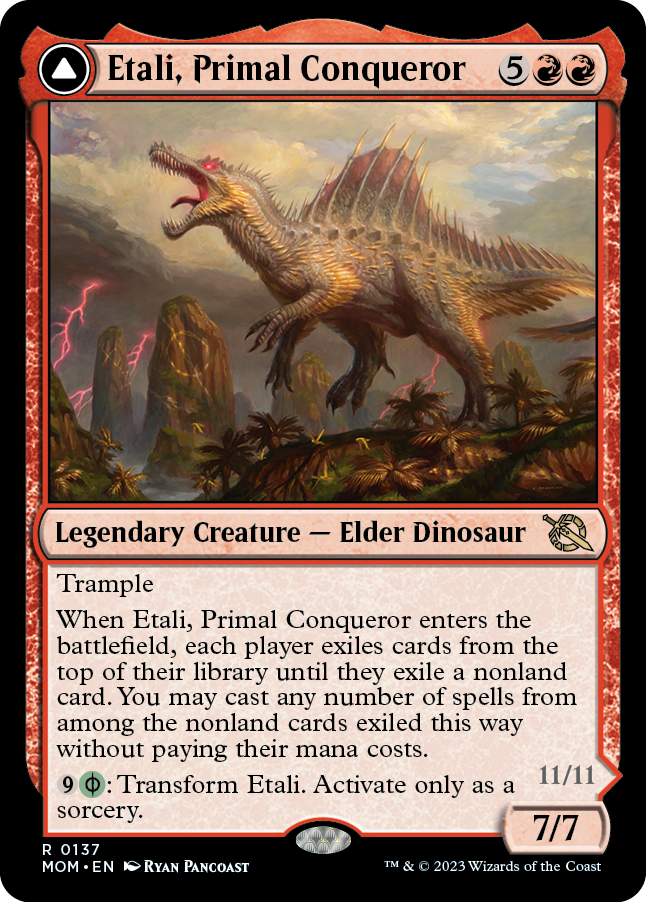
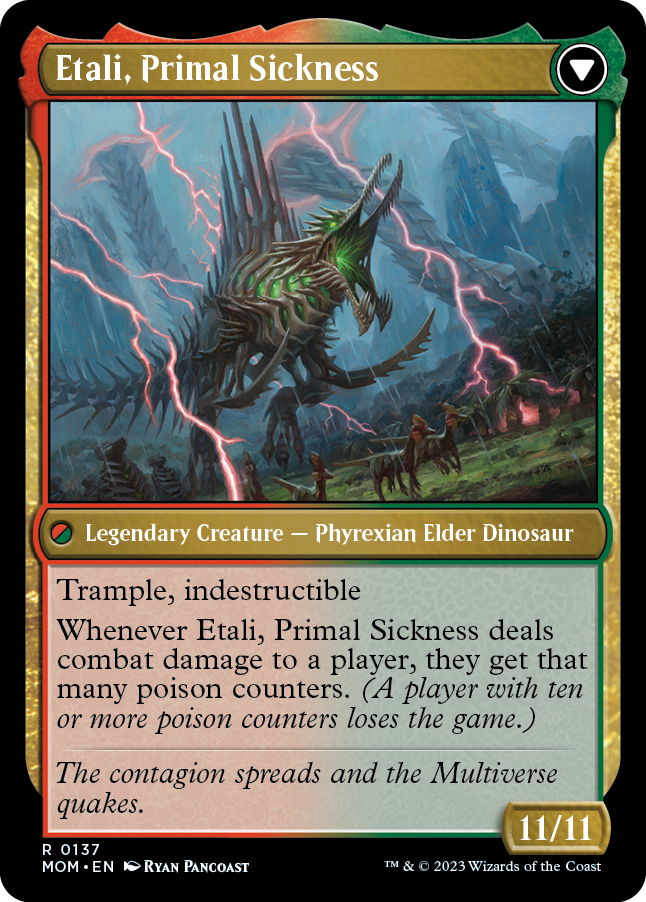
Etali, Primal Conqueror
{5}{R}{R}
Legendary Creature — Elder Dinosaur
7/7
Trample
When Etali, Primal Conqueror enters the battlefield, each player exiles cards from the top of their library until they exile a nonland card. You may cast any number of spells from among the nonland cards exiled this way without paying their mana costs.
{9}{G/P}: Transform Etali. Activate only as a sorcery.
/////
Etali, Primal Sickness
Legendary Creature — Phyrexian Elder Dinosaur
11/11
Trample, indestructible
Whenever Etali, Primal Sickness deals combat damage to a player, they get that many poison counters. (A player with ten or more poison counters loses the game.)
- If you cast any of the exiled cards, you do so as part of the resolution of the triggered ability. You can't wait to cast them later in the turn. Timing restrictions based on a card's type are ignored.
- If you cast a card "without paying its mana cost," you can't pay any alternative costs. You can, however, pay additional costs. If the card has any mandatory additional costs, those must be paid to cast the card.
- If an exiled card has {X} in its mana cost, you must choose 0 as the value of X when casting it without paying its mana cost.
- If you cast more than one of the exiled cards, you choose the order in which to cast them. A spell you cast this way can be the target of a later spell you cast this way. However, permanent spells cast this way won't resolve until you're done casting spells, so the permanents they become can't be the target of spells cast this way. For example, if you exile Twincast and Lightning Strike, you can cast Lightning Strike and then cast Twincast targeting it; but if you exile a creature card and an Aura card, you can't cast that Aura targeting that creature.
- Any cards not cast, including land cards, remain in exile. They can't be cast on later turns.
- In a multiplayer game, if a player leaves the game, all cards that player owns leave as well. If you leave the game, any spells or permanents you control from Etali's ability are exiled.
- Losing the game because a player (preferably an opponent) has ten or more poison counters is a rule of the game. Etali, Primal Sickness doesn't have to still be on the battlefield when someone (preferably an opponent) gets their tenth poison counter.
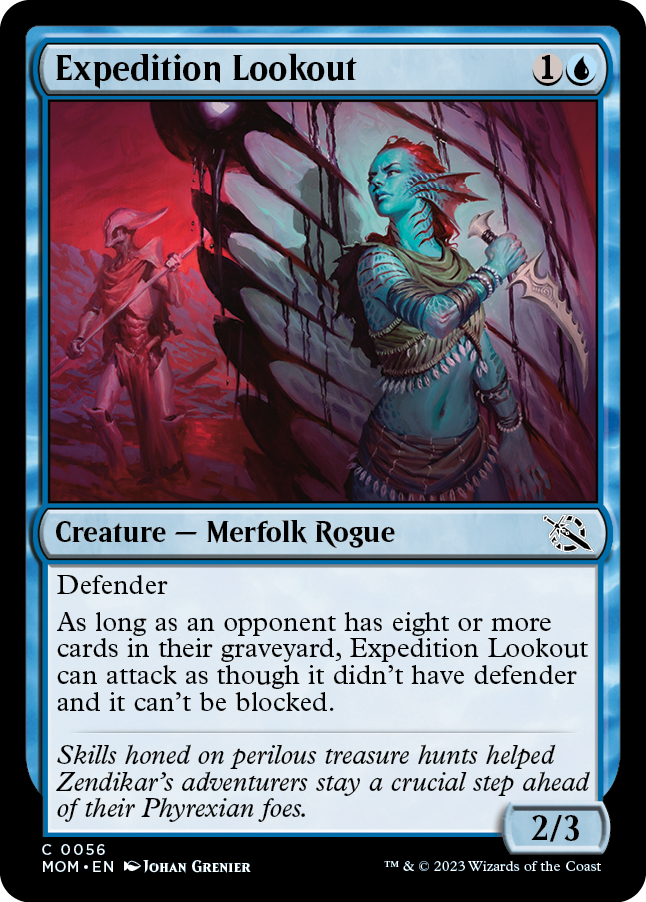
Expedition Lookout
{1}{U}
Creature — Merfolk Rogue
2/3
Defender
As long as an opponent has eight or more cards in their graveyard, Expedition Lookout can attack as though it didn't have defender and it can't be blocked.
- Expedition Lookout's last ability will apply if any opponent has eight or more cards in their graveyard, not necessarily all of them or even the one Expedition Lookout is attacking.
- Once Expedition Lookout has legally attacked, causing its last ability to not apply by removing cards from graveyards won't cause it to stop attacking. However, if you do so before blockers are declared (and it's attacking in your direction), you will be able to block it.

Faerie Mastermind
{1}{U}
Creature — Faerie Rogue
2/1
Flash
Flying
Whenever an opponent draws their second card each turn, you draw a card.
{3}{U}: Each player draws a card.
- Faerie Mastermind doesn't need to have been under your control when the first card is drawn for its ability to trigger. As long as you control it when an opponent draws their second card in a turn, that ability will trigger.
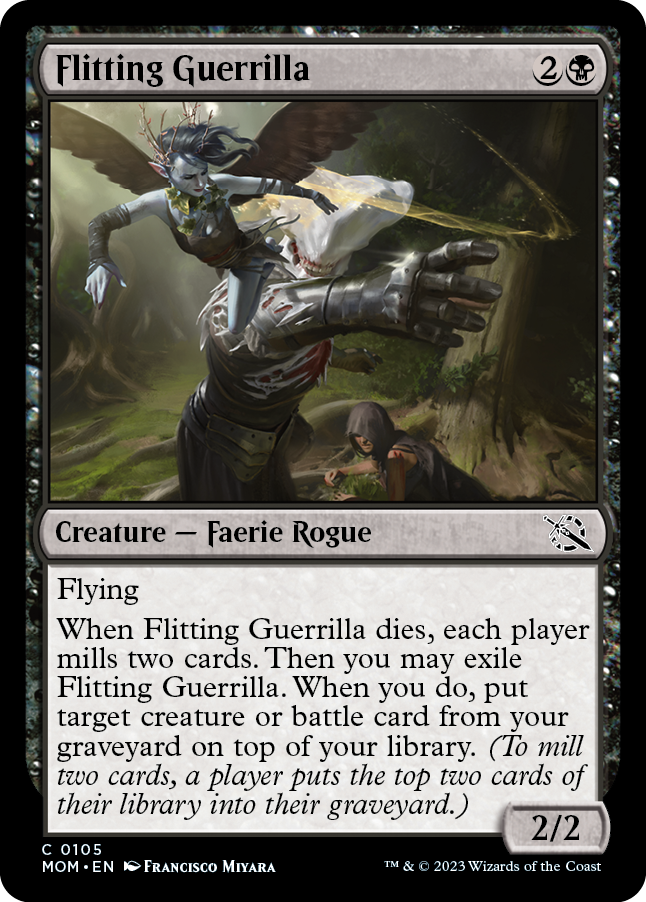
Flitting Guerrilla
{2}{B}
Creature — Faerie Rogue
2/2
Flying
When Flitting Guerrilla dies, each player mills two cards. Then you may exile Flitting Guerrilla. When you do, put target creature or battle card from your graveyard on top of your library. (To mill two cards, a player puts the top two cards of their library into their graveyard.)
- The triggered ability of Flitting Guerrilla triggers and goes on the stack without a target. If you exile Flitting Guerrilla, the second "reflexive" triggered ability will trigger. You'll choose the target creature or battle card for that second ability at that time. You may choose a card you just milled as the target or a card that was already in your graveyard.
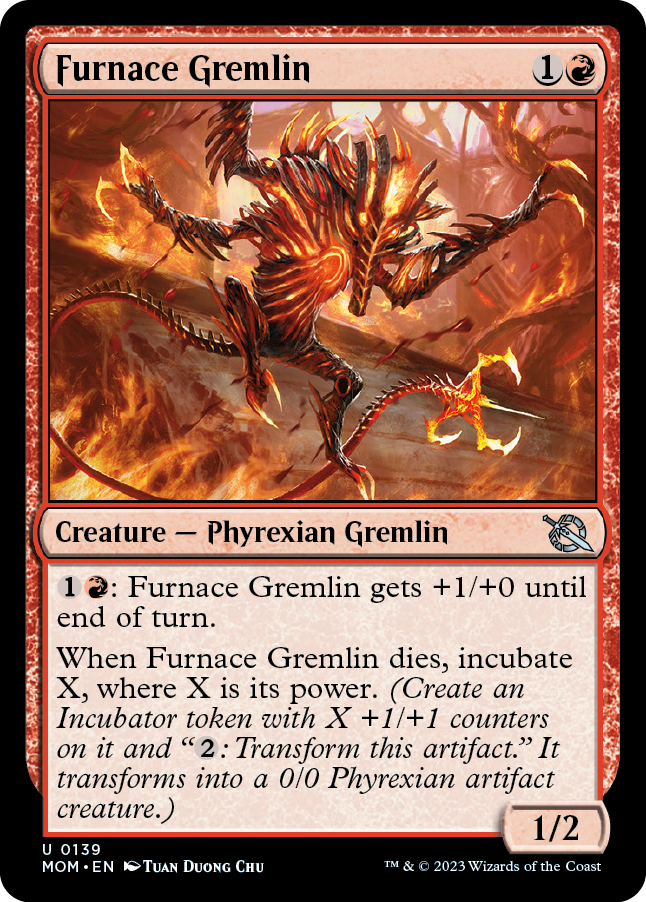
Furnace Gremlin
{1}{R}
Creature — Phyrexian Gremlin
1/2
{1}{R}: Furnace Gremlin gets +1/+0 until end of turn.
When Furnace Gremlin dies, incubate X, where X is its power. (Create an Incubator token with X +1/+1 counters on it and "{2}: Transform this artifact." It transforms into a 0/0 Phyrexian artifact creature.)
- Use Furnace Gremlin's power from when it was last on the battlefield to determine the value of X.
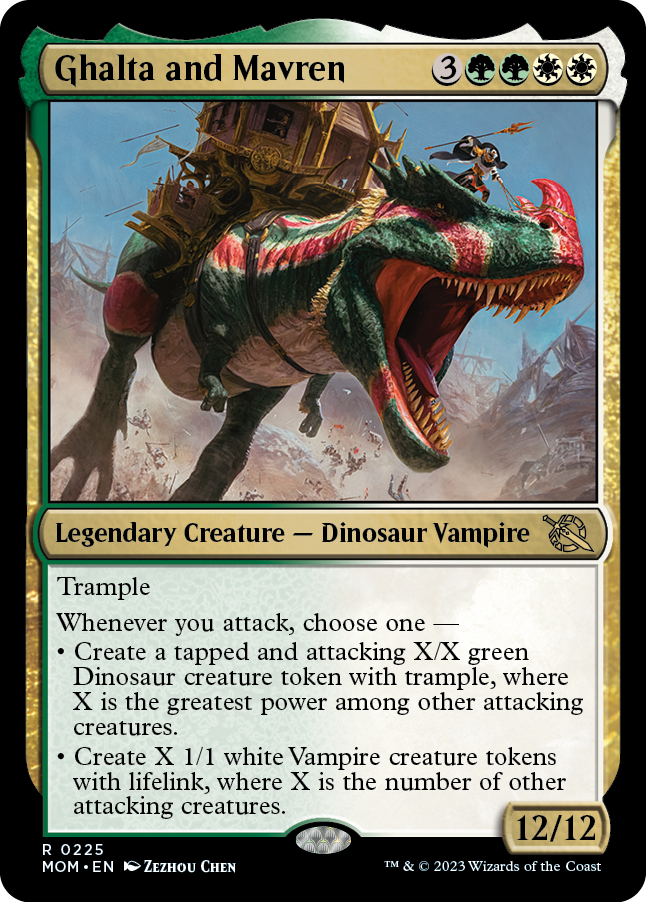
Ghalta and Mavren
{3}{G}{G}{W}{W}
Legendary Creature — Dinosaur Vampire
12/12
Trample
Whenever you attack, choose one —
• Create a tapped and attacking X/X green Dinosaur creature token with trample, where X is the greatest power among other attacking creatures.
• Create X 1/1 white Vampire creature tokens with lifelink, where X is the number of other attacking creatures.
- For both modes, the value of X is determined as the ability resolves.
- If you choose the first mode and there are no other attacking creatures, you'll create a 0/0 Dinosaur token. Unless something else is immediately raising its toughness, the token will die. You won't have time to respond with a spell or ability to try and save it. A similar situation occurs if the greatest power among other attacking creatures is 0 or less.
- Although the Dinosaur token enters the battlefield attacking, it was never declared as an attacking creature (for the purposes of abilities that trigger whenever a creature attacks, for example).
- You choose which player, planeswalker, or battle the Dinosaur token is attacking. It doesn't have to be the same player, planeswalker, or battle that Ghalta and Mavren is attacking.
- If you choose the second mode and there are no other attacking creatures, you won't create any Vampire tokens.

Glistening Dawn
{2}{G}{G}
Sorcery
Incubate X twice, where X is the number of lands you control. (To incubate X, create an Incubator token with X +1/+1 counters on it and "{2}: Transform this artifact." It transforms into a 0/0 Phyrexian artifact creature.)
- Use the number of lands you control as Glistening Dawn resolves to determine the value of X.
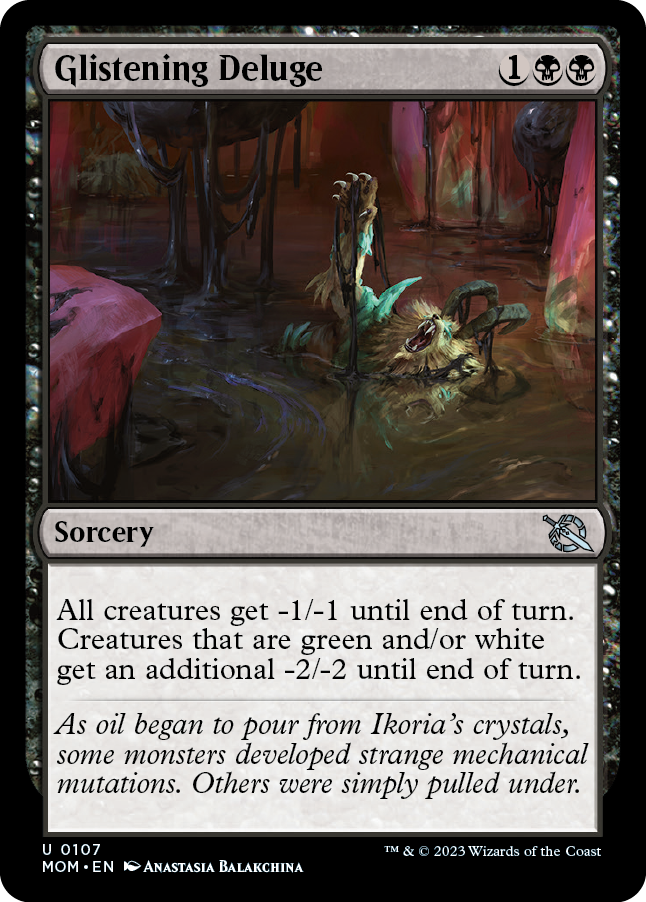
Glistening Deluge
{1}{B}{B}
Sorcery
All creatures get -1/-1 until end of turn. Creatures that are green and/or white get an additional -2/-2 until end of turn.
- All effects of Glistening Deluge are determined as it resolves. Creatures that enter the battlefield later in the turn won't get -1/-1 or -3/-3, nor will noncreature permanents that become creatures. A creature that gets -1/-1 won't get an additional -2/-2 if it later becomes green and/or white. A green and/or white creature that gets -3/-3 won't have the -2/-2 rescinded if it later stops being green and white.

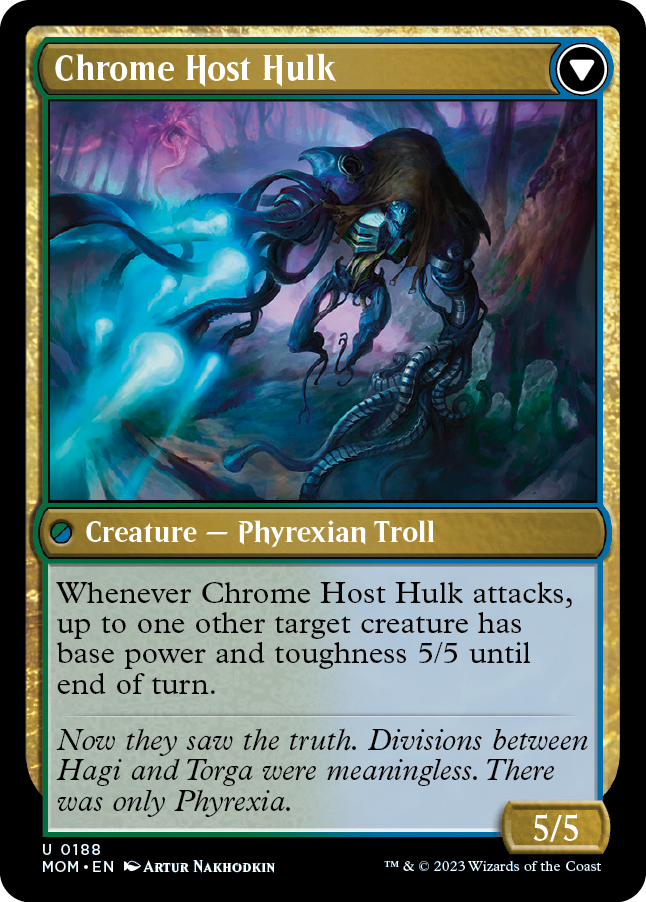
Gnottvold Hermit
{3}{G}
Creature — Troll
4/4
{5}{U/P}: Transform Gnottvold Hermit. Activate only as a sorcery. ({U/P} can be paid with either {U} or 2 life.)
////
Chrome Host Hulk
Creature — Phyrexian Troll
5/5
Whenever Chrome Host Hulk attacks, up to one other target creature has base power and toughness 5/5 until end of turn.
- Chrome Host Hulk's ability overwrites all previous effects that set the affected creatures' power and/or toughness to specific values. Other effects that set these characteristics to specific values that start to apply after the ability resolves will overwrite that part of the effect.
- Effects that modify the affected creature's power or toughness without setting it will apply no matter when they started to take effect. The same is true for counters that change the creature's power or toughness.

Halo Forager
{1}{U}{B}
Creature — Faerie Rogue
3/1
Flying
When Halo Forager enters the battlefield, you may pay {X}. When you do, you may cast target instant or sorcery card with mana value X from a graveyard without paying its mana cost. If that spell would be put into a graveyard, exile it instead.
- Halo Forager's enters-the-battlefield ability triggers and goes on the stack without a target. If you pay mana, the second "reflexive" triggered ability will trigger. You'll choose the target instant or sorcery card for that second ability at that time, based on the value you chose for X.
- You choose whether or not to cast the target instant or sorcery card as the reflexive triggered ability resolves. If you do, you do so as part of the resolution of the triggered ability. You can't wait to cast it later in the turn. Timing restrictions based on the card's type are ignored.
- If you cast a card "without paying its mana cost," you can't pay any alternative costs. You can, however, pay additional costs. If the card has any mandatory additional costs, those must be paid to cast the card.
- If the card has {X} in its mana cost, you must choose 0 as the value of X when casting it without paying its mana cost.
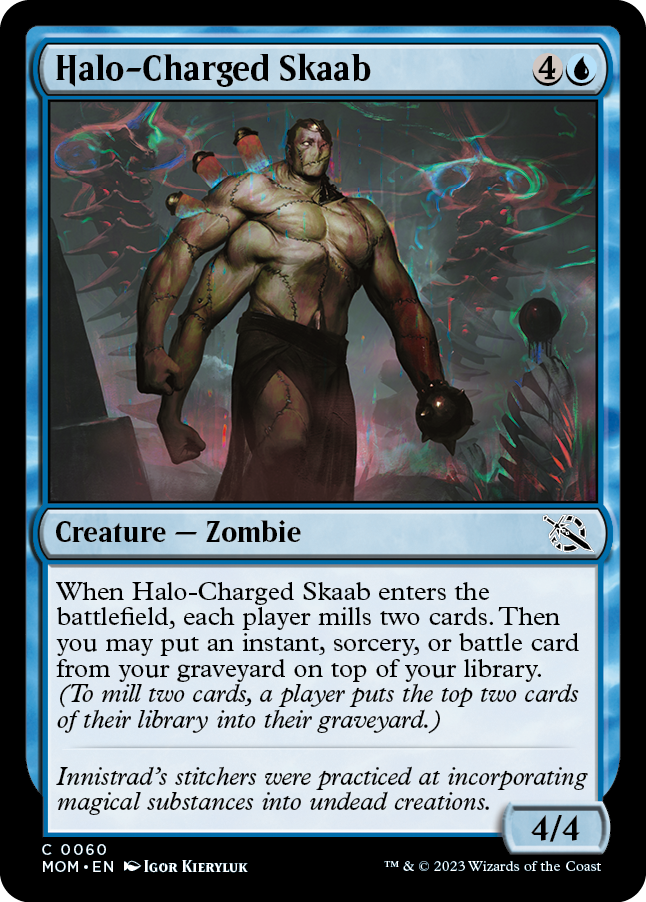
Halo-Charged Skaab
{4}{U}
Creature — Zombie
4/4
When Halo-Charged Skaab enters the battlefield, each player mills two cards. Then you may put an instant, sorcery, or battle card from your graveyard on top of your library. (To mill two cards, a player puts the top two cards of their library into their graveyard.)
- The card you put on top of your library, if any, may be one you just milled, or it can be one that was already in your graveyard.
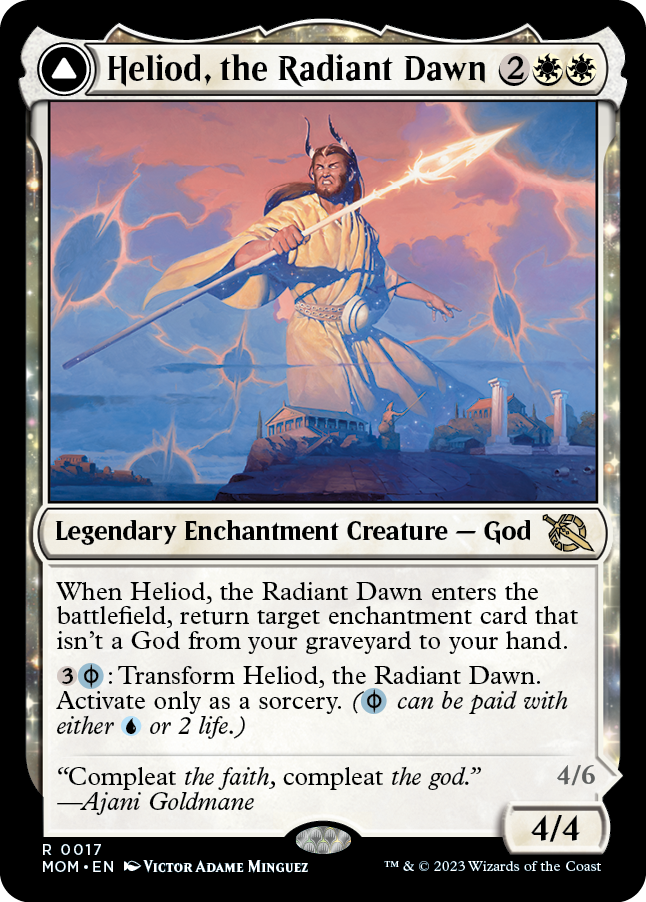
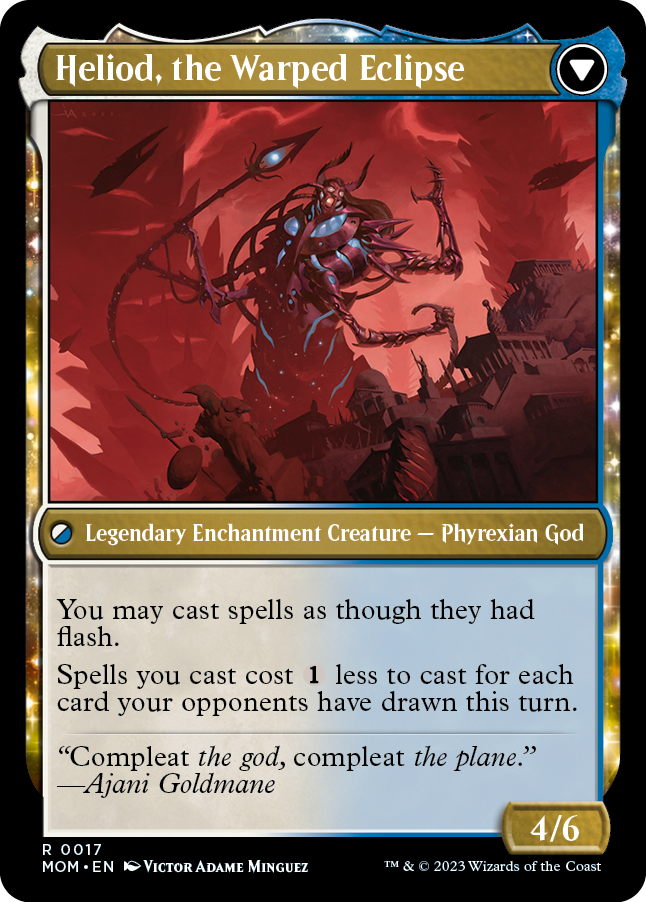
Heliod, the Radiant Dawn
{2}{W}{W}
Legendary Enchantment Creature — God
4/4
When Heliod, the Radiant Dawn enters the battlefield, return target enchantment card that isn't a God from your graveyard to your hand.
{3}{U/P}: Transform Heliod, the Radiant Dawn. Activate only as a sorcery. ({U/P} can be paid with either {U} or 2 life.)
////
Heliod, the Warped Eclipse
Legendary Enchantment Creature — Phyrexian God
4/6
You may cast spells as though they had flash.
Spells you cast cost {1} less to cast for each card your opponents have drawn this turn.
- The "as though they had flash" effect applies only to casting spells. It does not, for example, change when you may activate abilities that can be activated "only as a sorcery."
- The last ability of Heliod, the Warped Eclipse doesn't change the mana cost or mana value of any spell. It changes only the total cost you pay.
- That ability can't reduce the amount of colored mana you pay for a spell. It reduces only the generic mana component of that cost.
- If there are additional costs to cast a spell, or if the cost to cast a spell is increased by an effect (such as the one created by Thalia, Guardian of Thraben's ability), apply those increases before applying cost reductions.
- The cost reduction can apply to alternative costs such as flashback costs.
- If a spell you cast has {X} in its mana cost, you choose the value of X before calculating the spell's total cost. For example, if a spell's mana cost is {X}{R} and your opponents have drawn two cards this turn, you could choose 5 as the value of X and pay {3}{R} to cast the spell.
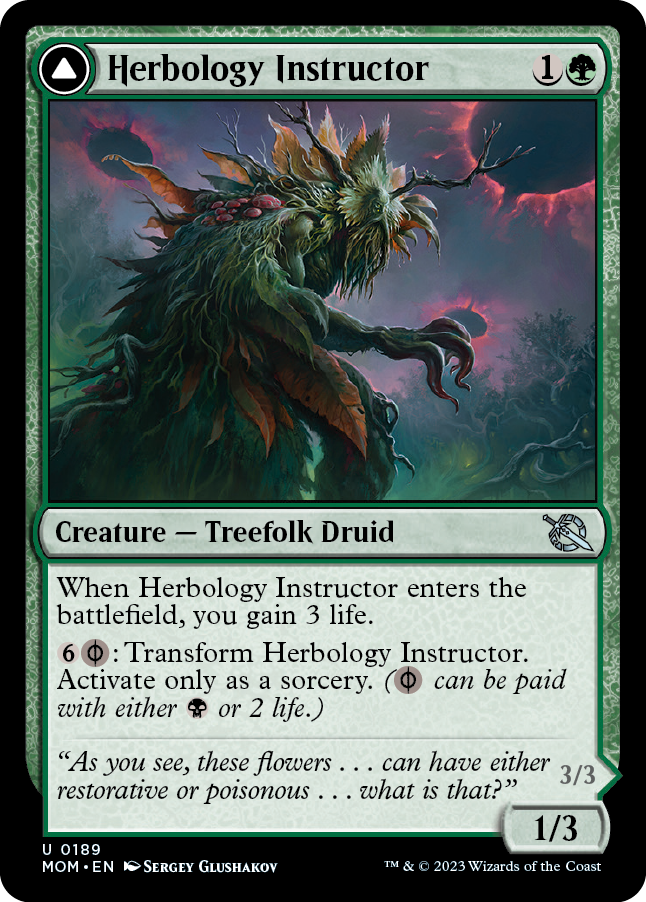
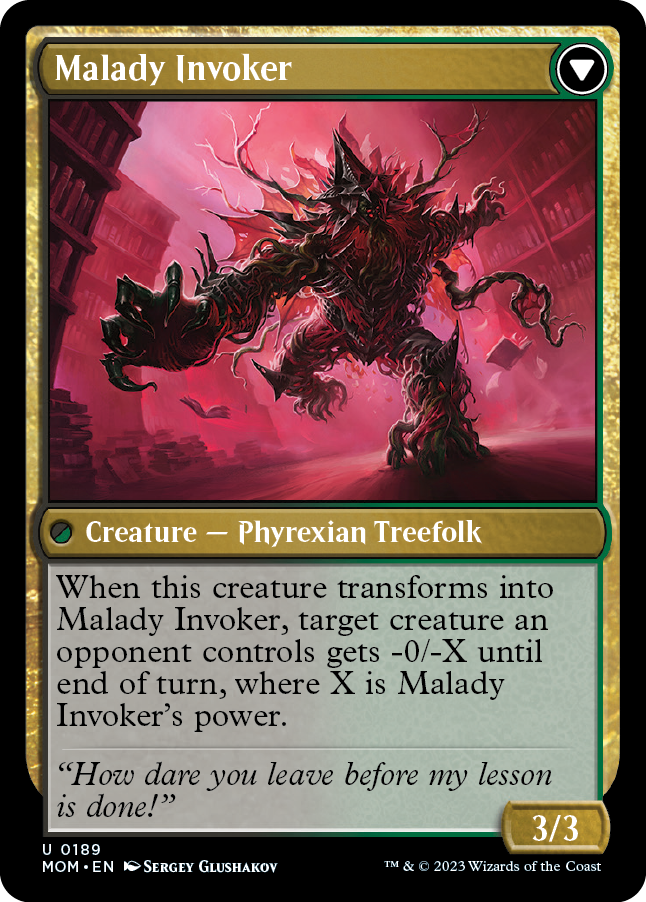
Herbology Instructor
{1}{G}
Creature — Treefolk Druid
1/3
When Herbology Instructor enters the battlefield, you gain 3 life.
{6}{B/P}: Transform Herbology Instructor. Activate only as a sorcery. ({B/P} can be paid with either {B} or 2 life.)
////
Malady Invoker
Creature — Phyrexian Treefolk
3/3
When this creature transforms into Malady Invoker, target creature an opponent controls gets -0/-X until end of turn, where X is Malady Invoker's power.
- Use Malady Invoker's power as its ability resolves to determine the value of X. If Malady Invoker is no longer on the battlefield at that time, use its power when it was last on the battlefield.
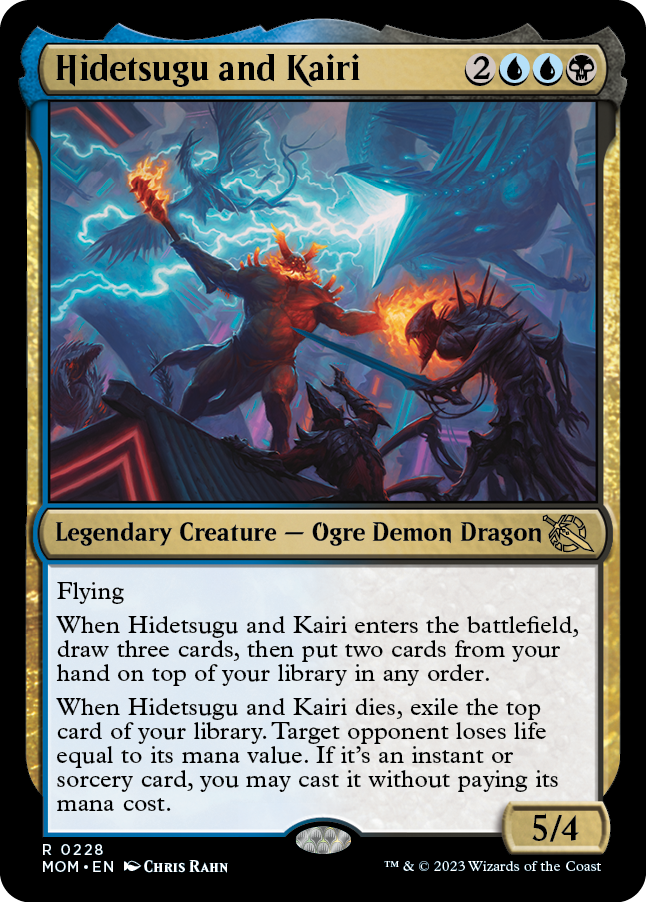
Hidetsugu and Kairi
{2}{U}{U}{B}
Legendary Creature — Ogre Demon Dragon
5/4
Flying
When Hidetsugu and Kairi enters the battlefield, draw three cards, then put two cards from your hand on top of your library in any order.
When Hidetsugu and Kairi dies, exile the top card of your library. Target opponent loses life equal to its mana value. If it's an instant or sorcery card, you may cast it without paying its mana cost.
- The two cards you put on top of your library can be from the three you just drew or ones that were already in your hand.
- The last triggered ability targets the opponent. If that player is an illegal target as the ability tries to resolve, the ability won't resolve and none of its effects will happen. You won't exile a card.
- You choose whether or not to cast the instant or sorcery card as the last triggered ability resolves. If you do, you do so as part of the resolution of that ability. You can't wait to cast it later in the turn. Timing restrictions based on the card's type are ignored.
- If you cast a card "without paying its mana cost," you can't pay any alternative costs. You can, however, pay additional costs. If the card has any mandatory additional costs, those must be paid to cast the card.
- If the card has {X} in its mana cost, you must choose 0 as the value of X when casting it without paying its mana cost.
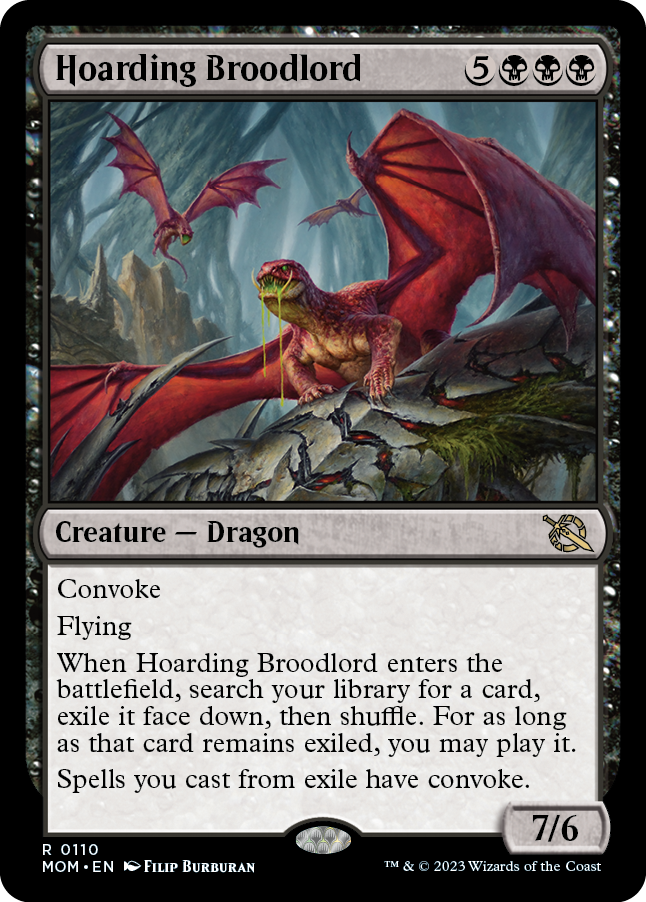
Hoarding Broodlord
{5}{B}{B}{B}
Creature — Dragon
7/6
Convoke
Flying
When Hoarding Broodlord enters the battlefield, search your library for a card, exile it face down, then shuffle. For as long as that card remains exiled, you may play it.
Spells you cast from exile have convoke.
- As long as that card remains exiled, you may look at it. This remains true after Hoarding Broodlord leaves the battlefield.
- If another player gains control of Hoarding Broodlord, it's still you who can look at and play the exiled card. That player won't be able to look at or play the exiled card.
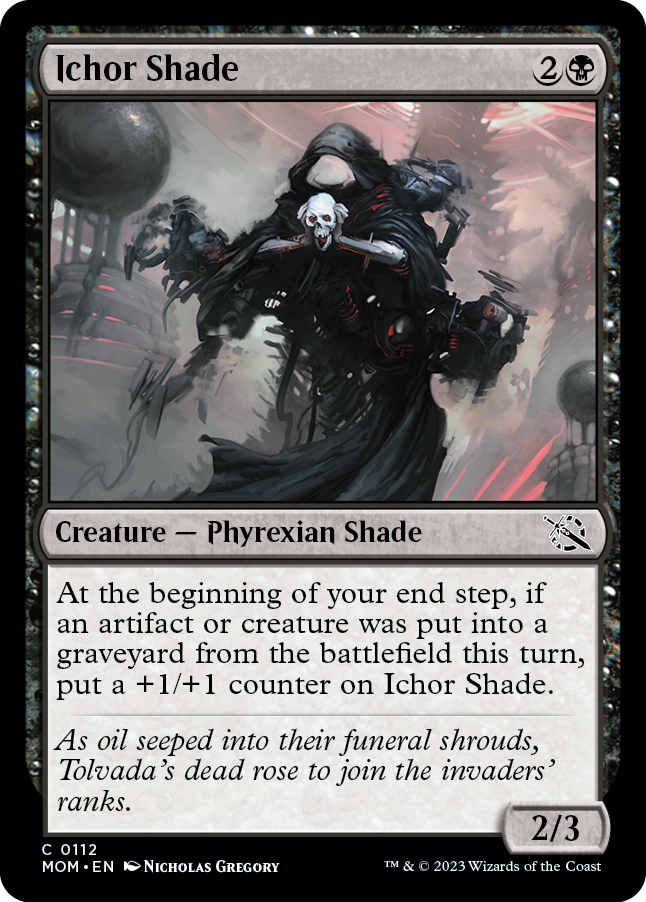
Ichor Shade
{2}{B}
Creature — Phyrexian Shade
2/3
At the beginning of your end step, if an artifact or creature was put into a graveyard from the battlefield this turn, put a +1/+1 counter on Ichor Shade.
- Ichor Shade's ability will check as your end step begins if an artifact or creature was put into a graveyard from the battlefield this turn. If none have, the ability won't trigger at all.
- The ability will count any artifact or creature that was put into a graveyard, including tokens.
- If a nontoken artifact or creature is put into a graveyard, it doesn't matter what happens to the card afterward. Ichor Shade's ability will count it even if the card has left the graveyard by the time the ability resolves.
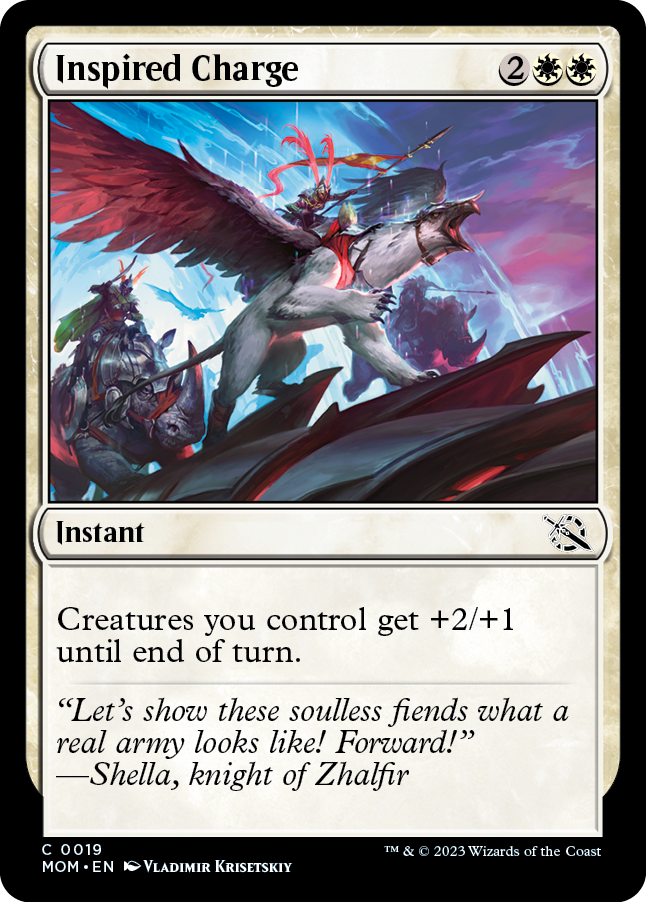
Inspired Charge
{2}{W}{W}
Instant
Creatures you control get +2/+1 until end of turn.
- The set of creatures affected by Inspired Charge is determined as the spell resolves. Creatures you begin to control later in the turn and noncreature permanents that become creatures later in the turn won't get +2/+1.

Into the Fire
{2}{R}
Sorcery
Choose one —
• Into the Fire deals 2 damage to each creature, planeswalker, and battle.
• Put any number of cards from your hand on the bottom of your library, then draw that many cards plus one.
- If you choose the second mode, you choose how many cards to put on the bottom of your library as Into the Fire resolves. You may choose to put no cards on the bottom of your library and just draw a card.
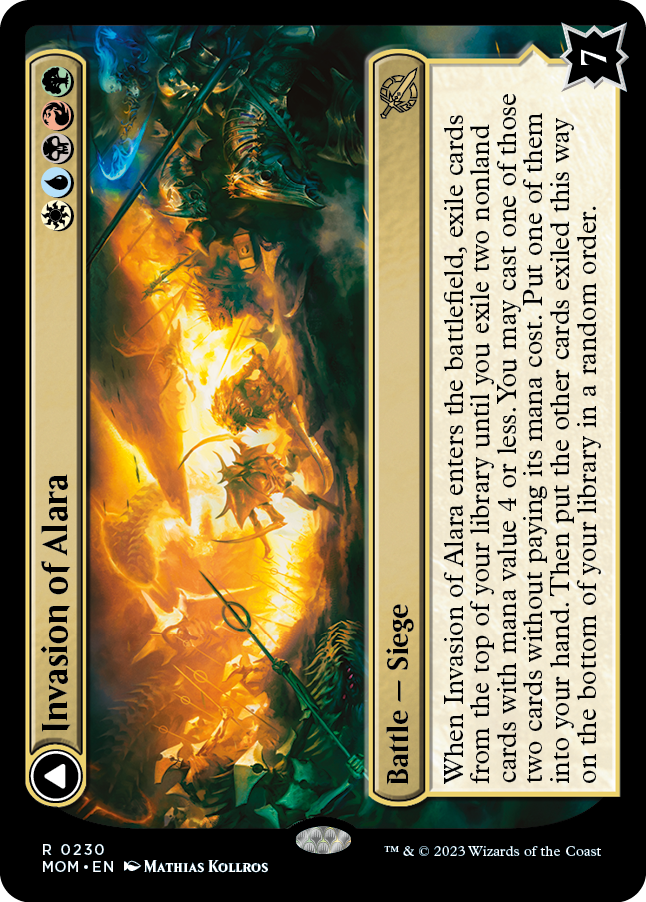
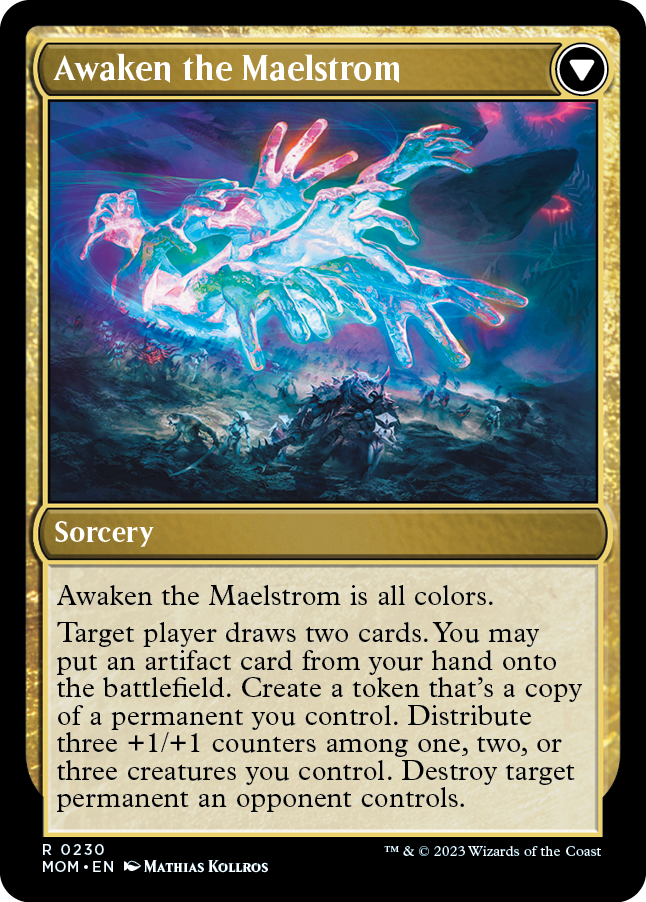
Invasion of Alara
{W}{U}{B}{R}{G}
Battle — Siege
When Invasion of Alara enters the battlefield, exile cards from the top of your library until you exile two nonland cards with mana value 4 or less. You may cast one of those two cards without paying its mana cost. Put one of them into your hand. Then put the other cards exiled this way on the bottom of your library in a random order.
7
////
Awaken the Maelstrom
Sorcery
Awaken the Maelstrom is all colors.
Target player draws two cards. You may put an artifact card from your hand onto the battlefield. Create a token that's a copy of a permanent you control. Distribute three +1/+1 counters among one, two, or three creatures you control. Destroy target permanent an opponent controls.
- For Invasion of Alara's triggered ability, if you exile two nonland cards with mana value 4 or less, but you don't cast one of them, the one you don't put into your hand will remain in exile. It won't be put on the bottom of your library.
- If you exile only one nonland card with mana value 4 or less, you'll have the option to cast it. If you don't, you'll put it into your hand.
- If you cast a spell without paying its mana cost, you can't choose to cast it for any alternative costs. You can, however, pay any additional costs. If the spell has any mandatory additional costs, you must pay those.
- If the spell has {X} in its mana cost, you must choose 0 as the value of X when casting it without paying its mana cost.
- Awaken the Maelstrom has two targets: the player who will draw cards and the permanent an opponent controls that will be destroyed. You must choose legal targets for both to cast Awaken the Maelstrom. All other choices are made on resolution. Specifically, this means you can create a token that's a copy of the artifact you just put onto the battlefield (which perhaps you just drew) and then put +1/+1 counters on it if it's also a creature.
- The token copies exactly what was printed on the original permanent and nothing else (unless that permanent is copying something else or is a token; see below). It doesn't copy whether that permanent is tapped or untapped, whether it has any counters on it or Auras and Equipment attached to it, or any non-copy effects that have changed its power, toughness, types, color, and so on.
- If the copied permanent has {X} in its mana cost, X is 0.
- If the copied permanent is a token, the token that's created copies the original characteristics of that token as stated by the effect that created that token.
- If the copied permanent is copying something else, then the token enters the battlefield as whatever that permanent copied.
- Any enters-the-battlefield abilities of the copied permanent will trigger when the token enters the battlefield. Any "as [this permanent] enters the battlefield" or "[this permanent] enters the battlefield with" abilities of the copied permanent will also work.
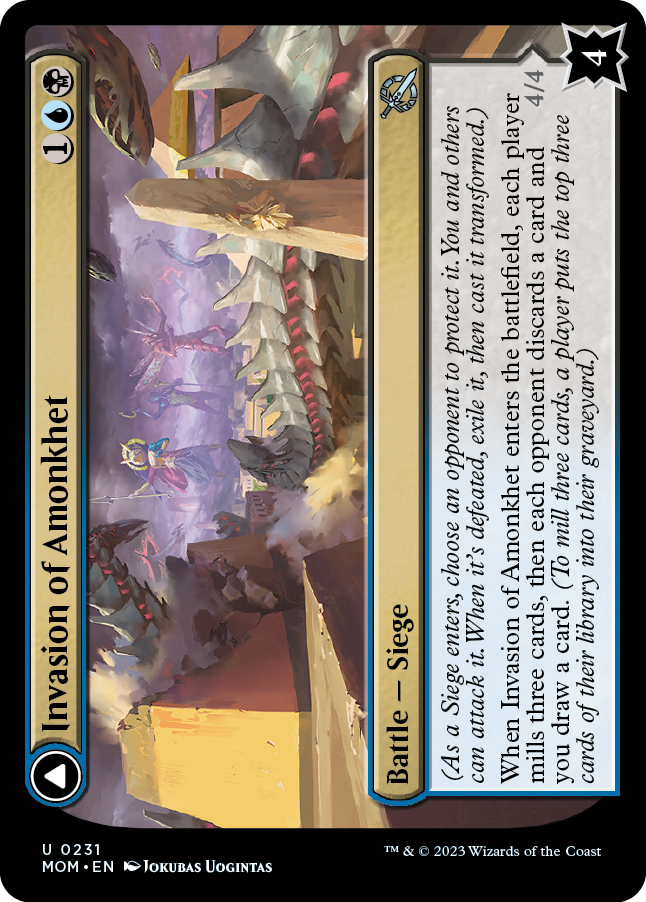
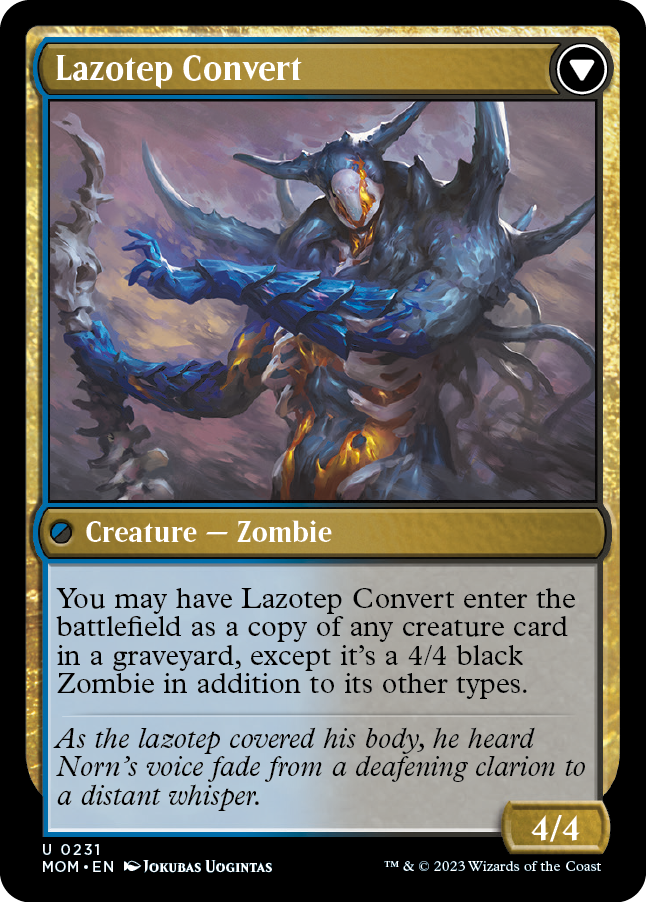
Invasion of Amonkhet
{1}{U}{B}
Battle — Siege
(As a Siege enters, choose an opponent to protect it. You and others can attack it. When it's defeated, exile it, then cast it transformed.)
When Invasion of Amonkhet enters the battlefield, each player mills three cards, then each opponent discards a card and you draw a card. (To mill three cards, a player puts the top three cards of their library into their graveyard.)
4
////
Lazotep Convert
Creature — Zombie
4/4
You may have Lazotep Convert enter the battlefield as a copy of any creature card in a graveyard, except it's a 4/4 black Zombie in addition to its other colors and types.
- To resolve Invasion of Amonkhet's enters-the-battlefield ability, first each player mills three cards. Then the next opponent in turn order (or, if it's an opponent's turn, the opponent whose turn it is) chooses a card in hand and sets it aside without revealing it. Then each other opponent in turn order does the same. Finally, all chosen cards are revealed and discarded at the same time. Finally, you draw a card.
- Lazotep Convert has received an update to its official rules text to clarify that it keeps its other colors and types as part of its copy effect.
- Lazotep Convert copies exactly what was printed on the original creature card, with the noted exceptions.
- Any enters-the-battlefield abilities of the copied creature card will trigger when Lazotep Convert enters the battlefield. Any "as [this creature] enters the battlefield" or "[this creature] enters the battlefield with" abilities of the chosen creature card will also work.
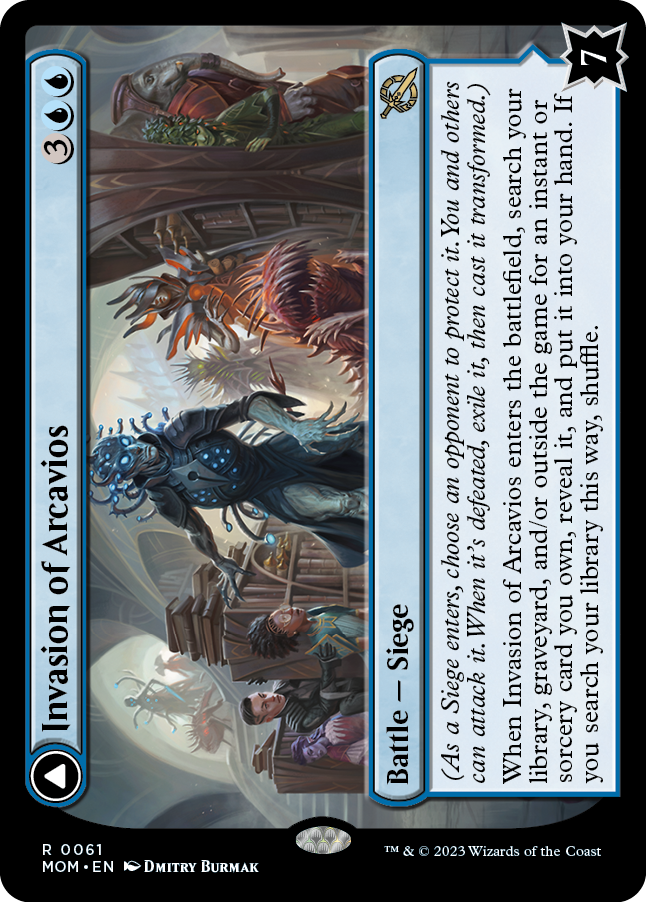

Invasion of Arcavios
{3}{U}{U}
Battle — Siege
(As a Siege enters, choose an opponent to protect it. You and others can attack it. When it's defeated, exile it, then cast it transformed.)
When Invasion of Arcavios enters the battlefield, search your library, graveyard, and/or outside the game for an instant or sorcery card you own, reveal it, and put it into your hand. If you search your library this way, shuffle.
7
////
Invocation of the Founders
Enchantment
Whenever you cast an instant or sorcery spell from your hand, you may copy that spell. You may choose new targets for the copy.
- In a casual game, a card you choose from outside the game comes from your personal collection. In a tournament event, a card you choose from outside the game comes from your sideboard. You may look at your sideboard at any time.
- You don't have to declare up front where you're going to search. You may search your library, pause, sigh, check out your graveyard, frown meaningfully at your opponent, then finally grab a game-winning sorcery card from your sideboard. Bit dramatic though.
- A copy of a spell is created on the stack, so it's not "cast." Abilities that trigger when a player casts a spell won't trigger.
- If you copy a spell, you control the copy. It will resolve before the original spell does.
- The copy will have the same targets as the spell it's copying unless you choose new ones. You may change any number of the targets, including all of them or none of them. If, for one of the targets, you can't choose a new legal target, then it remains unchanged (even if the current target is illegal).
- If the spell that's copied is modal (that is, it includes a choice from a bulleted list of effects), the copy will have the same mode. A different mode can't be chosen.
- If the spell that's copied has an X whose value was determined as it was cast, the copy will have the same value of X.
- If the spell has damage divided as it was cast, the division can't be changed (although the targets receiving that damage still can). The same is true of spells that distribute counters.
- You can't choose to pay any alternative or additional costs for the copy. However, effects based on any alternative or additional costs that were paid for the original spell are copied as though those same costs were paid for the copy.
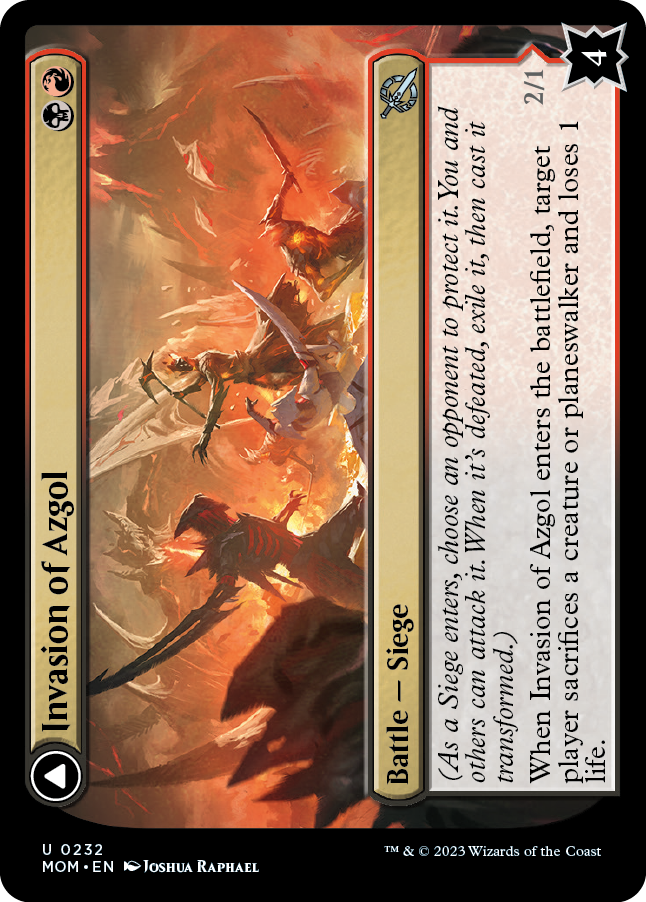

Invasion of Azgol
{B}{R}
Battle — Siege
(As a Siege enters, choose an opponent to protect it. You and others can attack it. When it's defeated, exile it, then cast it transformed.)
When Invasion of Azgol enters the battlefield, target player sacrifices a creature or planeswalker and loses 1 life.
4
////
Ashen Reaper
Creature — Zombie Elemental
2/1
Menace
At the beginning of your end step, put a +1/+1 counter on Ashen Reaper if a permanent was put into a graveyard from the battlefield this turn.
- Ashen Reaper's ability triggers at the beginning of each of your end steps, even if nothing has entered any graveyard that turn. The ability checks as it resolves whether to put a +1/+1 counter on Ashen Reaper or not. This means the ability will count any permanent that's put into a graveyard in response to the ability.
- The ability will count any permanent that was put into a graveyard, including token permanents.
- If a nontoken permanent is put into a graveyard, it doesn't matter what happens to the permanent card afterward. Ashen Reaper's ability will count it even if the card has left the graveyard by the time the ability resolves.
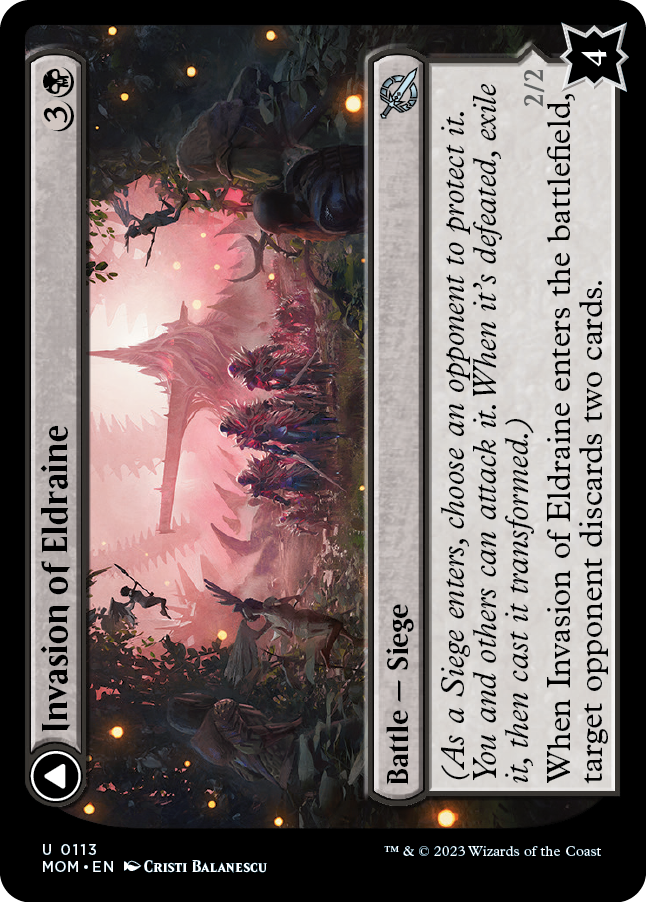

Invasion of Eldraine
{3}{B}
Battle — Siege
(As a Siege enters, choose an opponent to protect it. You and others can attack it. When it's defeated, exile it, then cast it transformed.)
When Invasion of Eldraine enters the battlefield, target opponent discards two cards.
4
////
Prickle Faeries
Creature — Faerie
2/2
Flying
At the beginning of each opponent's upkeep, if that player has two or fewer cards in hand, Prickle Faeries deals 2 damage to them.
- Prickle Faeries's ability will check as each opponent's upkeep begins whether that player has two or fewer cards in hand. If they have three or more, the ability won't trigger at all. If the ability does trigger, it will check the opponent's hand again as it tries to resolve. If the opponent has three or more cards in hand at that time, the ability won't resolve, and Prickle Faeries won't deal damage to them.
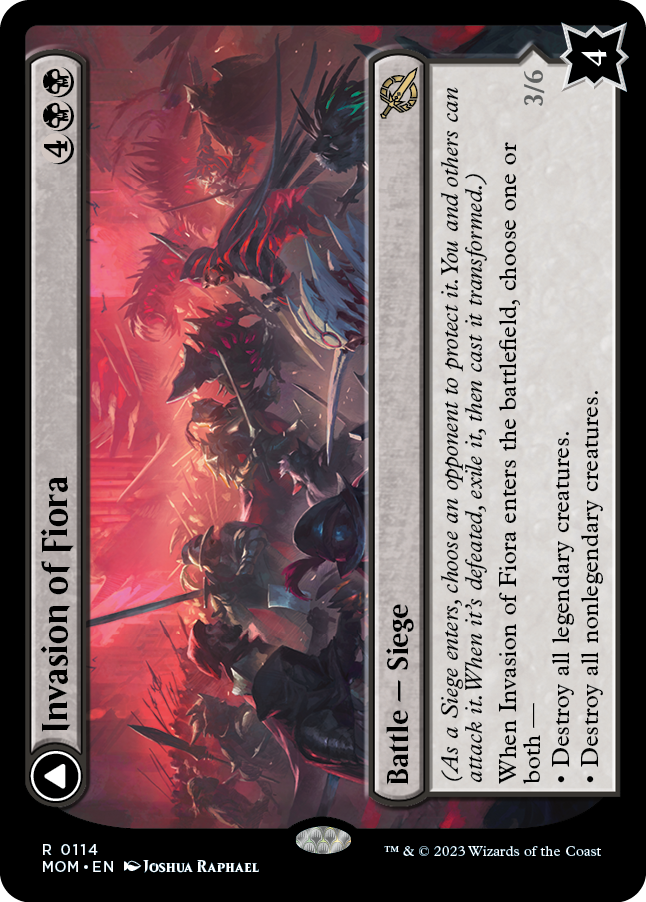

Invasion of Fiora
{4}{B}{B}
Battle — Siege
(As a Siege enters, choose an opponent to protect it. You and others can attack it. When it's defeated, exile it, then cast it transformed.)
When Invasion of Fiora enters the battlefield, choose one or both —
• Destroy all legendary creatures.
• Destroy all nonlegendary creatures.
4
////
Marchesa, Resolute Monarch
Legendary Creature — Human Noble
3/6
Menace, deathtouch
Whenever Marchesa, Resolute Monarch attacks, remove all counters from up to one target permanent.
At the beginning of your upkeep, if you haven't been dealt combat damage since your last turn, you draw a card and you lose 1 life.
- If you choose both modes for Invasion of Fiora's enters-the-battlefield ability, the modes happen in order. First all legendary creatures are destroyed, then all nonlegendary creatures.
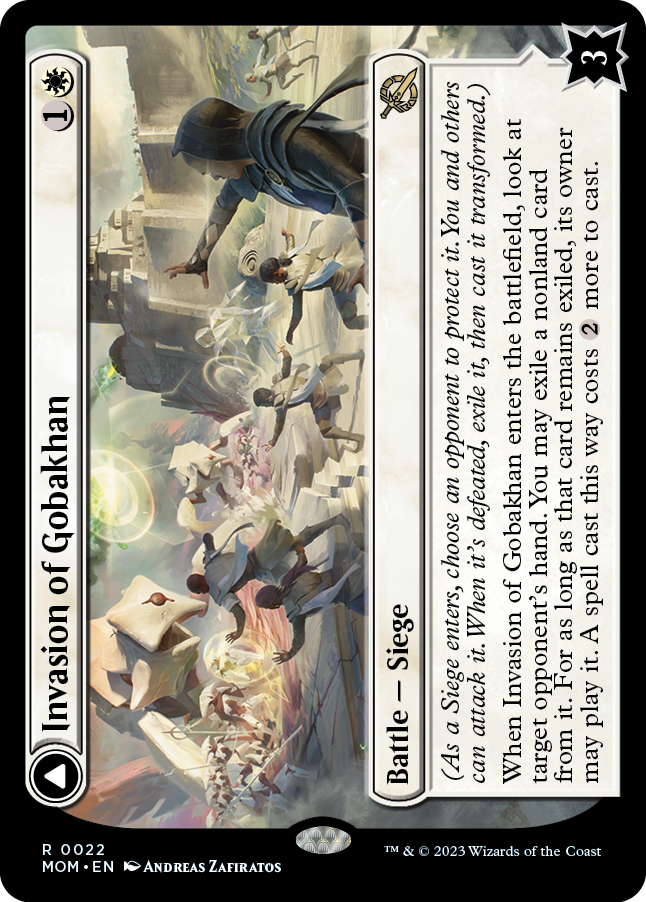
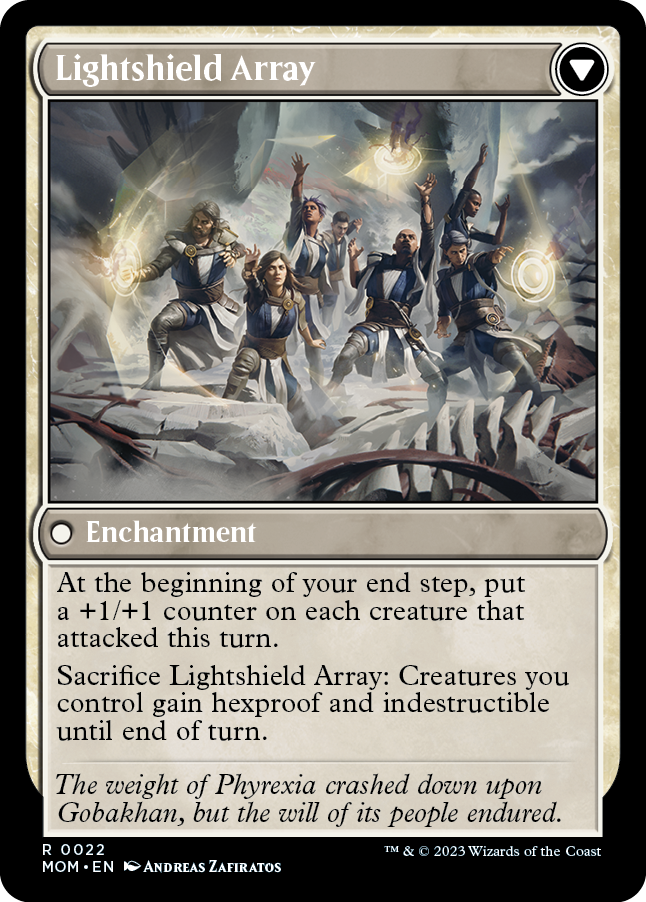
Invasion of Gobakhan
{1}{W}
Battle — Siege
(As a Siege enters, choose an opponent to protect it. You and others can attack it. When it's defeated, exile it, then cast it transformed.)
When Invasion of Gobakhan enters the battlefield, look at target opponent's hand. You may exile a nonland card from it. For as long as that card remains exiled, its owner may play it. A spell cast this way costs {2} more to cast.
3
////
Lightshield Array
Enchantment
At the beginning of your end step, put a +1/+1 counter on each creature that attacked this turn.
Sacrifice Lightshield Array: Creatures you control gain hexproof and indestructible until end of turn.
- Playing the exiled card follows all normal timing restrictions.
- If the exiled card is a modal double-faced card and its back face is a land, its owner may play it as a land. (Note that if the front face is also a land, you couldn't have exiled it to begin with.)
- The set of creatures affected by Lightshield Array's last ability is determined as the ability resolves. Creatures you begin to control later in the turn and noncreature permanents that become creatures later in the turn won't gain hexproof and indestructible.
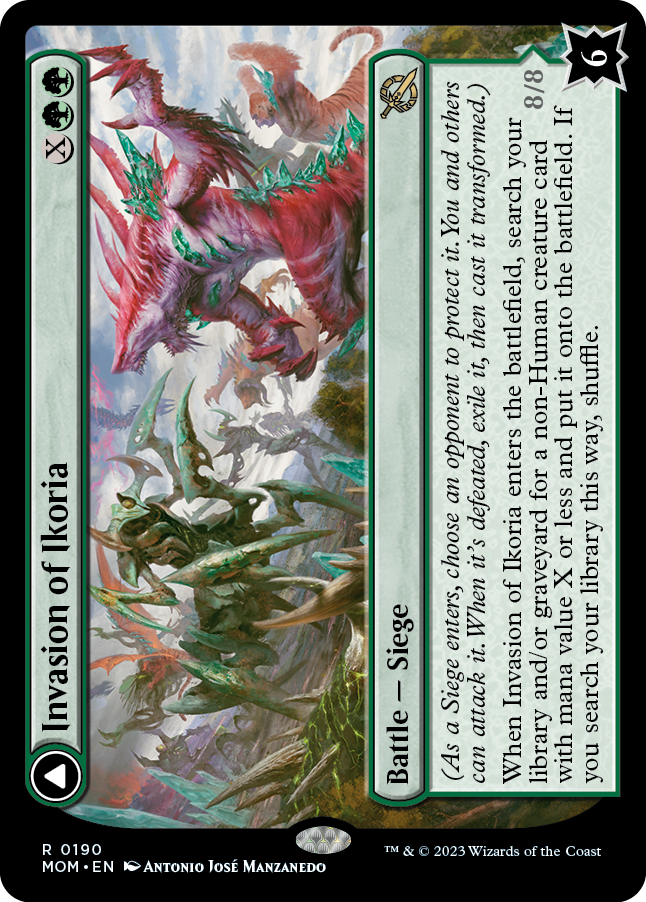
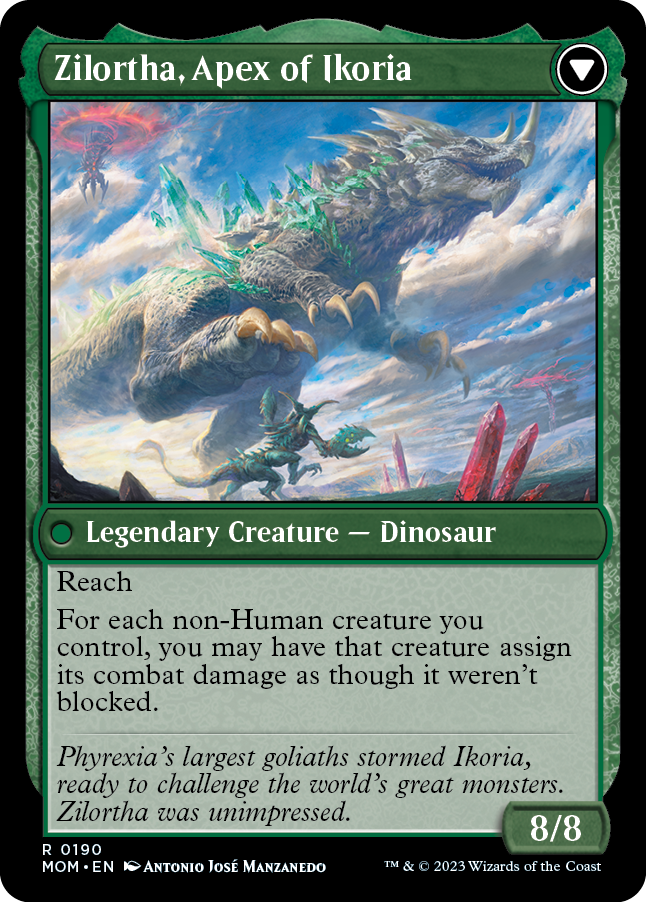
Invasion of Ikoria
{X}{G}{G}
Battle — Siege
(As a Siege enters, choose an opponent to protect it. You and others can attack it. When it's defeated, exile it, then cast it transformed.)
When Invasion of Ikoria enters the battlefield, search your library and/or graveyard for a non-Human creature card with mana value X or less and put it onto the battlefield. If you search your library this way, shuffle.
6
////
Zilortha, Apex of Ikoria
Legendary Creature — Dinosaur
8/8
Reach
For each non-Human creature you control, you may have that creature assign its combat damage as though it weren't blocked.
- You decide whether to assign a non-Human creature's combat damage as though it weren't blocked just before it assigns that damage. You may make a different choice for each non-Human creature you control—that is, you may have none, some, or all of those creatures assign combat damage as though they weren't blocked.
- Assigning a creature's damage as though it weren't blocked is all or nothing. You can't use this effect to assign some of the creature's damage to a blocking creature and the rest to the player, planeswalker, or battle it's attacking.
- Even if a creature assigns damage as though it were not blocked, it will still receive damage from creatures that are blocking it.
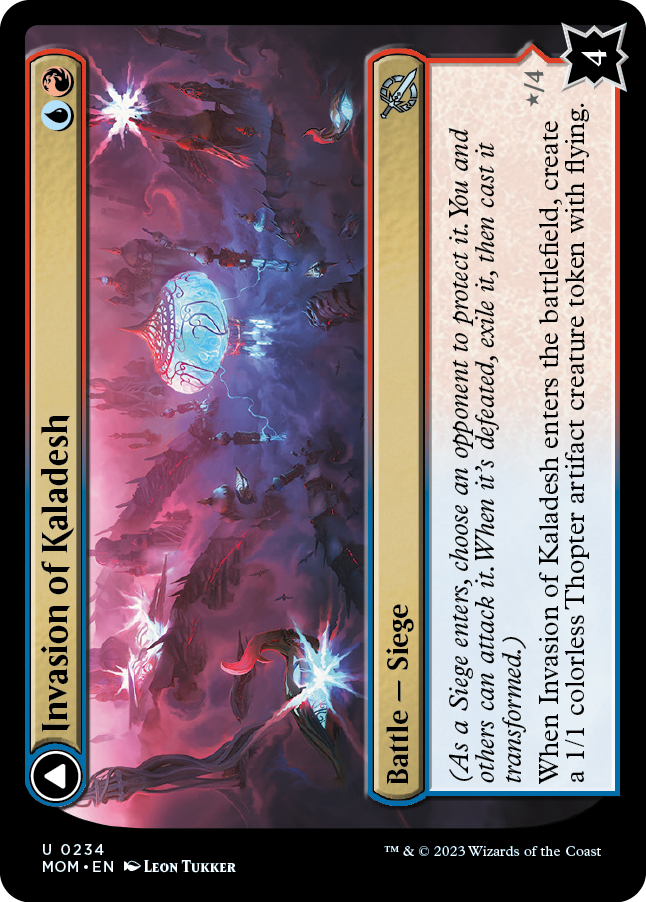
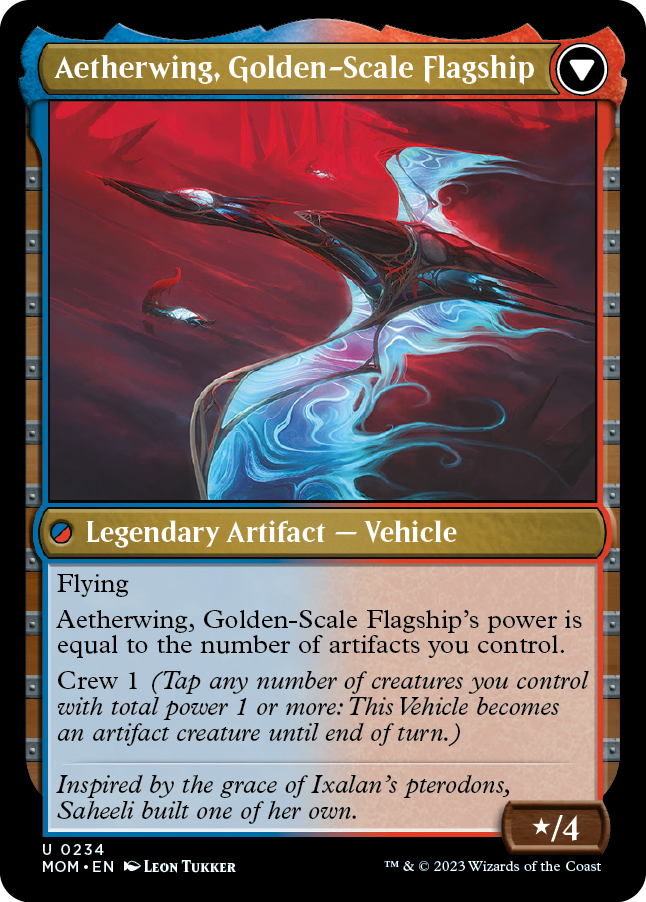
Invasion of Kaladesh
{U}{R}
Battle — Siege
(As a Siege enters, choose an opponent to protect it. You and others can attack it. When it's defeated, exile it, then cast it transformed.)
When Invasion of Kaladesh enters the battlefield, create a 1/1 colorless Thopter artifact creature token with flying.
4
////
Aetherwing, Golden-Scale Flagship
Legendary Artifact — Vehicle
*/4
Flying
Aetherwing, Golden-Scale Flagship's power is equal to the number of artifacts you control.
Crew 1 (Tap any number of creatures you control with total power 1 or more: This Vehicle becomes an artifact creature until end of turn.)
- As long as Aetherwing is still an artifact, its ability will count Aetherwing itself.
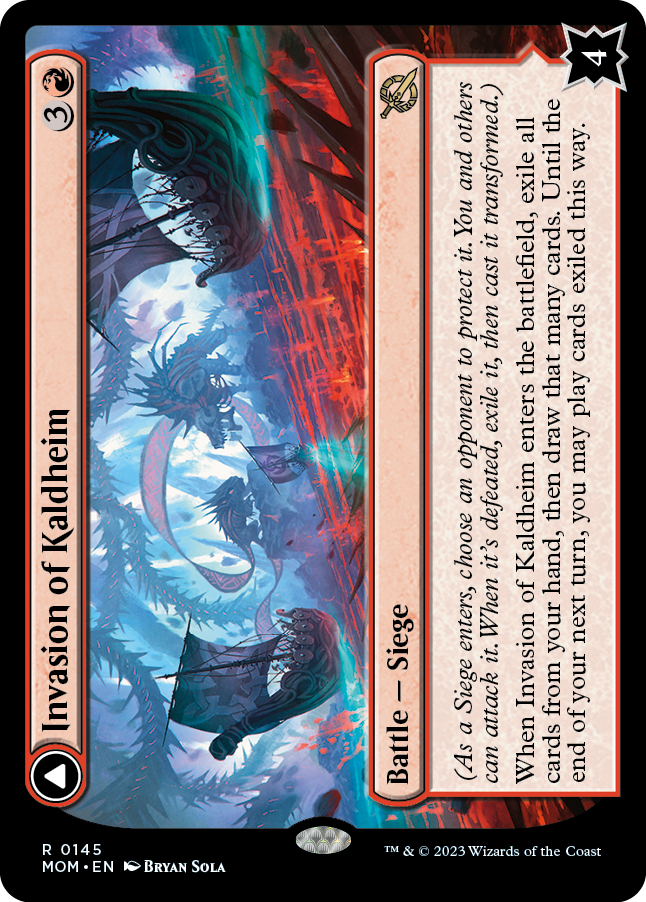
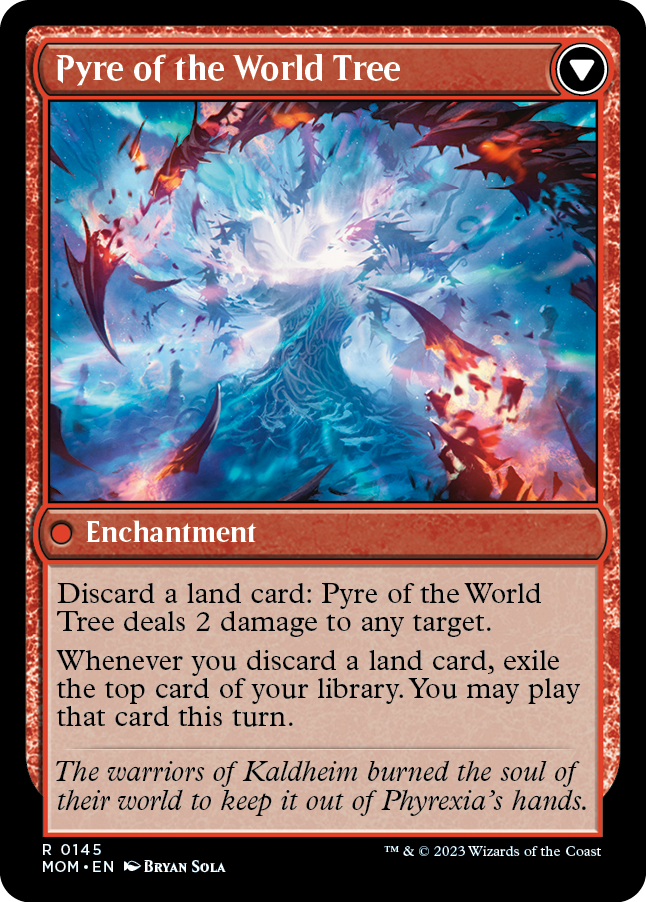
Invasion of Kaldheim
{3}{R}
Battle — Siege
(As a Siege enters, choose an opponent to protect it. You and others can attack it. When it's defeated, exile it, then cast it transformed.)
When Invasion of Kaldheim enters the battlefield, exile all cards from your hand, then draw that many cards. Until the end of your next turn, you may play cards exiled this way.
4
////
Pyre of the World Tree
Enchantment
Discard a land card: Pyre of the World Tree deals 2 damage to any target.
Whenever you discard a land card, exile the top card of your library. You may play that card this turn.
- Both Invasion of Kaldheim and Pyre of the World Tree have an ability that allow you to play cards from exile. You may play those cards during the specified duration even if the permanent with the ability leaves the battlefield or you lose control of it.
- Playing the exiled cards follows the normal rules for playing those cards. You must pay their costs, and you must follow all applicable timing rules. For example, if one of the cards is a creature card, you can cast that card by paying its mana cost only during your main phase while the stack is empty.
- Unless an effect allows you to play additional lands that turn, you can play an exiled land card only if you haven't played a land yet that turn.
- Any cards you don't play will remain exiled.
- The last ability of Pyre of the World Tree will trigger whenever you discard a land card for any reason, not just because you activated its other ability.
- If that ability triggers during the cleanup step because you discarded a land card to bring your hand size down to your maximum hand size, you will get priority after the ability resolves, so you'll have a chance to cast an instant card or a card with flash you exiled. Whether you cast the exiled card or not, there will be then be another cleanup step before the turn ends.
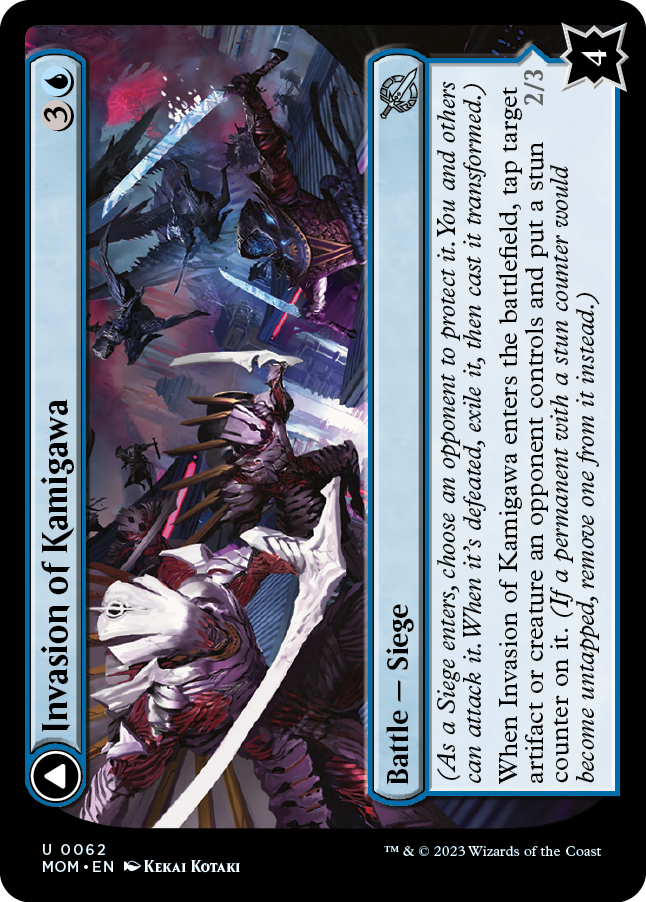
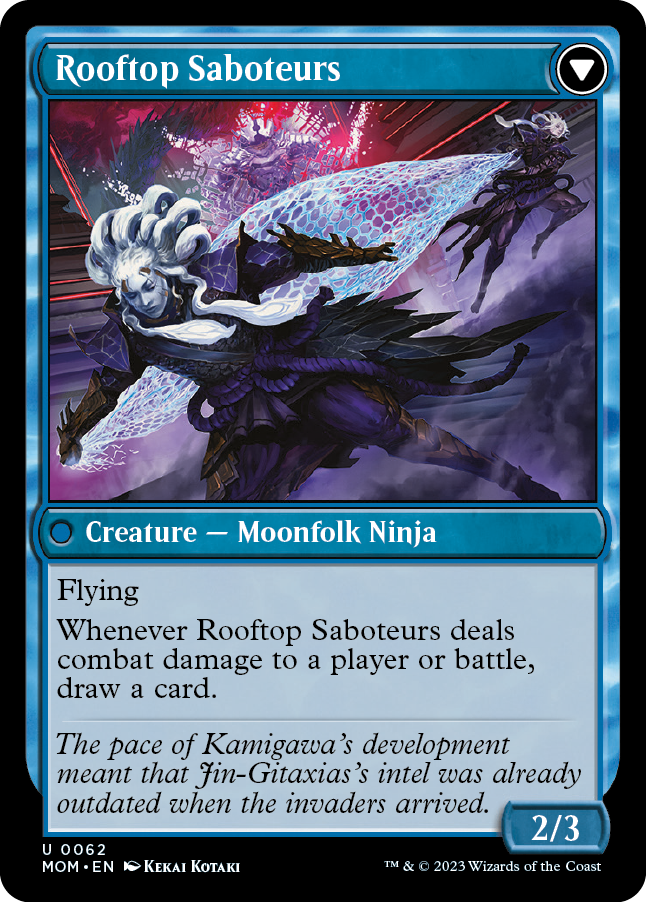
Invasion of Kamigawa
{3}{U}
Battle — Siege
(As a Siege enters, choose an opponent to protect it. You and others can attack it. When it's defeated, exile it, then cast it transformed.)
When Invasion of Kamigawa enters the battlefield, tap target artifact or creature an opponent controls and put a stun counter on it. (If a permanent with a stun counter would become untapped, remove one from it instead.)
4
////
Rooftop Saboteurs
Creature — Moonfolk Ninja
2/3
Flying
Whenever Rooftop Saboteurs deals combat damage to a player or battle, draw a card.
- Invasion of Kamigawa's enters-the-battlefield ability can target an artifact or creature that's already tapped.

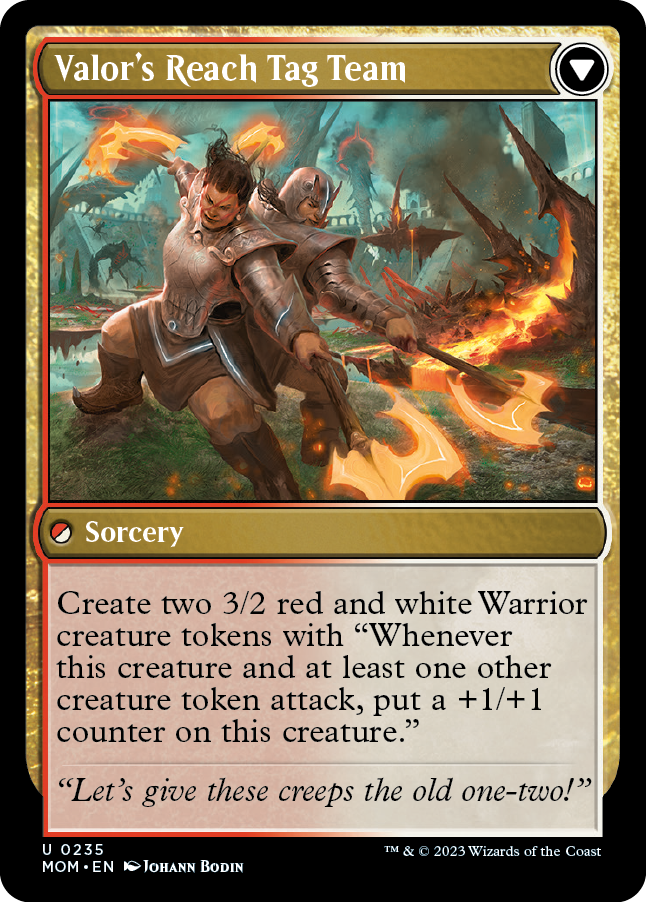
Invasion of Kylem
{2}{R}{W}
Battle — Siege
(As a Siege enters, choose an opponent to protect it. You and others can attack it. When it's defeated, exile it, then cast it transformed.)
When Invasion of Kylem enters the battlefield, up to two target creatures each get +2/+0 and gain vigilance and haste until end of turn.
5
////
Valor's Reach Tag Team
Sorcery
Create two 3/2 red and white Warrior creature tokens with "Whenever this creature and at least one other creature token attack, put a +1/+1 counter on this creature."
- The member of World's Greatest Valor's Reach Tag Team and the other creature token don't have to be attacking the same player, planeswalker, or battle for the ability to trigger.
- The tokens' triggered ability also works if a nontoken creature somehow gains it. For example, if a nontoken creature becomes a copy of the token and then attacks alongside a creature token, the ability will trigger.

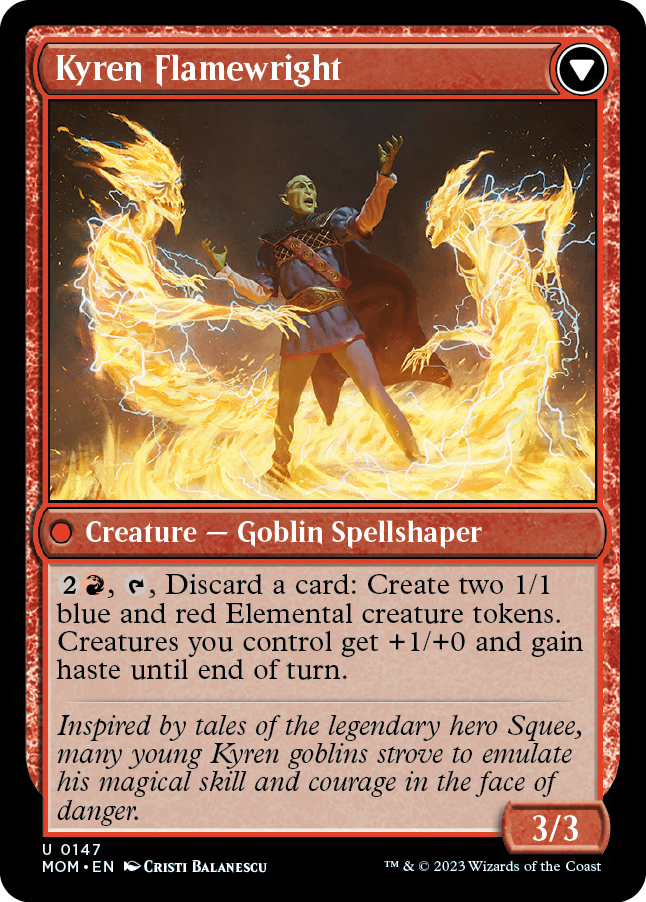
Invasion of Mercadia
{1}{R}
Battle — Siege
(As a Siege enters, choose an opponent to protect it. You and others can attack it. When it's defeated, exile it, then cast it transformed.)
When Invasion of Mercadia enters the battlefield, you may discard a card. If you do, draw two cards.
4
////
Kyren Flamewright
Creature — Goblin Spellshaper
3/3
{2}{R}, {T}, Discard a card: Create two 1/1 blue and red Elemental creature tokens. Creatures you control get +1/+0 and gain haste until end of turn.
- The set of creatures affected by Kyren Flamewright's ability is determined as the ability resolves. The Elemental tokens will get the bonuses, but creatures you begin to control later in the turn and noncreature permanents that become creatures later in the turn will not.
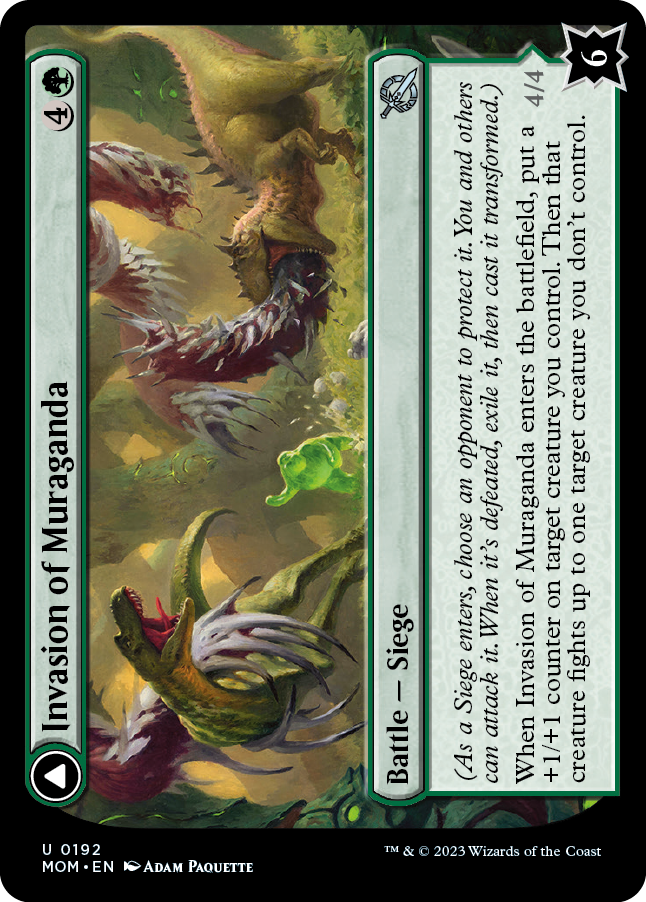
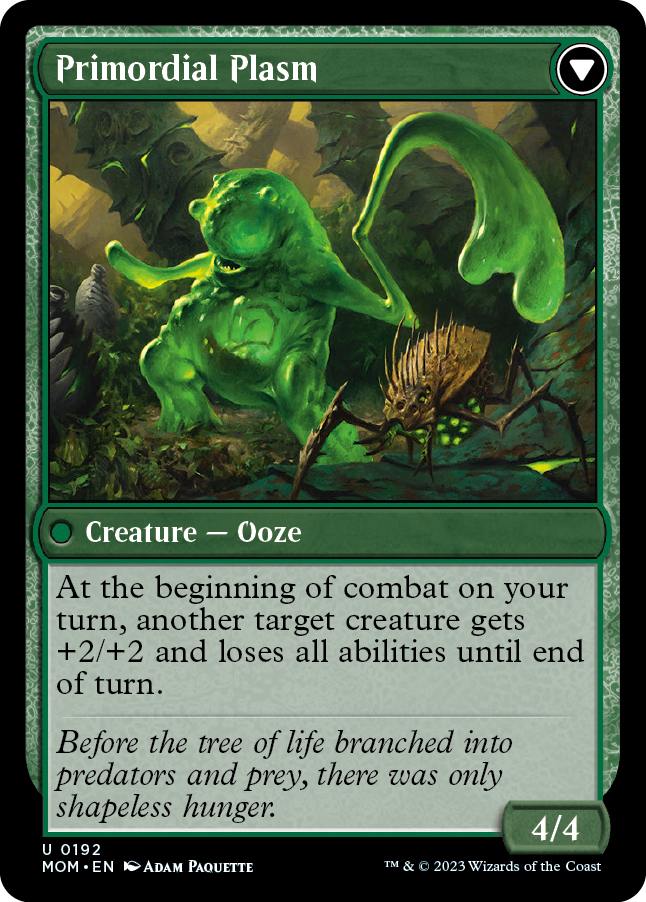
Invasion of Muraganda
{4}{G}
Battle — Siege
(As a Siege enters, choose an opponent to protect it. You and others can attack it. When it's defeated, exile it, then cast it transformed.)
When Invasion of Muraganda enters the battlefield, put a +1/+1 counter on target creature you control. Then that creature fights up to one target creature you don't control.
6
////
Primordial Plasm
Creature — Ooze
4/4
At the beginning of combat on your turn, another target creature gets +2/+2 and loses all abilities until end of turn.
- You can choose only a creature you control as a target for Invasion of Muraganda's enters-the-battlefield ability.
- If the creature you control is an illegal target as the ability tries to resolve, you won't put a +1/+1 counter on it. If that creature is a legal target but the other creature isn't, you'll still put the +1/+1 counter on the creature you control, but neither creature will deal or be dealt damage.
- A creature that loses all abilities because of Primordial Plasm's ability (slurp) may later gain abilities.
- If the creature affected by Primordial Plasm's ability (slurp) had an ability defining its power and/or toughness, that base value will become 0. In many situations, having a base toughness of 0 would be a problem, but Primordial Plasm's ability (slurp) helpfully provides +2/+2, so the creature should survive.

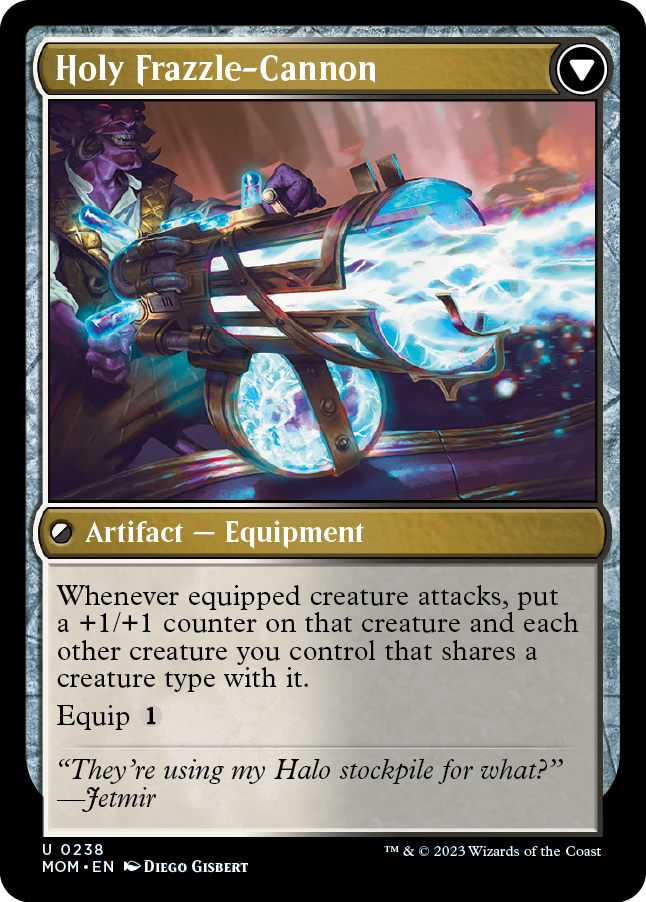
Invasion of New Capenna
{W}{B}
Battle — Siege
(As a Siege enters, choose an opponent to protect it. You and others can attack it. When it's defeated, exile it, then cast it transformed.)
When Invasion of New Capenna enters the battlefield, you may sacrifice an artifact or creature. When you do, exile target artifact or creature an opponent controls.
4
////
Holy Frazzle-Cannon
Artifact — Equipment
Whenever equipped creature attacks, put a +1/+1 counter on that creature and each other creature you control that shares a creature type with it.
Equip {1}
- Invasion of New Capenna's ability triggers and goes on the stack without a target. If you sacrifice an artifact or creature, the second "reflexive" triggered ability will trigger. You'll choose the target artifact or creature for that second ability at that time.
- A creature "shares a creature type" with the equipped creature if they have at least one creature type in common. Any one creature will get only one +1/+1 counter this way, even if it has multiple creature types in common with the equipped creature.

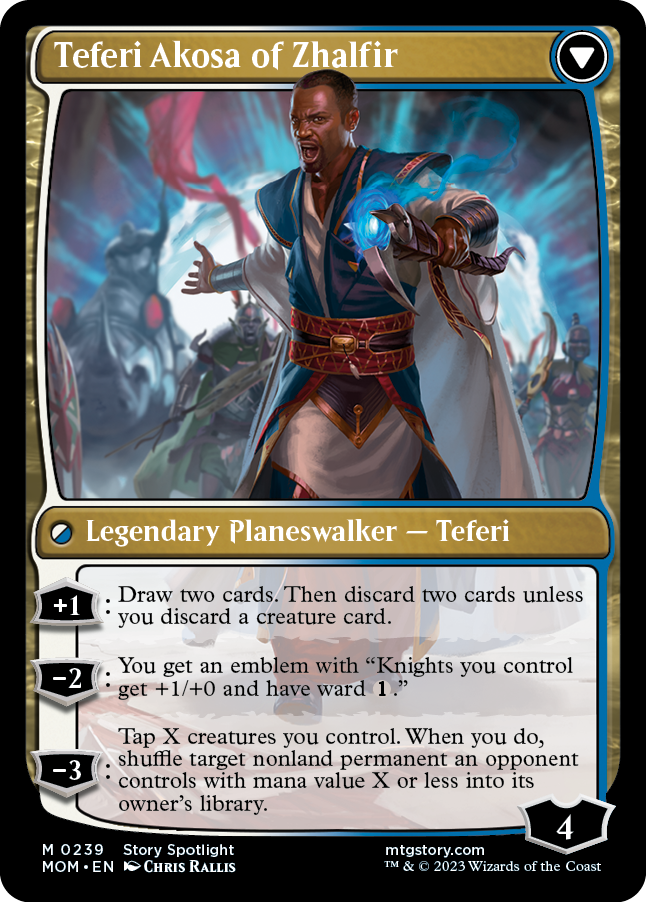
Invasion of New Phyrexia
{X}{W}{U}
Battle — Siege
(As a Siege enters, choose an opponent to protect it. You and others can attack it. When it's defeated, exile it, then cast it transformed.)
When Invasion of New Phyrexia enters the battlefield, create X 2/2 white and blue Knight creature tokens with vigilance.
6
////
Teferi Akosa of Zhalfir
Legendary Planeswalker — Teferi
4
+1: Draw two cards. Then discard two cards unless you discard a creature card.
−2: You get an emblem with "Knights you control get +1/+0 and have ward {1}."
−3: Tap any number of untapped creatures you control. When you do, shuffle target nonland permanent an opponent controls with mana value X or less into its owner's library, where X is the number of creatures tapped this way.
- Teferi Akosa's last ability has received an update to its official rules text to clarify its function. The updated text is included above.
- You activate Teferi Akosa's last ability without choosing a target or tapping any creatures. As it resolves, you choose which untapped creatures you control to tap, if any. If you don't tap any creatures (including if you don't control any), X is 0. After you tap creatures or not, the reflexive triggered ability triggers. You choose the target for that ability as it's put on the stack.
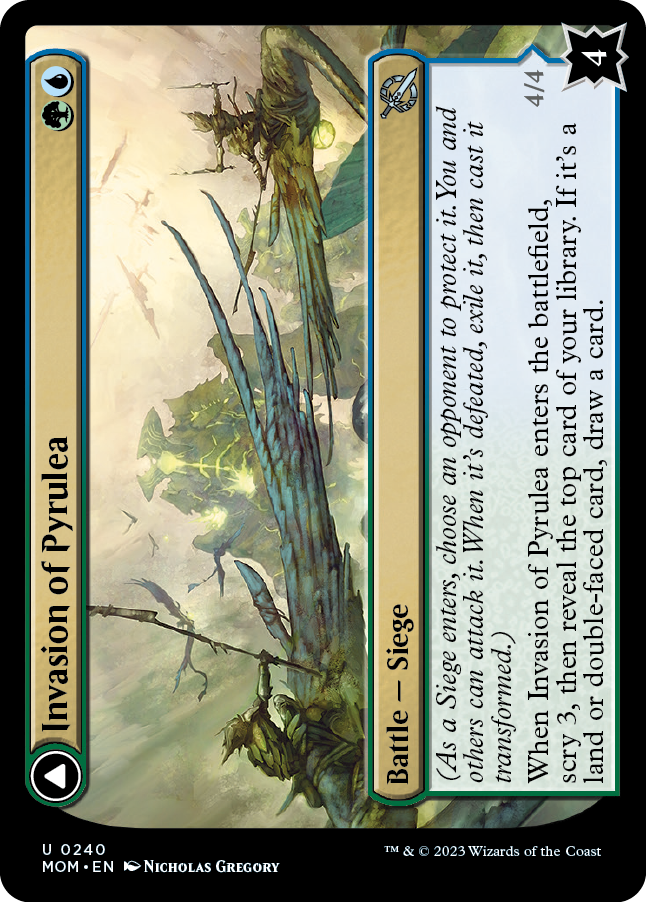
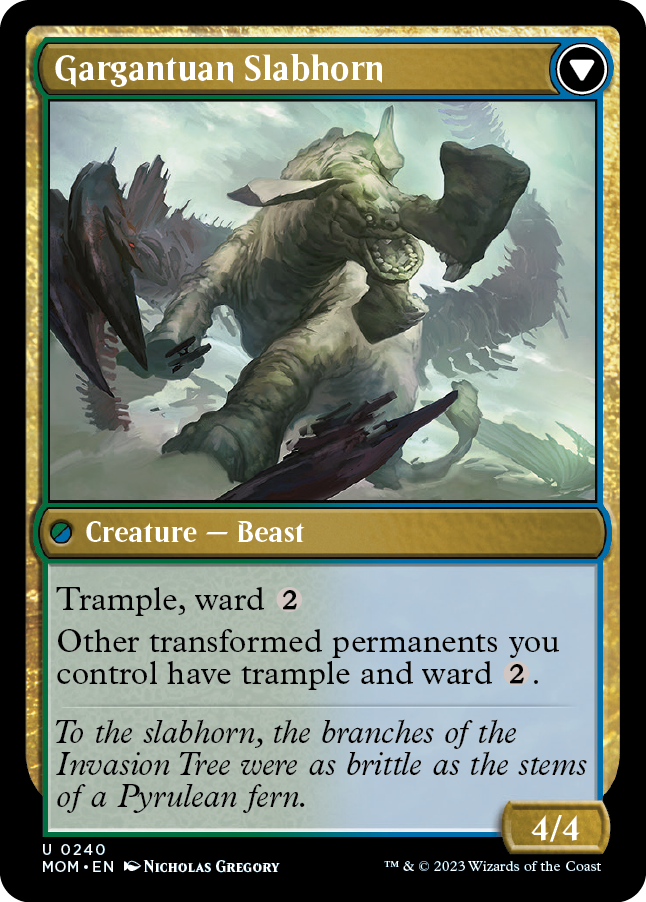
Invasion of Pyrulea
{G}{U}
Battle — Siege
(As a Siege enters, choose an opponent to protect it. You and others can attack it. When it's defeated, exile it, then cast it transformed.)
When Invasion of Pyrulea enters the battlefield, scry 3, then reveal the top card of your library. If it's a land or double-faced card, draw a card.
4
////
Gargantuan Slabhorn
Creature — Beast
4/4
Trample, ward {2}
Other transformed permanents you control have trample and ward {2}.
- If you reveal a land or double-faced card for Invasion of Pyrulea's ability, that revealed card will be the one you draw.
- A "transformed permanent" is a double-faced permanent with its back face up. Notably, modal double-faced permanents and melded permanents are never transformed permanents, no matter which faces are up.
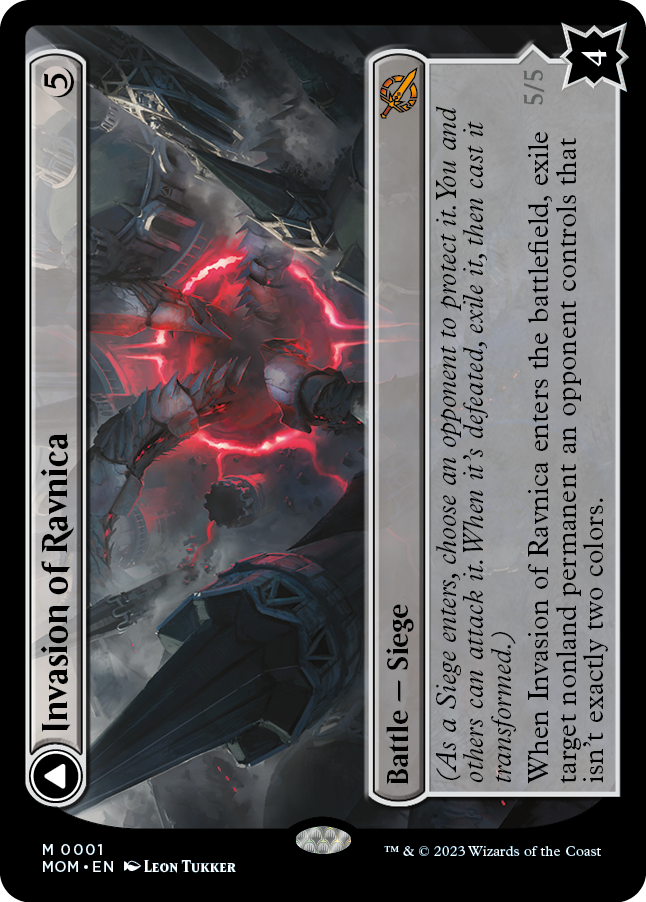
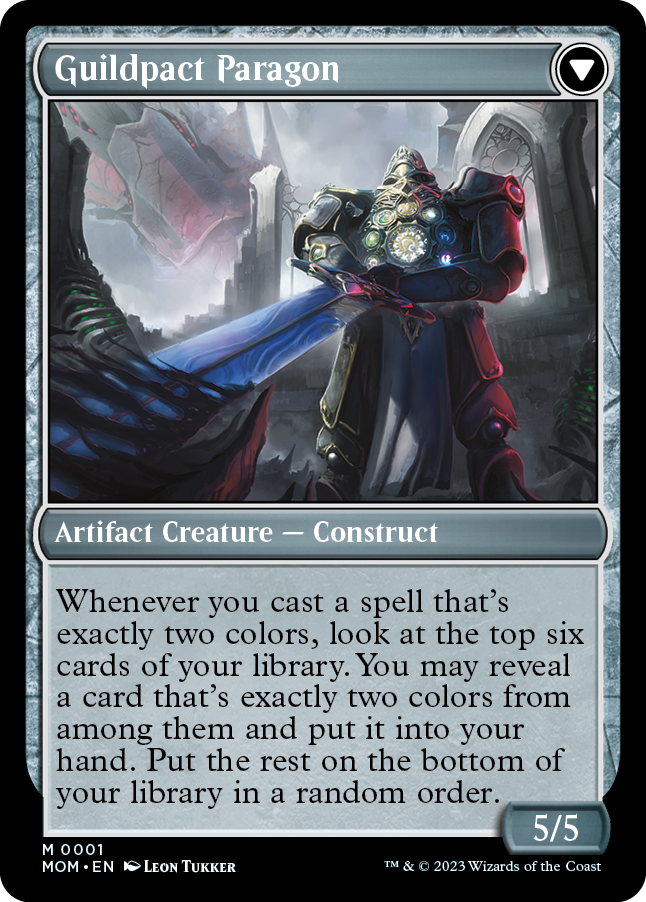
Invasion of Ravnica
{5}
Battle — Siege
(As a Siege enters, choose an opponent to protect it. You and others can attack it. When it's defeated, exile it, then cast it transformed.)
When Invasion of Ravnica enters the battlefield, exile target nonland permanent an opponent controls that isn't exactly two colors.
4
////
Guildpact Paragon
Artifact Creature — Construct
5/5
Whenever you cast a spell that's exactly two colors, look at the top six cards of your library. You may reveal a card that's exactly two colors from among them and put it into your hand. Put the rest on the bottom of your library in a random order.
- A nonland permanent that isn't exactly two colors may be colorless, monocolored, or have three or more colors.

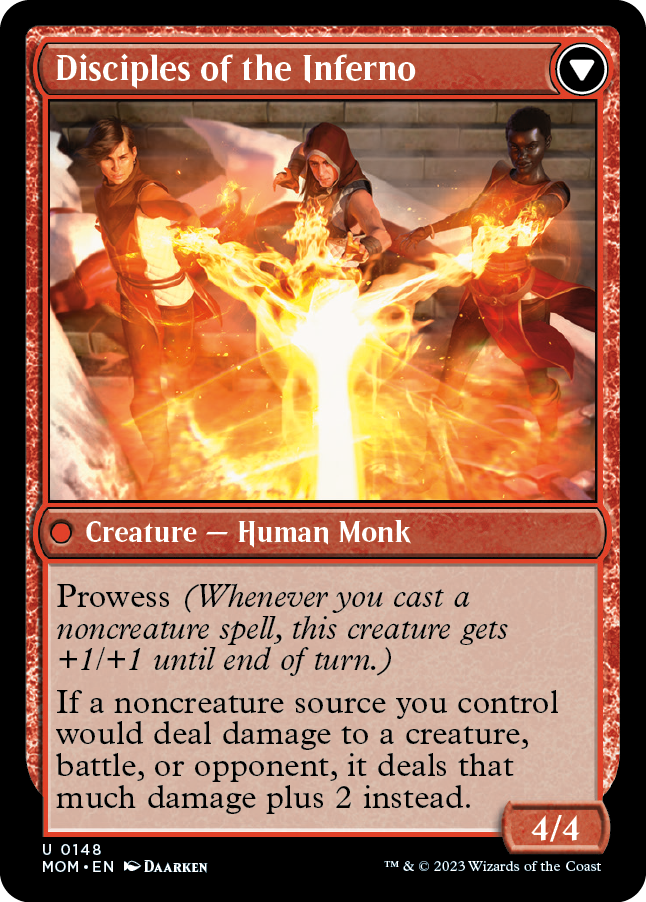
Invasion of Regatha
{2}{R}
Battle — Siege
(As a Siege enters, choose an opponent to protect it. You and others can attack it. When it's defeated, exile it, then cast it transformed.)
When Invasion of Regatha enters the battlefield, it deals 4 damage to another target battle or opponent and 1 damage to up to one target creature.
5
////
Disciples of the Inferno
Creature — Human Monk
4/4
Prowess (Whenever you cast a noncreature spell, this creature gets +1/+1 until end of turn.)
If a noncreature source you control would deal damage to a creature, battle, or opponent, it deals that much damage plus 2 instead.
- Disciples of the Inferno modifies damage that would be dealt to any creature, no matter who controls it, as well as any battle, no matter who protects it. Your teammates are safe. For now.
- The additional 2 damage is dealt by the same source as the original source of damage. The damage isn't dealt by Disciples of the Inferno.
- If another effect modifies how much damage a source would deal, including preventing some of it, the player being dealt damage or the controller of the permanent being dealt damage chooses an order in which to apply those effects. If all of the damage is prevented, Disciples of the Inferno's effect no longer applies.
- If damage dealt by a source is being divided or assigned among multiple permanents an opponent controls or among an opponent and one or more permanents they control, divide the original amount before adding 2. For example, if you cast a sorcery spell that deals 4 damage divided as you choose among any number of targets, you could have it deal 3 damage to one creature and 1 damage to a battle. Those amounts would then be modified to 5 damage and 3 damage, respectively.
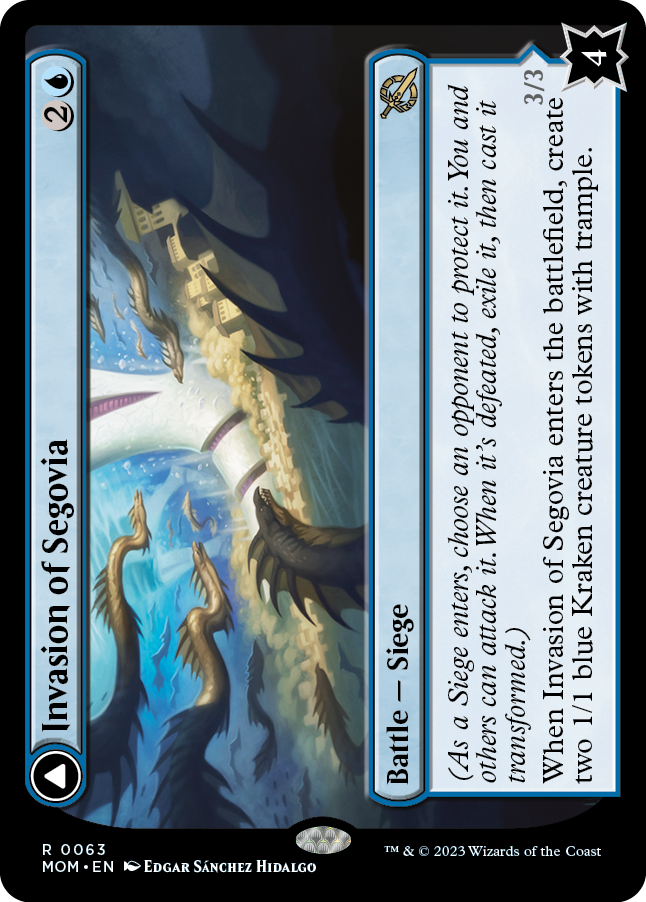
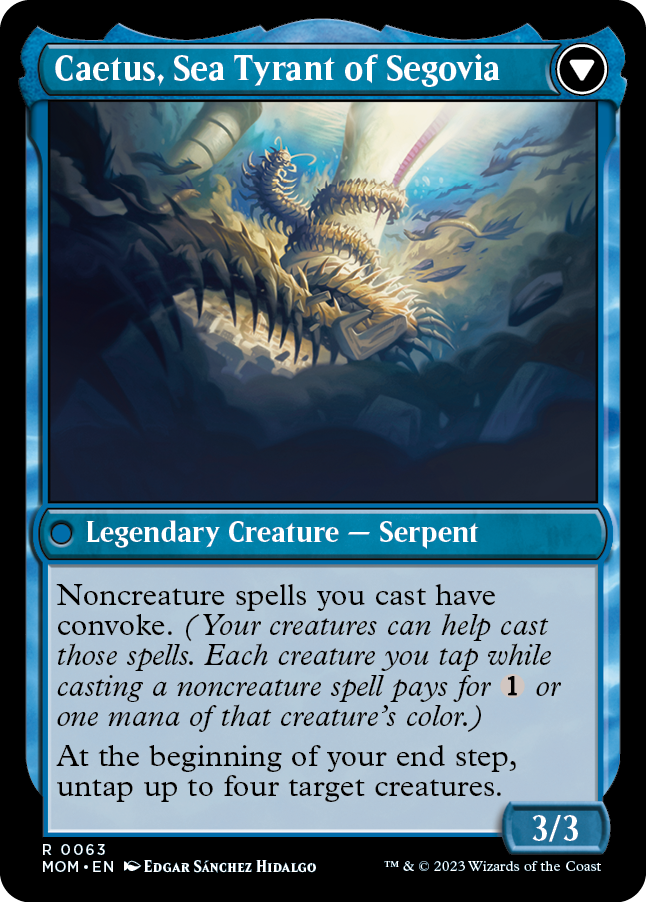
Invasion of Segovia
{2}{U}
Battle — Siege
(As a Siege enters, choose an opponent to protect it. You and others can attack it. When it's defeated, exile it, then cast it transformed.)
When Invasion of Segovia enters the battlefield, create two 1/1 blue Kraken creature tokens with trample.
4
////
Caetus, Sea Tyrant of Segovia
Legendary Creature — Serpent
3/3
Noncreature spells you cast have convoke. (Your creatures can help cast those spells. Each creature you tap while casting a noncreature spell pays for {1} or one mana of that creature's color.)
At the beginning of your end step, untap up to four target creatures.
- If you sacrifice Caetus while casting a noncreature spell (say, to activate a mana ability), the spell won't have convoke when you pay its costs unless it has convoke some other way.
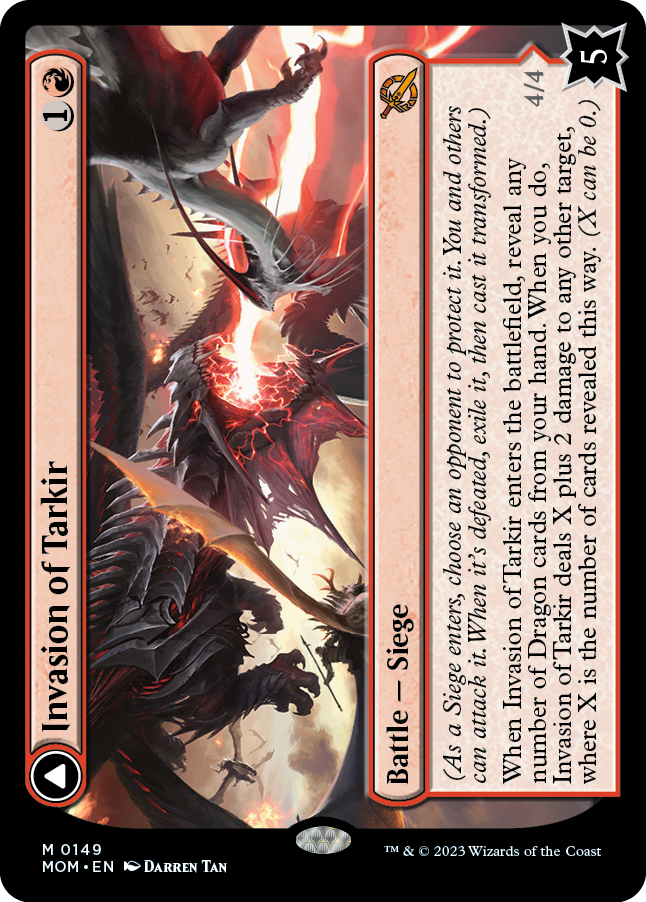
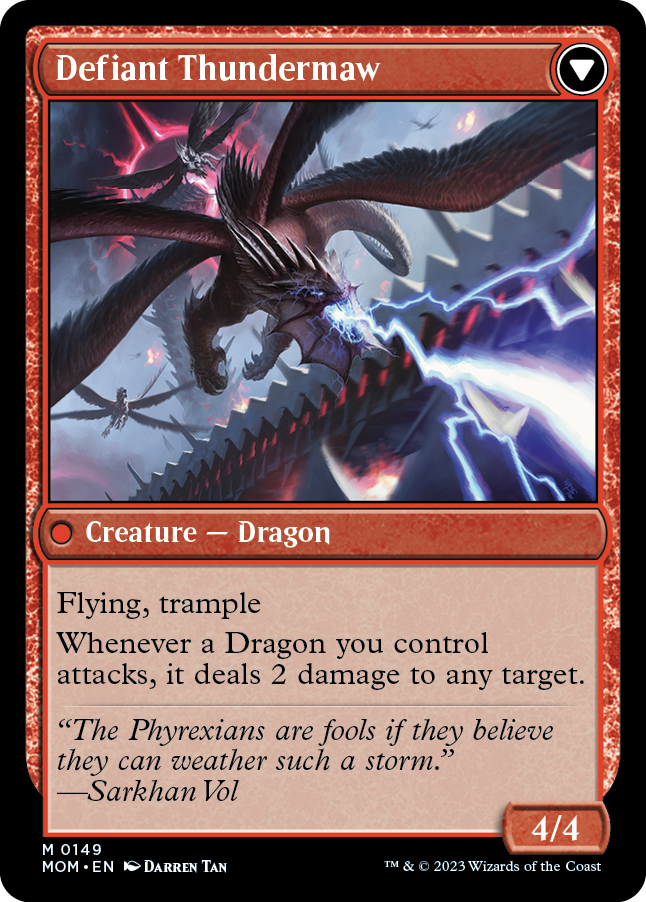
Invasion of Tarkir
{1}{R}
Battle — Siege
(As a Siege enters, choose an opponent to protect it. You and others can attack it. When it's defeated, exile it, then cast it transformed.)
When Invasion of Tarkir enters the battlefield, reveal any number of Dragon cards from your hand. When you do, Invasion of Tarkir deals X plus 2 damage to any other target, where X is the number of cards revealed this way. (X can be 0.)
5
////
Defiant Thundermaw
Creature — Dragon
4/4
Flying, trample
Whenever a Dragon you control attacks, it deals 2 damage to any target.
- Invasion of Tarkir's enters-the-battlefield ability triggers and goes on the stack without a target. As it resolves, you'll reveal any number of Dragon cards from your hand. As the card reminds you, that number can be zero. Then the second "reflexive" triggered ability will trigger. You'll choose the target for that second ability at that time.
- If you don't reveal any Dragon cards from your hand, the reflexive triggered ability will cause Invasion of Tarkir to deal 2 damage to the target of the ability.

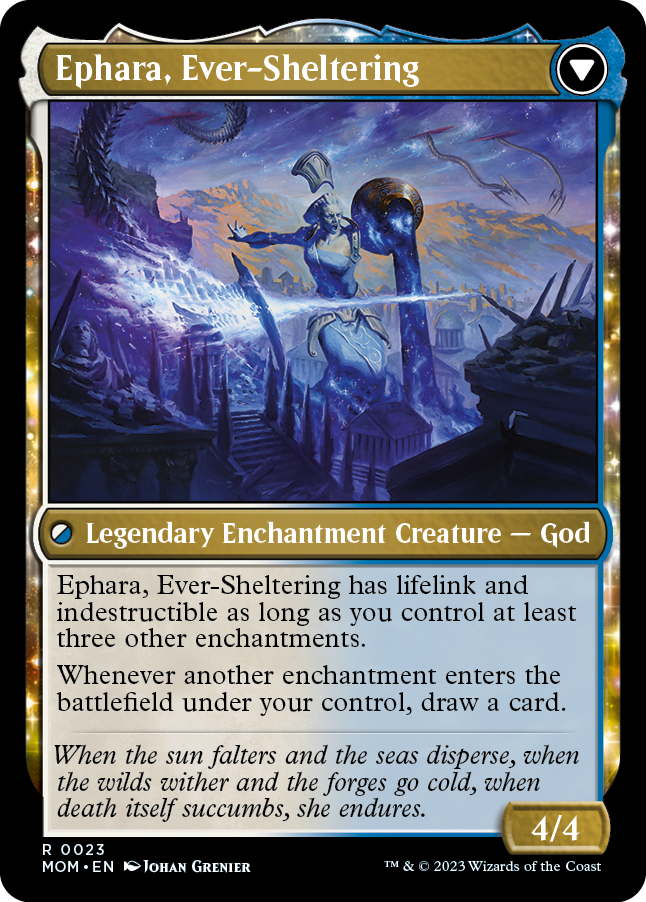
Invasion of Theros
{2}{W}
Battle — Siege
(As a Siege enters, choose an opponent to protect it. You and others can attack it. When it's defeated, exile it, then cast it transformed.)
When Invasion of Theros enters the battlefield, search your library for an Aura, God, or Demigod card, reveal it, put it into your hand, then shuffle.
4
////
Ephara, Ever-Sheltering
Legendary Enchantment Creature — God
4/4
Ephara, Ever-Sheltering has lifelink and indestructible as long as you control at least three other enchantments.
Whenever another enchantment enters the battlefield under your control, draw a card.
- Damage dealt to Ephara is tracked even if Ephara has indestructible. For example, if Ephara is dealt what would be lethal damage and later loses indestructible (perhaps because you lose control of some enchantments), it will be destroyed the next time state-based actions are performed. However, the check for whether a creature dealt damage by a source with deathtouch is destroyed happens only the first time that state-based actions are performed after that damage-dealing event.
- If Ephara enters the battlefield under your control at the same time as other enchantments, its last ability will trigger for each of those other enchantments.
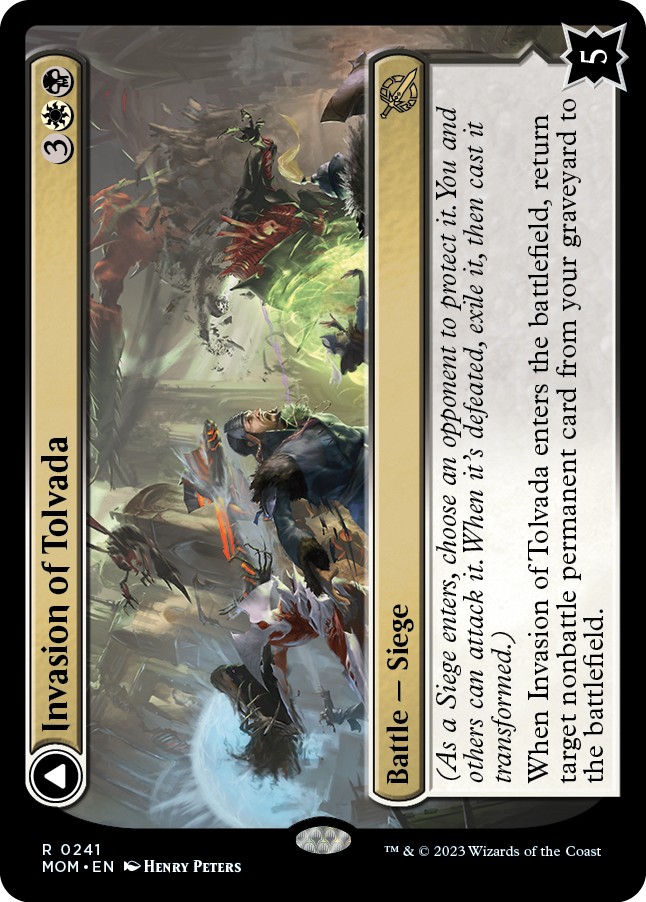
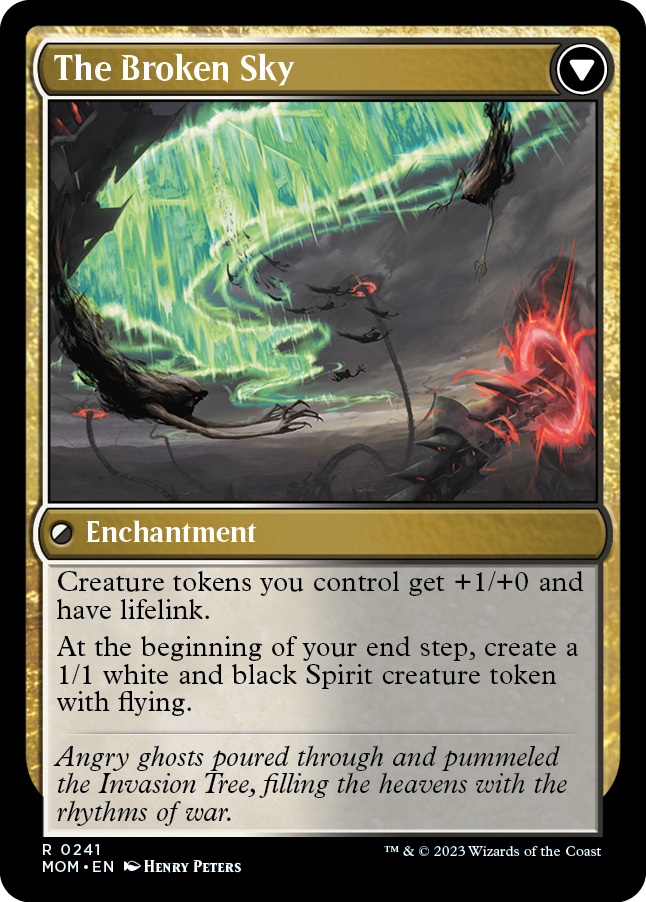
Invasion of Tolvada
{3}{W}{B}
Battle — Siege
(As a Siege enters, choose an opponent to protect it. You and others can attack it. When it's defeated, exile it, then cast it transformed.)
When Invasion of Tolvada enters the battlefield, return target nonbattle permanent card from your graveyard to the battlefield.
5
////
The Broken Sky
Enchantment
Creature tokens you control get +1/+0 and have lifelink.
At the beginning of your end step, create a 1/1 white and black Spirit creature token with flying.
- The Broken Sky's first ability applies to all creature tokens you control, not only the ones created by its other ability.
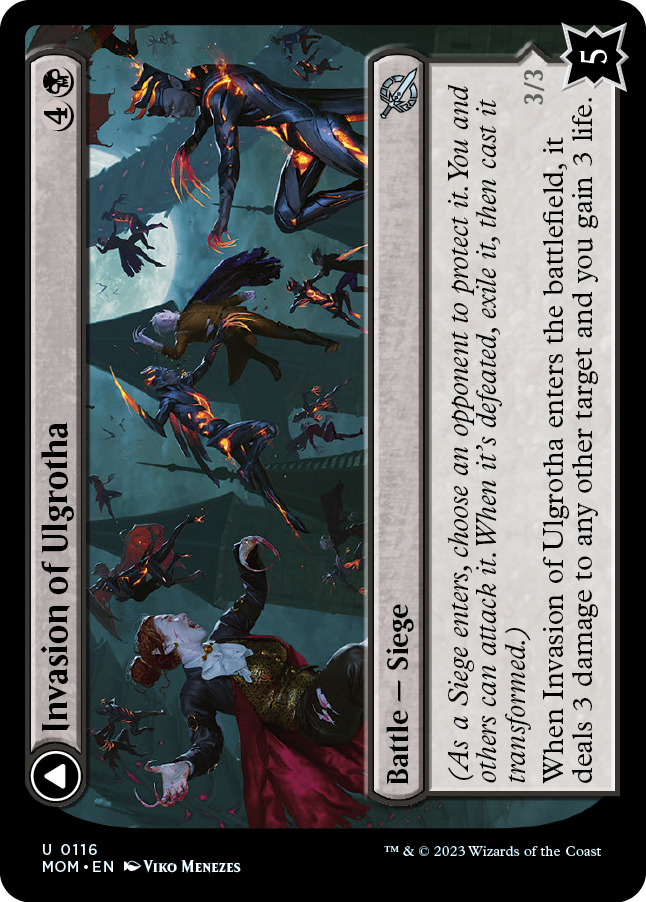
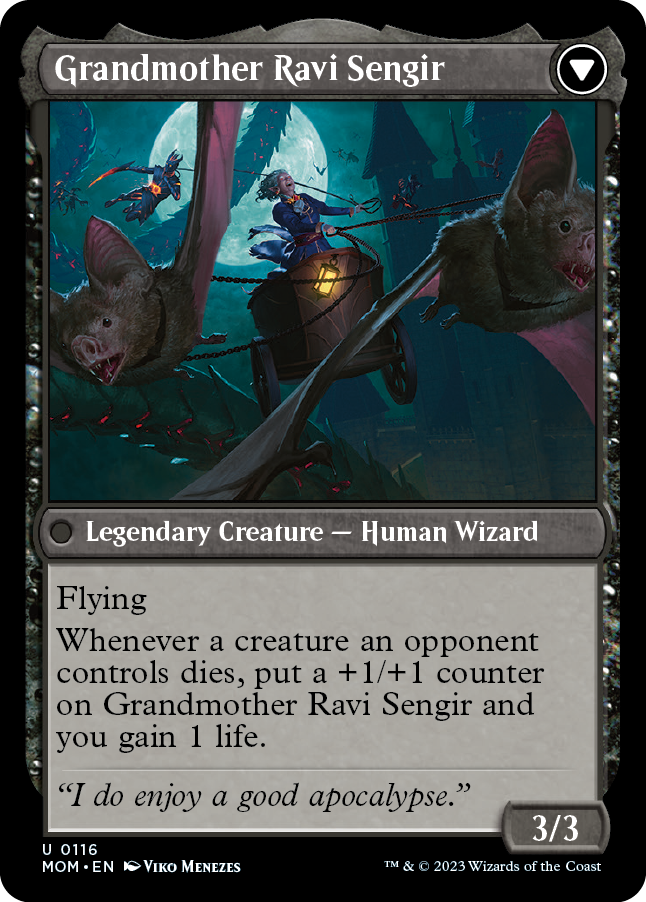
Invasion of Ulgrotha
{4}{B}
Battle — Siege
(As a Siege enters, choose an opponent to protect it. You and others can attack it. When it's defeated, exile it, then cast it transformed.)
When Invasion of Ulgrotha enters the battlefield, it deals 3 damage to any other target and you gain 3 life.
5
////
Grandmother Ravi Sengir
Legendary Creature — Human Wizard
3/3
Flying
Whenever a creature an opponent controls dies, put a +1/+1 counter on Grandmother Ravi Sengir and you gain 1 life.
- If creatures controlled by opponents die at the same time as Grandmother Ravi Sengir, the last ability of Grandmother Ravi Sengir will trigger once for each of those creatures. You won't put +1/+1 counters on it, but you will gain some life. So that's nice, dear.
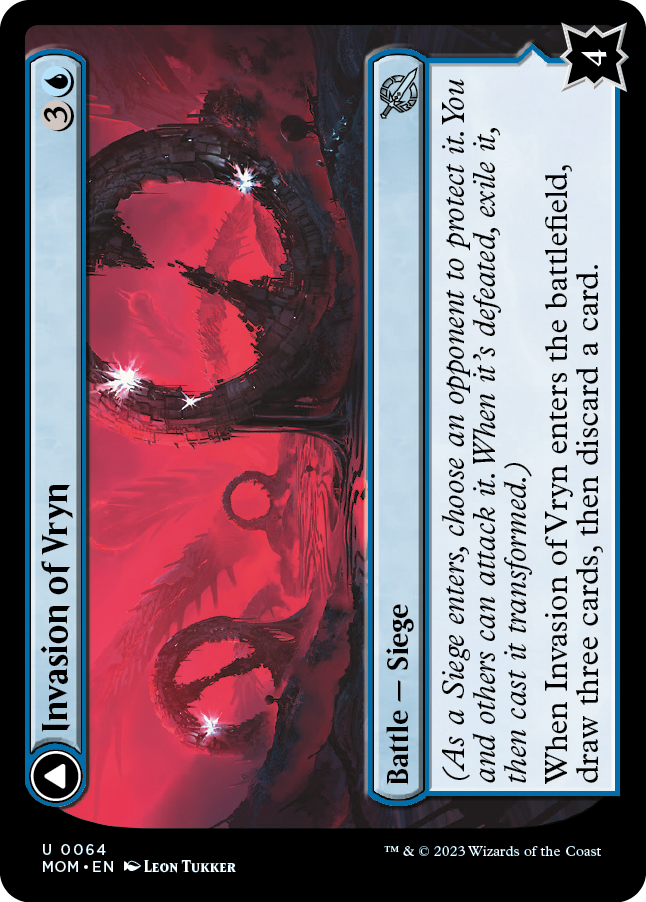
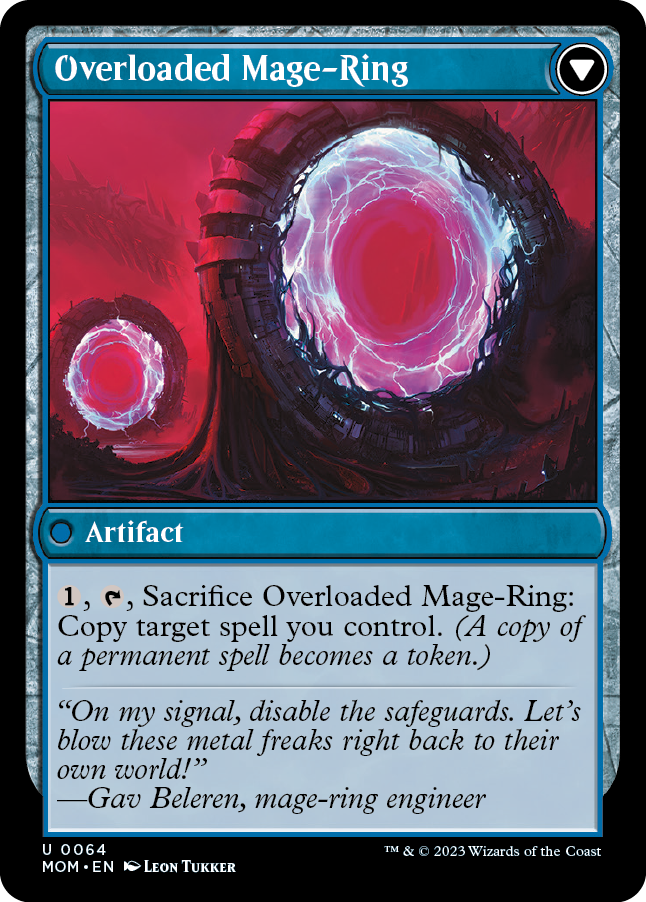
Invasion of Vryn
{3}{U}
Battle — Siege
(As a Siege enters, choose an opponent to protect it. You and others can attack it. When it's defeated, exile it, then cast it transformed.)
When Invasion of Vryn enters the battlefield, draw three cards, then discard a card.
4
////
Overloaded Mage-Ring
Artifact
{1}, {T}, Sacrifice Overloaded Mage-Ring: Copy target spell you control. You may choose new targets for the copy. (A copy of a permanent spell becomes a token.)
- Overloaded Mage-Ring has received an update to its official rules text. The sentence allowing you to choose new targets for the copy was inadvertently omitted.
- A copy of a spell is created on the stack, so it's not "cast." Abilities that trigger when a player casts a spell won't trigger.
- If you copy a spell, you control the copy. It will resolve before the original spell does.
- The copy will have the same targets as the spell it's copying unless you choose new ones. You may change any number of the targets, including all of them or none of them. If, for one of the targets, you can't choose a new legal target, then it remains unchanged (even if the current target is illegal).
- If the spell that's copied is modal (that is, it includes a choice from a bulleted list of effects), the copy will have the same mode. A different mode can't be chosen.
- If the spell that's copied has an X whose value was determined as it was cast, the copy will have the same value of X.
- If the spell has damage divided as it was cast, the division can't be changed (although the targets receiving that damage still can). The same is true of spells that distribute counters.
- You can't choose to pay any alternative or additional costs for the copy. However, effects based on any alternative or additional costs that were paid for the original spell are copied as though those same costs were paid for the copy.
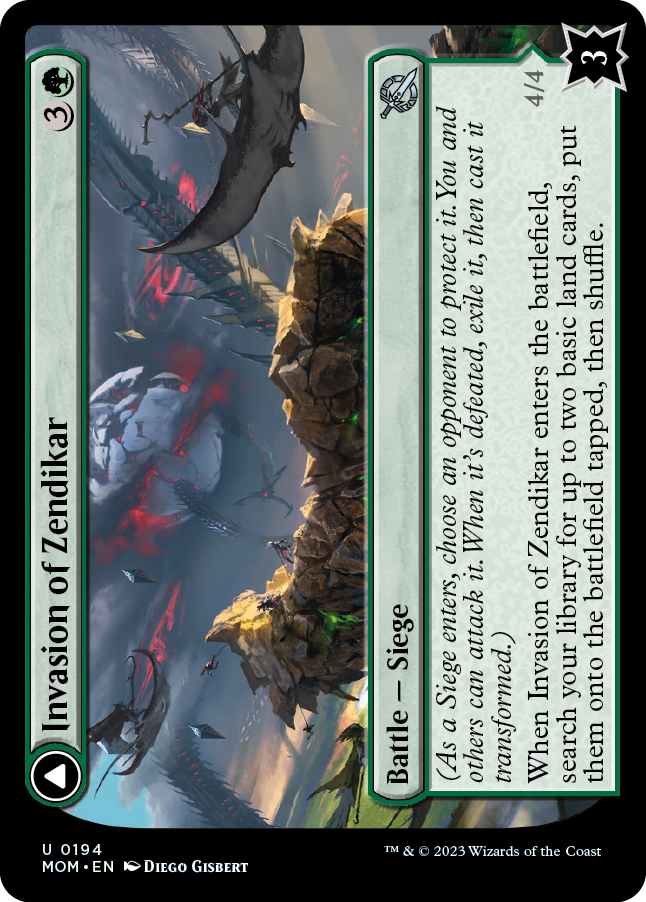
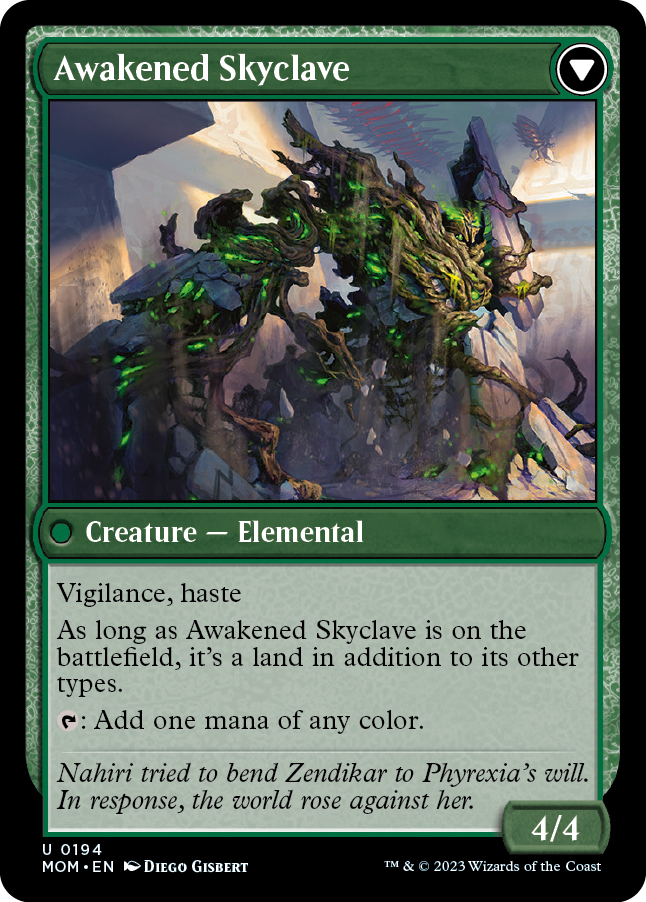
Invasion of Zendikar
{3}{G}
Battle — Siege
(As a Siege enters, choose an opponent to protect it. You and others can attack it. When it's defeated, exile it, then cast it transformed.)
When Invasion of Zendikar enters the battlefield, search your library for up to two basic land cards, put them onto the battlefield tapped, then shuffle.
3
////
Awakened Skyclave
Creature — Elemental
4/4
Vigilance, haste
As long as Awakened Skyclave is on the battlefield, it's a land in addition to its other types.
{T}: Add one mana of any color.
- Awakened Skyclave is cast as a creature spell. It can be countered and otherwise responded to. It won't be a land in addition to its other types until it enters the battlefield.
- If Awakened Skyclave enters the battlefield, any ability that triggers whenever a land enters the battlefield will trigger.

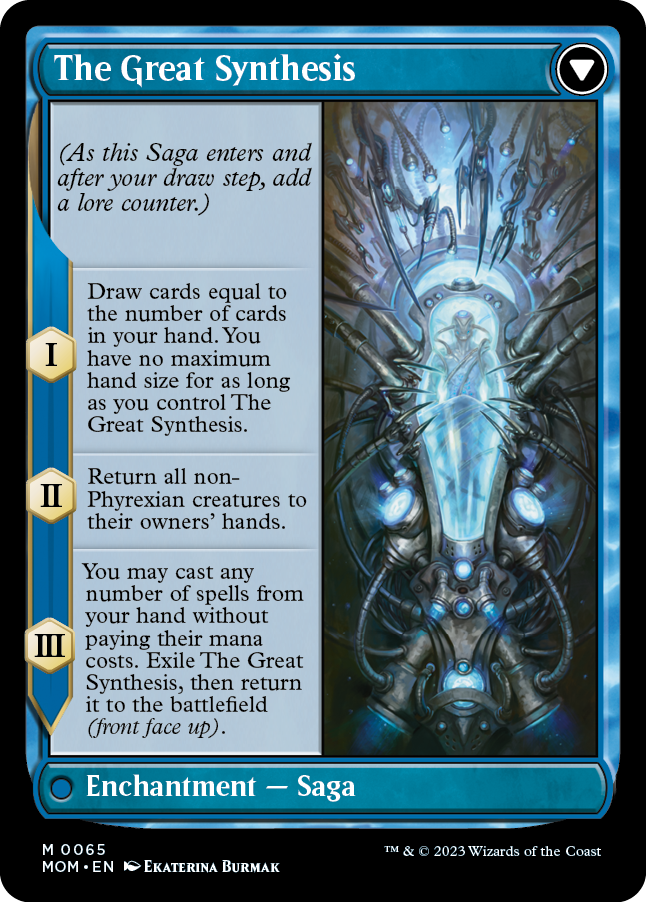
Jin-Gitaxias
{3}{U}{U}
Legendary Creature — Phyrexian Praetor
5/5
Ward {2}
Whenever you cast a noncreature spell with mana value 3 or greater, draw a card.
{3}{U}: Exile Jin-Gitaxias, then return it to the battlefield transformed under its owner's control. Activate only as a sorcery and only if you have seven or more cards in hand.
////
The Great Synthesis
Enchantment — Saga
(As this Saga enters and after your draw step, add a lore counter.)
I — Draw cards equal to the number of cards in your hand. You have no maximum hand size for as long as you control The Great Synthesis.
II — Return all non-Phyrexian creatures to their owners' hands.
III — You may cast any number of spells from your hand without paying their mana costs. Exile The Great Synthesis, then return it to the battlefield (front face up).
- Once you've activated Jin-Gitaxias's last ability, it doesn't matter what happens to the number of cards in your hand. The ability will resolve even if you have six or fewer cards in your hand by that time.
- For chapter I of The Great Synthesis, the number of cards you draw is determined as the ability resolves. If you no longer control The Great Synthesis at that time, your maximum hand size remains unchanged.
- All the spells you cast due to chapter III are cast during the resolution of that ability. You can cast them in any order, and timing restrictions based on the cards' types are ignored. Once you're done casting spells, before any of them resolve, The Great Synthesis will be exiled and return as Jin-Gitaxias.
- A spell you cast this way can be the target of a later spell you cast this way. However, permanent spells cast this way won't resolve until you're done casting spells, so the permanents they become can't be the target of spells cast this way. For example, if you exile Twincast and Lightning Strike, you can cast Lightning Strike and then cast Twincast targeting it; but if you exile a creature card and an Aura card, you can't cast that Aura targeting that creature.
- If you cast a spell "without paying its mana cost," you can't pay any alternative costs. You can, however, pay additional costs. If the spell has any mandatory additional costs, those must be paid to cast it.
- If a spell has {X} in its mana cost, you must choose 0 as the value of X when casting it without paying its mana cost.

Joyful Stormsculptor
{3}{U}{R}
Creature — Human Shaman
2/3
When Joyful Stormsculptor enters the battlefield, create two 1/1 blue and red Elemental creature tokens.
Whenever you cast a spell that has convoke, Joyful Stormsculptor deals 1 damage to each opponent and each battle they protect.
- Joyful Stormsculptor's last ability will trigger whether you tapped any creatures to pay for the spell or not, as long as it has convoke.
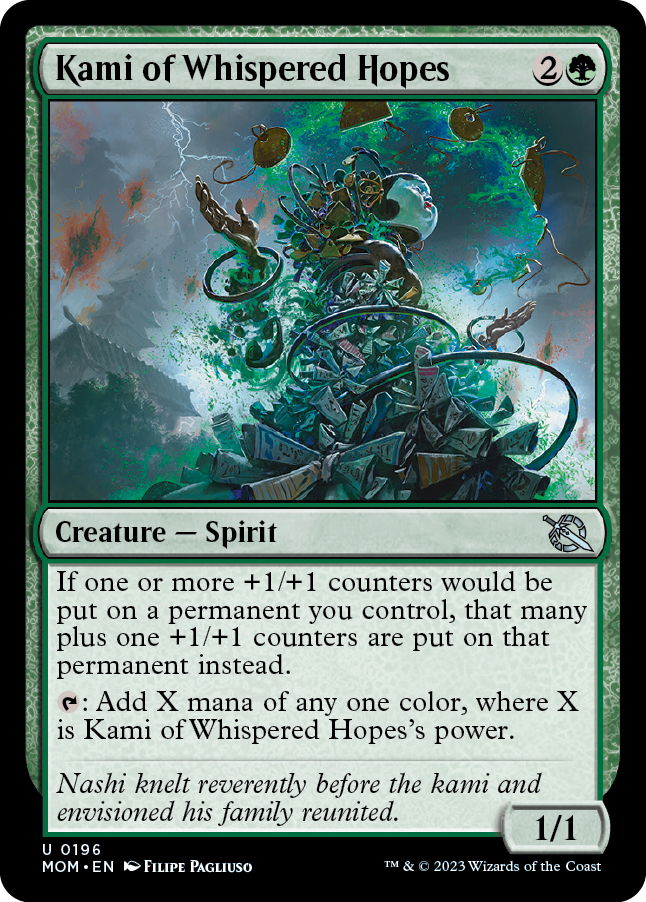
Kami of Whispered Hopes
{2}{G}
Creature — Spirit
1/1
If one or more +1/+1 counters would be put on a permanent you control, that many plus one +1/+1 counters are put on that permanent instead.
{T}: Add X mana of any one color, where X is Kami of Whispered Hopes's power.
- If another permanent you control would enter the battlefield with a number of +1/+1 counters on it, it enters with that many plus one instead.
- However, if Kami of Whispered Hopes somehow enters the battlefield with +1/+1 counters it, its first ability won't apply to itself.
- If you control two Kamis of Whispered Hopes, the number of +1/+1 counters put on a permanent is two plus the original number. Three Kamis of Whispered Hopes add three, and so on.
- If two or more effects attempt to modify how many counters would be put onto a permanent you control, you choose the order to apply those effects, no matter who controls the sources of those effects.
- The last ability is a mana ability. It doesn't use the stack and can't be responded to.
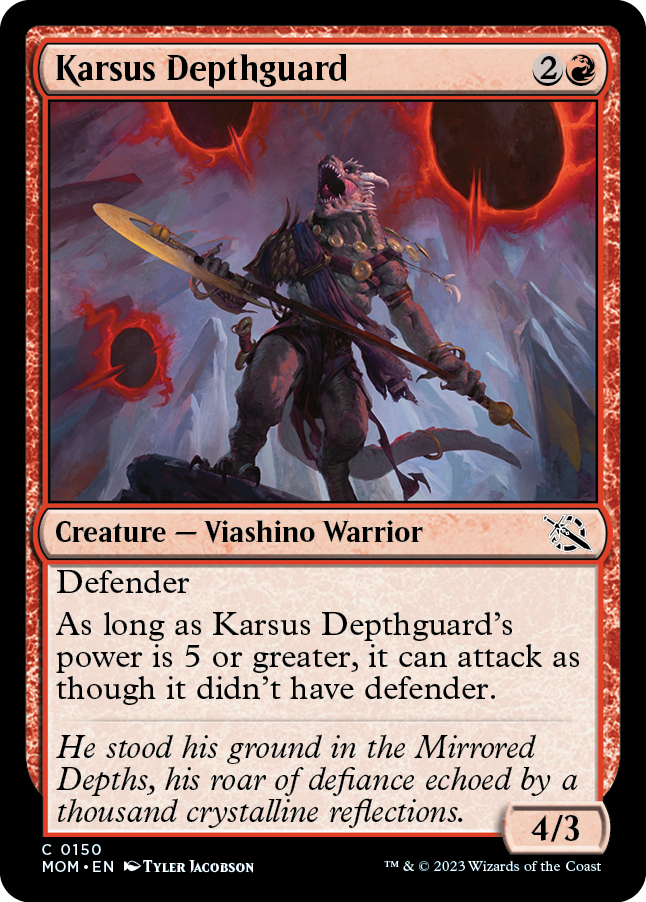
Karsus Depthguard
{2}{R}
Creature — Viashino Warrior
4/3
Defender
As long as Karsus Depthguard's power is 5 or greater, it can attack as though it didn't have defender.
- Once Karsus Depthguard has legally attacked, causing its last ability to not apply by reducing its power to 4 or less won't cause it to stop attacking.
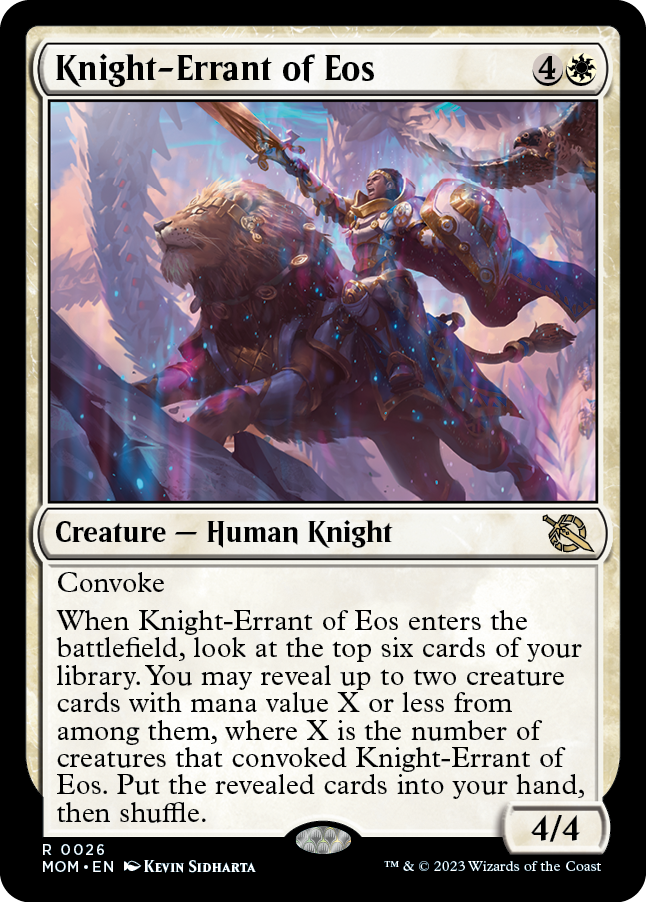
Knight-Errant of Eos
{4}{W}
Creature — Human Knight
4/4
Convoke
When Knight-Errant of Eos enters the battlefield, look at the top six cards of your library. You may reveal up to two creature cards with mana value X or less from among them, where X is the number of creatures that convoked Knight-Errant of Eos. Put the revealed cards into your hand, then shuffle.
- It doesn't matter if the creatures that convoked Knight-Errant of Eos are still on the battlefield or not as the enters-the-battlefield ability is resolving. You'll get credit for them when determining the value of X.
- You can't tap more creatures to convoke Knight-Errant of Eos than is necessary to pay for the spell. In most cases, this means five creatures. However, if there are any additional costs to cast Knight-Errant of Eos, you may use convoke to pay those additional costs as well.
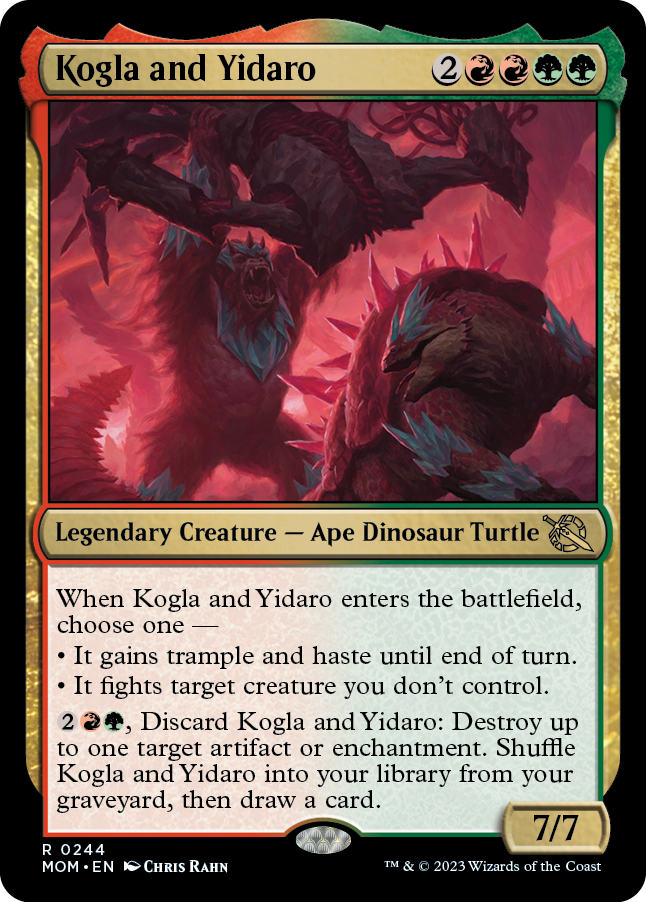
Kogla and Yidaro
{2}{R}{R}{G}{G}
Legendary Creature — Ape Dinosaur Turtle
7/7
When Kogla and Yidaro enters the battlefield, choose one —
• It gains trample and haste until end of turn.
• It fights target creature you don't control.
{2}{R}{G}, Discard Kogla and Yidaro: Destroy up to one target artifact or enchantment. Shuffle Kogla and Yidaro into your library from your graveyard, then draw a card.
- You don't have to choose a target artifact or enchantment for the last ability. However, if you do, and that permanent is an illegal target at the time the ability tries to resolve, the ability won't resolve and none of its effects will happen. You won't shuffle Kogla and Yidaro into your library and you won't draw a card.
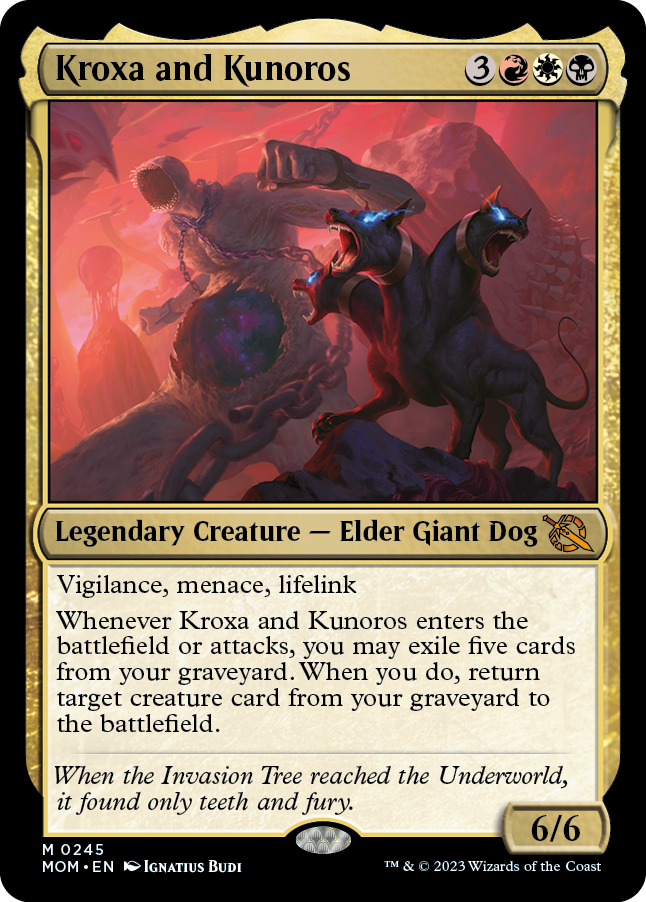
Kroxa and Kunoros
{3}{R}{W}{B}
Legendary Creature — Elder Giant Dog
6/6
Vigilance, menace, lifelink
Whenever Kroxa and Kunoros enters the battlefield or attacks, you may exile five cards from your graveyard. When you do, return target creature card from your graveyard to the battlefield.
- The last ability of Kroxa and Kunoros triggers and goes on the stack without a target. If you exile five cards from your graveyard, the second "reflexive" triggered ability will trigger. You'll choose the target creature card for that second ability at that time.
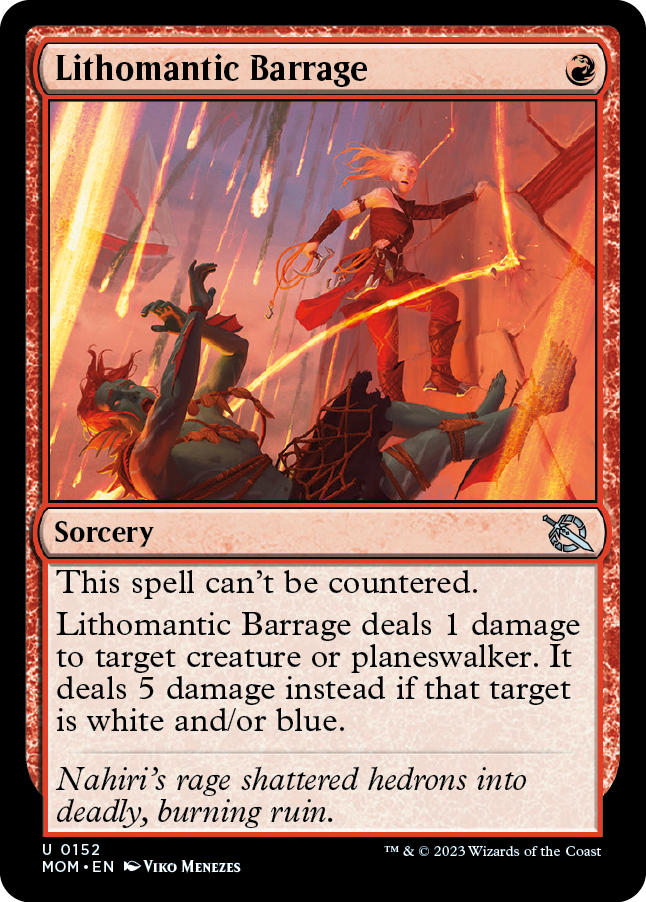
Lithomantic Barrage
{R}
Sorcery
This spell can't be countered.
Lithomantic Barrage deals 1 damage to target creature or planeswalker. It deals 5 damage instead if that target is white and/or blue.
- "This spell can't be countered" means it can't be countered even by the ward keyword ability. If you cast Lithomantic Barrage targeting a creature or planeswalker with ward, you may still pay the ward cost if you want to, but Lithomantic Barrage won't be countered if you don't.
- Spells and abilities that counter spells can still target Lithomantic Barrage. Such a spell or ability won't counter Lithomantic Barrage, but any additional effects of that spell or ability will still happen.

Merciless Repurposing
{4}{B}{B}
Instant
Exile target creature. Incubate 3. (Create an Incubator token with three +1/+1 counters on it and "{2}: Transform this artifact." It transforms into a 0/0 Phyrexian artifact creature.)
- If the target of Merciless Repurposing is illegal as the spell tries to resolve, it won't resolve and none of its effects will happen. You won't incubate.
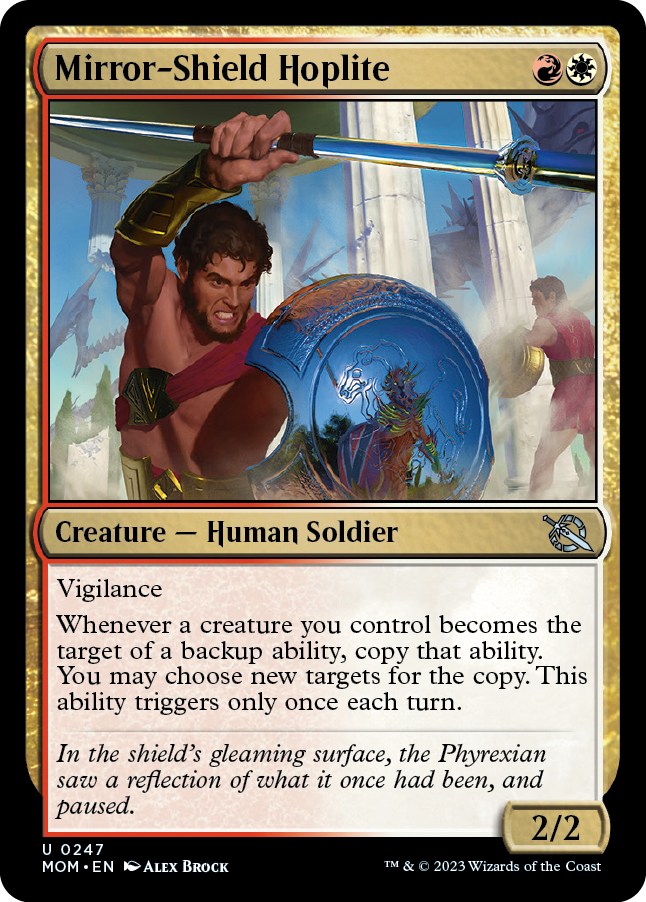
Mirror-Shield Hoplite
{R}{W}
Creature — Human Soldier
2/2
Vigilance
Whenever a creature you control becomes the target of a backup ability, copy that ability. You may choose new targets for the copy. This ability triggers only once each turn.
- The source of the copy is the same as the source of the original backup ability. If the creature that ends up as the target of the copy is that original creature with backup, it will get a +1/+1 counter, but it won't gain any abilities. If it's a creature other than that original creature, it will get a +1/+1 counter and gain abilities.
- If a creature other than the creature with backup ends up as the target of both the backup ability and the copy, it will end up with two +1/+1 counters and it will gain the non-backup abilities twice. In some cases, the duplicate abilities will be redundant (two instances of flying, for example). However, if it picks up two triggered abilities, for example, those abilities trigger independently.

Moment of Truth
{1}{U}
Instant
Look at the top three cards of your library. Put one of those cards into your hand, one into your graveyard, and one on the bottom of your library.
- If there are fewer than three cards in your library, look at all of the cards in your library and follow the instructions in order. For example, if you had only two cards in your library, you would look at both, put one into your hand, and then put the other one in the graveyard.
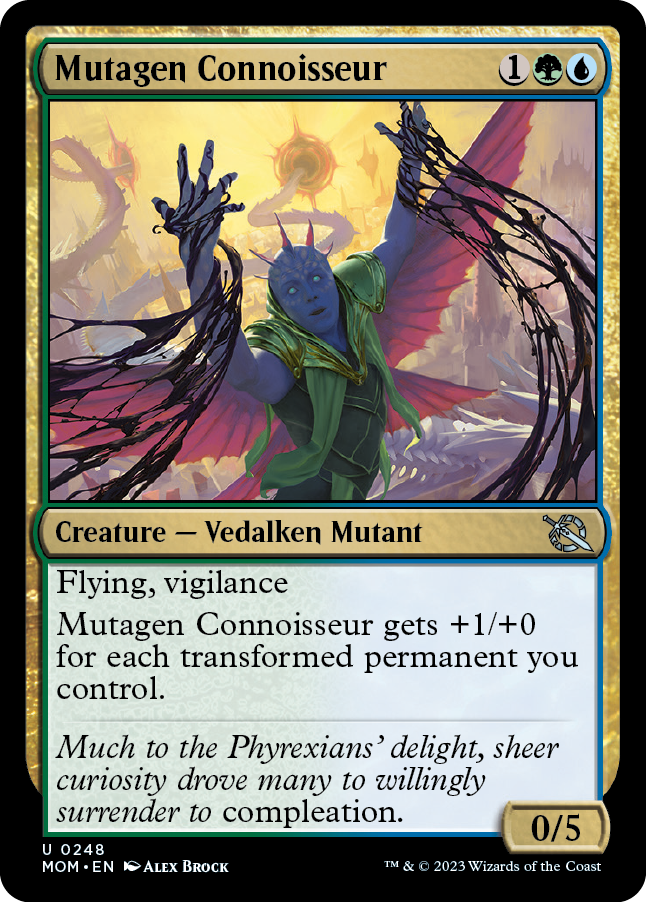
Mutagen Connoisseur
{1}{G}{U}
Creature — Vedalken Mutant
0/5
Flying, vigilance
Mutagen Connoisseur gets +1/+0 for each transformed permanent you control.
- A "transformed permanent" is a double-faced permanent with its back face up. Notably, modal double-faced permanents and melded permanents are never transformed permanents, no matter which faces are up.
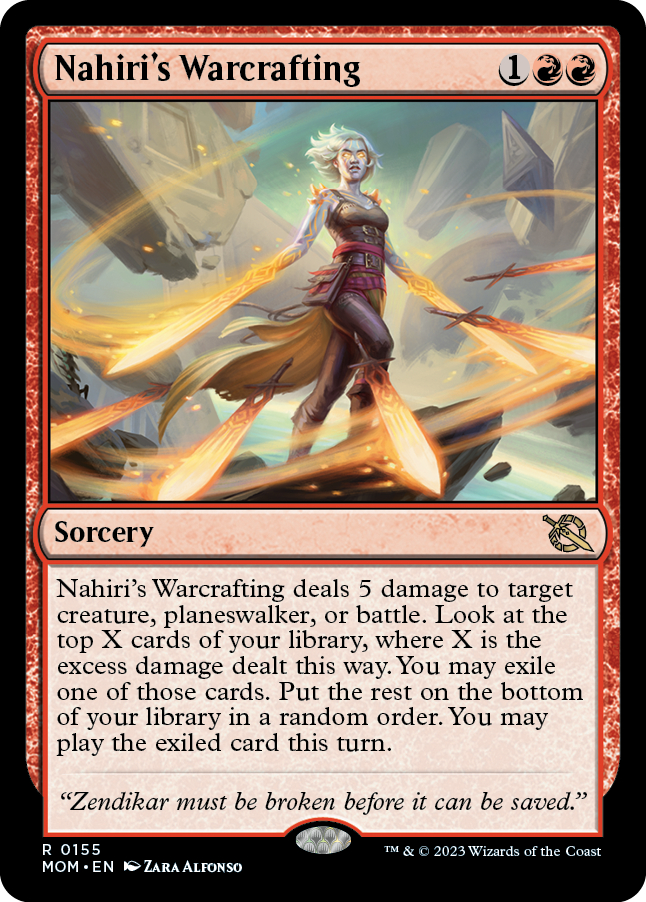
Nahiri's Warcrafting
{1}{R}{R}
Sorcery
Nahiri's Warcrafting deals 5 damage to target creature, planeswalker, or battle. Look at the top X cards of your library, where X is the excess damage dealt this way. You may exile one of those cards. Put the rest on the bottom of your library in a random order. You may play the exiled card this turn.
- A creature has been dealt excess damage if Nahiri's Warcrafting deals more damage to it than the minimum amount of damage required to be lethal damage. In most cases, this means damage greater than the creature's toughness, but consider any damage that was already dealt to it that turn.
- For a planeswalker, excess damage means damage in excess of the planeswalker's loyalty (the number of loyalty counters it has on it). For a battle, excess damage means damage in excess of the battle's defense (the number of defense counters it has on it).
- Playing the exiled card follows the normal rules for playing that card. You must pay its cost, and you must follow all applicable timing rules. For example, if it's a creature card, you can cast it by paying its mana cost only during your main phase while the stack is empty.
- Unless an effect allows you to play additional lands that turn, you can play an exiled land card only if you haven't played a land yet that turn.
- If you don't play the card, it will remain exiled.
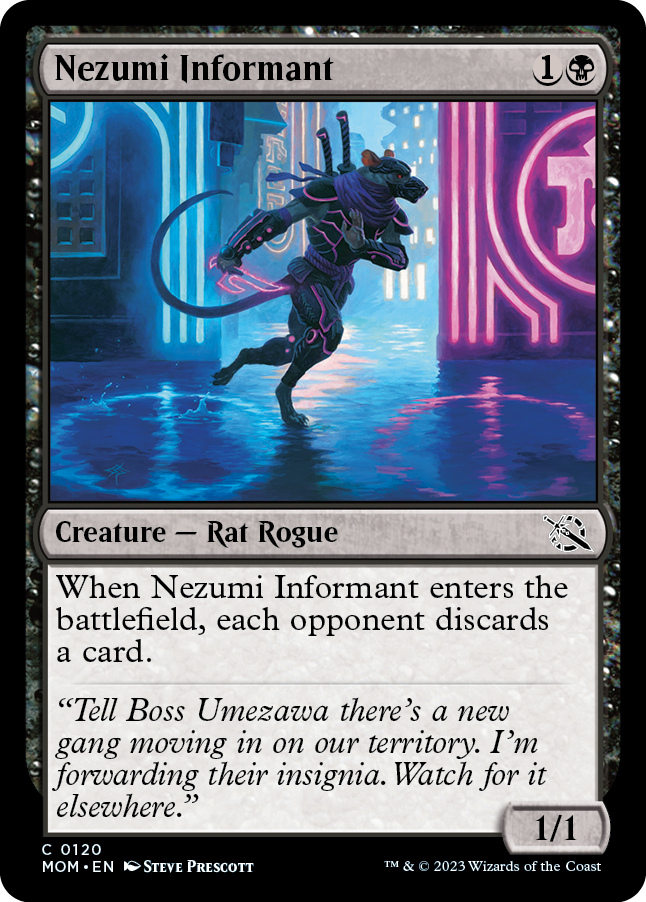
Nezumi Informant
{1}{B}
Creature — Rat Rogue
1/1
When Nezumi Informant enters the battlefield, each opponent discards a card.
- To resolve Nezumi Informant's ability in a multiplayer game, the next opponent in turn order (or, if it's an opponent's turn, the opponent whose turn it is) chooses a card in hand and sets it aside without revealing it. Then each other opponent in turn order does the same. Finally, all chosen cards are revealed and discarded at the same time.
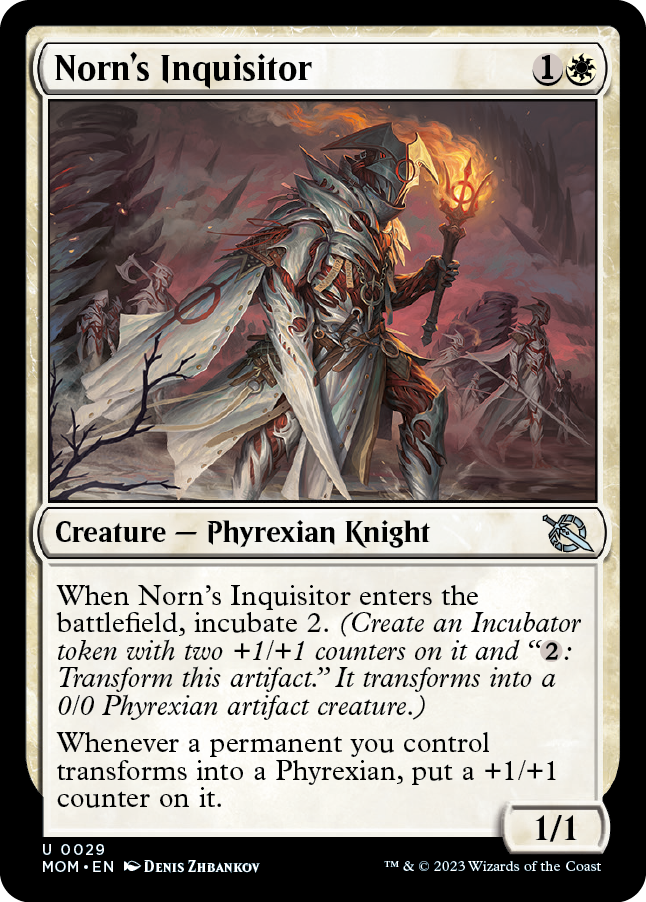
Norn's Inquisitor
{1}{W}
Creature — Phyrexian Knight
1/1
When Norn's Inquisitor enters the battlefield, incubate 2. (Create an Incubator token with two +1/+1 counters on it and "{2}: Transform this artifact." It transforms into a 0/0 Phyrexian artifact creature.)
Whenever a permanent you control transforms into a Phyrexian, put a +1/+1 counter on it.
- Only transforming double-faced permanents (including transforming double-faced cards and Incubator tokens) can transform. A face-up permanent turning face down doesn't count as transforming, nor does a face-down permanent turning face up.
- The last ability of Norn's Inquisitor will trigger if a permanent you control transforms in either direction, going from front face up to back face up or vice versa, as long as it's a Phyrexian after doing so.

Oculus Whelp
{3}{U}
Creature — Phyrexian Dragon
3/2
Flying
As long as you control a transformed permanent, Oculus Whelp has "When Oculus Whelp dies, draw a card."
- A "transformed permanent" is a double-faced permanent with its back face up. Notably, modal double-faced permanents and melded permanents are never transformed permanents, no matter which faces are up.
- If Oculus Whelp dies at the same time as your transformed permanents, its ability will trigger, and you'll draw a card. (This wouldn't be true if the ability were worded differently, in case you were wondering.)
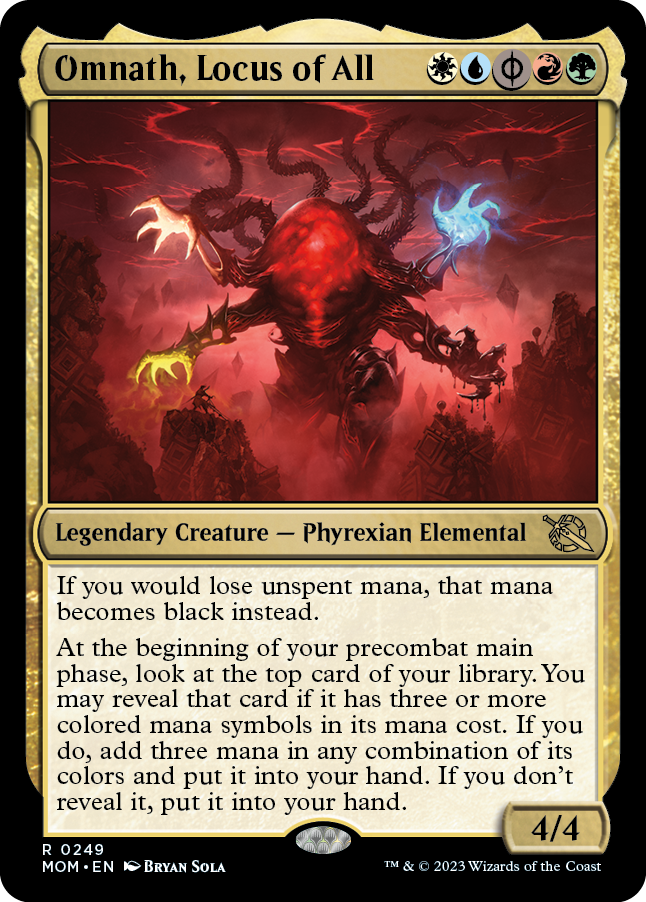
Omnath, Locus of All
{W}{U}{B/P}{R}{G}
Legendary Creature — Phyrexian Elemental
4/4
If you would lose unspent mana, that mana becomes black instead.
At the beginning of your precombat main phase, look at the top card of your library. You may reveal that card if it has three or more colored mana symbols in its mana cost. If you do, add three mana in any combination of its colors and put it into your hand. If you don't reveal it, put it into your hand.
- As long as Omnath, Locus of All remains under your control, you'll retain unspent mana as steps and phases end, although that mana will become black. This means you can add mana and spend it during a future step, phase, or turn. Once Omnath leaves your control, you'll have until the end of the current step or phase to spend the mana before it is lost.
- If unspent mana you have has any restrictions or riders associated with it (for example, if it was produced by Omen Hawker), those restrictions or riders remain associated with that mana when it becomes black.
- Omnath's last ability isn't a mana ability even though it can cause you to add mana. It uses the stack and can be responded to.
- The mana symbols in the card you reveal may be in any combination of colors. For example, you could reveal a card with mana cost {1}{R}{R}{R}, one with mana cost {4}{U}{R}{W}, one with mana cost {W}{U}{B}{R}{G}, or one with mana cost {r/g}{G}{g/w}.
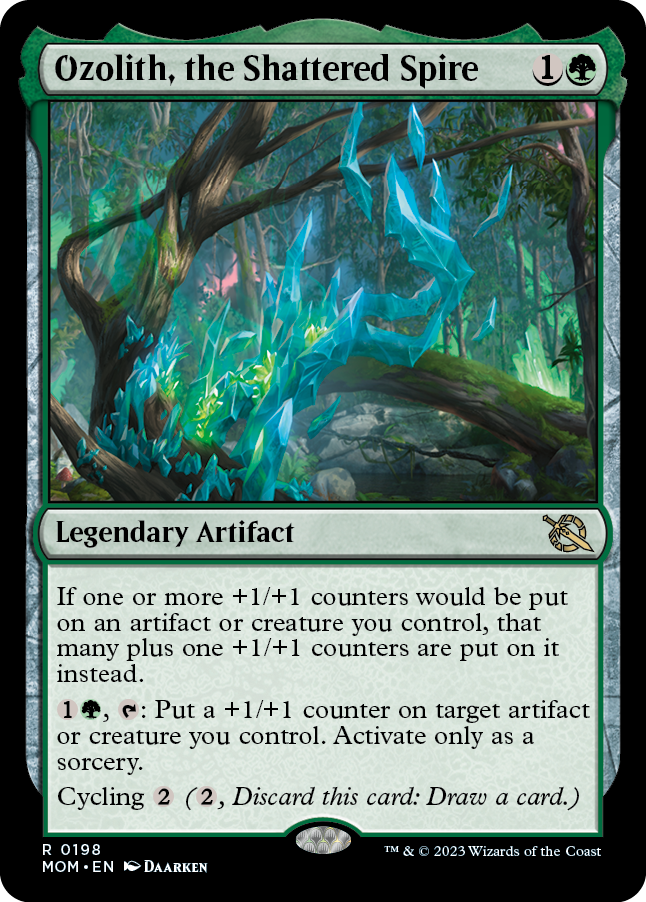
Ozolith, the Shattered Spire
{1}{G}
Legendary Artifact
If one or more +1/+1 counters would be put on an artifact or creature you control, that many plus one +1/+1 counters are put on it instead.
{1}{G}, {T}: Put a +1/+1 counter on target artifact or creature you control. Activate only as a sorcery.
Cycling {2} ({2}, Discard this card: Draw a card.)
- If another artifact or creature you control would enter the battlefield with a number of +1/+1 counters on it, it enters with that many plus one instead.
- However, if Ozolith, the Shattered Spire somehow enters the battlefield with +1/+1 counters it, its first ability won't apply to itself.
- If you somehow control two copies of Ozolith, the Shattered Spire, the number of +1/+1 counters put on an artifact or creature you control is two plus the original number. Three Ozoliths add three, and so on.
- If two or more effects attempt to modify how many counters would be put onto a permanent you control, you choose the order to apply those effects, no matter who controls the sources of those effects.
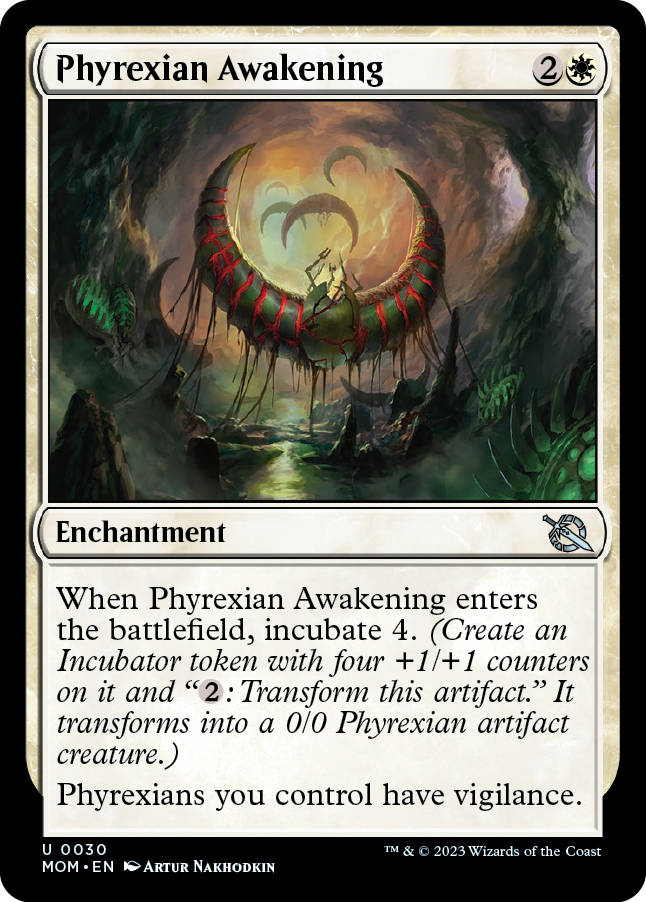
Phyrexian Awakening
{2}{W}
Enchantment
When Phyrexian Awakening enters the battlefield, incubate 4. (Create an Incubator token with four +1/+1 counters on it and "{2}: Transform this artifact." It transforms into a 0/0 Phyrexian artifact creature.)
Phyrexians you control have vigilance.
- Once a Phyrexian you control has legally attacked, causing it to lose vigilance by removing Phyrexian Awakening from the battlefield won't cause that Phyrexian to become tapped.
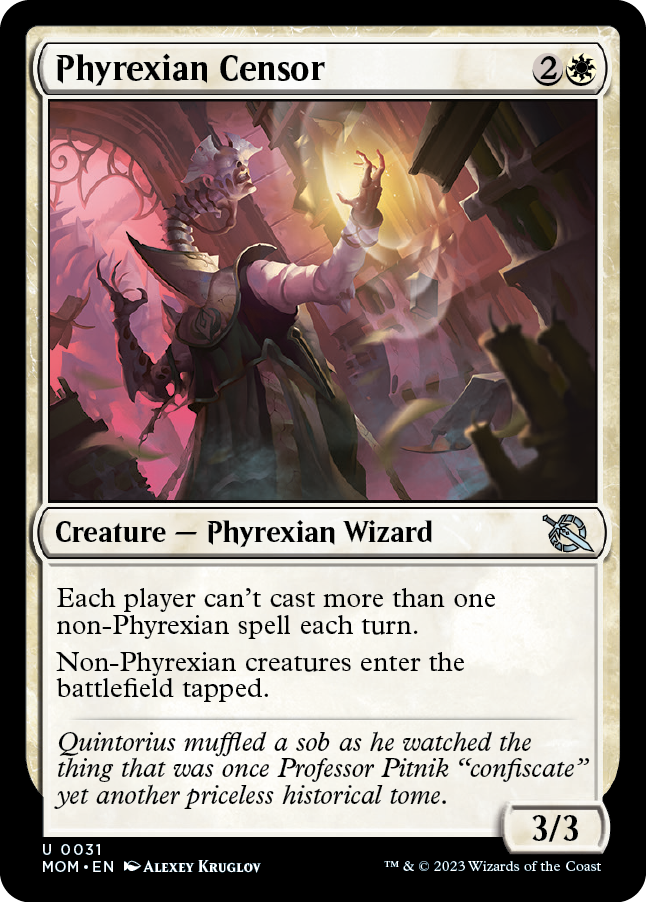
Phyrexian Censor
{2}{W}
Creature — Phyrexian Wizard
3/3
Each player can't cast more than one non-Phyrexian spell each turn.
Non-Phyrexian creatures enter the battlefield tapped.
- A "non-Phyrexian spell" is any spell that doesn't have the Phyrexian creature type, even if "Phyrexian" appears in its name. Artifact spells, battle spells, and Goblin creature spells are examples of non-Phyrexian spells.
- Phyrexian Censor looks at the entire turn to see if a player has cast a non-Phyrexian spell, even if Phyrexian Censor wasn't on the battlefield when that spell was cast. Phyrexian Censor is a Phyrexian spell, so you could cast it and then a non-Phyrexian spell in the same turn.
- If a player casts a non-Phyrexian spell that was countered, they can't cast another non-Phyrexian spell during the same turn.
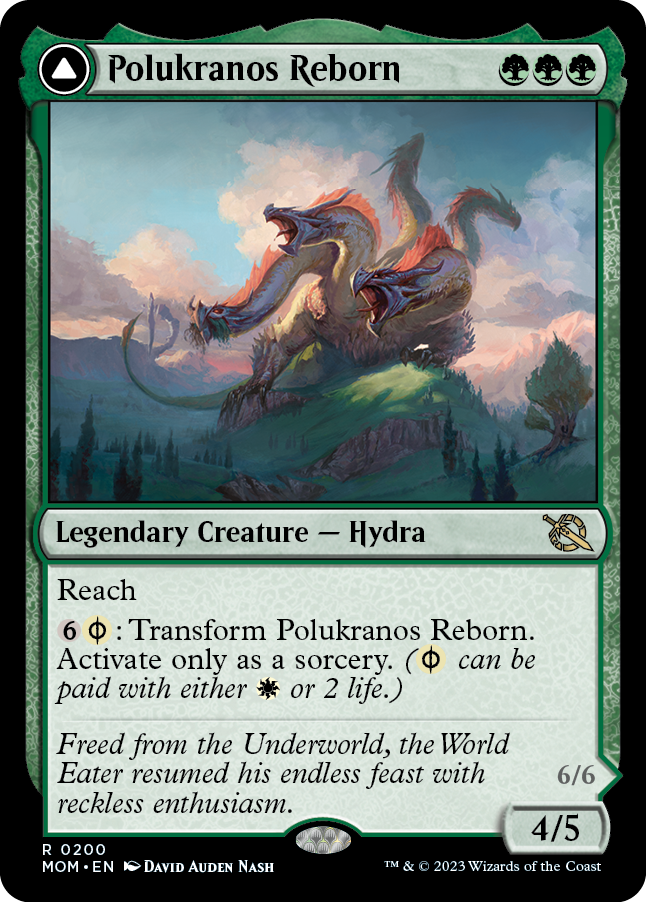
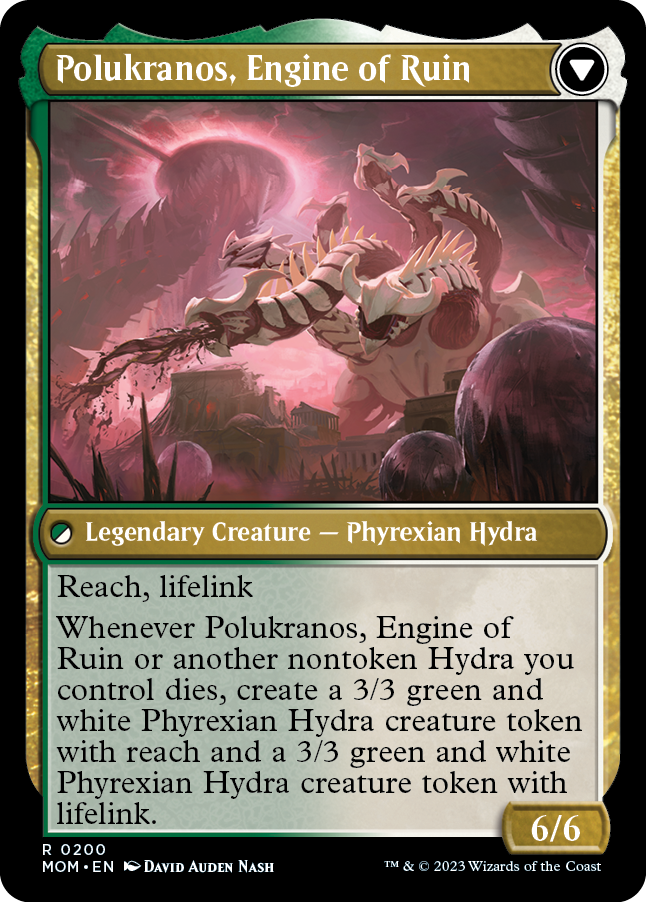
Polukranos Reborn
{G}{G}{G}
Legendary Creature — Hydra
4/5
Reach
{6}{W/P}: Transform Polukranos Reborn. Activate only as a sorcery. ({W/P} can be paid with either {W} or 2 life.)
////
Polukranos, Engine of Ruin
Legendary Creature — Phyrexian Hydra
6/6
Reach, lifelink
Whenever Polukranos, Engine of Ruin or another nontoken Hydra you control dies, create a 3/3 green and white Phyrexian Hydra creature token with reach and a 3/3 green and white Phyrexian Hydra creature token with lifelink.
- If Polukranos, Engine of Ruin and other nontoken Hydras you control die at the same time, Polukranos's triggered ability will trigger once for itself and once for each of those other Hydras.
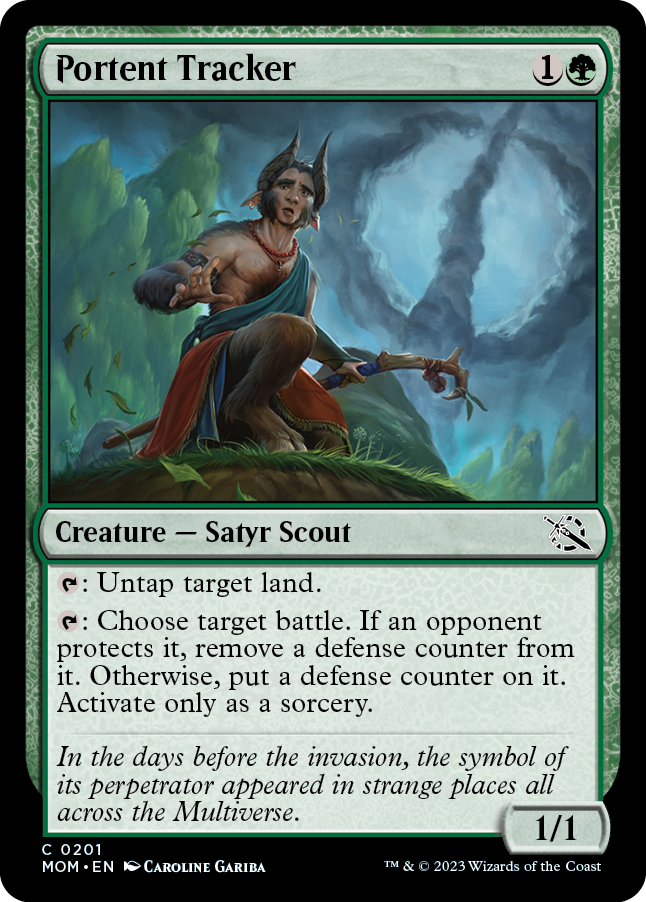
Portent Tracker
{1}{G}
Creature — Satyr Scout
1/1
{T}: Untap target land.
{T}: Choose target battle. If an opponent protects it, remove a defense counter from it. Otherwise, put a defense counter on it. Activate only as a sorcery.
- Portent Tracker's first ability isn't a mana ability. Notably, it can't be used while you're activating an ability or casting a spell. If you plan to use it to produce enough mana to activate an ability or cast a spell, you must do so ahead of time.
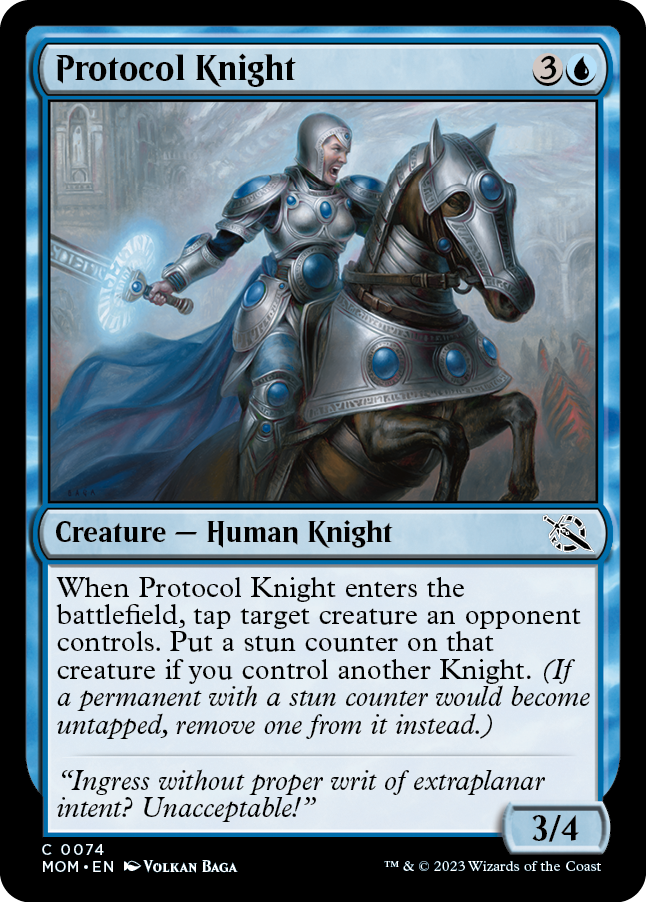
Protocol Knight
{3}{U}
Creature — Human Knight
3/4
When Protocol Knight enters the battlefield, tap target creature an opponent controls. Put a stun counter on that creature if you control another Knight. (If a permanent with a stun counter would become untapped, remove one from it instead.)
- Protocol Knight's ability can target a creature that's already tapped.
- Whether or not you control another Knight is checked only as Protocol Knight's ability is resolving. It doesn't matter if you still control Protocol Knight at that time, or if it's still a Knight.
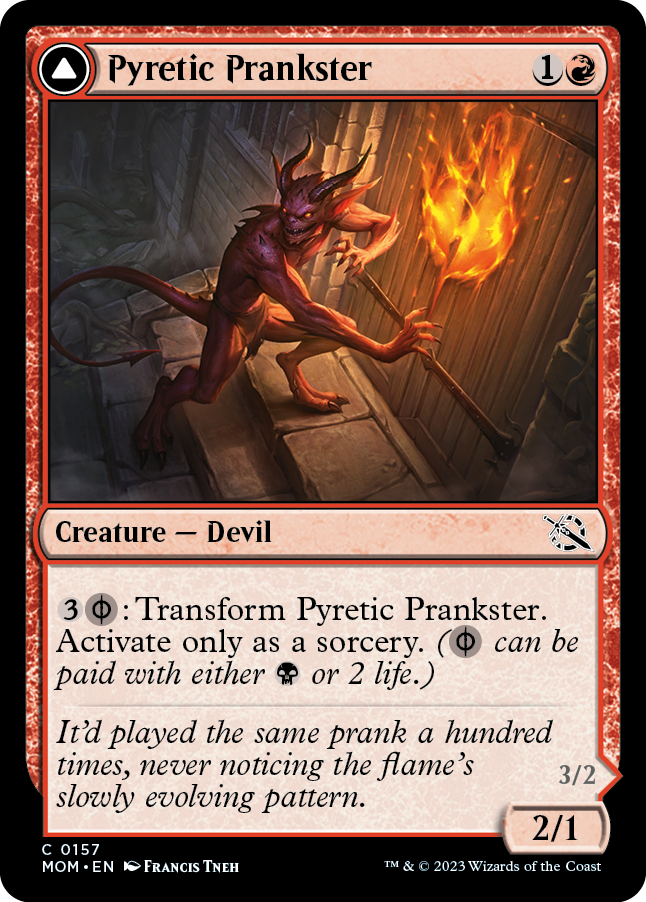

Pyretic Prankster
{1}{R}
Creature — Devil
2/1
{3}{B/P}: Transform Pyretic Prankster. Activate only as a sorcery. ({B/P} can be paid with either {B} or 2 life.)
////
Glistening Goremonger
Creature — Phyrexian Devil
3/2
When Glistening Goremonger dies, each opponent sacrifices an artifact or creature.
- If an opponent controls only artifacts and no creatures, or vice versa, they must sacrifice one. They can't choose to sacrifice an artifact and then fail to do so while they control a creature.
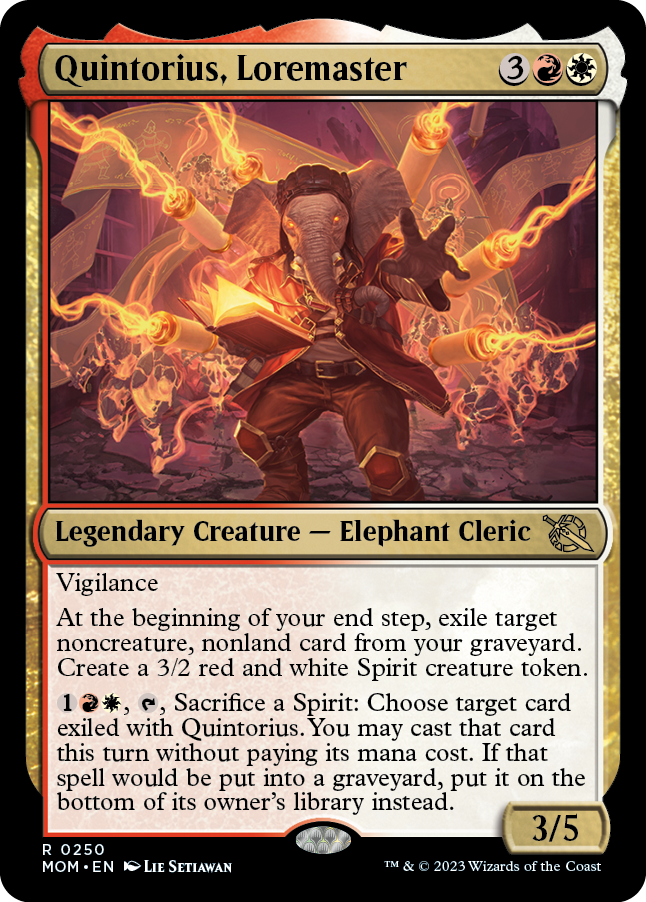
Quintorius, Loremaster
{3}{R}{W}
Legendary Creature — Elephant Cleric
3/5
Vigilance
At the beginning of your end step, exile target noncreature, nonland card from your graveyard. Create a 3/2 red and white Spirit creature token.
{1}{R}{W}, {T}, Sacrifice a Spirit: Choose target card exiled with Quintorius. You may cast that card this turn without paying its mana cost. If that spell would be put into a graveyard, put it on the bottom of its owner's library instead.
- If the target of Quintorius's triggered ability is an illegal target at the time the ability tries to resolve, the ability won't resolve and none of its effects will happen. You won't create a Spirit token.
- Quintorius's last two abilities are linked. The last ability can target only cards exiled by the triggered ability. If a Spirit you sacrifice to activate the last ability ends up being exiled because of a replacement effect, that card can't be targeted by the last ability.
- You must follow all applicable timing rules for casting the exiled card. For example, if the card is a sorcery card, you can cast it only during your main phase while the stack is empty.
- If you cast a card "without paying its mana cost," you can't choose to cast it for any alternative costs. You can, however, pay additional costs. If the card has any mandatory additional costs, you must pay those to cast the card.
- If the card has {X} in its mana cost, you must choose 0 as the value of X when casting it without paying its mana cost.
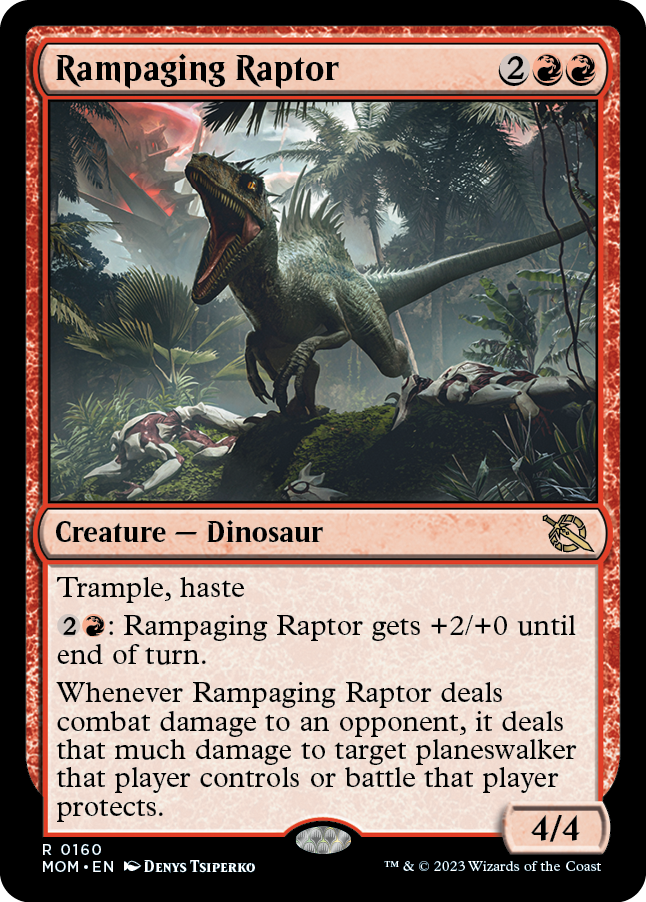
Rampaging Raptor
{2}{R}{R}
Creature — Dinosaur
4/4
Trample, haste
{2}{R}: Rampaging Raptor gets +2/+0 until end of turn.
Whenever Rampaging Raptor deals combat damage to an opponent, it deals that much damage to target planeswalker that player controls or battle that player protects.
- Unlike many similar abilities, Rampaging Raptor's triggered ability triggers whenever it deals combat damage to an opponent, not to a player. If it happens to deal combat damage to you (usually due to a redirection effect, which would be unusual), the ability won't trigger.
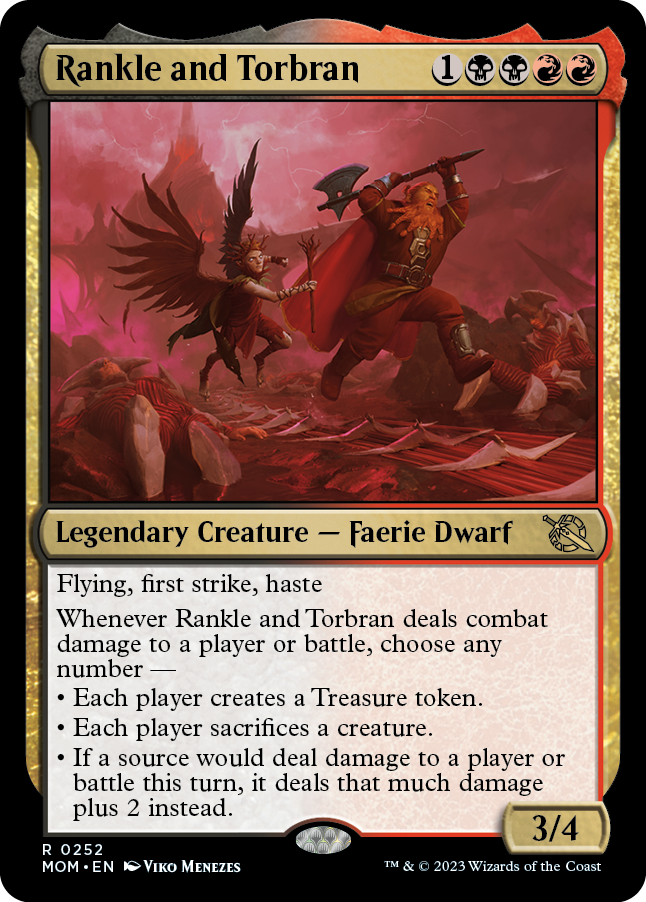
Rankle and Torbran
{1}{B}{B}{R}{R}
Legendary Creature — Faerie Dwarf
3/4
Flying, first strike, haste
Whenever Rankle and Torbran deals combat damage to a player or battle, choose any number —
• Each player creates a Treasure token.
• Each player sacrifices a creature.
• If a source would deal damage to a player or battle this turn, it deals that much damage plus 2 instead.
- You may choose none of the modes, some of them, or all of them. Any modes chosen will happen in order.
- To resolve the second mode, starting with you (or, in unusual cases, the player whose turn it is if not you) and proceeding in turn order, each player chooses a creature they control to sacrifice. Then those creatures are sacrificed at the same time.
- The additional 2 damage is dealt by the same source as the original source of damage. The damage isn't dealt by Rankle and Torbran unless Rankle and Torbran is the original source of damage.
- If another effect modifies how much damage a source would deal, including preventing some of it, the player being dealt damage or the controller of the permanent being dealt damage chooses an order in which to apply those effects. If all of the damage is prevented, Rankle and Torbran's effect no longer applies.
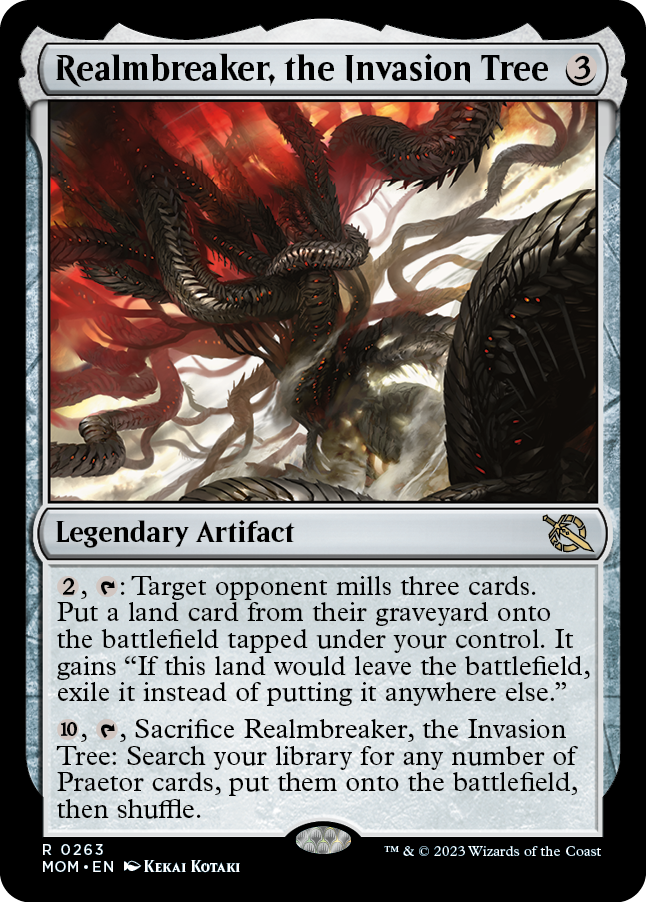
Realmbreaker, the Invasion Tree
{3}
Legendary Artifact
{2}, {T}: Target opponent mills three cards. Put a land card from their graveyard onto the battlefield tapped under your control. It gains "If this land would leave the battlefield, exile it instead of putting it anywhere else."
{10}, {T}, Sacrifice Realmbreaker, the Invasion Tree: Search your library for any number of Praetor cards, put them onto the battlefield, then shuffle.
- The land card you put onto the battlefield can be one that was just milled, or it can be one that was already in their graveyard.
- In a multiplayer game, if a player leaves the game, all cards that player owns leave as well. If you leave the game, any lands you control from Realmbreaker's ability are exiled.
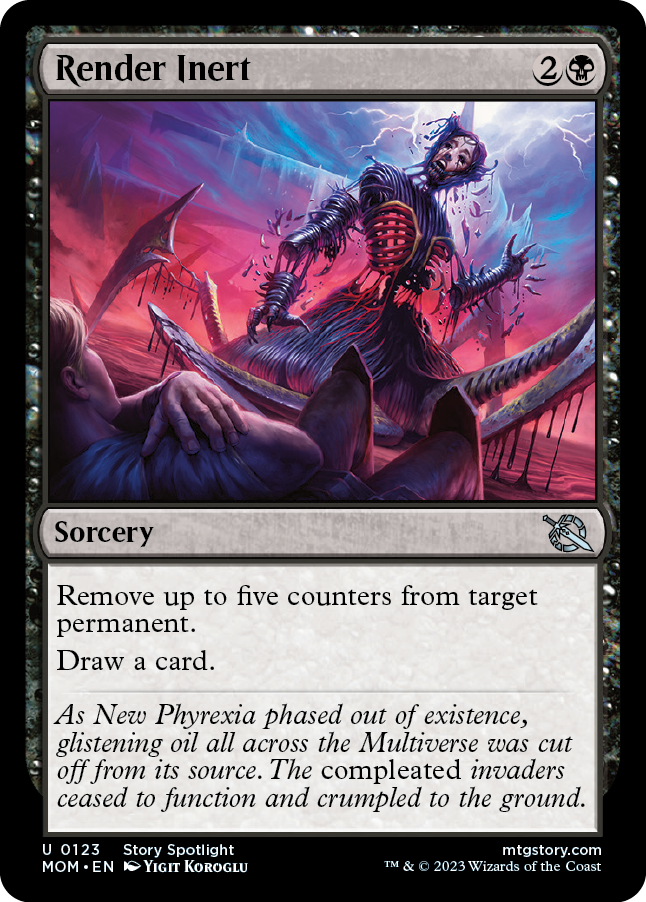
Render Inert
{2}{B}
Sorcery
Remove up to five counters from target permanent.
Draw a card.
- You choose which counters to remove from the permanent, no matter who controls it. You may choose counters of different kinds.
- You can choose a permanent with no counters on it as the target. You'll still draw a card.
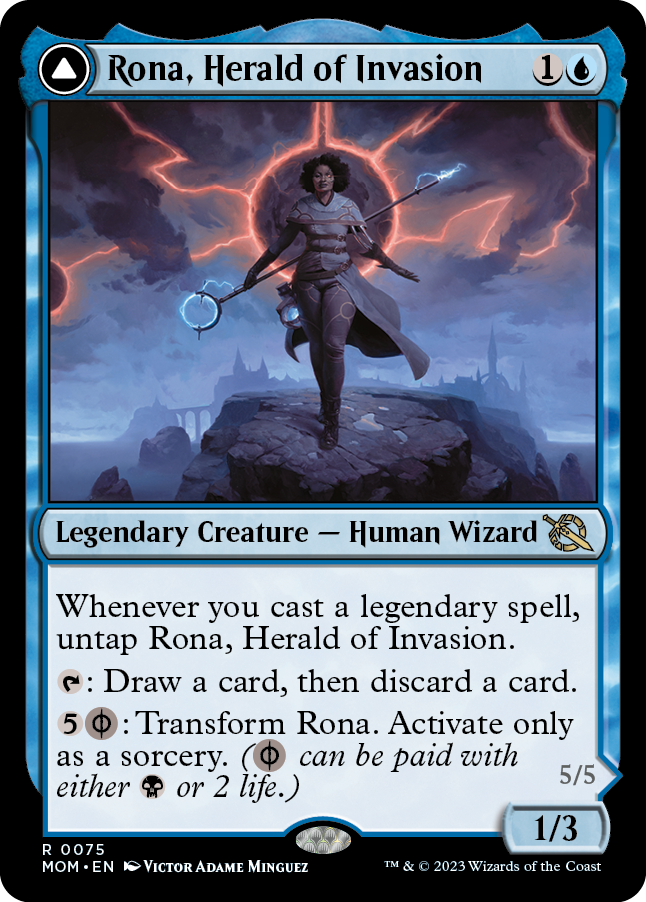
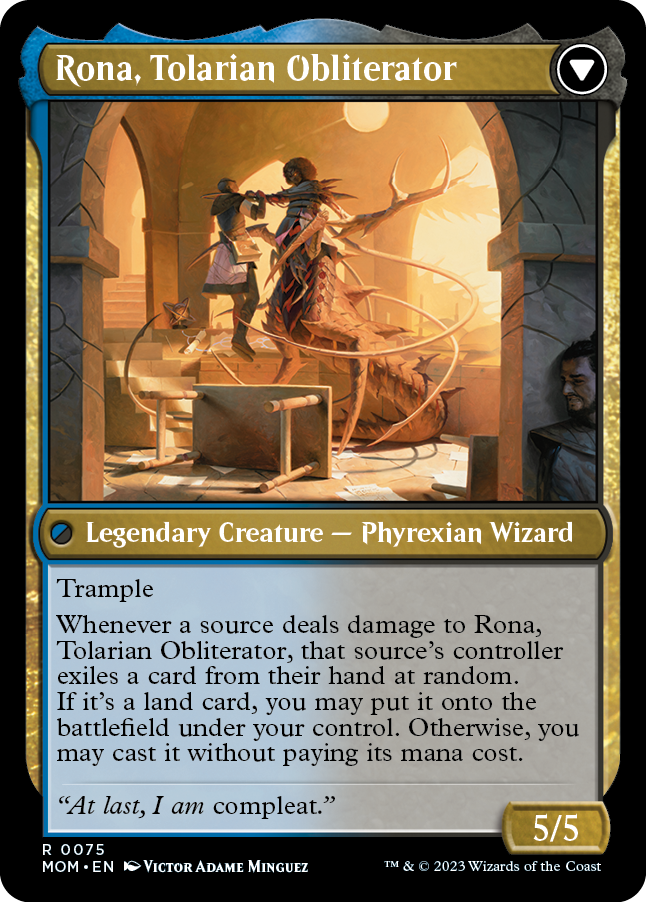
Rona, Herald of Invasion
{1}{U}
Legendary Creature — Human Wizard
1/3
Whenever you cast a legendary spell, untap Rona, Herald of Invasion.
{T}: Draw a card, then discard a card.
{5}{B/P}: Transform Rona. Activate only as a sorcery. ({B/P} can be paid with either {B} or 2 life.)
////
Rona, Tolarian Obliterator
Legendary Creature — Phyrexian Wizard
5/5
Trample
Whenever a source deals damage to Rona, Tolarian Obliterator, that source's controller exiles a card from their hand at random. If it's a land card, you may put it onto the battlefield under your control. Otherwise, you may cast it without paying its mana cost.
- The first ability of Rona, Herald of Invasion will resolve before the spell that caused it to trigger.
- Playing a legendary land won't cause the first ability to trigger.
- The spell you cast from exile without paying its mana cost is cast during the resolution of the triggered ability. Timing restrictions of that spell based on card type are ignored.
- If you cast a spell without paying its mana cost, you can't choose to cast it for any alternative costs. You can, however, pay any additional costs. If the spell has any mandatory additional costs, you must pay those.
- If the spell has {X} in its mana cost, you must choose 0 as the value of X when casting it without paying its mana cost.

Sandstalker Moloch
{1}{G}{G}
Creature — Lizard
4/2
Flash
When Sandstalker Moloch enters the battlefield, if an opponent cast a blue and/or black spell this turn, look at the top four cards of your library. You may reveal a permanent card from among them and put it into your hand. Put the rest on the bottom of your library in a random order.
- It doesn't matter if the blue and/or black spell an opponent cast that turn resolved, didn't resolve, was countered, or is still on the stack.
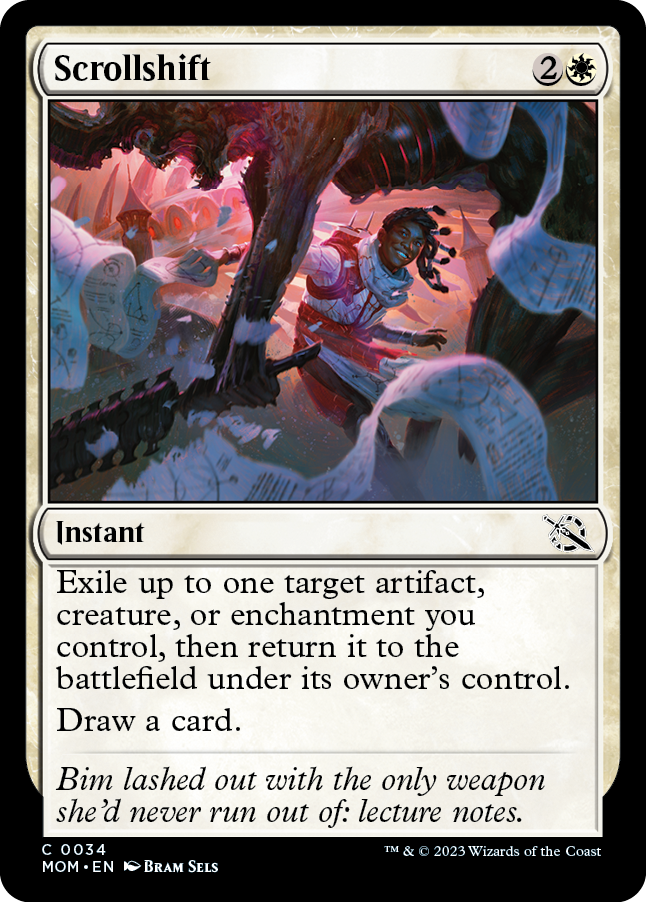
Scrollshift
{2}{W}
Instant
Exile up to one target artifact, creature, or enchantment you control, then return it to the battlefield under its owner's control.
Draw a card.
- You don't have to choose a target for Scrollshift. However, if you do, and that permanent is an illegal target at the time Scrollshift tries to resolve, it won't resolve and none of its effects will happen. You won't draw a card.
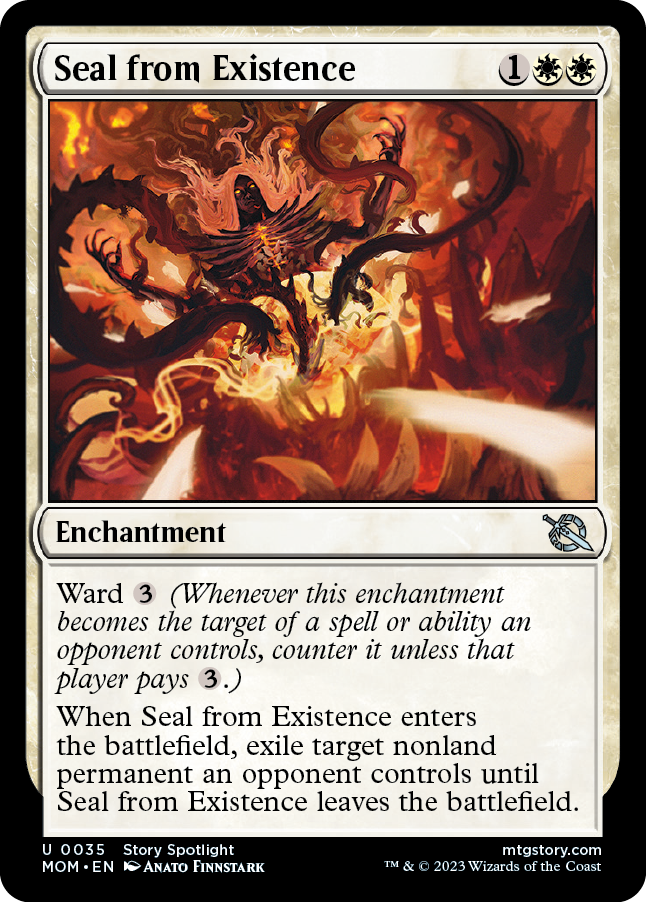
Seal from Existence
{1}{W}{W}
Enchantment
Ward {3} (Whenever this enchantment becomes the target of a spell or ability an opponent controls, counter it unless that player pays {3}.)
When Seal from Existence enters the battlefield, exile target nonland permanent an opponent controls until Seal from Existence leaves the battlefield.
- Seal from Existence's last ability creates two one-shot effects: one that exiles the permanent when the ability resolves, and another that returns the exiled card to the battlefield immediately after Seal from Existence leaves the battlefield.
- If Seal from Existence leaves the battlefield before its last ability resolves, the target permanent won't be exiled.
- Auras attached to the exiled permanent will be put into their owners' graveyards. Equipment attached to an exiled creature will become unattached and remain on the battlefield. Any counters on the exiled permanent will cease to exist.
- If a token is exiled, it ceases to exist. It won't be returned to the battlefield.
- In a multiplayer game, if Seal from Existence's owner leaves the game, the exiled card will return to the battlefield. Because the one-shot effect that returns the card isn't an ability that goes on the stack, it won't cease to exist along with the leaving player's spells and abilities on the stack.
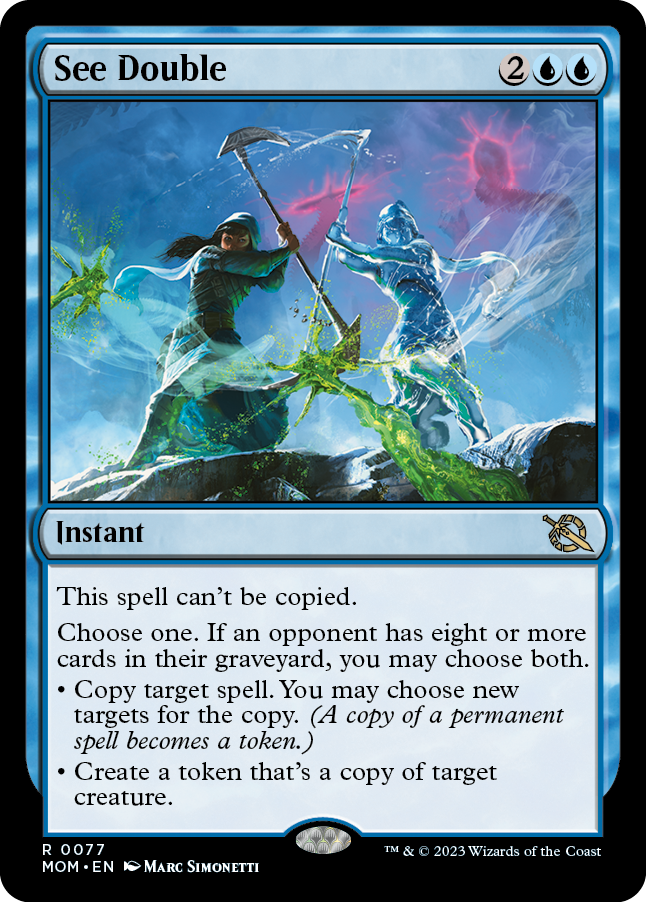
See Double
{2}{U}{U}
Instant
This spell can't be copied.
Choose one. If an opponent has eight or more cards in their graveyard, you may choose both.
• Copy target spell. You may choose new targets for the copy. (A copy of a permanent spell becomes a token.)
• Create a token that's a copy of target creature.
- You may choose both modes if any opponent has eight or more cards in their graveyard, not necessarily all of them.
- Once you've cast See Double and legally chosen both modes, it doesn't matter what happens to the number of cards in opponents' graveyards.
- A copy of a spell is created on the stack, so it's not "cast." Abilities that trigger when a player casts a spell won't trigger.
- If you copy a spell, you control the copy. It will resolve before the original spell does.
- The copy will have the same targets as the spell it's copying unless you choose new ones. You may change any number of the targets, including all of them or none of them. If, for one of the targets, you can't choose a new legal target, then it remains unchanged (even if the current target is illegal).
- If the spell that's copied is modal (that is, it includes a choice from a bulleted list of effects), the copy will have the same mode. A different mode can't be chosen.
- If the spell that's copied has an X whose value was determined as it was cast, the copy will have the same value of X.
- If the spell has damage divided as it was cast, the division can't be changed (although the targets receiving that damage still can). The same is true of spells that distribute counters.
- You can't choose to pay any alternative or additional costs for the copy of the spell. However, effects based on any alternative or additional costs that were paid for the original spell are copied as though those same costs were paid for the copy.
- The token copies exactly what was printed on the original creature and nothing else (unless that creature is copying something else or is a token; see below). It doesn't copy whether that creature is tapped or untapped, whether it has any counters on it or Auras and Equipment attached to it, or any non-copy effects that have changed its power, toughness, types, color, and so on.
- If the copied creature has {X} in its mana cost, X is 0.
- If the copied creature is a token, the token that's created copies the original characteristics of that token as stated by the effect that created that token.
- If the copied creature is copying something else, then the token enters the battlefield as whatever that creature copied.
- Any enters-the-battlefield abilities of the copied creature will trigger when the token enters the battlefield. Any "as [this creature] enters the battlefield" or "[this creature] enters the battlefield with" abilities of the copied creature will also work.
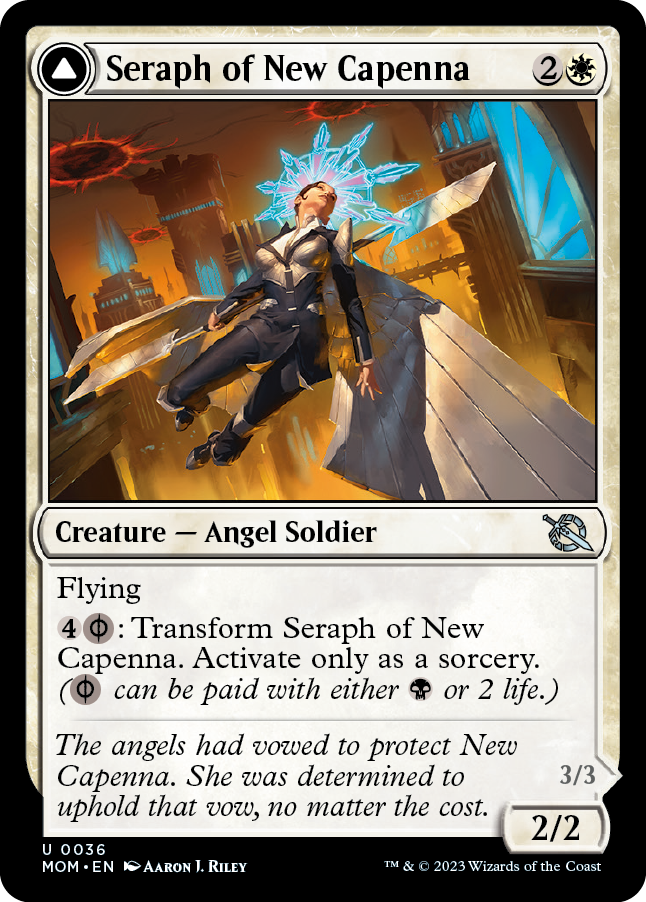

Seraph of New Capenna
{2}{W}
Creature — Angel Soldier
2/2
Flying
{4}{B/P}: Transform Seraph of New Capenna. Activate only as a sorcery. ({B/P} can be paid with either {B} or 2 life.)
////
Seraph of New Phyrexia
Creature — Phyrexian Angel
3/3
Flying
Whenever Seraph of New Phyrexia attacks, you may sacrifice another creature or artifact. If you do, Seraph of New Phyrexia gets +2/+1 until end of turn.
- Any player may respond to Seraph of New Phyrexia's triggered ability, but once that ability starts to resolve, no player may take any actions between you deciding to sacrifice another creature or artifact and Seraph of New Phyrexia getting +2/+1.


Sheoldred
{3}{B}{B}
Legendary Creature — Phyrexian Praetor
4/5
Menace
When Sheoldred enters the battlefield, each opponent sacrifices a nontoken creature or planeswalker.
{4}{B}: Exile Sheoldred, then return it to the battlefield transformed under its owner's control. Activate only as a sorcery and only if an opponent has eight or more cards in their graveyard.
////
The True Scriptures
Enchantment — Saga
(As this Saga enters and after your draw step, add a lore counter.)
I — For each opponent, destroy up to one target creature or planeswalker that player controls.
II — Each opponent discards three cards, then mills three cards.
III — Put all creature cards from all graveyards onto the battlefield under your control. Exile The True Scriptures, then return it to the battlefield (front face up).
- To resolve Sheoldred's enters-the-battlefield ability in a multiplayer game, the next opponent in turn order (or, if it's an opponent's turn, the opponent whose turn it is) chooses a creature they control to sacrifice. Then each other opponent in turn order does the same. Then those creatures are sacrificed at the same time.
- You can activate Sheoldred's last ability if any opponent has eight or more cards in their graveyard, not necessarily all of them.
- Once you've activated Sheoldred's last ability, it doesn't matter what happens to the number of cards in opponents' graveyards. The ability will resolve even if no opponent has eight or more cards in their graveyard by that time.
- To resolve chapter II of The True Scriptures in a multiplayer game, the next opponent in turn order (or, if it's an opponent's turn, the opponent whose turn it is) chooses three cards in hand. Any opponent who has fewer than three cards in hand chooses all cards they have in hand. They set the chosen cards aside without revealing them. Then each other opponent in turn order does the same. Next, all chosen cards are revealed and discarded at the same time. Then, each opponent mills three cards.

Stasis Field
{1}{U}
Enchantment — Aura
Enchant creature
Enchanted creature has base power and toughness 0/2, has defender, and loses all other abilities.
- Stasis Field overwrites all previous effects that set the creature's base power and toughness to specific values. Any power- or toughness-setting effects that start to apply after the ability resolves will overwrite this effect.
- Effects that modify a creature's power and/or toughness, such as the effect of Titanic Growth, will apply to the creature no matter when they started to take effect. The same is true for any counters that change its power and/or toughness and effects that switch its power and toughness.
- If the enchanted creature has an ability that grants abilities to other objects, Stasis Field's effect will stop it from doing so. If the enchanted creature gains an ability after Stasis Field resolves, it will keep that ability.
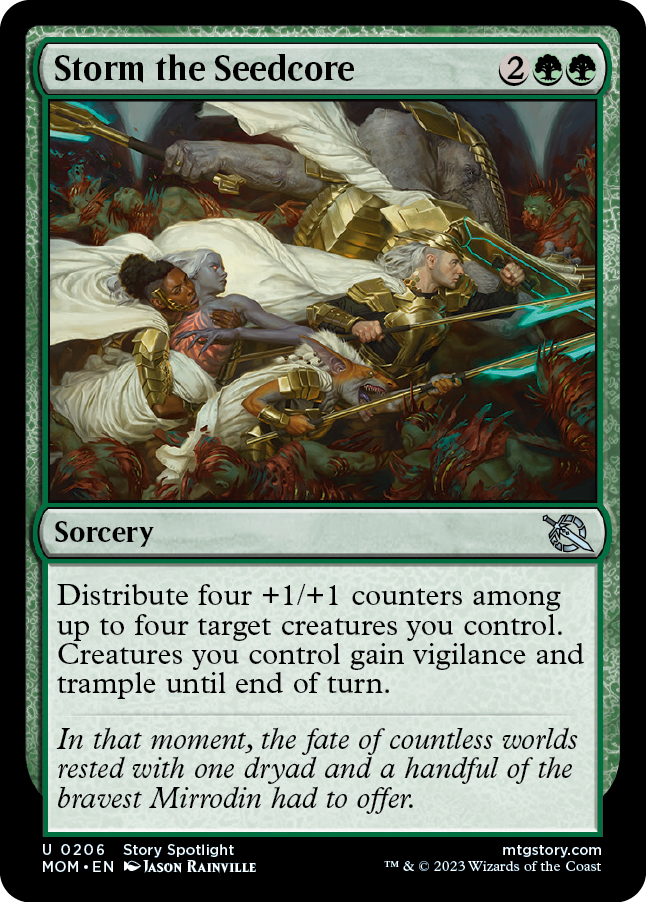
Storm the Seedcore
{2}{G}{G}
Sorcery
Distribute four +1/+1 counters among up to four target creatures you control. Creatures you control gain vigilance and trample until end of turn.
- You choose how many targets Storm the Seedcore has and how the counters will be distributed as you cast the spell. Each target must receive at least one counter.
- If some of the creatures are illegal targets as Storm the Seedcore tries to resolve, the original distribution of counters still applies and the counters that would have been put on the illegal targets are lost. They won't be put instead on a legal target.
- If all of Storm the Seedcore's targets are illegal at the time the spell tries to resolve, it won't resolve and none of its effects will happen. Creatures you control won't gain vigilance and trample.

Streetwise Negotiator
{1}{G}
Creature — Cat Citizen
0/2
Backup 1 (When this creature enters the battlefield, put a +1/+1 counter on target creature. If that's another creature, it gains the following ability until end of turn.)
This creature assigns combat damage equal to its toughness rather than its power.
- Streetwise Negotiator's ability doesn't actually change any creature's power. It changes only the amount of combat damage the creature assigns. All other rules and effects that check power or toughness use the real values, even if they cause damage "equal to a creature's power" to be dealt. Notably, if Streetwise Negotiator (or the creature that gains its ability) fights, it uses its actual power to determine how much damage it deals.
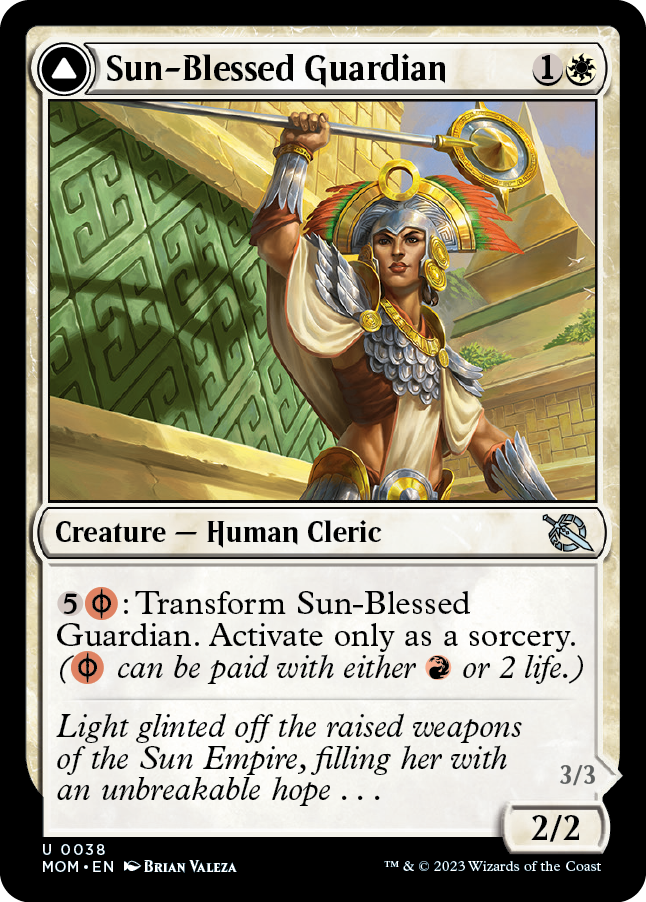
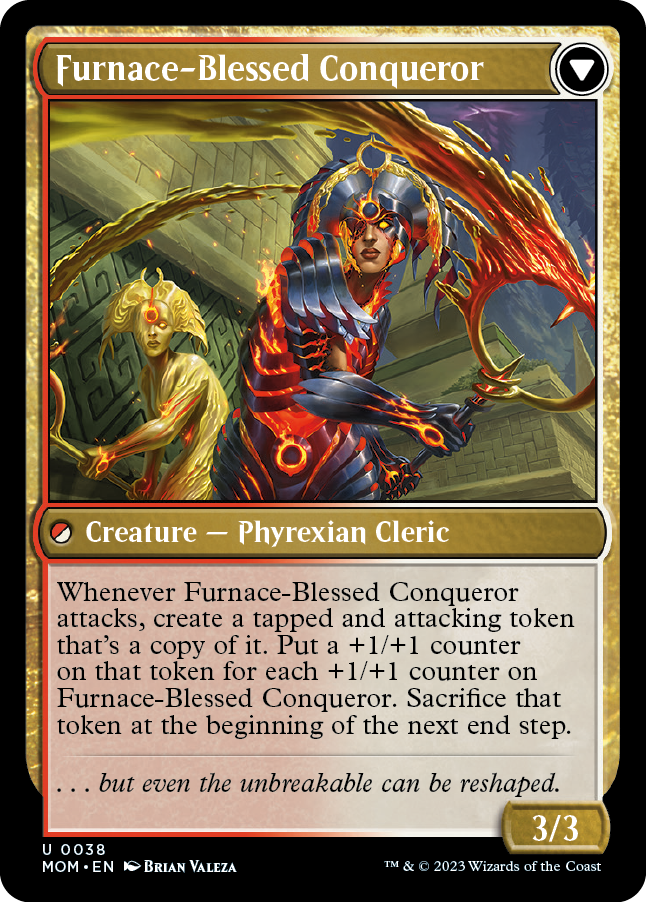
Sun-Blessed Guardian
{1}{W}
Creature — Human Cleric
2/2
{5}{R/P}: Transform Sun-Blessed Guardian. Activate only as a sorcery. ({R/P} can be paid with either {R} or 2 life.)
////
Furnace-Blessed Conqueror
Creature — Phyrexian Cleric
3/3
Whenever Furnace-Blessed Conqueror attacks, create a tapped and attacking token that's a copy of it. Put a +1/+1 counter on that token for each +1/+1 counter on Furnace-Blessed Conqueror. Sacrifice that token at the beginning of the next end step.
- The token doesn't copy whether Furnace-Blessed Conqueror is tapped or untapped (although the effect itself causes it to enter tapped), whether it has any counters on it or Auras and Equipment attached to it, or any non-copy effects that have changed its power, toughness, types, color, and so on.
- The token will enter the battlefield and then have counters put on it. In most cases, the game will see a 3/3 creature entering the battlefield for the purposes of any abilities that may trigger.
- Although the token enters the battlefield attacking, it was never declared as an attacking creature (for the purposes of abilities that trigger whenever a creature attacks, such as its own ability, for example).

Sunder the Gateway
{1}{W}
Sorcery
Choose one —
• Destroy target nontoken artifact or enchantment an opponent controls. Incubate 2. (Create an Incubator token with two +1/+1 counters on it and "{2}: Transform this artifact." It transforms into a 0/0 Phyrexian artifact creature.)
• Incubate 2, then transform an Incubator token you control.
- For the first mode, if the nontoken artifact or enchantment is an illegal target at the time Sunder the Gateway tries to resolve, it won't resolve and none of its effects will happen. You won't incubate.
- For the second mode, the Incubator token is chosen as Sunder the Gateway resolves. You can transform the Incubator token you just created or one you already controlled.
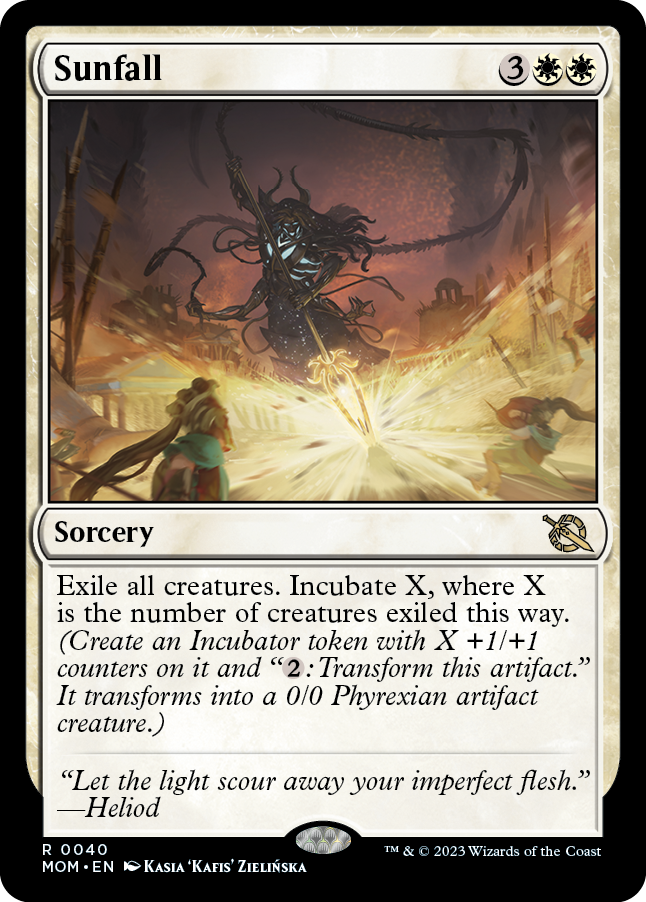
Sunfall
{3}{W}{W}
Sorcery
Exile all creatures. Incubate X, where X is the number of creatures exiled this way. (Create an Incubator token with X +1/+1 counters on it and "{2}: Transform this artifact." It transforms into a 0/0 Phyrexian artifact creature.)
- If Sunfall resolves but doesn't exile any creatures, you'll incubate 0, creating an Incubator token but putting no +1/+1 counters on it. It will still have the ability to transform, but you might need to figure out how it's going to survive first.
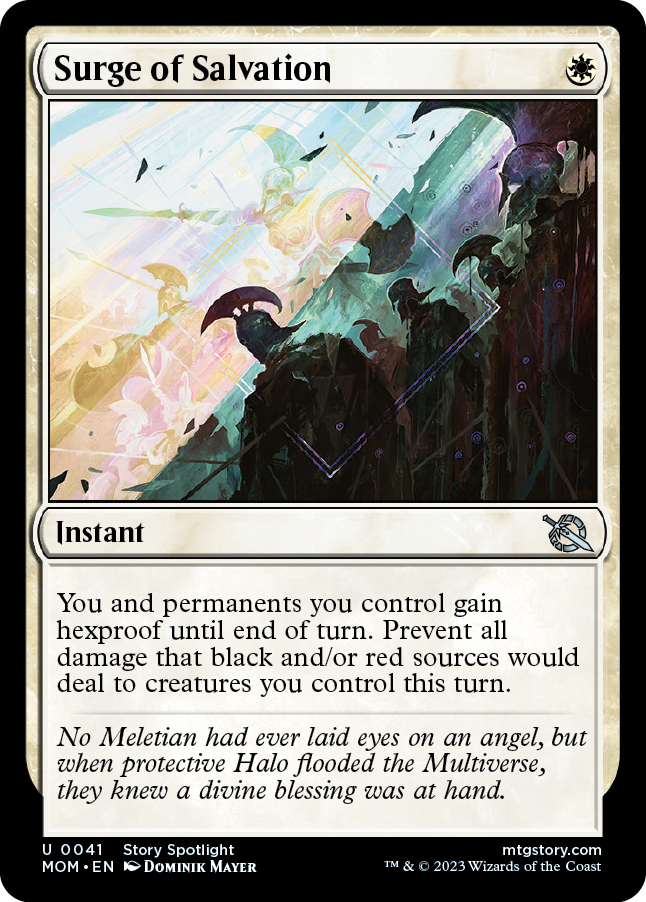
Surge of Salvation
{W}
Instant
You and permanents you control gain hexproof until end of turn. Prevent all damage that black and/or red sources would deal to creatures you control this turn.
- The set of permanents affected by Surge of Salvation is determined as the spell resolves. Permanents you begin to control later in the turn won't gain hexproof.
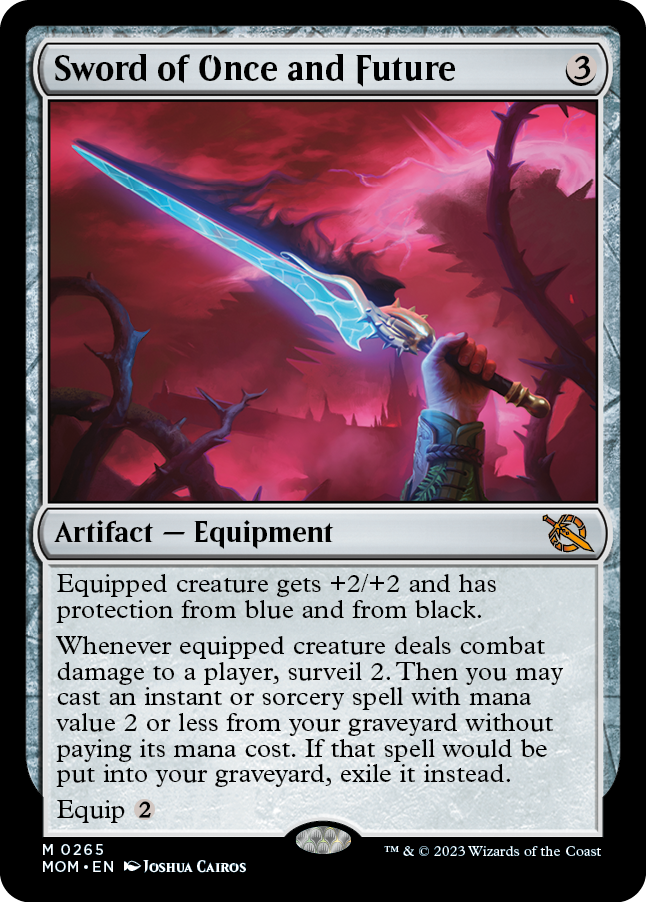
Sword of Once and Future
{3}
Artifact — Equipment
Equipped creature gets +2/+2 and has protection from blue and from black.
Whenever equipped creature deals combat damage to a player, surveil 2. Then you may cast an instant or sorcery spell with mana value 2 or less from your graveyard without paying its mana cost. If that spell would be put into your graveyard, exile it instead.
Equip {2}
- You choose whether or not to cast the instant or sorcery card as the triggered ability resolves. If you do, you do so as part of the resolution of that ability. You can't wait to cast it later in the turn. Timing restrictions based on the card's type are ignored.
- The card you cast may be one you just put into the graveyard with surveil or one already in the graveyard.
- If you cast a card "without paying its mana cost," you can't pay any alternative costs. You can, however, pay additional costs. If the card has any mandatory additional costs, those must be paid to cast the card.
- If the card has {X} in its mana cost, you must choose 0 as the value of X when casting it without paying its mana cost.
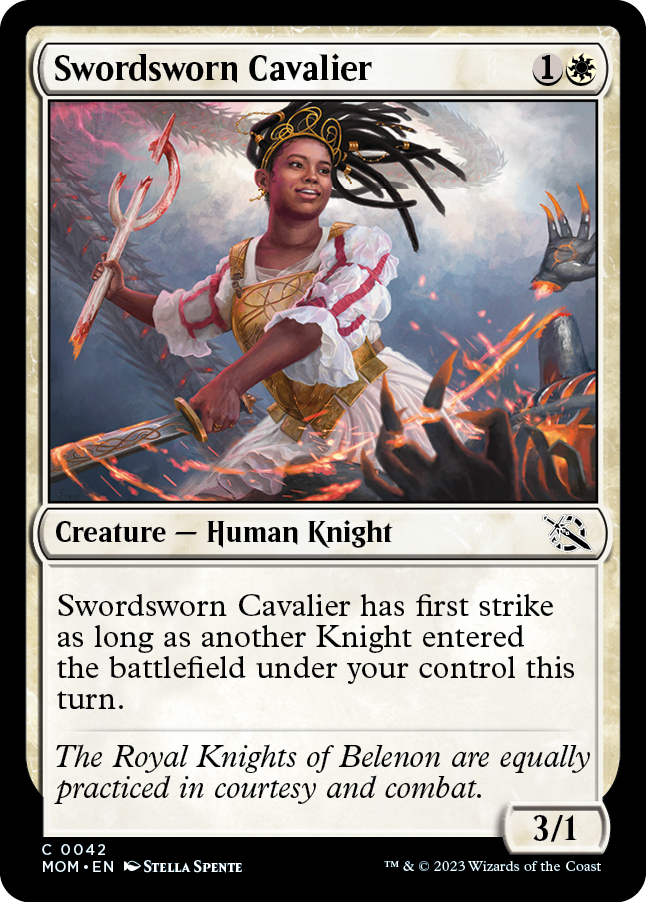
Swordsworn Cavalier
{1}{W}
Creature — Human Knight
3/1
Swordsworn Cavalier has first strike as long as another Knight entered the battlefield under your control this turn.
- Swordsworn Cavalier will continue to have first strike even if the other Knight that entered the battlefield that turn has since left the battlefield, has since stopped being a Knight, or another player has gained control of it.
- If Swordsworn Cavalier enters the battlefield, leaves the battlefield, and returns to the battlefield all in the same turn, it will have first strike that turn. It will have no connection to the object it was and see it as "another Knight."
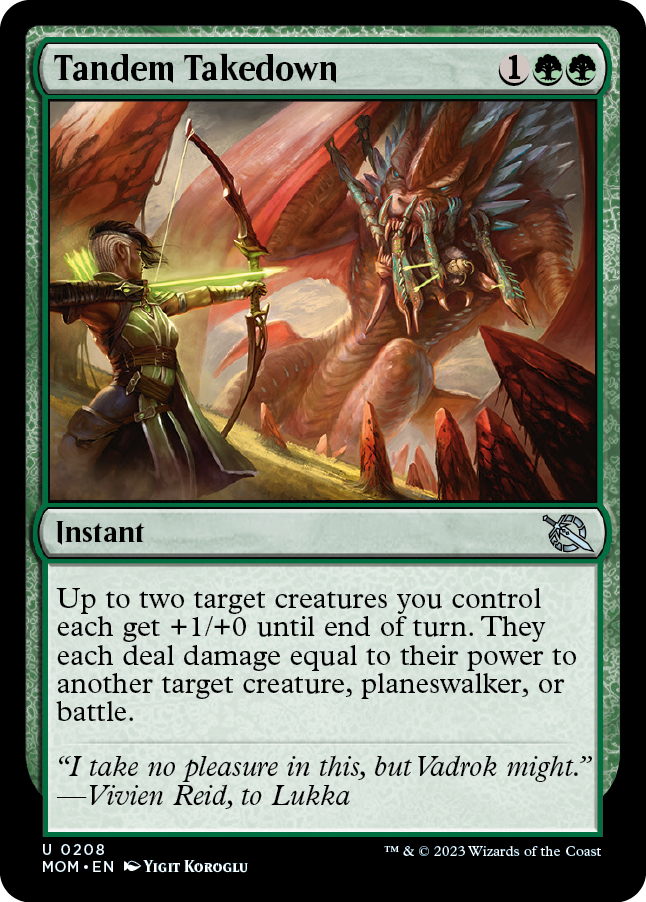
Tandem Takedown
{1}{G}{G}
Instant
Up to two target creatures you control each get +1/+0 until end of turn. They each deal damage equal to their power to another target creature, planeswalker, or battle.
- If one of the two target creatures you control is an illegal target as Tandem Takedown resolves, the other will still get +1/+0 and then deal damage equal to its power.
- If the last target is an illegal target as Tandem Takedown resolves, or if both of the first targets are illegal targets, nothing deals or is dealt damage.
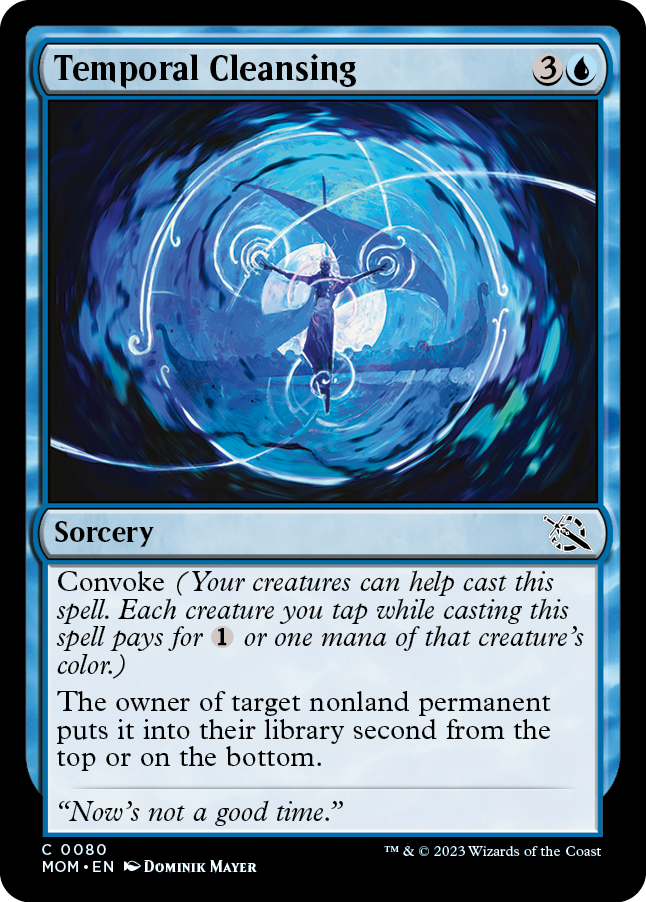
Temporal Cleansing
{3}{U}
Sorcery
Convoke (Your creatures can help cast this spell. Each creature you tap while casting this spell pays for {1} or one mana of that creature's color.)
The owner of target nonland permanent puts it into their library second from the top or on the bottom.
- The owner of the permanent chooses where the card ends up. All players get to know that choice.
- In some unusual cases—though getting less unusual all the time—a permanent will be comprised of multiple cards, such as a melded permanent or a mutated creature. In those cases, the owner of the permanent puts all those cards second from the top (that is, just under the top card) or on the bottom in any order. Other players get to know which one they chose, but they don't get to know the relative order of the cards.
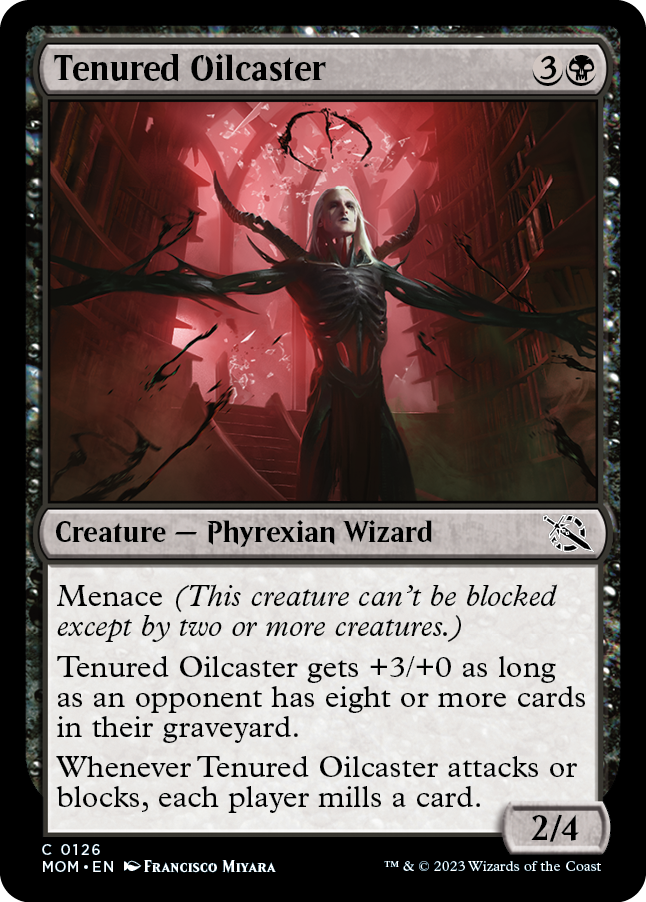
Tenured Oilcaster
{3}{B}
Creature — Phyrexian Wizard
2/4
Menace (This creature can't be blocked except by two or more creatures.)
Tenured Oilcaster gets +3/+0 as long as an opponent has eight or more cards in their graveyard.
Whenever Tenured Oilcaster attacks or blocks, each player mills a card.
- Tenured Oilcaster's second ability will apply if any opponent has eight or more cards in their graveyard, not necessarily all of them.
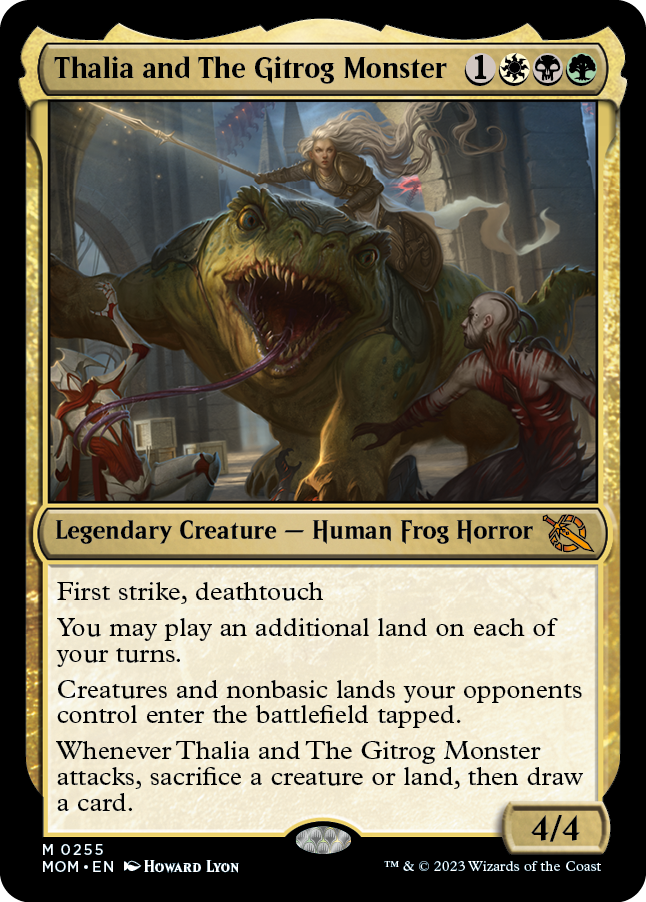
Thalia and The Gitrog Monster
{1}{W}{B}{G}
Legendary Creature — Human Frog Horror
4/4
First strike, deathtouch
You may play an additional land on each of your turns.
Creatures and nonbasic lands your opponents control enter the battlefield tapped.
Whenever Thalia and The Gitrog Monster attacks, sacrifice a creature or land, then draw a card.
- The effect of Thalia and The Gitrog Monster's ability that allows you to play an additional land is cumulative with similar effects. For example, if you control Thalia and The Gitrog Monster and another permanent with that ability, you'll be able to play three lands during each of your turns.
- As the last ability resolves, sacrificing a creature or land isn't optional. If you control a creature or land (and if you control Thalia and The Gitrog Monster, you probably do), you must sacrifice one.
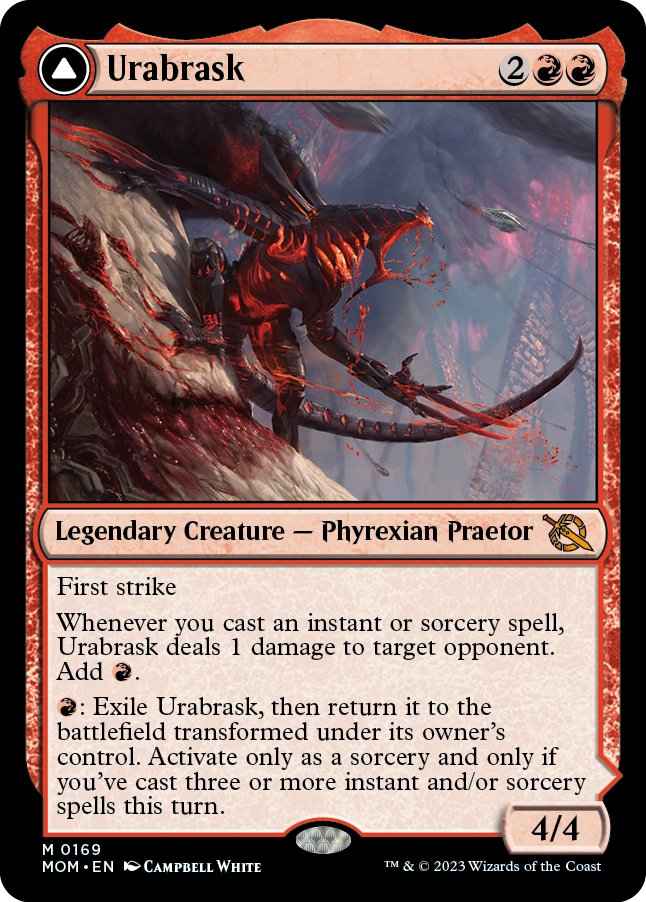
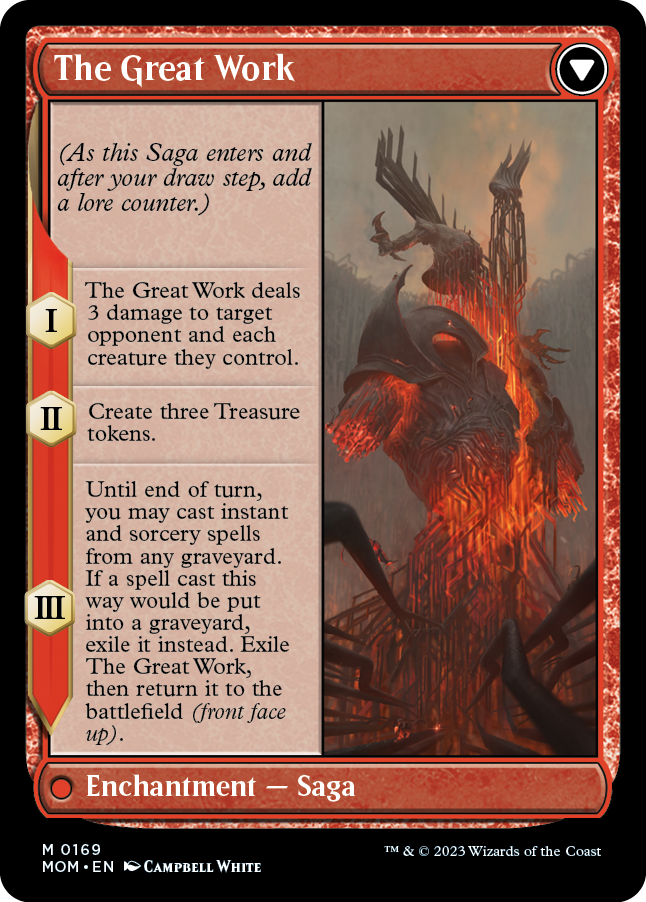
Urabrask
{2}{R}{R}
Legendary Creature — Phyrexian Praetor
4/4
First strike
Whenever you cast an instant or sorcery spell, Urabrask deals 1 damage to target opponent. Add {R}.
{R}: Exile Urabrask, then return it to the battlefield transformed under its owner's control. Activate only as a sorcery and only if you've cast three or more instant and/or sorcery spells this turn.
////
The Great Work
Enchantment — Saga
(As this Saga enters and after your draw step, add a lore counter.)
I — The Great Work deals 3 damage to target opponent and each creature they control.
II — Create three Treasure tokens.
III — Until end of turn, you may cast instant and sorcery spells from any graveyard. If a spell cast this way would be put into a graveyard, exile it instead. Exile The Great Work, then return it to the battlefield (front face up).
- Urabrask's second ability isn't a mana ability, even though it causes you to add mana. It uses the stack and can be responded to.
- Urabrask will count any instant or sorcery spells you've cast during the turn, whether those spells resolved, didn't resolve, were countered, or left the stack some other way. Urabrask won't count copies of instant and sorcery spells that were created on the stack and not cast.
- After chapter III of The Great Work resolves, casting spells from graveyards follows the normal rules for casting those cards. You must pay their costs, and you must follow all applicable timing rules. For example, to cast a sorcery spell from a graveyard, you can do so by paying its mana cost only during your main phase while the stack is empty.
- If multiple players are allowed to cast the same card, the player with priority at any given time determines who can cast it. The player whose turn it is has priority as each step and phase begins, and they receive priority after each spell and ability resolves. This means immediately after chapter III resolves you'll have priority to cast spells before any other player does.
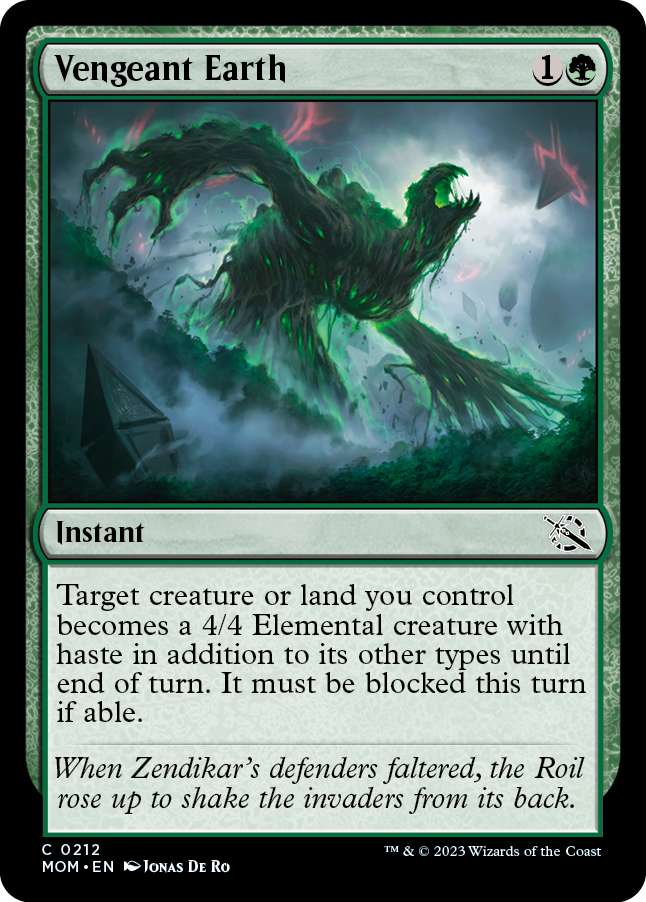
Vengeant Earth
{1}{G}
Instant
Target creature or land you control becomes a 4/4 Elemental creature with haste in addition to its other types until end of turn. It must be blocked this turn if able.
- If Vengeant Earth targets a creature you control, Vengeant Earth will overwrite any previous effects that set the creature's power and toughness to specific values. Effects that otherwise modify the target creature's power and toughness will still apply no matter when they took effect. The same is true for +1/+1 counters.
- The target creature or land will keep any abilities it previously had.
- If the resulting creature attacks, the defending player must assign at least one blocker to it during the declare blockers step if that player controls any creatures that could block it.
- You may target a land that's already a creature. For example, if you target a land that's also a 0/0 creature and has three +1/+1 counters on it, the resulting land creature will be 7/7.
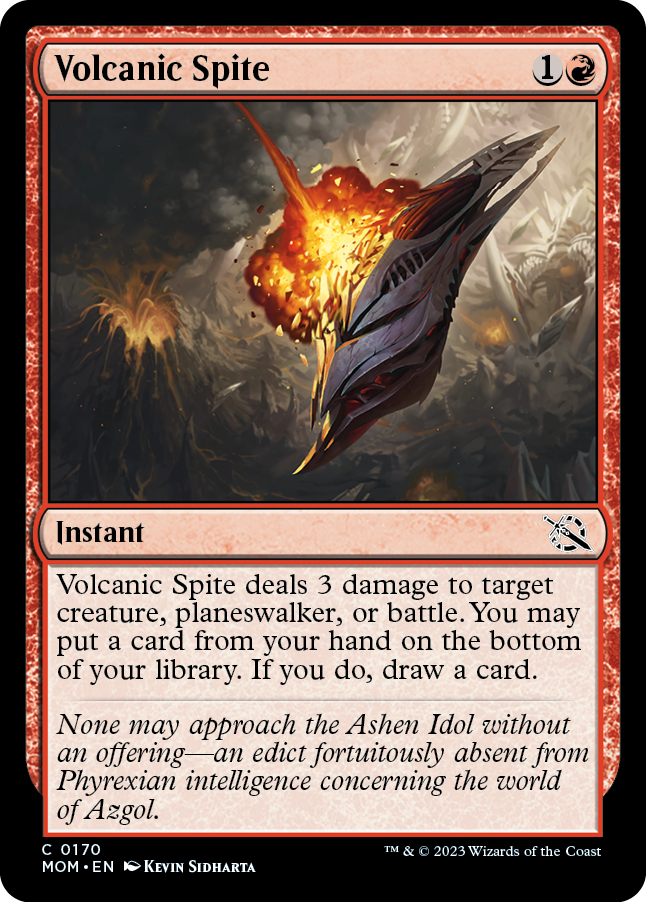
Volcanic Spite
{1}{R}
Instant
Volcanic Spite deals 3 damage to target creature, planeswalker, or battle. You may put a card from your hand on the bottom of your library. If you do, draw a card.
- If the target creature, planeswalker, or battle is an illegal target at the time Volcanic Spite tries to resolve, it won't resolve and none of its effects will happen. You won't get to put a card from your hand on the bottom of your library, and you won't draw a card.
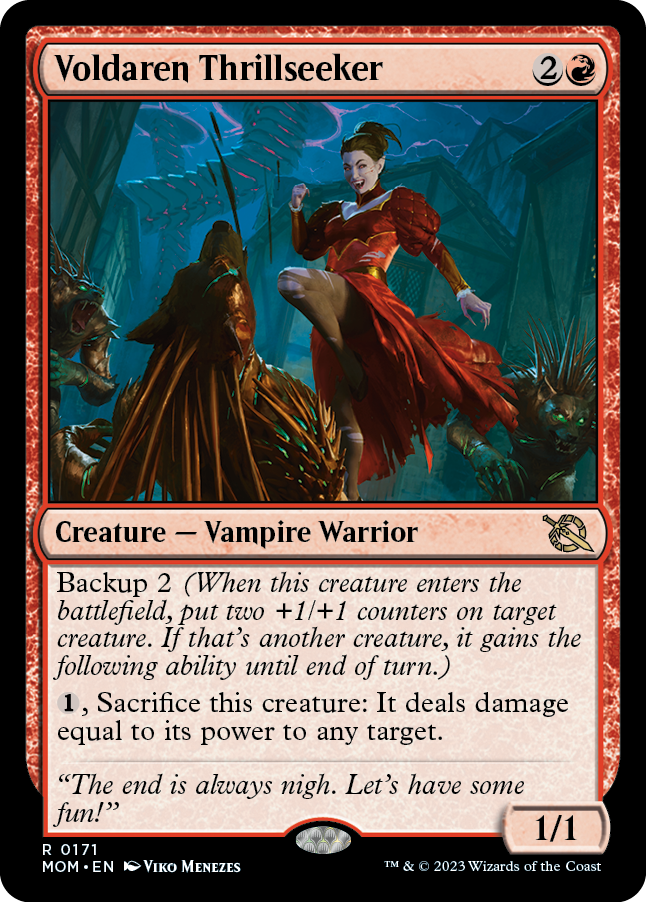
Voldaren Thrillseeker
{2}{R}
Creature — Vampire Warrior
1/1
Backup 2 (When this creature enters the battlefield, put two +1/+1 counters on target creature. If that's another creature, it gains the following ability until end of turn.)
{1}, Sacrifice this creature: It deals damage equal to its power to any target.
- Use the creature's power as it last existed on the battlefield to determine how much damage it deals to the target.
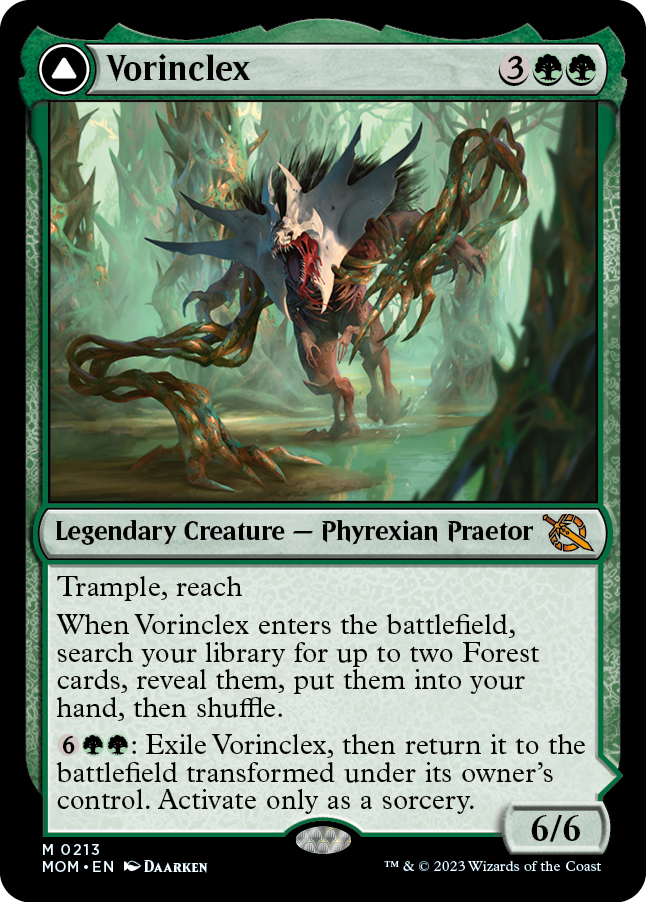

Vorinclex
{3}{G}{G}
Legendary Creature — Phyrexian Praetor
6/6
Trample, reach
When Vorinclex enters the battlefield, search your library for up to two Forest cards, reveal them, put them into your hand, then shuffle.
{6}{G}{G}: Exile Vorinclex, then return it to the battlefield transformed under its owner's control. Activate only as a sorcery.
////
The Grand Evolution
Enchantment — Saga
(As this Saga enters and after your draw step, add a lore counter.)
I — Mill ten cards. Put up to two creature cards from among the milled cards onto the battlefield.
II — Distribute seven +1/+1 counters among any number of target creatures you control.
III — Until end of turn, creatures you control gain "{1}: This creature fights target creature you don't control." Exile The Grand Evolution, then return it to the battlefield (front face up).
- The Forest cards you find can be any land cards with the Forest land type, not just ones named Forest.
- You choose how many targets the chapter II ability of The Grand Evolution has and how the counters are distributed as you put the ability onto the stack. Each target must receive at least one counter.
- If some of the creatures are illegal targets as the chapter II ability tries to resolve, the original distribution of counters still applies and the counters that would have been put on the illegal targets are lost. They won't be put instead on a legal target.
- The set of creatures that gain the activated fight ability is determined as the chapter III ability resolves. Creatures you begin to control later in the turn and noncreature permanents that become creatures later in the turn won't gain that ability. Notably, Vorinclex won't be back on the battlefield yet, so it won't gain the ability either.
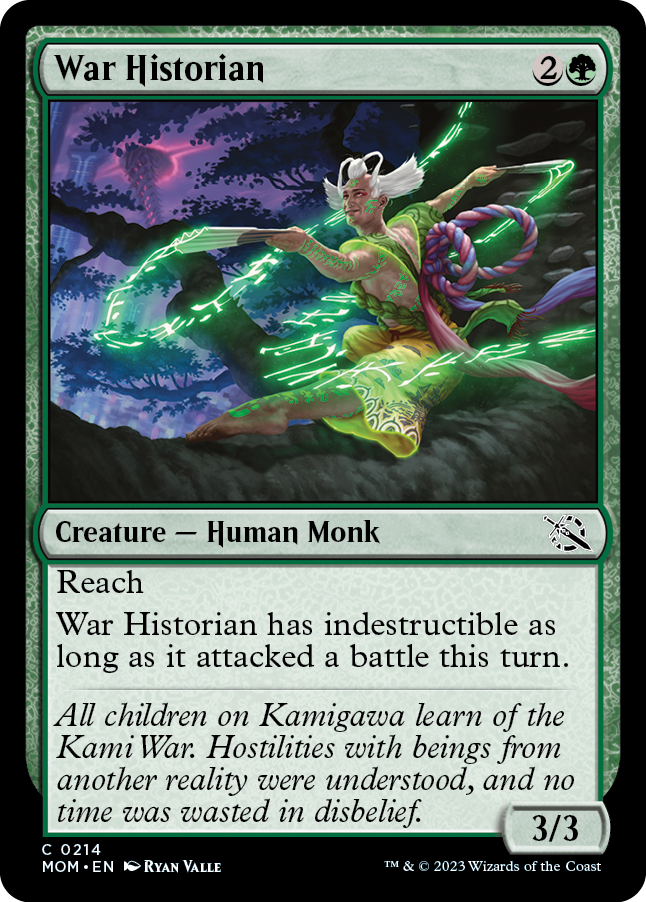
War Historian
{2}{G}
Creature — Human Monk
3/3
Reach
War Historian has indestructible as long as it attacked a battle this turn.
- War Historian's last ability starts to apply as soon as it's declared as an attacker that's attacking a battle, and it applies for the entire turn. It doesn't matter what happens to the battle after that point.
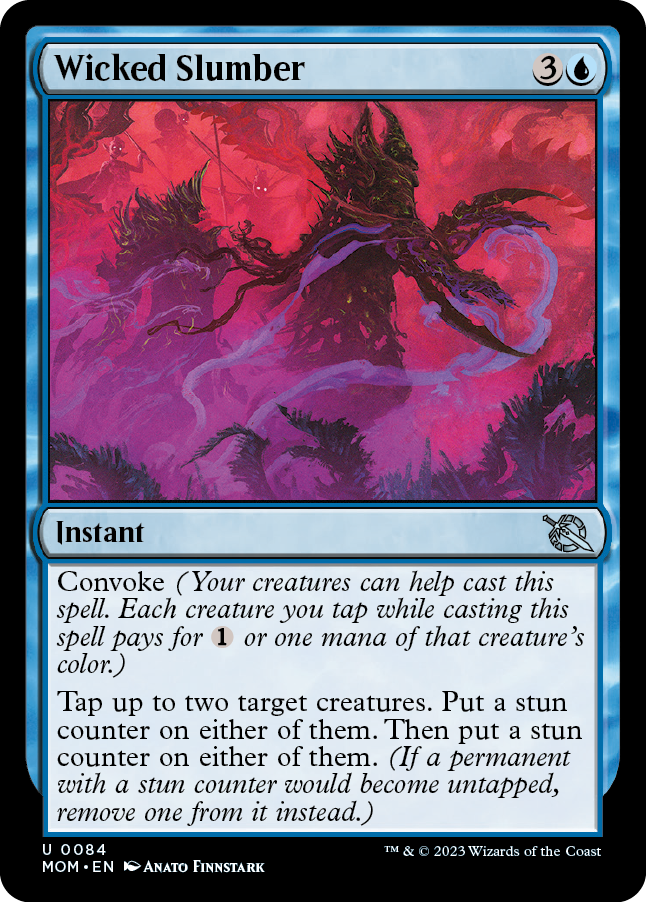
Wicked Slumber
{3}{U}
Instant
Convoke (Your creatures can help cast this spell. Each creature you tap while casting this spell pays for {1} or one mana of that creature's color.)
Tap up to two target creatures. Put a stun counter on either of them. Then put a stun counter on either of them. (If a permanent with a stun counter would become untapped, remove one from it instead.)
- Wicked Slumber can target creatures that are already tapped.
- The two stun counters can end up on the same creature, or they can each end up on a different one of the target creatures.
- If you choose two target creatures, but one of them is an illegal target as Wicked Slumber resolves, the illegal target will be unaffected. You'll put both stun counters on the remaining legal target. If both targets become illegal, Wicked Slumber won't resolve at all.
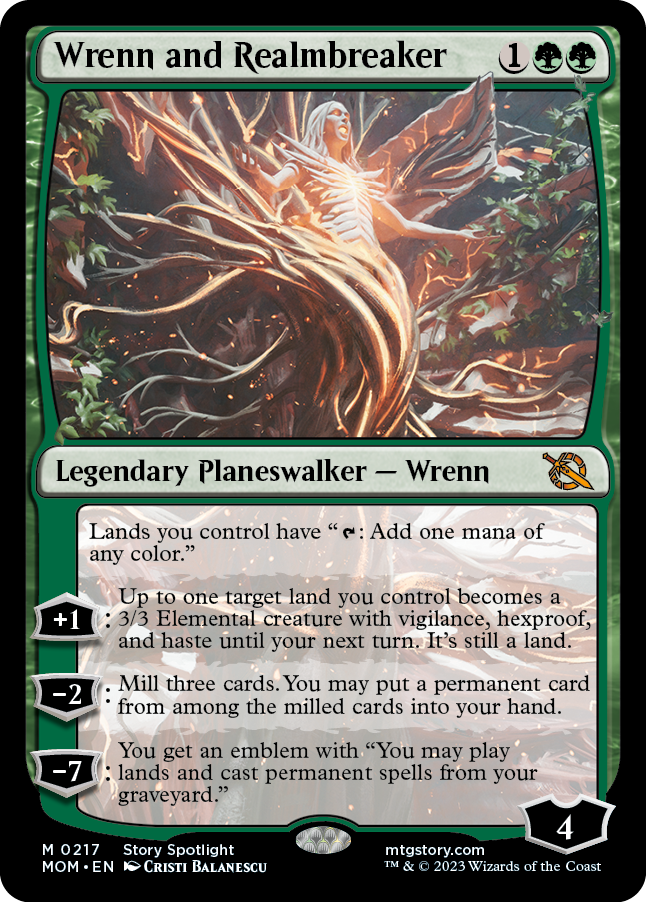
Wrenn and Realmbreaker
{1}{G}{G}
Legendary Planeswalker — Wrenn
4
Lands you control have "{T}: Add one mana of any color."
+1: Up to one target land you control becomes a 3/3 Elemental creature with vigilance, hexproof, and haste until your next turn. It's still a land.
−2: Mill three cards. You may put a permanent card from among the milled cards into your hand.
−7: You get an emblem with "You may play lands and cast permanent spells from your graveyard."
- The lands you play and spells you cast from your graveyard follow the usual timing restrictions, and you must pay any costs for spells you cast.
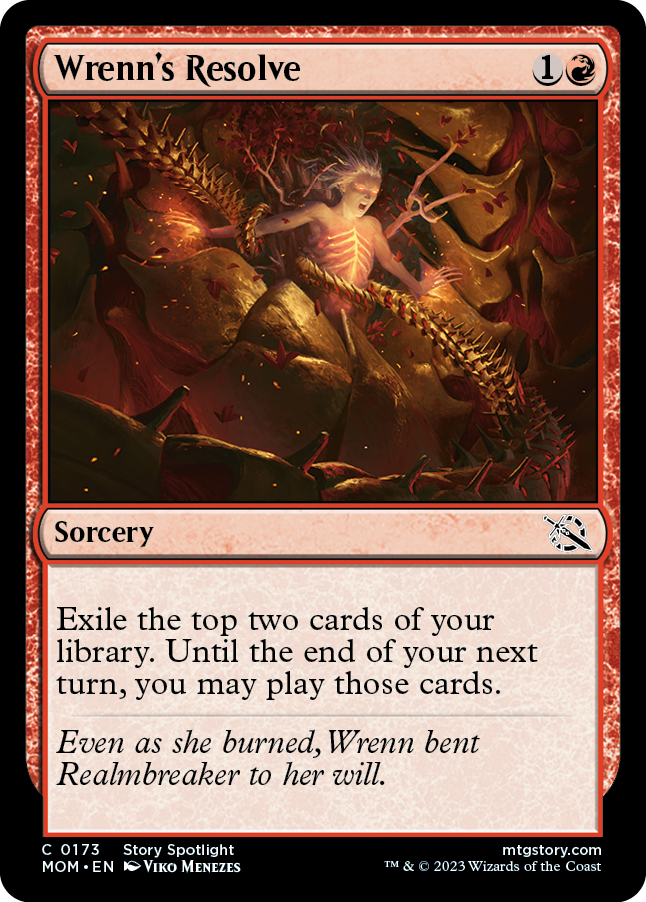
Wrenn's Resolve
{1}{R}
Sorcery
Exile the top two cards of your library. Until the end of your next turn, you may play those cards.
- The cards you play from exile follow the usual timing restrictions, and you must pay any costs for spells you cast.
- Any cards you don't play will remain in exile.
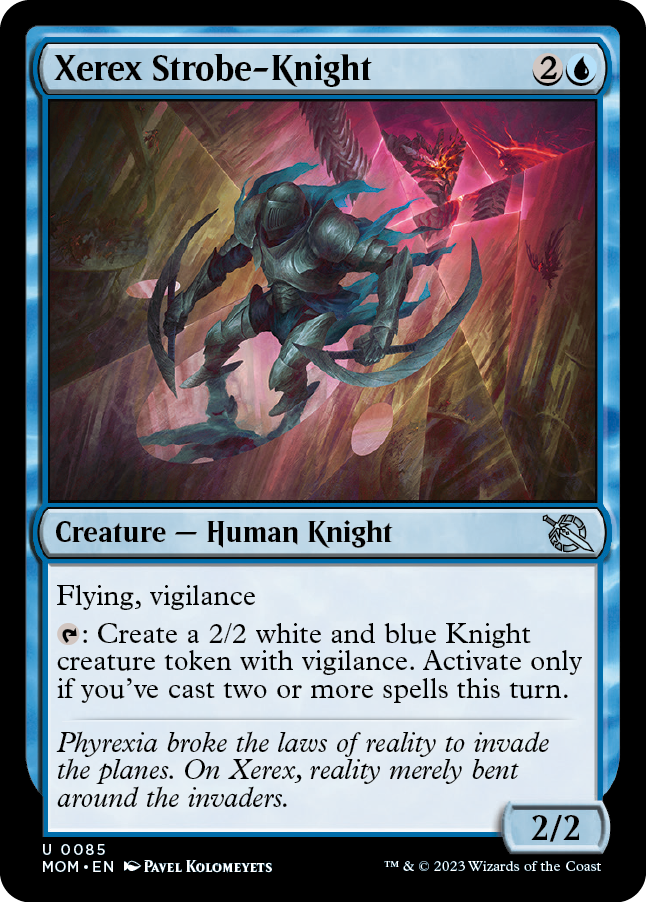
Xerex Strobe-Knight
{2}{U}
Creature — Human Knight
2/2
Flying, vigilance
{T}: Create a 2/2 white and blue Knight creature token with vigilance. Activate only if you've cast two or more spells this turn.
- Xerex Strobe-Knight will count any spells you've cast this turn. It doesn't matter if those spells resolved, didn't resolve, were countered, or are still on the stack.
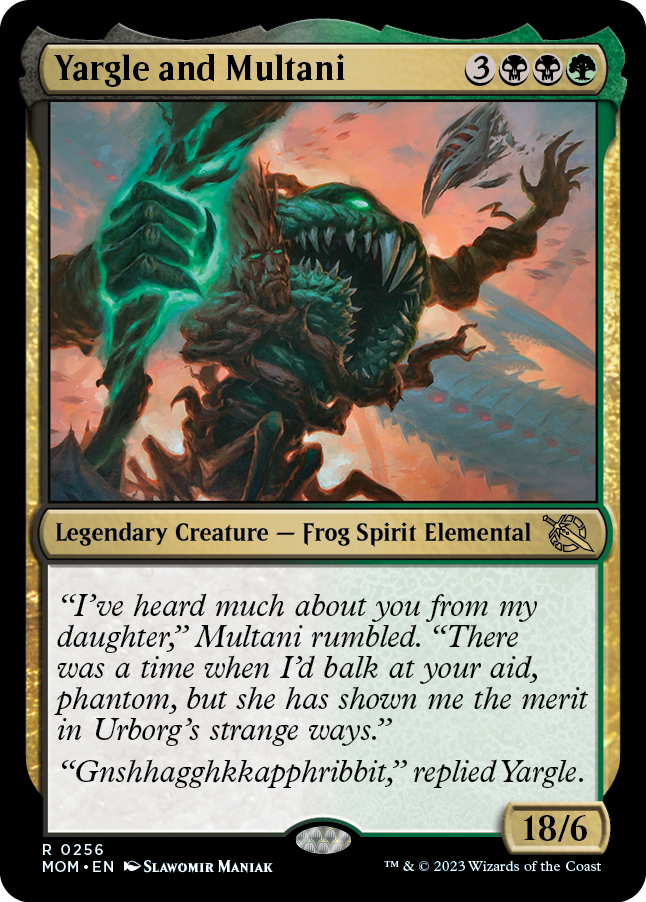
Yargle and Multani
{3}{B}{B}{G}
Legendary Creature — Frog Spirit Elemental
18/6
- Ribbit.
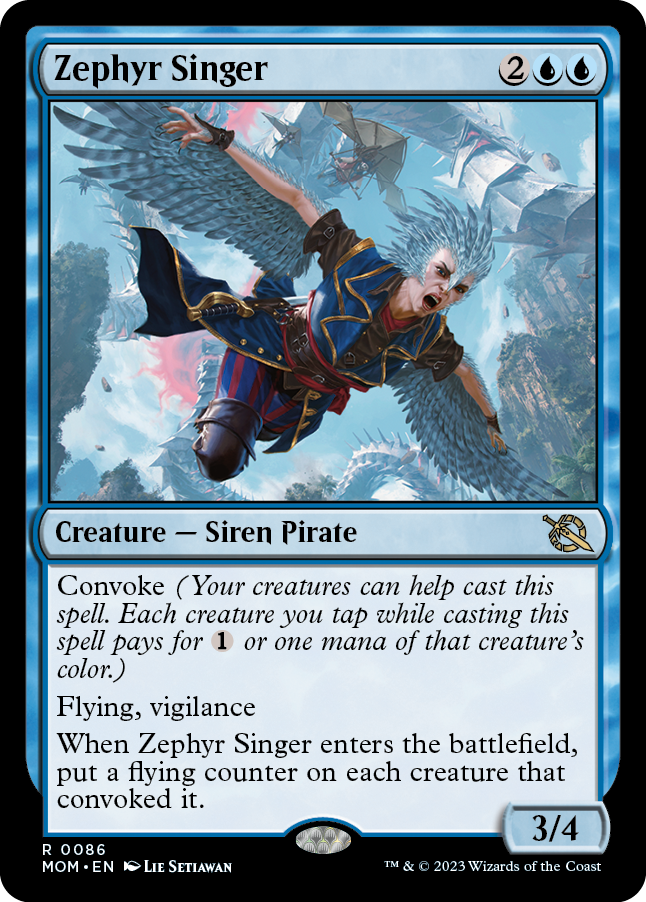
Zephyr Singer
{2}{U}{U}
Creature — Siren Pirate
3/4
Convoke (Your creatures can help cast this spell. Each creature you tap while casting this spell pays for {1} or one mana of that creature's color.)
Flying, vigilance
When Zephyr Singer enters the battlefield, put a flying counter on each creature that convoked it.
- You can't tap more creatures to convoke Zephyr Singer than is necessary to pay for the spell. In most cases, this means four creatures. However, if there are any additional costs to cast Zephyr Singer, you may use convoke to pay those additional costs as well.
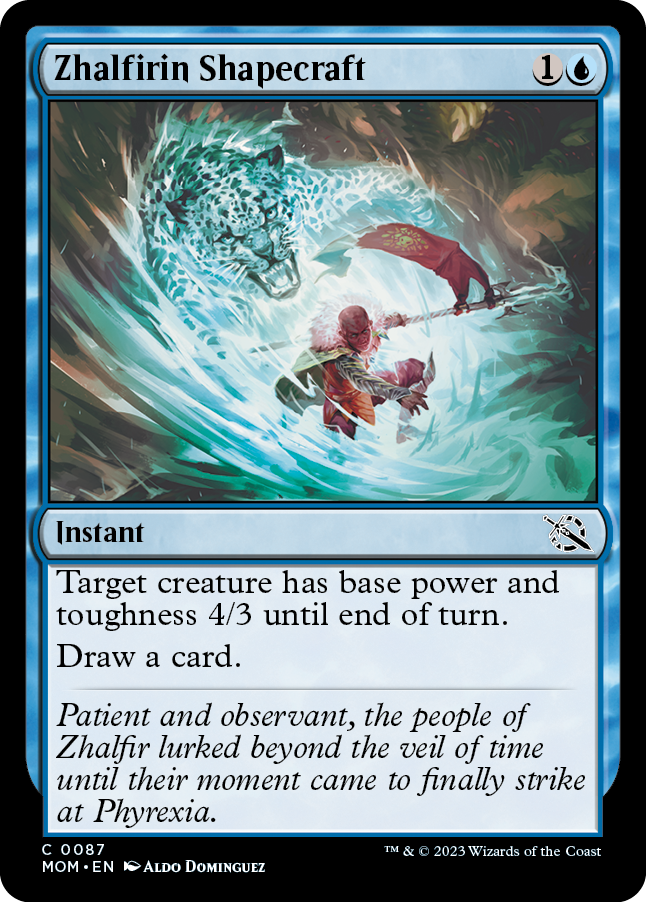
Zhalfirin Shapecraft
{1}{U}
Instant
Target creature has base power and toughness 4/3 until end of turn.
Draw a card.
- Zhalfirin Shapecraft overwrites all previous effects that set the creature's base power and toughness to specific values. Any power- or toughness-setting effects that start to apply after the ability resolves will overwrite this effect.
- Effects that modify a creature's power and/or toughness, such as the effect of Titanic Growth, will apply to the creature no matter when they started to take effect. The same is true for any counters that change its power and/or toughness and effects that switch its power and toughness.
- Zhalfirin Shapecraft doesn't affect the creature's card types, creature types, or abilities.
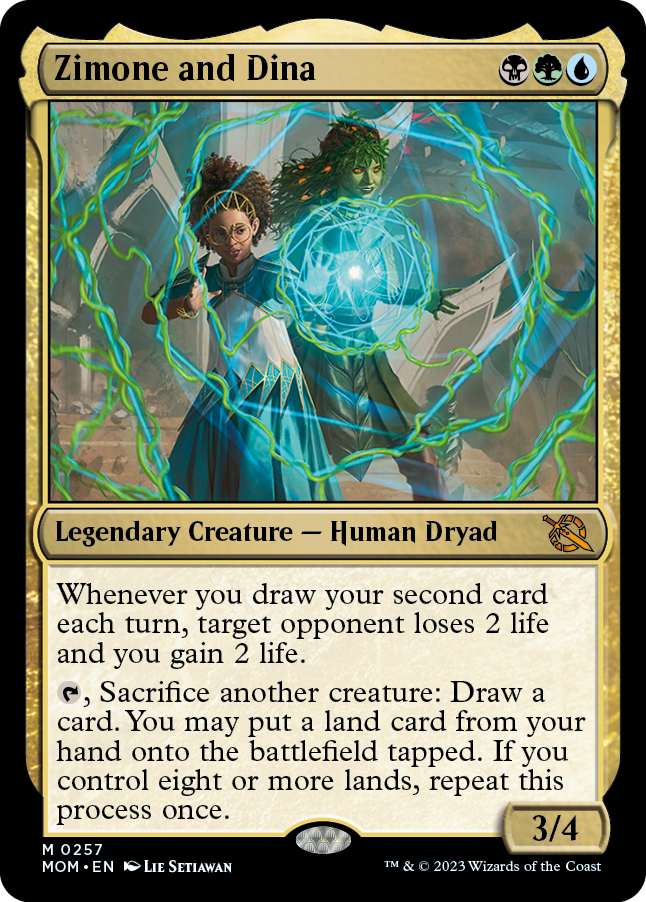
Zimone and Dina
{B}{G}{U}
Legendary Creature — Human Dryad
3/4
Whenever you draw your second card each turn, target opponent loses 2 life and you gain 2 life.
{T}, Sacrifice another creature: Draw a card. You may put a land card from your hand onto the battlefield tapped. If you control eight or more lands, repeat this process once.
- Zimone and Dina doesn't need to have been under your control when the first card is drawn for its ability to trigger. As long as you control it when you draw your second card in a turn, that ability will trigger.
- For the activated ability, repeating the process means the entire effect, but not the cost. You don't have to (and, in fact, can't) sacrifice another creature. You'll draw another card, then you may put another land card from your hand onto the battlefield tapped. As this is your second time through the process, the ability will finish resolving.
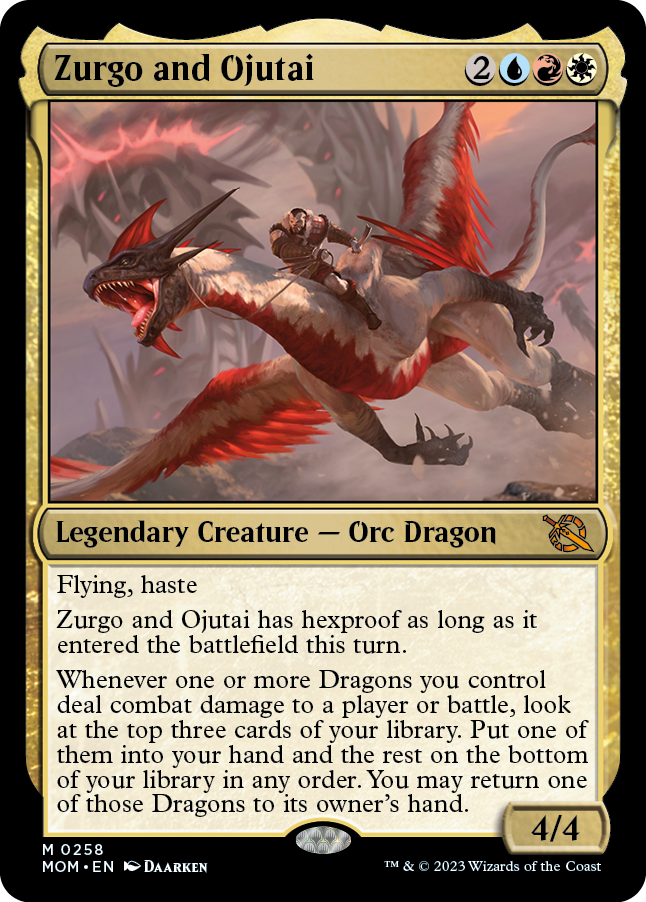
Zurgo and Ojutai
{2}{U}{R}{W}
Legendary Creature — Orc Dragon
4/4
Flying, haste
Zurgo and Ojutai has hexproof as long as it entered the battlefield this turn.
Whenever one or more Dragons you control deal combat damage to a player or battle, look at the top three cards of your library. Put one of them into your hand and the rest on the bottom of your library in any order. You may return one of those Dragons to its owner's hand.
- The triggered ability will trigger once for each player or battle dealt combat damage by Dragons you control, no matter how many Dragons were involved. For example, if you attack a player with three Dragons and a battle that player protects with two Dragons, and they all connect, the ability will trigger twice.
- Because creatures with first strike deal combat damage before creatures without first strike, it's also possible to have the ability trigger twice in the same combat by your Dragons dealing combat damage to one player at different times. This can also happen if an attacking Dragon you control has double strike.
- You choose whether to return one of the Dragons that dealt combat damage to the player or battle as the triggered ability is resolving. This doesn't target any of those Dragons.
MARCH OF THE MACHINE JUMPSTART CARD-SPECIFIC NOTES
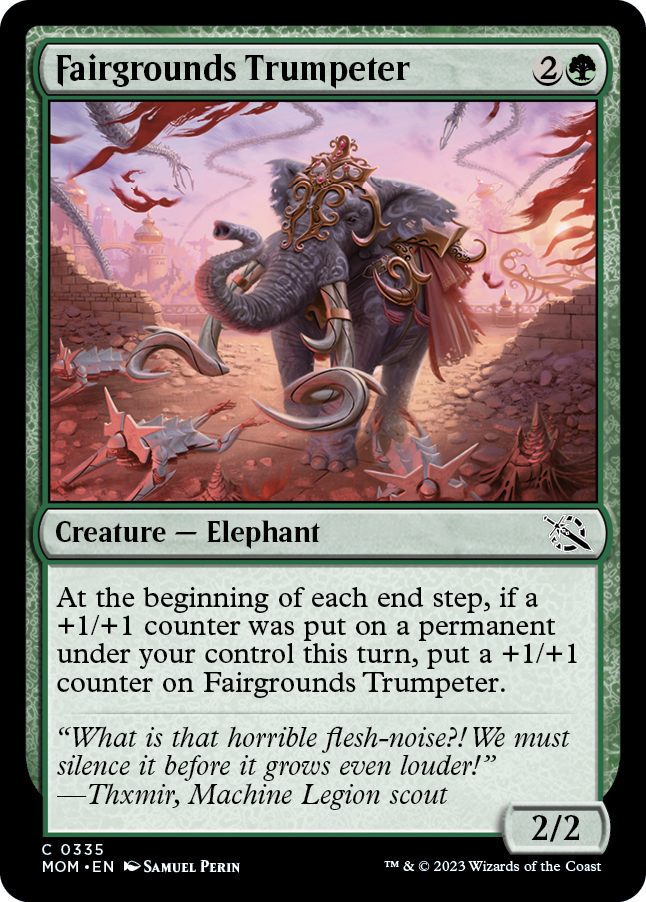
Fairgrounds Trumpeter
{2}{G}
Creature — Elephant
2/2
At the beginning of each end step, if a +1/+1 counter was put on a permanent under your control this turn, put a +1/+1 counter on Fairgrounds Trumpeter.
- Fairgrounds Trumpeter's ability triggers if, at any point during this turn, a +1/+1 counter was placed on a permanent that you controlled as the counter was placed. It doesn't matter whether you still control the permanent or whether it still has a counter.
- If a +1/+1 counter hasn't been placed yet at the moment an end step begins, Fairgrounds Trumpeter's ability doesn't trigger at all. If another ability triggers during the end step and puts a +1/+1 counter on a permanent you control, you won't put an additional +1/+1 counter on Fairgrounds Trumpeter.
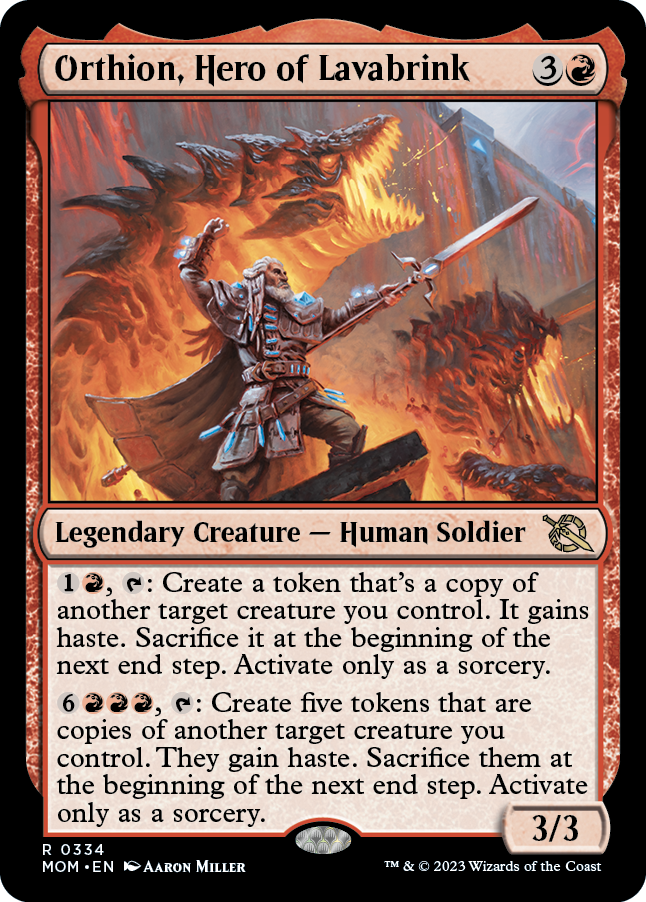
Orthion, Hero of Lavabrink
{3}{R}
Legendary Creature — Human Soldier
3/3
{1}{R}, {T}: Create a token that's a copy of another target creature you control. It gains haste. Sacrifice it at the beginning of the next end step. Activate only as a sorcery.
{6}{R}{R}{R}, {T}: Create five tokens that are copies of another target creature you control. They gain haste. Sacrifice them at the beginning of the next end step. Activate only as a sorcery.
- The tokens each copy exactly what was printed on the original creature and nothing else (unless that creature is copying something else or is a token; see below). It doesn't copy whether that creature is tapped or untapped, whether it has any counters on it or Auras and Equipment attached to it, or any non-copy effects that have changed its power, toughness, types, color, and so on.
- If the copied creature has {X} in its mana cost, X is 0.
- If the copied creature is a token, the token that's created copies the original characteristics of that token as stated by the effect that created that token.
- If the copied creature is copying something else, then the token enters the battlefield as whatever that creature copied.
- Any enters-the-battlefield abilities of the copied creature will trigger when the token enters the battlefield. Any "as [this creature] enters the battlefield" or "[this creature] enters the battlefield with" abilities of the copied creature will also work.

Referee Squad
{2}{U}
Creature — Homunculus
2/2
Convoke (Your creatures can help cast this spell. Each creature you tap while casting this spell pays for {1} or one mana of that creature's color.)
Vigilance
When Referee Squad enters the battlefield, tap target creature an opponent controls and put a stun counter on it. (If a permanent with a stun counter would become untapped, remove one from it instead.)
- Referee Squad's enters-the-battlefield ability can target a creature that's already tapped.
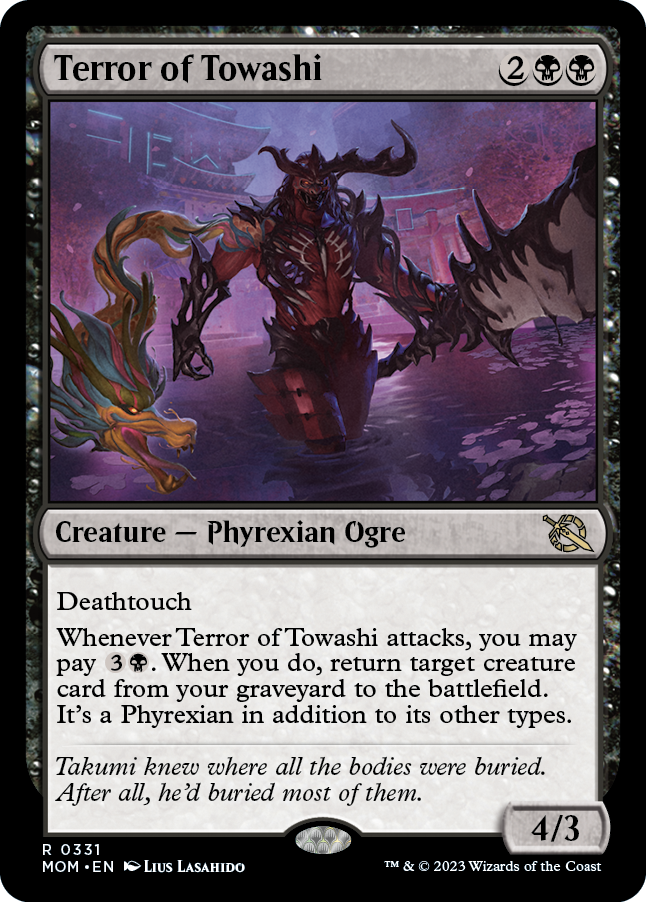
Terror of Towashi
{2}{B}{B}
Creature — Phyrexian Ogre
4/3
Deathtouch
Whenever Terror of Towashi attacks, you may pay {3}{B}. When you do, return target creature card from your graveyard to the battlefield. It's a Phyrexian in addition to its other types.
- Terror of Towashi's triggered ability triggers and goes on the stack without a target. If you pay {3}{B}, the second "reflexive" triggered ability will trigger. You'll choose the target creature card for that second ability at that time.
- The effect making the creature a Phyrexian doesn't have a duration. It lasts until the creature leaves the battlefield.
- If the creature stops being a creature after the ability has resolved, it will also stop being a Phyrexian until it becomes a creature again, if applicable.
MARCH OF THE MACHINE COMMANDER CARD-SPECIFIC NOTES
New Ability Word: Will of the Planeswalkers
Among the new Commander cards is a cycle of sorceries aimed at Planechase games that has players vote for what happens next. One path leads to the next world. One path leads to chaos. Which will your game be walking?
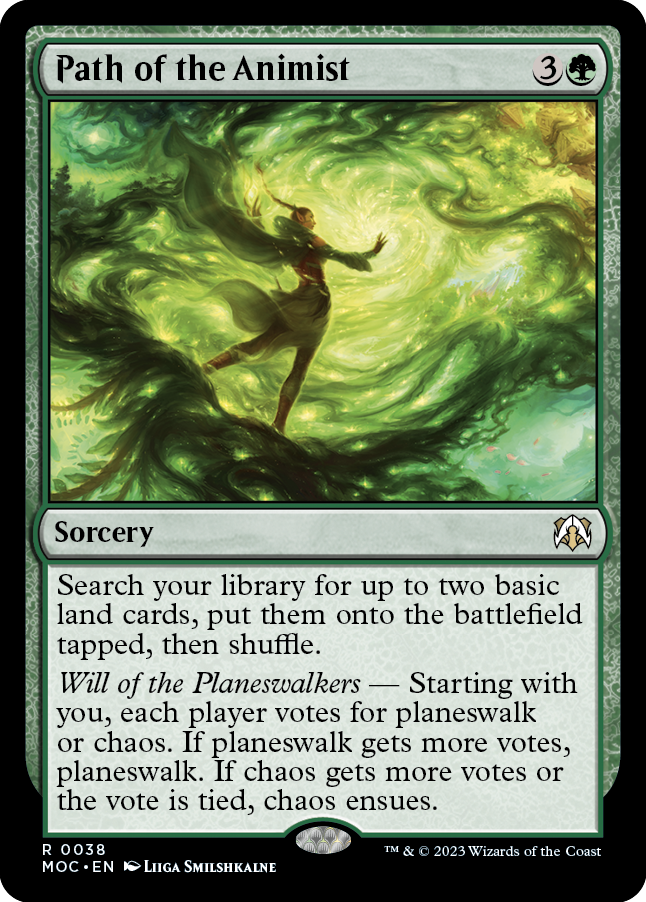
Path of the Animist
{3}{G}
Sorcery
Search your library for up to two basic land cards, put them onto the battlefield tapped, then shuffle.
Will of the Planeswalkers — Starting with you, each player votes for planeswalk or chaos. If planeswalk gets more votes, planeswalk. If chaos gets more votes or the vote is tied, chaos ensues.
- Because the votes are cast in turn order, each player will know the votes of players who voted beforehand.
- You must vote for one of the available options. You can't abstain.
- No player votes until the spell resolves. Any responses must be made without knowing the outcome of the vote.
- Players can't do anything after they finish voting but before the spell finishes resolving.
- If you somehow cast one of these cards while you aren't the planar controller (that is, while it's not your turn), and planeswalk gets more votes, it's the planar controller who planeswalks, not you.
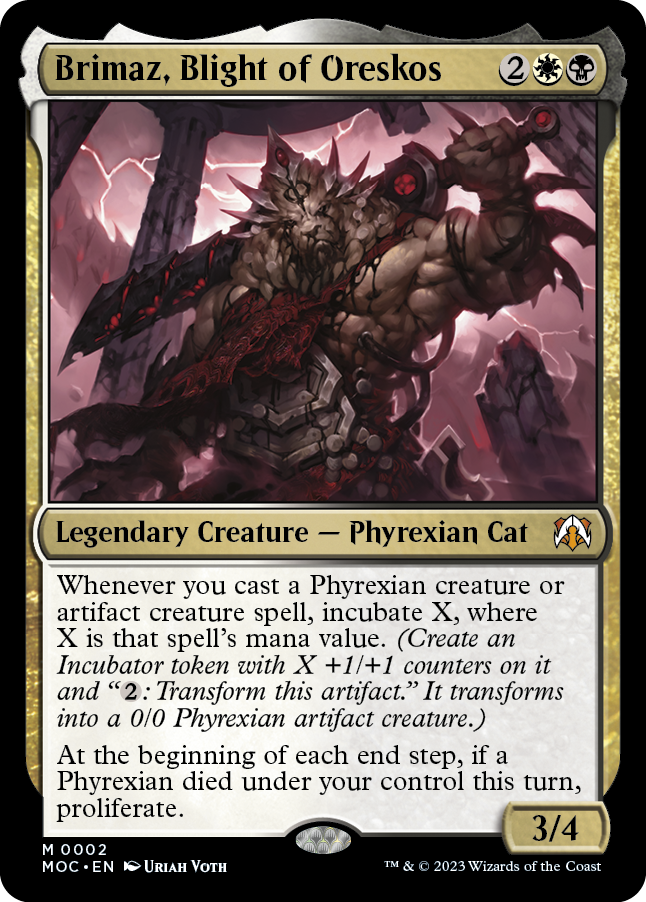
Brimaz, Blight of Oreskos
{2}{W}{B}
Legendary Creature — Phyrexian Cat
3/4
Whenever you cast a Phyrexian creature or artifact creature spell, incubate X, where X is that spell's mana value. (Create an Incubator token with X +1/+1 counters on it and "{2}: Transform this artifact." It transforms into a 0/0 Phyrexian artifact creature.)
At the beginning of each end step, if a Phyrexian died under your control this turn, proliferate.
- If you cast a Phyrexian artifact creature spell, Brimaz's first ability will trigger only once.
- Brimaz's last ability will check as the end step starts to see if a Phyrexian died under your control this turn. If one did not, the ability won't trigger at all.
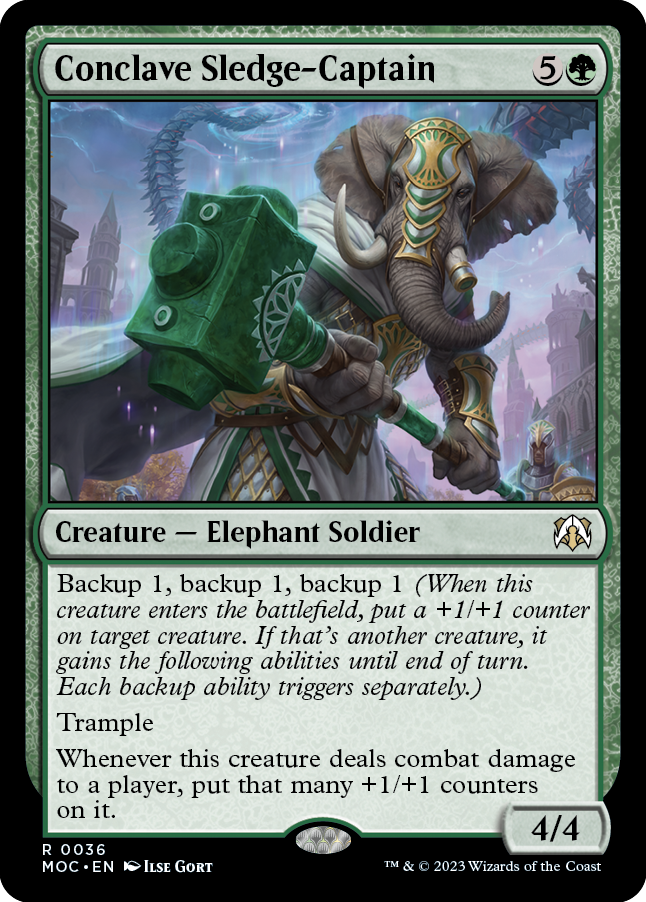
Conclave Sledge-Captain
{5}{G}
Creature — Elephant Soldier
4/4
Backup 1, backup 1, backup 1 (When this creature enters the battlefield, put a +1/+1 counter on target creature. If that's another creature, it gains the following abilities until end of turn. Each backup ability triggers separately.)
Trample
Whenever this creature deals combat damage to a player, put that many +1/+1 counters on it.
- If the same creature is the target of more than one of Conclave Sledge-Captain's backup abilities, it will get more than one instance of its triggered ability. Each of those triggered abilities triggers separately. If the creature deals combat damage to a player, it will get that many +1/+1 counters more than once. (It will also have trample more than once, but that's way less interesting.)

Conjurer's Mantle
{1}{W}
Artifact — Equipment
Equipped creature gets +1/+1 and has vigilance.
Whenever equipped creature attacks, look at the top six cards of your library. You may reveal a card that shares a creature type with that creature from among them and put it into your hand. Put the rest on the bottom of your library in a random order.
Equip {1}
- A creature "shares a creature type" with the equipped creature if they have at least one creature type in common.
- If the equipped creature is no longer on the battlefield as the triggered ability resolves, use its creature types from when it was last on the battlefield.

Cutthroat Negotiator
{2}{U}{R}
Creature — Orc Pirate
4/3
Parley — Whenever Cutthroat Negotiator attacks, each player reveals the top card of their library. For each nonland card revealed this way, you create a tapped Treasure token. Then each player draws a card.
- Except in some very unusual cases, the card each player reveals is the one they'll draw.
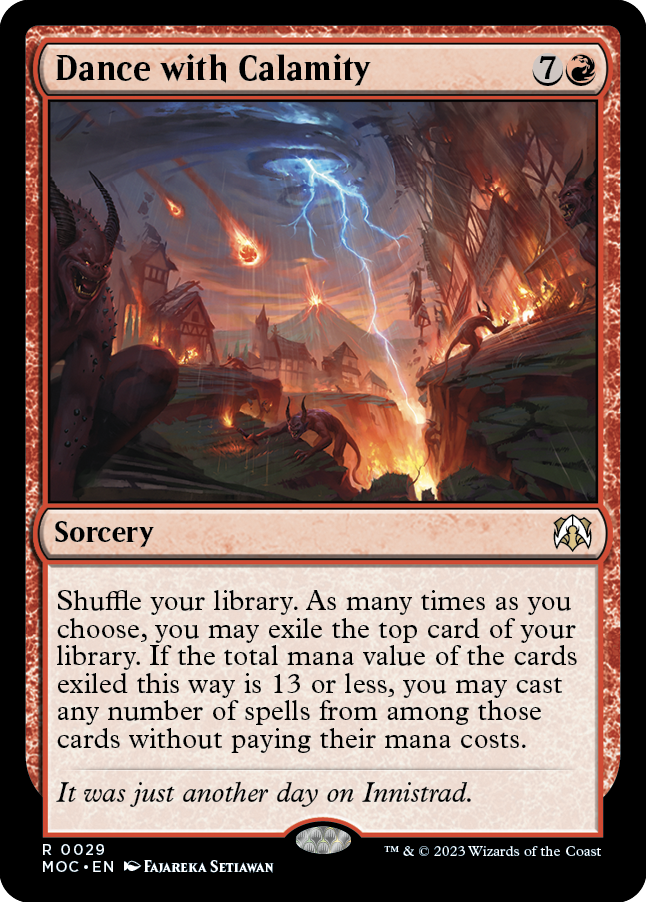
Dance with Calamity
{7}{R}
Sorcery
Shuffle your library. As many times as you choose, you may exile the top card of your library. If the total mana value of the cards exiled this way is 13 or less, you may cast any number of spells from among those cards without paying their mana costs.
- You can look at each card you exile before deciding whether to push your luck or stop.
- If you danced with calamity a little too closely, and the total mana value of the exiled cards is greater than 13, the cards you exiled will remain there and you won't get to cast any of them.
- If you cast any of the exiled cards, you do so as part of the resolution of the spell. You can't wait to cast them later in the turn. Timing restrictions based on a card's type are ignored.
- If you cast a card "without paying its mana cost," you can't pay any alternative costs. You can, however, pay additional costs. If the card has any mandatory additional costs, those must be paid to cast the card.
- If an exiled card has {X} in its mana cost, you must choose 0 as the value of X when casting it without paying its mana cost.
- If you cast more than one of the exiled cards, you choose the order in which to cast them. A spell you cast this way can be the target of a later spell you cast this way. However, permanent spells cast this way won't resolve until you're done casting spells, so the permanents they become can't be the target of spells cast this way. For example, if you exile Twincast and Lightning Strike, you can cast Lightning Strike and then cast Twincast targeting it; but if you exile a creature card and an Aura card, you can't cast that Aura targeting that creature.
- Any cards not cast, including land cards, remain in exile. They can't be cast on later turns.
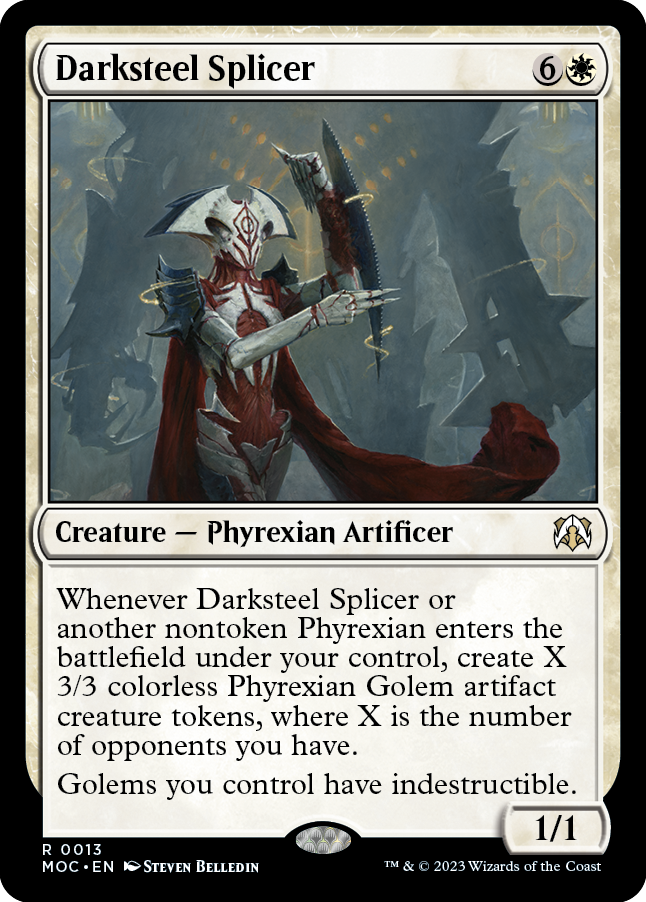
Darksteel Splicer
{6}{W}
Creature — Phyrexian Artificer
1/1
Whenever Darksteel Splicer or another nontoken Phyrexian enters the battlefield under your control, create X 3/3 colorless Phyrexian Golem artifact creature tokens, where X is the number of opponents you have.
Golems you control have indestructible.
- Because damage remains marked on a creature until the damage is removed as the turn ends, nonlethal damage dealt to a Golem you control may become lethal if Darksteel Splicer leaves the battlefield during that turn.
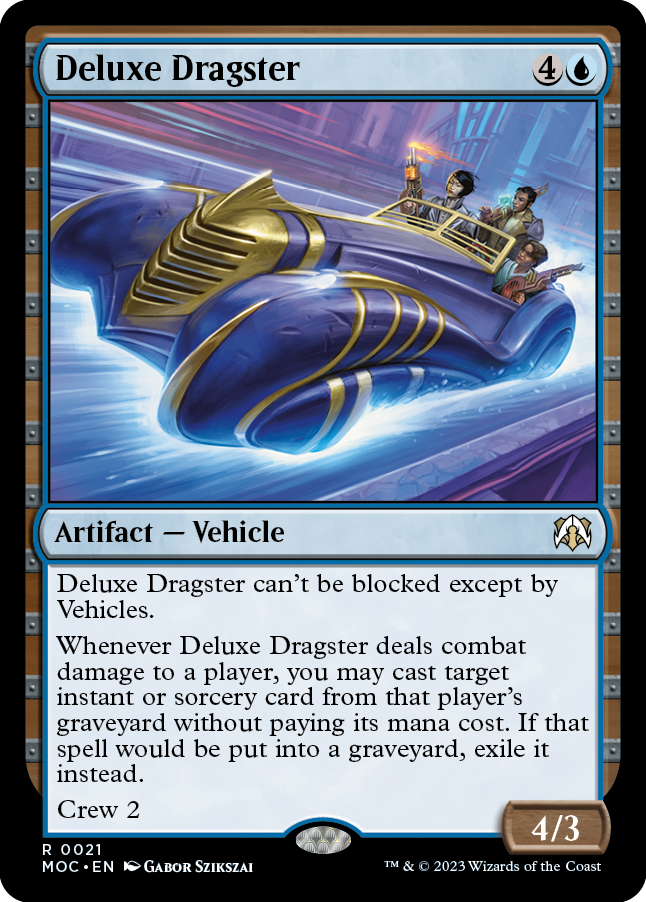
Deluxe Dragster
{4}{U}
Artifact — Vehicle
4/3
Deluxe Dragster can't be blocked except by Vehicles.
Whenever Deluxe Dragster deals combat damage to a player, you may cast target instant or sorcery card from that player's graveyard without paying its mana cost. If that spell would be put into a graveyard, exile it instead.
Crew 2
- If you cast the instant or sorcery card, you do so as part of the resolution of the triggered ability. You can't wait to cast them later in the turn. Timing restrictions based on a card's type are ignored.
- If you cast a card "without paying its mana cost," you can't pay any alternative costs. You can, however, pay additional costs. If the card has any mandatory additional costs, those must be paid to cast the card.
- If an exiled card has {X} in its mana cost, you must choose 0 as the value of X when casting it without paying its mana cost.
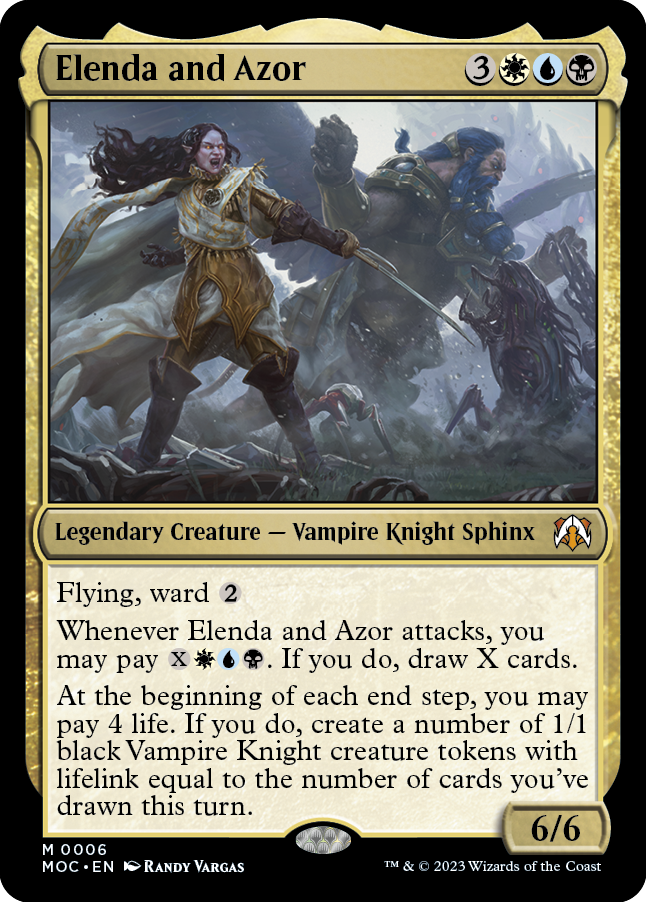
Elenda and Azor
{3}{W}{U}{B}
Legendary Creature — Vampire Knight Sphinx
6/6
Flying, ward {2}
Whenever Elenda and Azor attacks, you may pay {X}{W}{U}{B}. If you do, draw X cards.
At the beginning of each end step, you may pay 4 life. If you do, create a number of 1/1 black Vampire Knight creature tokens with lifelink equal to the number of cards you've drawn this turn.
- You choose the value of X as the first triggered ability resolves.
- As the last ability resolves, you choose whether to pay 4 life. You can't pay it more than once to create additional Vampire Knight tokens.
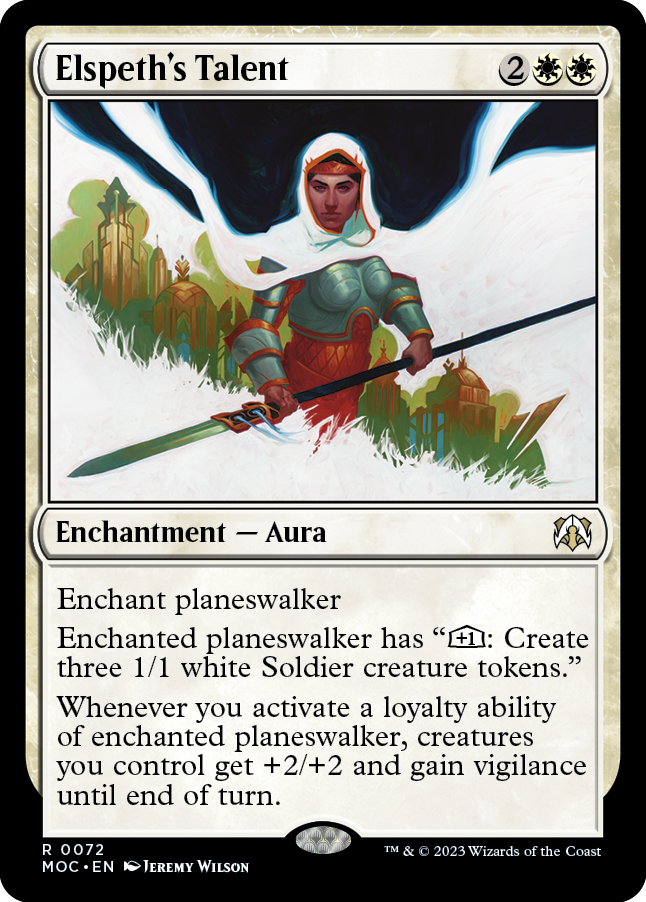
Elspeth's Talent
{2}{W}{W}
Enchantment — Aura
Enchant planeswalker
Enchanted planeswalker has "[+1]: Create three 1/1 white Soldier creature tokens."
Whenever you activate a loyalty ability of enchanted planeswalker, creatures you control get +2/+2 and gain vigilance until end of turn.
- You can activate one loyalty ability of each planeswalker you control during each of your turns, whether that ability is one it always has or the one it gains because of Elspeth's Talent.
- The set of creatures affected by Elspeth's Talent's last ability is determined as the ability resolves. Creatures you begin to control later in the turn and noncreature permanents that become creatures later in the turn won't get +2/+2 and gain vigilance.
- The last ability will resolve before the loyalty ability that caused it to trigger. Notably, if that loyalty ability creates creature tokens, those creatures won't be on the battlefield yet to get +2/+2 and gain vigilance.

Emergent Woodwurm
{6}{G}
Creature — Wurm
4/4
Backup 3 (When this creature enters the battlefield, put three +1/+1 counters on target creature. If that's another creature, it gains the following ability until end of turn.)
Whenever this creature attacks, look at the top X cards of your library, where X is its power. You may put a permanent card with mana value X or less from among them onto the battlefield. Put the rest on the bottom of your library in a random order.
- Use the power of the creature as the triggered ability resolves to determine the value of X. If the creature is no longer on the battlefield at that time, use its power from when it was last on the battlefield.

Excise the Imperfect
{1}{W}{W}
Instant
Exile target nonland permanent. Its controller incubates X, where X is its mana value. (They create an Incubator token with X +1/+1 counters on it and "{2}: Transform this artifact." It transforms into a 0/0 Phyrexian artifact creature.)
- If the nonland permanent is an illegal target at the time Excise the Imperfect tries to resolve, it won't resolve and none of its effects will happen. Its controller won't incubate.

Filigree Vector
{3}{W}
Artifact Creature — Phyrexian Construct
1/1
When Filigree Vector enters the battlefield, put a +1/+1 counter on each of any number of target creatures and a charge counter on each of any number of target artifacts.
{1}, {T}, Sacrifice another artifact: Proliferate. (Choose any number of permanents and/or players, then give each another counter of each kind already there.)
- You may choose an artifact creature as a target for both parts of the triggered ability. It will get a +1/+1 counter and a charge counter.
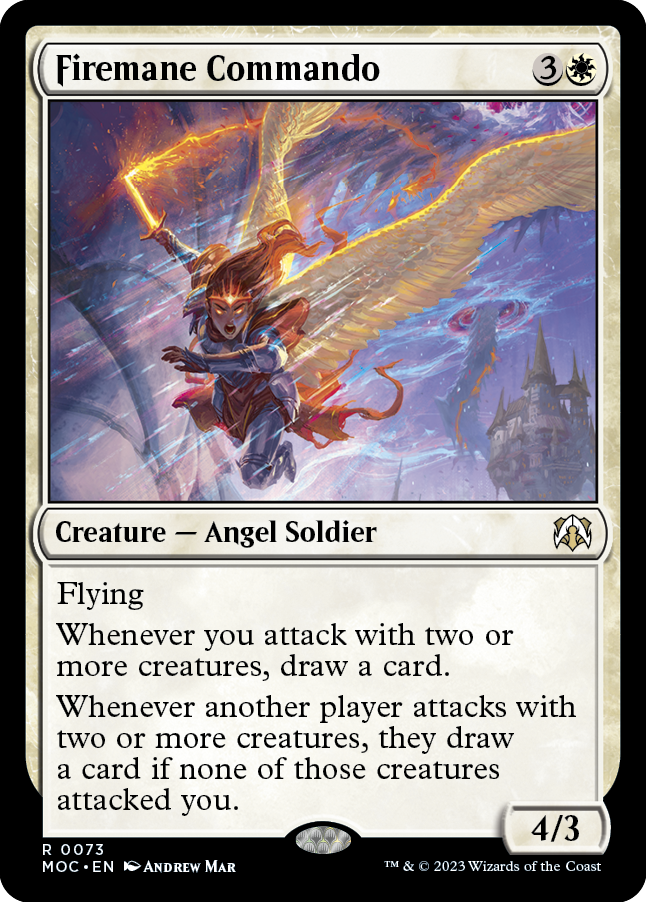
Firemane Commando
{3}{W}
Creature — Angel Soldier
4/3
Flying
Whenever you attack with two or more creatures, draw a card.
Whenever another player attacks with two or more creatures, they draw a card if none of those creatures attacked you.
- For both triggered abilities, once the ability triggers, it doesn't matter what happens to the attacking creatures in response.
- The last triggered ability cares only that none of the attacking creatures attacked you. The other player will draw a card if they attacked a planeswalker you control or a battle you protect with two or more creatures, for example.
- No matter how many creatures another player attacks with, Firemane Commando's last ability will look at all of them to make sure none of them attacked you. If any of them did, the player won't draw a card.

Flockchaser Phantom
{4}{W}{U}
Creature — Spirit
5/5
Convoke (Your creatures can help cast this spell. Each creature you tap while casting this spell pays for {1} or one mana of that creature's color.)
Flying, vigilance
Whenever Flockchaser Phantom attacks, the next spell you cast this turn has convoke.
- If the next spell you cast after Flockchaser Phantom's ability resolves already has convoke, giving it convoke again doesn't have any real benefit. Tapping a creature you control will still pay for only {1} or one mana of that creature's color.
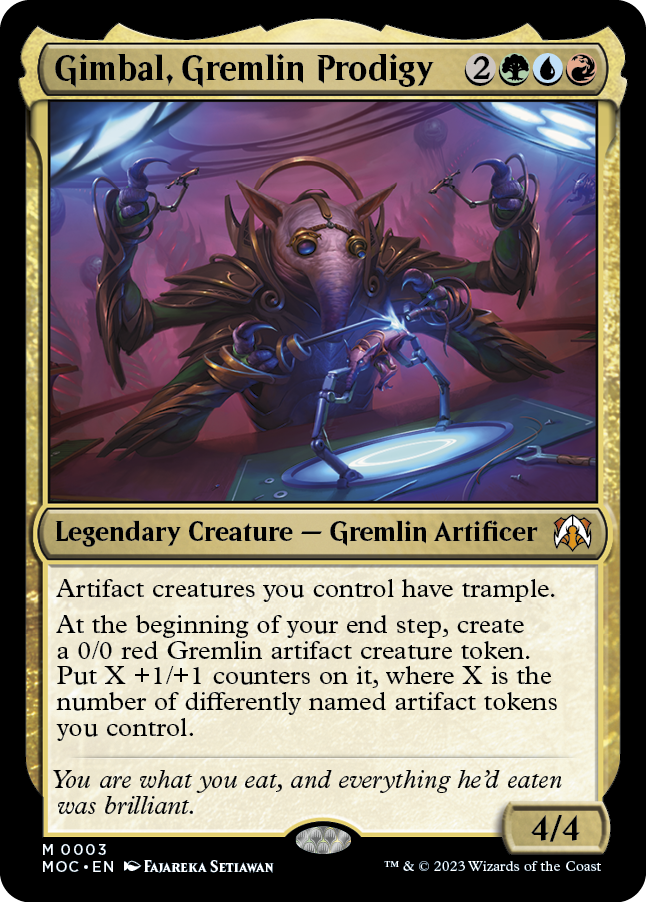
Gimbal, Gremlin Prodigy
{2}{G}{U}{R}
Legendary Creature — Gremlin Artificer
4/4
Artifact creatures you control have trample.
At the beginning of your end step, create a 0/0 red Gremlin artifact creature token. Put X +1/+1 counters on it, where X is the number of differently named artifact tokens you control.
- To determine the number of differently named artifact tokens you control, count each artifact token you control once, but only if its English name isn't exactly the same as another artifact token you've already counted this way.
- A token's name is its subtypes plus the word "Token" unless it's copying another object or it was given a specific name by the effect that created it. For example, the tokens created by Gimbal's last ability are named "Gremlin Token." These tokens have the same name as the 2/2 red Gremlin creature tokens created by Release the Gremlins.
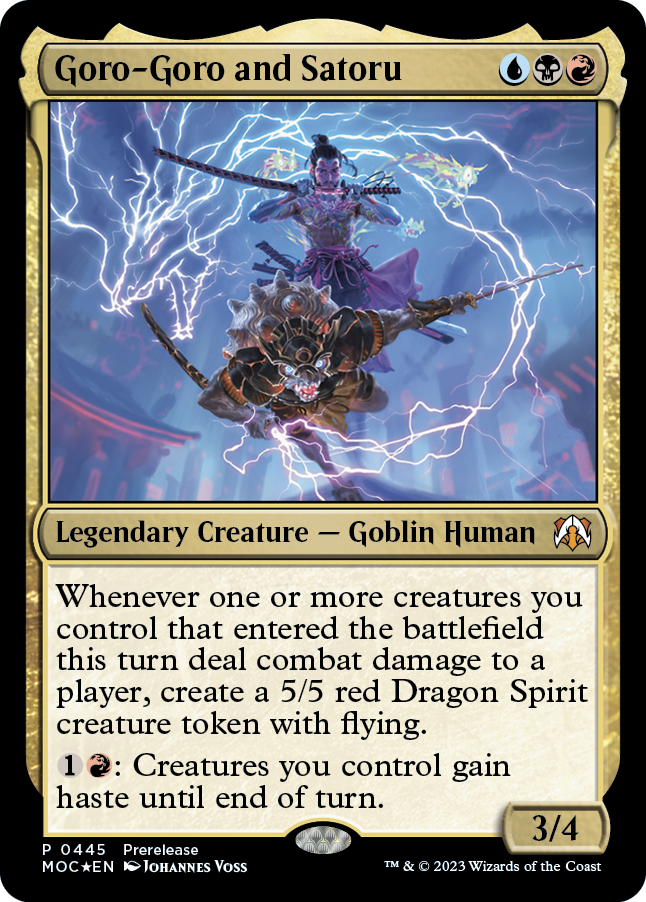
Goro-Goro and Satoru (Prerelease promo)
{U}{B}{R}
Legendary Creature — Goblin Human
3/4
Whenever one or more creatures you control that entered the battlefield this turn deal combat damage to a player, create a 5/5 red Dragon Spirit creature token with flying.
{1}{R}: Creatures you control gain haste until end of turn.
- The set of creatures affected by the last ability is determined as that ability resolves. Creatures you begin to control later in the turn and permanents that become creatures later in the turn won't gain haste. As long as Goro-Goro and Satoru is still on the battlefield under your control, it will gain haste.
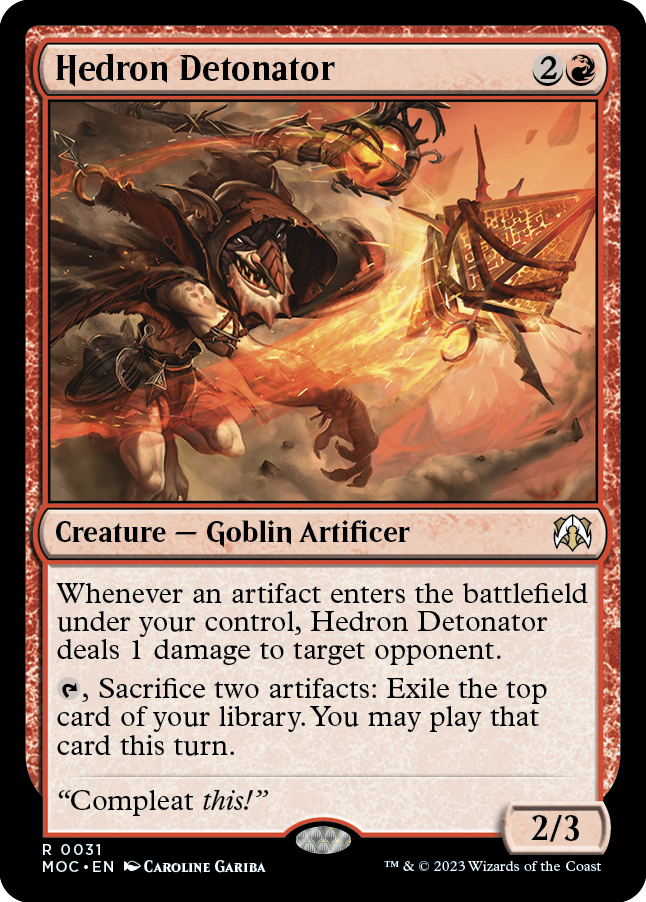
Hedron Detonator
{2}{R}
Creature — Goblin Artificer
2/3
Whenever an artifact enters the battlefield under your control, Hedron Detonator deals 1 damage to target opponent.
{T}, Sacrifice two artifacts: Exile the top card of your library. You may play that card this turn.
- You may play the card exiled with Hedron Detonator even if Hedron Detonator leaves the battlefield or you lose control of it.
- Playing the card exiled with Hedron Detonator follows the normal rules for playing that card. You must pay its costs, and you must follow all applicable timing rules. For example, if the card is a creature card, you can cast that card by paying its mana cost only during your main phase while the stack is empty.
- Unless an effect allows you to play additional lands that turn, you can play a land card exiled with Hedron Detonator only if you haven't played a land yet that turn.
- If you don't play the card, it will remain exiled.
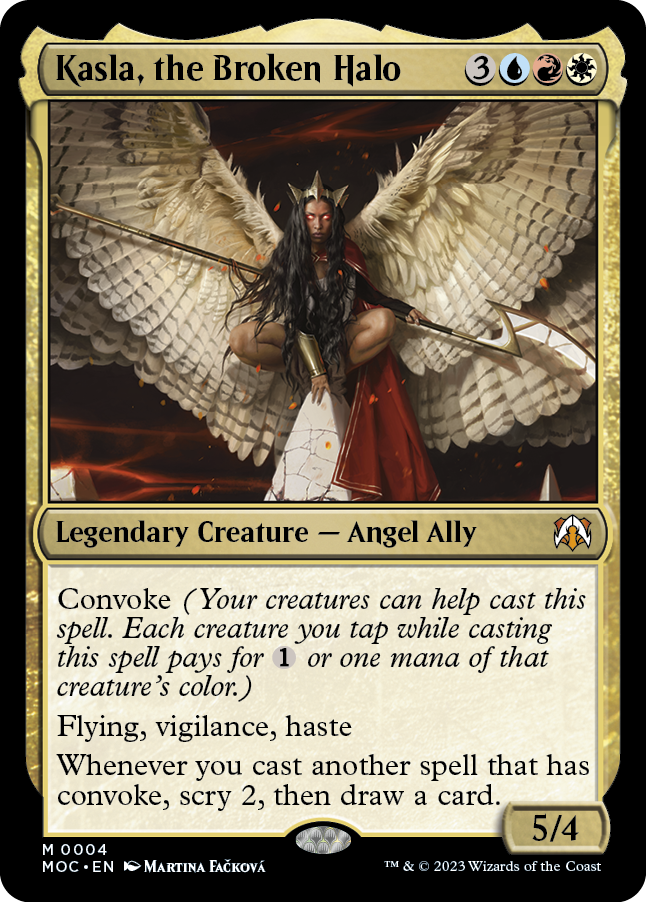
Kasla, the Broken Halo
{3}{U}{R}{W}
Legendary Creature — Angel Ally
5/4
Convoke (Your creatures can help cast this spell. Each creature you tap while casting this spell pays for {1} or one mana of that creature's color.)
Flying, vigilance, haste
Whenever you cast another spell that has convoke, scry 2, then draw a card.
- Kasla's last ability will trigger whether you tapped any creatures to pay for the spell or not, as long as it has convoke.
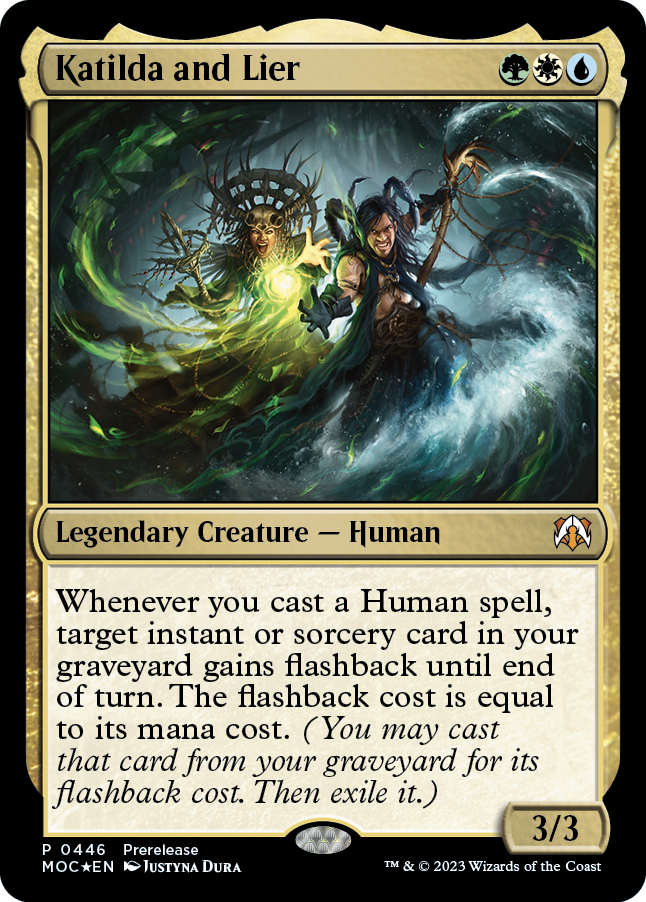
Katilda and Lier (Prerelease promo)
{G}{W}{U}
Legendary Creature — Human
3/3
Whenever you cast a Human spell, target instant or sorcery card in your graveyard gains flashback until end of turn. The flashback cost is equal to its mana cost. (You may cast that card from your graveyard for its flashback cost. Then exile it.)
- "Flashback [cost]" means "You may cast this card from your graveyard by paying [cost] rather than paying its mana cost" and "If the flashback cost was paid, exile this card instead of putting it anywhere else any time it would leave the stack."
- You must still follow any timing restrictions and permissions, including those based on the card's type. For instance, you can cast a sorcery using flashback only when you could normally cast a sorcery.
- To determine the total cost of a spell, start with the mana cost or alternative cost (such as a flashback cost) you're paying, add any cost increases, then apply any cost reductions. The mana value of the spell is determined only by its mana cost, no matter what the total cost to cast the spell was.
- A spell cast using flashback will always be exiled afterward, whether it resolves, is countered, or leaves the stack in some other way.
- You can cast a spell using flashback even if it was somehow put into your graveyard without having been cast.
- If a card with flashback is put into your graveyard during your turn, you can cast it if it's legal to do so before any other player can take any actions.
- If you cast an instant or sorcery with {X} in its mana cost this way, you still choose the value of X as part of casting the spell and pay that cost.
- If you cast a spell with flashback, you can't pay any alternative costs such as overload costs. You can pay additional costs such as kicker costs. If the spell has any mandatory additional costs, you must pay those to cast the spell with flashback.
- If a card has multiple instances of flashback, you may choose any of its flashback costs to pay.
- If a card with no mana cost gains flashback, it has no flashback cost. It can't be cast this way.
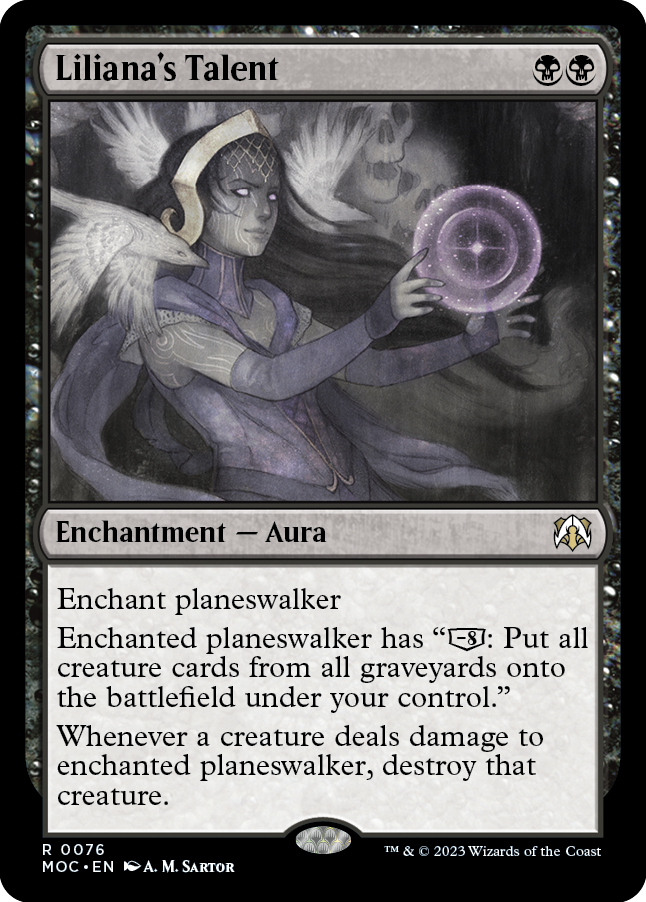
Liliana's Talent
{B}{B}
Enchantment — Aura
Enchant planeswalker
Enchanted planeswalker has "[−8]: Put all creature cards from all graveyards onto the battlefield under your control."
Whenever a creature deals damage to enchanted planeswalker, destroy that creature.
- You can activate one loyalty ability of each planeswalker you control during each of your turns, whether that ability is one it always has or the one it gains because of Liliana's Talent.
- The last ability of Liliana's Talent will trigger whenever a creature deals any damage to the enchanted planeswalker, not just combat damage.
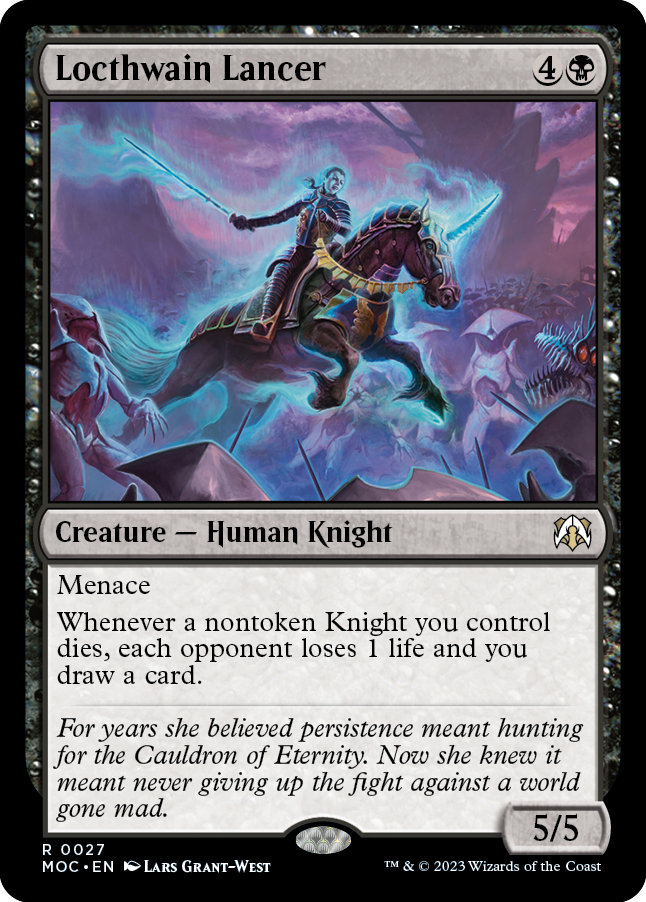
Locthwain Lancer
{4}{B}
Creature — Human Knight
5/5
Menace
Whenever a nontoken Knight you control dies, each opponent loses 1 life and you draw a card.
- If Locthwain Lancer dies at the same time as other nontoken Knights you control, its ability will trigger once for itself (assuming it's not a token) and once for each of those other Knights.

Mirror-Style Master
{4}{R}{R}
Creature — Human Warrior
3/3
Backup 1 (When this creature enters the battlefield, put a +1/+1 counter on target creature. If that's another creature, it gains the following ability until end of turn.)
Whenever this creature attacks, for each attacking modified creature you control, create a tapped and attacking token that's a copy of that creature. Exile those tokens at end of combat. (Equipment, Auras you control, and counters are modifications.)
- All of the tokens enter the battlefield at the same time.
- Although the tokens enter the battlefield attacking, they were never declared as attacking creatures (for the purposes of abilities that trigger whenever a creature attacks, for example).
- Each of the tokens copy exactly what was printed on the original creature and nothing else (unless that creature is copying something else or is a token; see below). It doesn't copy whether that creature is tapped or untapped, whether it has any counters on it or Auras and Equipment attached to it, or any non-copy effects that have changed its power, toughness, types, color, and so on. (Basically, it won't copy anything that made it modified in the first place. C'est la vie.)
- If the copied creature has {X} in its mana cost, X is 0.
- If the copied creature is a token, the token that's created copies the original characteristics of that token as stated by the effect that created that token.
- If the copied creature is copying something else, then the token enters the battlefield as whatever that creature copied.
- Any enters-the-battlefield abilities of the copied creature will trigger when the token enters the battlefield. Any "as [this creature] enters the battlefield" or "[this creature] enters the battlefield with" abilities of the copied creature will also work.
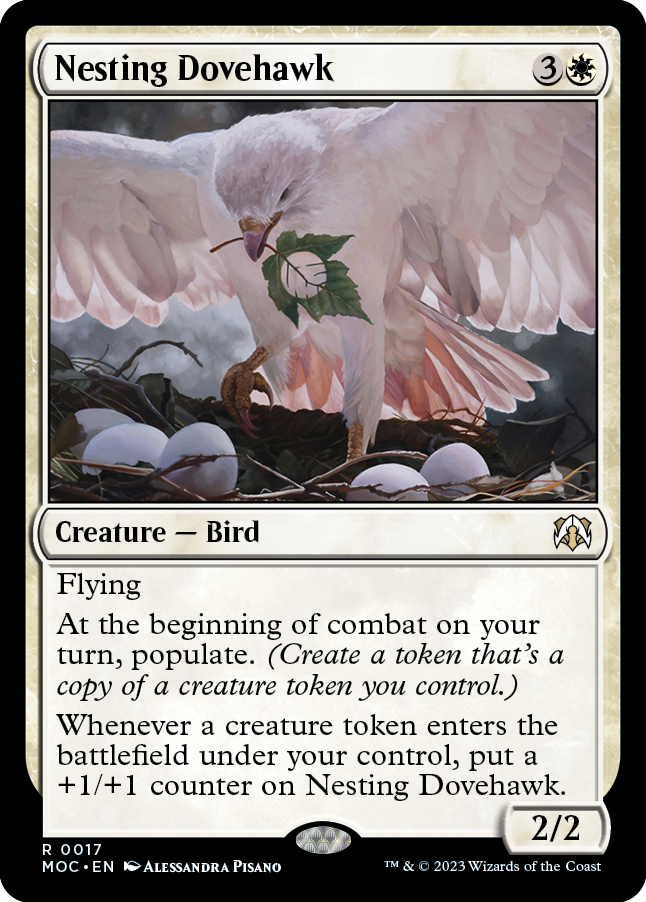
Nesting Dovehawk
{3}{W}
Creature — Bird
2/2
Flying
At the beginning of combat on your turn, populate. (Create a token that's a copy of a creature token you control.)
Whenever a creature token enters the battlefield under your control, put a +1/+1 counter on Nesting Dovehawk.
- If you control no creature tokens when you populate, nothing will happen.
- The new creature token copies the characteristics of the original token as stated by the effect that created the original token.
- The new token doesn't copy whether the original token is tapped or untapped, whether it has any counters on it or Auras and Equipment attached to it, or any non-copy effects that have changed its power, toughness, color, and so on.
- Any "as [this creature] enters the battlefield" or "[this creature] enters the battlefield with" abilities of the new token will work.
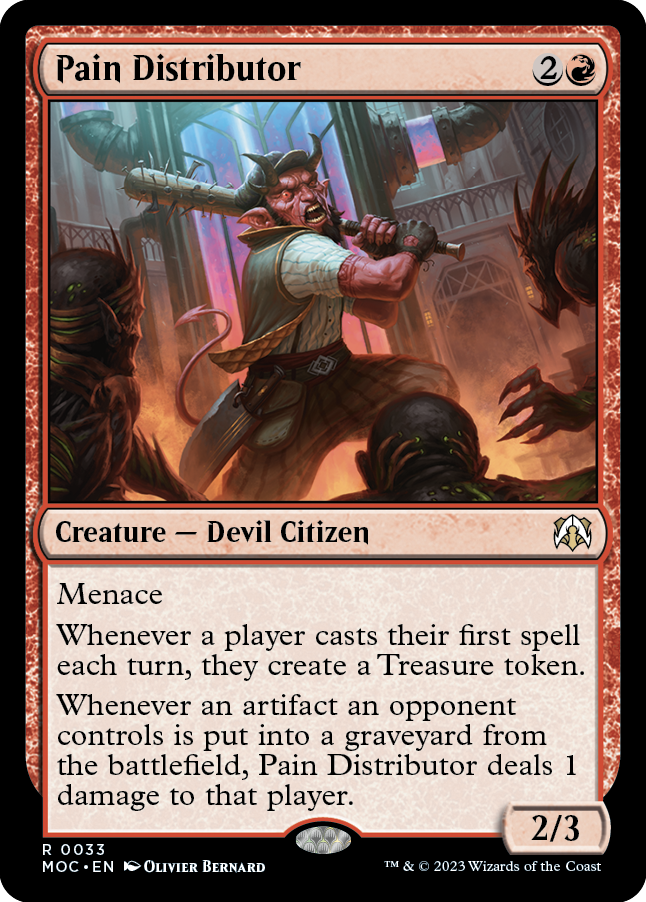
Pain Distributor
{2}{R}
Creature — Devil Citizen
2/3
Menace
Whenever a player casts their first spell each turn, they create a Treasure token.
Whenever an artifact an opponent controls is put into a graveyard from the battlefield, Pain Distributor deals 1 damage to that player.
- Pain Distributor's second ability triggers whenever a player casts their first spell each turn, not just on their own turn.
- Pain Distributor has to be on the battlefield at the moment they cast their first spell. Notably, Pain Distributor's first ability won't trigger for you on the turn you cast it, although it may trigger if another player casts their first spell that turn after Pain Distributor is on the battlefield. If a spell causes Pain Distributor to leave the battlefield as an additional cost to cast it, the ability won't trigger.
- Pain Distributor's ability resolves before the spell that caused it to trigger, but not before you have to pay for the original spell. You won't be able to use the Treasure token you create to pay for it.

Path of the Pyromancer
{4}{R}
Sorcery
Discard all the cards in your hand. Add {R} for each card discarded this way, then draw that many cards plus one.
Will of the Planeswalkers — Starting with you, each player votes for planeswalk or chaos. If planeswalk gets more votes, planeswalk. If chaos gets more votes or the vote is tied, chaos ensues.
- If your hand is empty as Path of the Pyromancer resolves, you won't add any mana, but you will draw a card.
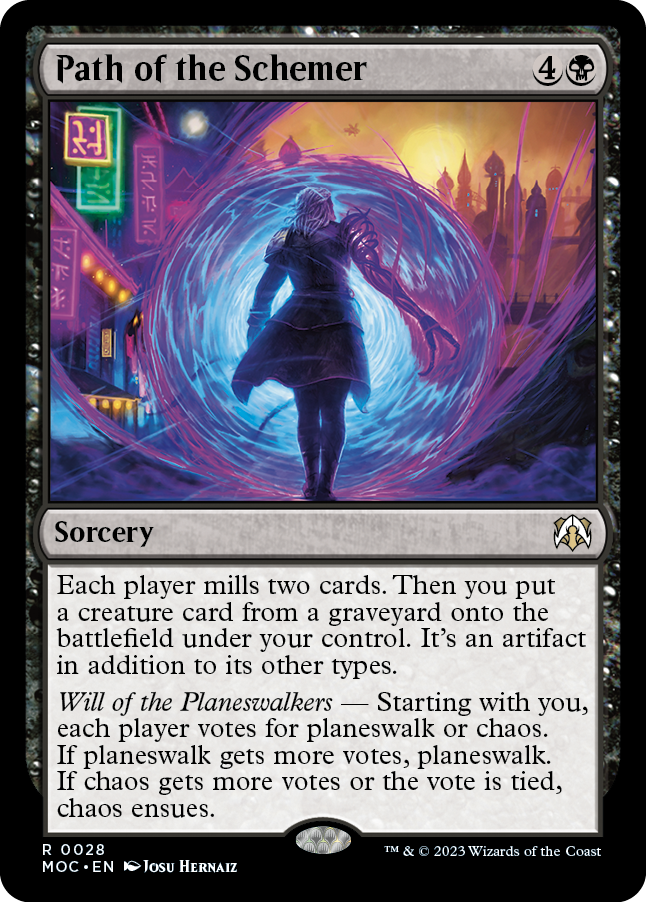
Path of the Schemer
{4}{B}
Sorcery
Each player mills two cards. Then you put a creature card from a graveyard onto the battlefield under your control. It's an artifact in addition to its other types.
Will of the Planeswalkers — Starting with you, each player votes for planeswalk or chaos. If planeswalk gets more votes, planeswalk. If chaos gets more votes or the vote is tied, chaos ensues.
- The creature card you put onto the battlefield may be one that was just milled, or it may be one that was already in a graveyard.
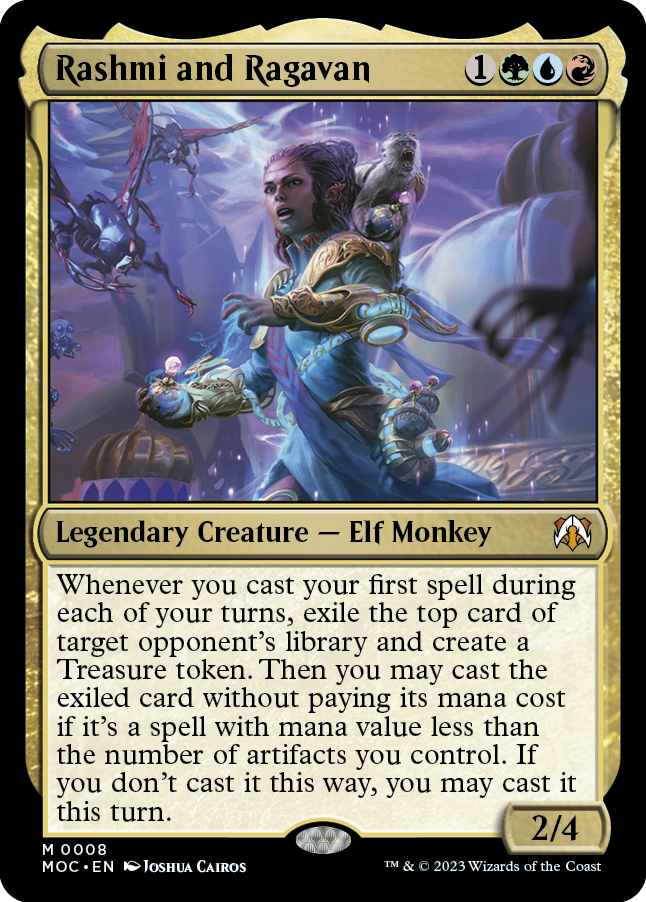
Rashmi and Ragavan
{1}{G}{U}{R}
Legendary Creature — Elf Monkey
2/4
Whenever you cast your first spell during each of your turns, exile the top card of target opponent's library and create a Treasure token. Then you may cast the exiled card without paying its mana cost if it's a spell with mana value less than the number of artifacts you control. If you don't cast it this way, you may cast it this turn.
- Rashmi and Ragavan has to be on the battlefield at the moment you cast your first spell. Notably, on the turn you cast Rashmi and Ragavan, the ability won't trigger for you that turn. If a spell causes Rashmi and Ragavan to leave the battlefield as an additional cost to cast it, the ability won't trigger.
- Rashmi and Ragavan's ability resolves before the spell that caused it to trigger, but not before you have to pay for the original spell. You won't be able to use the Treasure token you create to pay for it.
- Check the number of artifacts you control as the ability resolves, including the Treasure token you just created, to see if you can cast the exiled card without paying its mana cost.
- If you cast the spell without paying its mana cost, you do so during the resolution of the triggered ability. Timing restrictions of that spell based on card type are ignored. It will resolve before the spell that caused the ability to trigger.
- If you cast a spell without paying its mana cost, you can't choose to cast it for any alternative costs. You can, however, pay any additional costs. If the spell has any mandatory additional costs, you must pay those.
- If the spell has {X} in its mana cost, you must choose 0 as the value of X when casting it without paying its mana cost.
- If you don't cast it without paying its mana cost but rather cast it later in the turn, you must pay its costs, and you must follow all applicable timing rules. For example, if the card is a creature card, you can cast that card by paying its mana cost only during your main phase while the stack is empty.
- If you don't cast the card at all, it remains exiled.
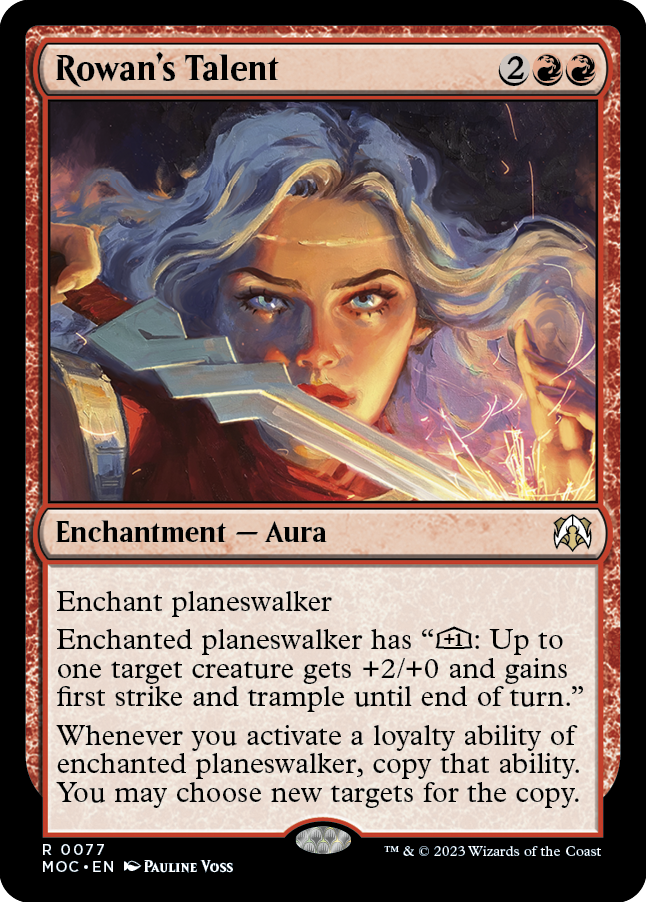
Rowan's Talent
{2}{R}{R}
Enchantment — Aura
Enchant planeswalker
Enchanted planeswalker has "[+1]: Up to one target creature gets +2/+0 and gains first strike and trample until end of turn."
Whenever you activate a loyalty ability of enchanted planeswalker, copy that ability. You may choose new targets for the copy.
- You can activate one loyalty ability of each planeswalker you control during each of your turns, whether that ability is one it always has or the one it gains because of Rowan's Talent.
- Copying a loyalty ability doesn't cause any loyalty counters to be added to or removed from the enchanted planeswalker.
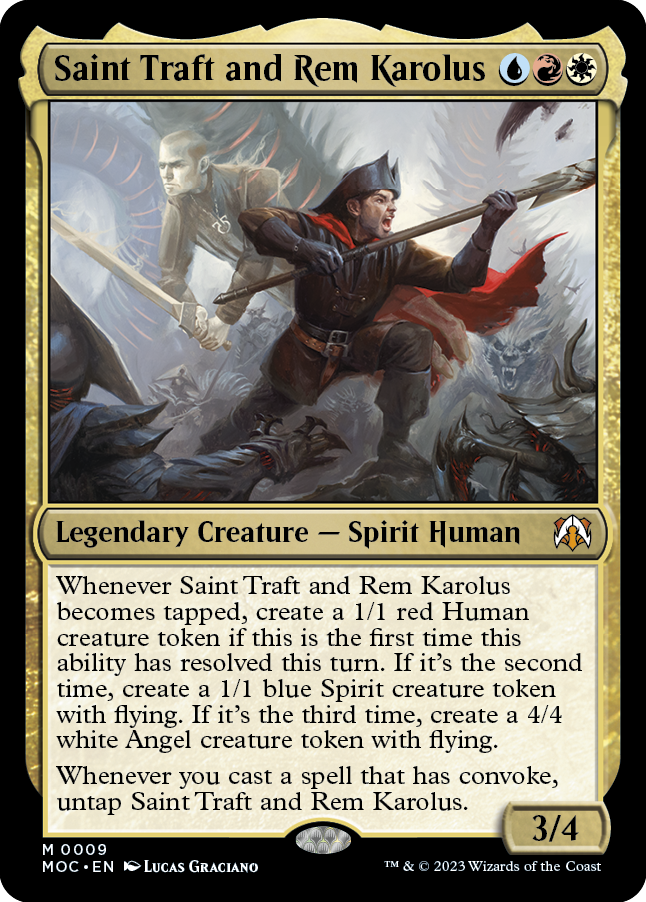
Saint Traft and Rem Karolus
{U}{R}{W}
Legendary Creature — Spirit Human
3/4
Whenever Saint Traft and Rem Karolus becomes tapped, create a 1/1 red Human creature token if this is the first time this ability has resolved this turn. If it's the second time, create a 1/1 blue Spirit creature token with flying. If it's the third time, create a 4/4 white Angel creature token with flying.
Whenever you cast a spell that has convoke, untap Saint Traft and Rem Karolus.
- If it's the fourth or subsequent time the first ability has resolved in a turn, nothing happens.
- The last ability of Saint Traft and Rem Karolus will trigger whether you tapped any creatures to pay for the spell or not, as long as it has convoke.

Sandsteppe War Riders
{3}{G}
Creature — Human Warrior
4/4
Trample
At the beginning of combat on your turn, bolster X, where X is the number of differently named artifact tokens you control. (Choose a creature with the least toughness among creatures you control and put X +1/+1 counters on it.)
- To determine the number of differently named artifact tokens you control, count each artifact token you control once, but only if its English name isn't exactly the same as another artifact token you've already counted this way.
- A token's name is its subtypes plus the word "Token" unless it's copying another object or it was given a specific name by the effect that created it. For example, Myr tokens are named "Myr Token," and they have a different name than Phyrexian Myr tokens, which are named "Phyrexian Myr Token."

Schema Thief
{3}{U}
Creature — Vedalken Rogue Artificer
3/3
Flying
Whenever Schema Thief deals combat damage to a player, create a token that's a copy of target artifact that player controls.
- Each of the tokens copy exactly what was printed on the original artifact and nothing else (unless that artifact is copying something else or is a token; see below). It doesn't copy whether that artifact is tapped or untapped, whether it has any counters on it or Auras and Equipment attached to it, or any non-copy effects that have changed its power, toughness, types, color, and so on.
- If the copied artifact has {X} in its mana cost, X is 0.
- If the copied artifact is a token, the token that's created copies the original characteristics of that token as stated by the effect that created that token.
- If the copied artifact is copying something else, then the token enters the battlefield as whatever that artifact copied.
- Any enters-the-battlefield abilities of the copied artifact will trigger when the token enters the battlefield. Any "as [this artifact] enters the battlefield" or "[this artifact] enters the battlefield with" abilities of the copied artifact will also work.
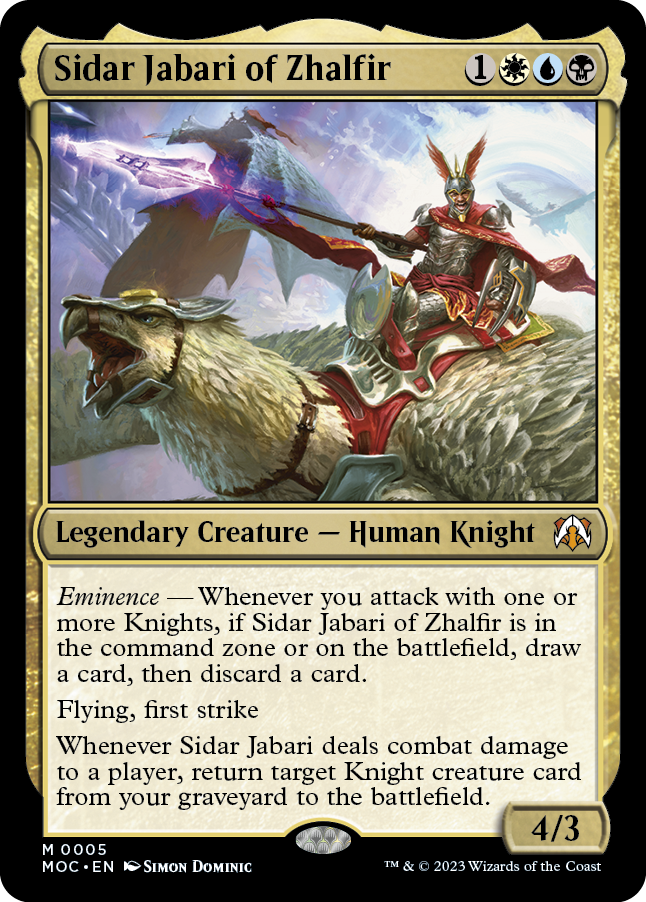
Sidar Jabari of Zhalfir
{1}{W}{U}{B}
Legendary Creature — Human Knight
4/3
Eminence — Whenever you attack with one or more Knights, if Sidar Jabari of Zhalfir is in the command zone or on the battlefield, draw a card, then discard a card.
Flying, first strike
Whenever Sidar Jabari deals combat damage to a player, return target Knight creature card from your graveyard to the battlefield.
- Sidar Jabari must be on the battlefield or in the command zone at the moment you attack with one or more Knights and also as the triggered ability tries to resolve. Notably, if Sidar Jabari is on the battlefield and its eminence ability triggers, but it's put into the command zone before that ability resolves, that ability won't do anything as it resolves. This is because an object that changes zones is considered a new object.
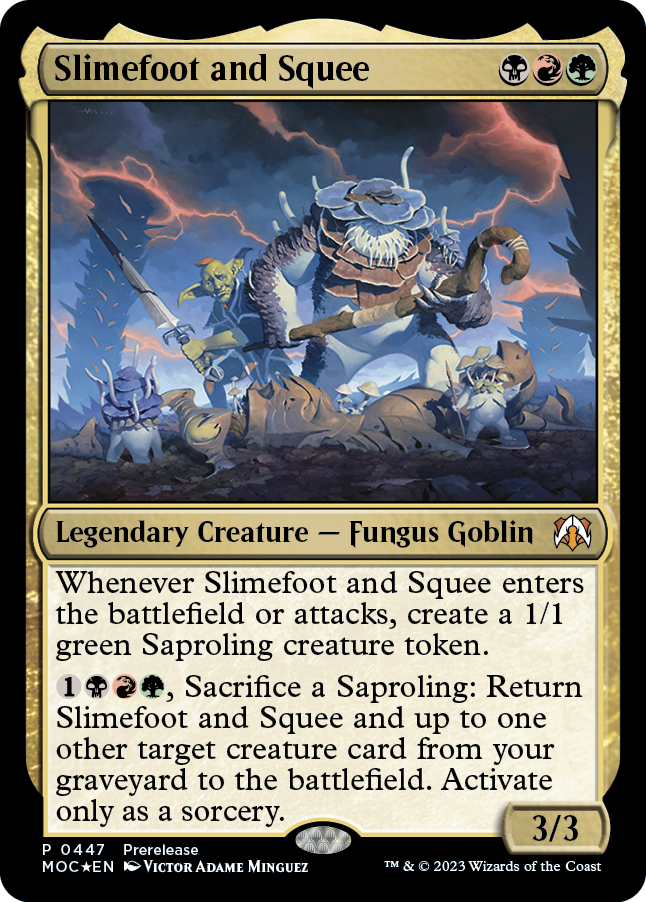
Slimefoot and Squee (Prerelease promo)
{B}{R}{G}
Legendary Creature — Fungus Goblin
3/3
Whenever Slimefoot and Squee enters the battlefield or attacks, create a 1/1 green Saproling creature token.
{1}{B}{R}{G}, Sacrifice a Saproling: Return Slimefoot and Squee and up to one other target creature card from your graveyard to the battlefield. Activate only as a sorcery.
- You don't have to choose a target to activate the last ability. However, if you do, and that target is illegal at the time the ability tries to resolve, it won't resolve and none of its effects will happen. Slimefoot and Squee won't be returned to the battlefield.
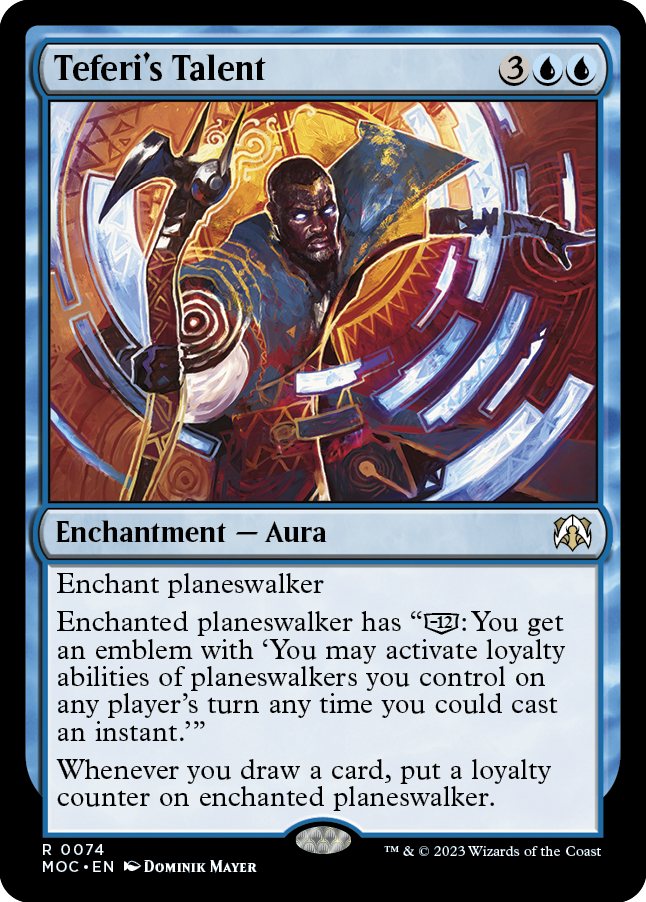
Teferi's Talent
{3}{U}{U}
Enchantment — Aura
Enchant planeswalker
Enchanted planeswalker has "[−12]: You get an emblem with 'You may activate loyalty abilities of planeswalkers you control on any player's turn any time you could cast an instant.'"
Whenever you draw a card, put a loyalty counter on enchanted planeswalker.
- You can activate one loyalty ability of each planeswalker you control during each of your turns, whether that ability is one it always has or the one it gains because of Teferi's Talent.

Uncivil Unrest
{4}{R}
Enchantment
Nontoken creatures you control have riot. (They enter the battlefield with your choice of a +1/+1 counter or haste.)
If a creature you control with a +1/+1 counter on it would deal damage to a permanent or player, it deals double that damage instead.
- Riot is a replacement effect. Players can't respond to your choice of +1/+1 counter or haste, and they can't take actions while the creature is on the battlefield without one or the other.
- If you choose for the creature to gain haste, it gains haste indefinitely. It won't lose it as the turn ends or as another player gains control of it.
- The damage is dealt by the same source as the original source of damage. The doubled damage isn't dealt by Uncivil Unrest unless it was somehow the original source of damage.
- If another effect (or effects) modifies how much damage your creature with a +1/+1 counter on it would deal—by preventing some of it, for example—the player being dealt damage or the controller of the permanent being dealt damage chooses the order in which any such effects (including Uncivil Unrest's) apply. If all of the damage is prevented, Uncivil Unrest's effect no longer applies.
- If damage dealt by a creature you control with a +1/+1 counter on it is being divided or assigned among multiple permanents and/or players, that damage is divided or assigned before doubling. For example, if you attack with a 5/5 creature with trample and it's blocked by a 2/2 creature, you can assign 2 damage to the blocker and 3 damage to the defending player. Those amounts are then doubled to 4 and 6, respectively.

Vivien's Talent
{1}{G}{G}
Enchantment — Aura
Enchant planeswalker
Enchanted planeswalker has "[+1]: Look at the top four cards of your library. You may reveal a creature or land card from among them and put it into your hand. Put the rest on the bottom of your library in a random order."
Whenever a nontoken creature enters the battlefield under your control, put a loyalty counter on enchanted planeswalker.
- You can activate one loyalty ability of each planeswalker you control during each of your turns, whether that ability is one it always has or the one it gains because of Vivien's Talent.

Vodalian Wave-Knight
{2}{W}{U}
Creature — Merfolk Knight
3/3
Whenever you draw a card, put a +1/+1 counter on each other Merfolk and/or Knight you control.
- If a creature you control is both a Merfolk and a Knight, it gets one +1/+1 counter.

Vulpine Harvester
{3}{W}
Creature — Phyrexian Fox
3/3
Whenever one or more Phyrexians you control attack, return target artifact card from your graveyard to the battlefield if its mana value is less than or equal to their total power.
- The total power of the attacking Phyrexians is checked twice: first, as the ability triggers to determine what can legally be targeted. Their total power is checked again as the ability tries to resolve to determine if the target is still legal. Use the power of each of those creatures at that time, even if the creature is no longer attacking or no longer a Phyrexian. If the creature isn't on the battlefield, use its power from when it was last on the battlefield. If the target has become illegal, the ability won't resolve and none of its effects will happen. You won't return the card.
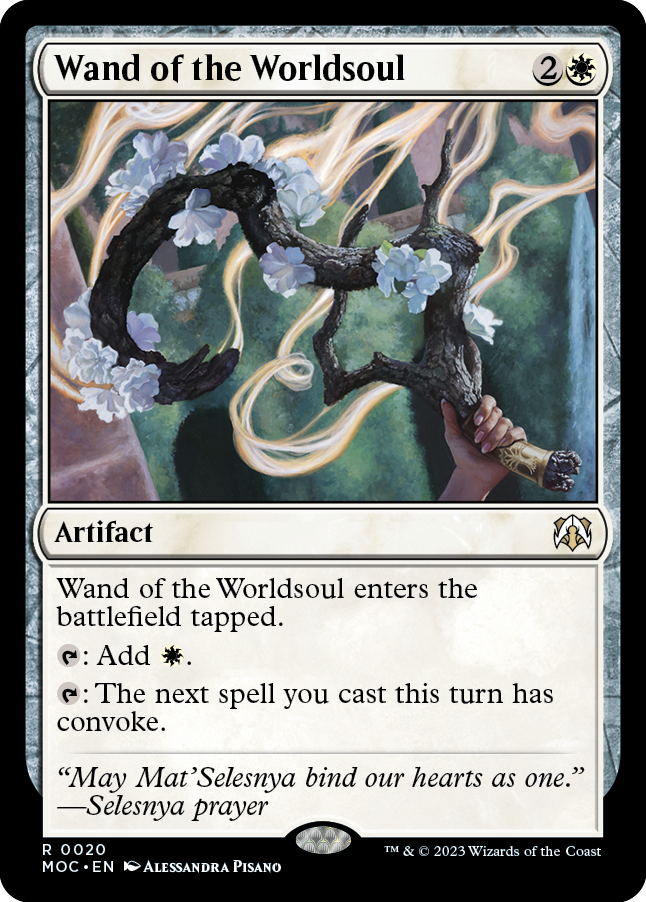
Wand of the Worldsoul
{2}{W}
Artifact
Wand of the Worldsoul enters the battlefield tapped.
{T}: Add {W}.
{T}: The next spell you cast this turn has convoke.
- If the next spell you cast after Wand of the Worldsoul's ability resolves already has convoke, giving it convoke again doesn't have any real benefit. Tapping a creature you control will still pay for only {1} or one mana of that creature's color.
MARCH OF THE MACHINE PLANECHASE CARD-SPECIFIC NOTES
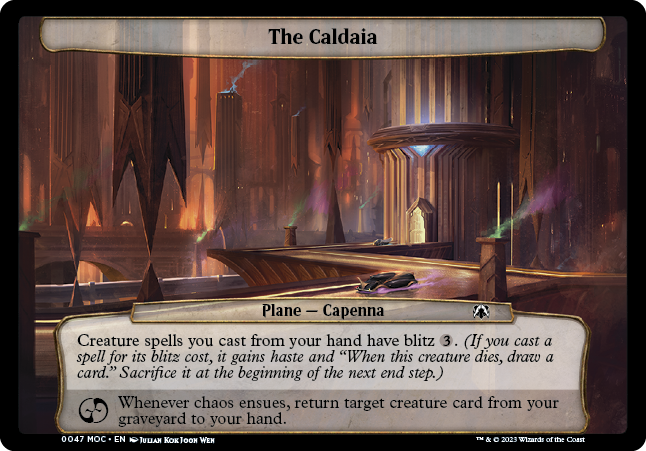
The Caldaia
Plane — Capenna
Creature spells you cast from your hand have blitz {3}. (If you cast a spell for its blitz cost, it gains haste and "When this creature dies, draw a card." Sacrifice it at the beginning of the next end step.)
Whenever chaos ensues, return target creature card from your graveyard to your hand.
- If you choose to pay the blitz cost rather than the mana cost, you're still casting the spell. It goes on the stack and can be responded to and countered. You can cast a creature spell for its blitz cost only if you could cast that creature spell. Most of the time, this means during your main phase when the stack is empty.
- If you pay the blitz cost to cast a creature spell, that permanent will be sacrificed only if it's still on the battlefield when that triggered ability resolves. If it dies or goes to another zone before then, it will stay where it is.
- You don't have to attack with the creature with blitz unless another ability says you do.
- If a creature enters the battlefield as a copy of or becomes a copy of a creature whose blitz cost was paid, the copy won't have haste, won't be sacrificed, and its controller won't draw a card when it dies.
- The triggered ability that lets the creature's controller draw a card triggers when it dies for any reason, not just when you sacrifice it during the end step.
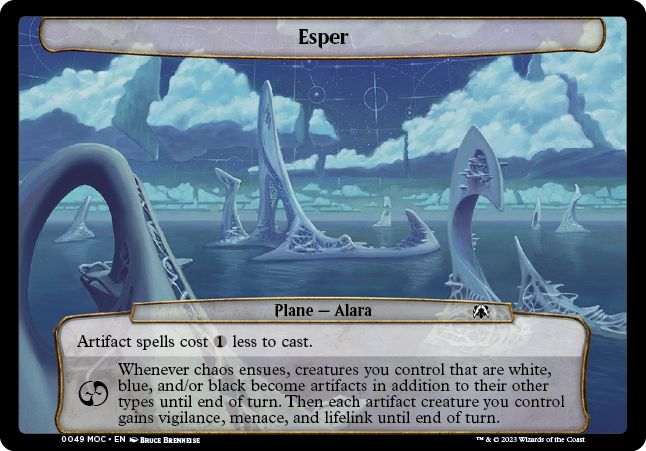
Esper
Plane — Alara
Artifact spells cost {1} less to cast.
Whenever chaos ensues, creatures you control that are white, blue, and/or black become artifacts in addition to their other types until end of turn. Then each artifact creature you control gains vigilance, menace, and lifelink until end of turn.
- Esper's first ability doesn't change the mana cost or mana value of any artifact spell. It changes only the total cost players pay.
- That ability can't reduce the amount of colored mana players pay for a spell. It reduces only the generic component of that cost.
- If there are additional costs to cast an artifact spell, or if the cost to cast a spell is increased by an effect (such as the one created by Thalia, Guardian of Thraben's ability), apply those increases before applying cost reductions.
- The cost reduction can apply to alternative costs such as prototype costs.
- If a spell you cast has {X} in its mana cost, you choose the value of X before calculating the spell's total cost. For example, if an artifact spell's mana cost is {X}{X}, you could choose 2 as the value of X and pay {3} to cast the spell.
- The set of artifact creatures affected by the chaos ability is determined as that ability resolves. Artifact creatures you begin to control later in the turn and permanents that become artifact creatures later in the turn won't get the bonuses.
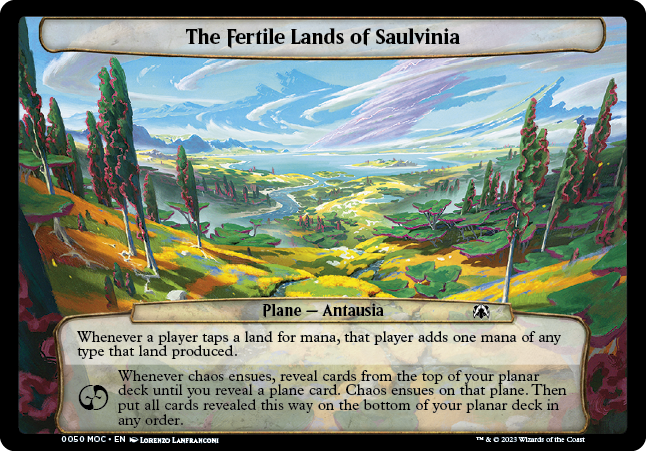
The Fertile Lands of Saulvinia
Plane — Antausia
Whenever a player taps a land for mana, that player adds one mana of any type that land produced.
Whenever chaos ensues, reveal cards from the top of your planar deck until you reveal a plane card. Chaos ensues on that plane. Then put all cards revealed this way on the bottom of your planar deck in any order.
- "Chaos ensues on that plane" means that plane card's chaos ability will trigger. The chaos ability of the current plane (namely, The Fertile Lands of Saulvinia) won't trigger.
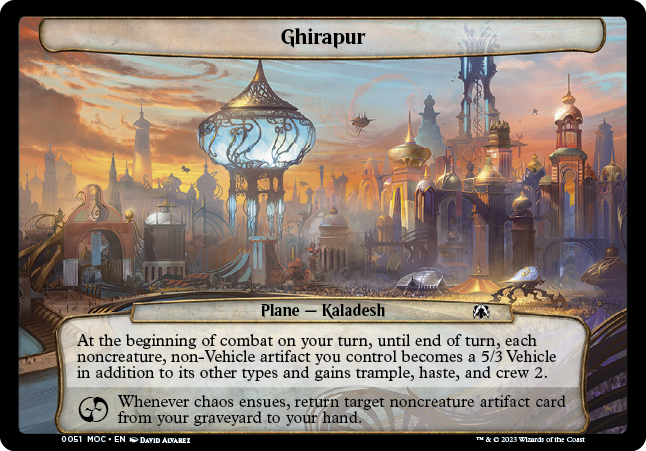
Ghirapur
Plane — Kaladesh
At the beginning of combat on your turn, until end of turn, each noncreature, non-Vehicle artifact you control becomes a 5/3 Vehicle in addition to its other types and gains trample, haste, and crew 2.
Whenever chaos ensues, return target noncreature artifact card from your graveyard to your hand.
- The set of artifacts affected by Ghirapur's first ability is determined as the ability resolves. Artifacts you begin to control later in the turn and nonartifact permanents that become artifacts later in the turn won't become Vehicles.
- The affected artifacts retain any other card types, subtypes, and abilities they had.
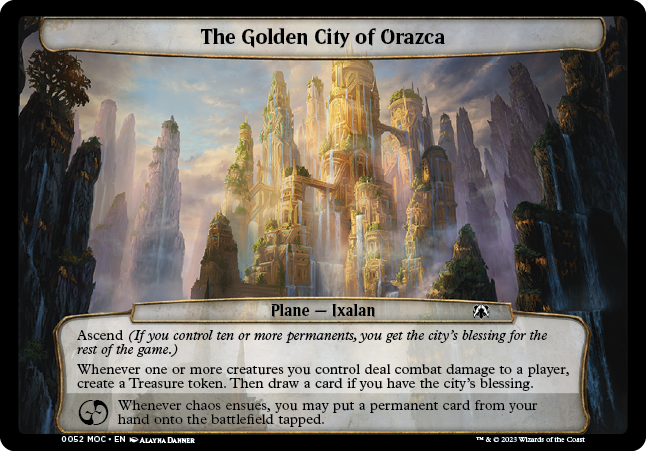
The Golden City of Orazca
Plane — Ixalan
Ascend (If you control ten or more permanents, you get the city's blessing for the rest of the game.)
Whenever one or more creatures you control deal combat damage to a player, create a Treasure token. Then draw a card if you have the city's blessing.
Whenever chaos ensues, you may put a permanent card from your hand onto the battlefield tapped.
- Once you have the city's blessing, you have it for the rest of the game, even if you lose control of some or all of your permanents. The city's blessing isn't a permanent itself and can't be removed by any effect.
- A permanent is any object on the battlefield, including tokens and lands. Spells, planes, and emblems aren't permanents.
- If you control ten permanents but have not yet found The Golden City of Orazca (and you don't control a permanent or resolving spell with ascend), you don't get the city's blessing. For example, if you control ten permanents, lose control of one, then planeswalk to The Golden City of Orazca, you won't have the city's blessing.
- If your tenth permanent enters the battlefield and then a permanent leaves the battlefield immediately afterwards (most likely due to the "legend rule" or due to being a creature with 0 toughness), you get the city's blessing before it leaves the battlefield.
- Ascend on a plane or permanent isn't a triggered ability and doesn't use the stack. Players can respond to a spell that will give you your tenth permanent, but they can't respond to getting the city's blessing once you control that tenth permanent. This means that if your tenth permanent is a land you play, players can't respond before you get the city's blessing.
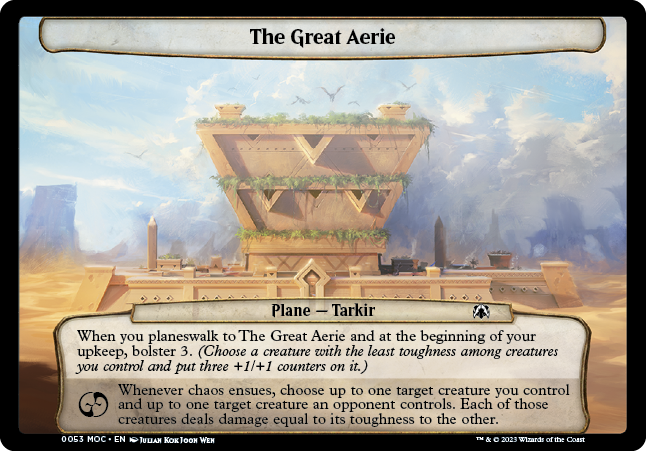
The Great Aerie
Plane — Tarkir
When you planeswalk to The Great Aerie and at the beginning of your upkeep, bolster 3. (Choose a creature with the least toughness among creatures you control and put three +1/+1 counters on it.)
Whenever chaos ensues, choose up to one target creature you control and up to one target creature an opponent controls. Each of those creatures deals damage equal to its toughness to the other.
- Bolster itself doesn't target any creature, though some spells and abilities that bolster may have other effects that target creatures.
- You determine which creature to put counter(s) on as the spell or ability that instructs you to bolster resolves. That could be the creature with the bolster ability, if it's still under your control and has the least toughness. If there's a tie, you choose which creature gets the counter(s).
- If you choose two target creatures for the chaos ability and either target is an illegal target as the ability tries to resolve, the ability won't resolve and none of its effects will happen. Neither creature will deal or be dealt damage.
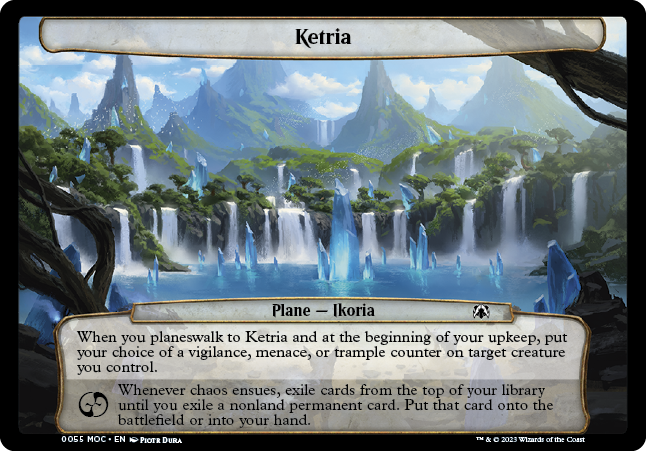
Ketria
Plane — Ikoria
When you planeswalk to Ketria and at the beginning of your upkeep, put your choice of a vigilance, menace, or trample counter on target creature you control.
Whenever chaos ensues, exile cards from the top of your library until you exile a nonland permanent card. Put that card onto the battlefield or into your hand.
- You choose which counter you're putting on the target creature as Ketria's first ability resolves.
- While resolving the chaos ability, the cards you exile before exiling a nonland permanent card remain exiled.
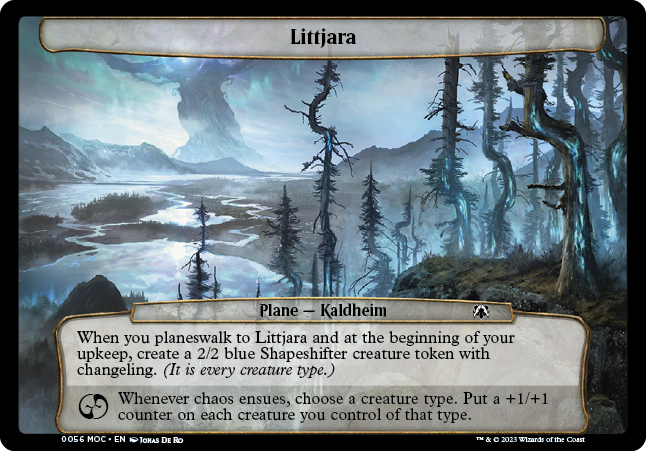
Littjara
Plane — Kaldheim
When you planeswalk to Littjara and at the beginning of your upkeep, create a 2/2 blue Shapeshifter creature token with changeling. (It is every creature type.)
Whenever chaos ensues, choose a creature type. Put a +1/+1 counter on each creature you control of that type.
- If an effect causes a creature with changeling to lose all abilities, it will remain all creature types, even though it will no longer have changeling. This is because changeling applies before the effect that removes it.

Naktamun
Plane — Amonkhet
Each creature card in your graveyard has embalm. Its embalm cost is equal to its mana cost. (Exile a creature card from your graveyard and pay its embalm cost: Create a token that's a copy of it, except it's a white Zombie in addition to its other types with no mana cost. Embalm only as a sorcery.)
Whenever chaos ensues, you may discard a card. If you do, draw a card.
- If a spell or ability resolves during your main phase, causing a creature card to be put into your graveyard, you'll have priority immediately afterward. You can activate the creature card's embalm ability before any player can exile it, if it's legal for you to do so.
- Once you've activated an embalm ability, the card is immediately exiled. Opponents can't try to stop the ability by exiling the card or quickly getting the heck off of Naktamun.

New Argive
Plane — Dominaria
Whenever a historic creature you control attacks, it gets +2/+2 until end of turn. (Artifacts, legendaries, and Sagas are historic.)
Whenever chaos ensues, reveal cards from the top of your library until you reveal a historic card. Put that card into your hand and the rest on the bottom of your library in a random order.
- Once a historic creature you control attacks, it will keep the +2/+2 for the entire turn, even if it stops being historic later that turn.
- It's not easy to attack with Sagas, but doing so makes for a great story.
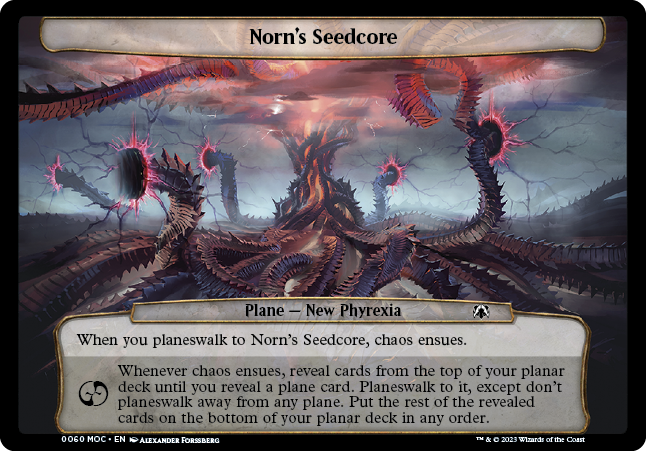
Norn's Seedcore
Plane — New Phyrexia
When you planeswalk to Norn's Seedcore, chaos ensues.
Whenever chaos ensues, reveal cards from the top of your planar deck until you reveal a plane card. Planeswalk to it, except don't planeswalk away from any plane. Put the rest of the revealed cards on the bottom of your planar deck in any order.
- Until a player planeswalks, the game will continue on multiple planes. The abilities of all face-up plane cards can affect the game.
- If a player rolls {CHAOS}, chaos ensues and all chaos abilities will trigger. The player may put those abilities on the stack in any order.
- The next time a player planeswalks, they planeswalk away from all face-up planes. Their owners' put them on the bottom of their planar decks in an order of their choice. This order isn't revealed to other players.
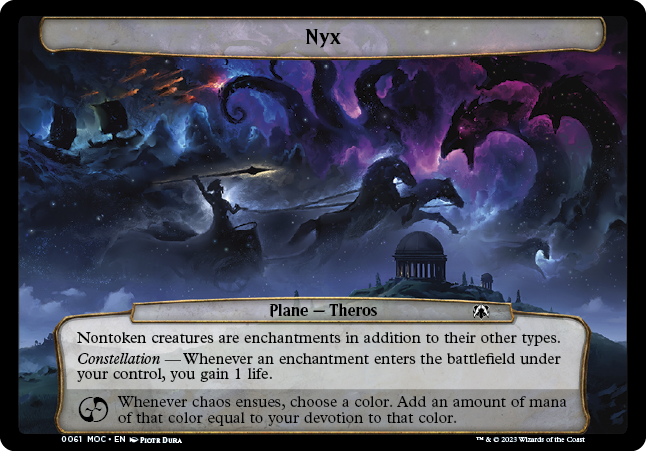
Nyx
Plane — Theros
Nontoken creatures are enchantments in addition to their other types.
Constellation — Whenever an enchantment enters the battlefield under your control, you gain 1 life.
Whenever chaos ensues, choose a color. Add an amount of mana of that color equal to your devotion to that color.
- A player's devotion to a color is equal to the number of mana symbols of that color among the mana costs of permanents that player controls.
- Nyx's first ability will apply to nontoken creatures from the moment they enter the battlefield. Notably, a nontoken creature entering the battlefield will cause the constellation ability to trigger.
- The chaos ability isn't a mana ability. It uses the stack and can be responded to. You choose the color as the ability resolves. Once the ability starts resolving and you've chosen a color, it's too late for anyone to respond and change your devotion to any color.
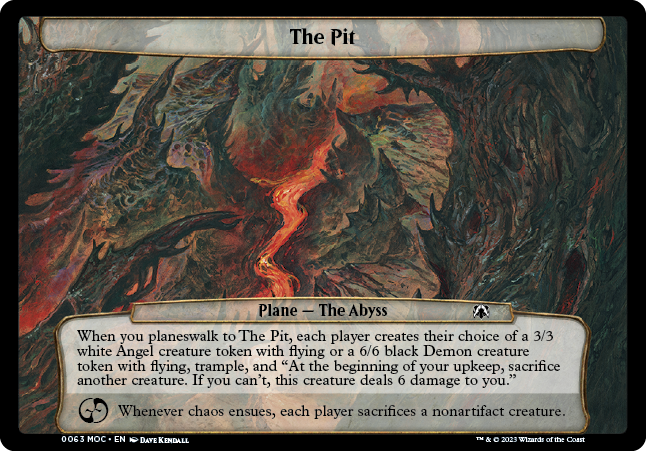
The Pit
Plane — The Abyss
When you planeswalk to The Pit, each player creates their choice of a 3/3 white Angel creature token with flying or a 6/6 black Demon creature token with flying, trample, and "At the beginning of your upkeep, sacrifice another creature. If you can't, this creature deals 6 damage to you."
Whenever chaos ensues, each player sacrifices a nonartifact creature.
- To resolve the first ability, starting with you and proceeding in turn order, each player chooses which creature token they're creating. Then all creature tokens are created and enter the battlefield at the same time.

Riptide Island
Plane — Dominaria
When you planeswalk to Riptide Island and at the beginning of your upkeep, create two 1/1 colorless Sliver creature tokens.
Whenever chaos ensues, Slivers you control gain haste and get +X/+X until end of turn, where X is the number of Slivers you control.
- Count the number of Slivers you control as the chaos ability resolves to determine the value of X.
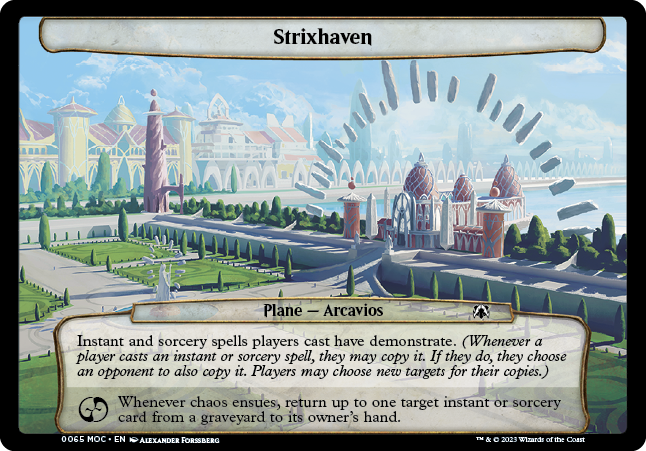
Strixhaven
Plane — Arcavios
Instant and sorcery spells players cast have demonstrate. (Whenever a player casts an instant or sorcery spell, they may copy it. If they do, they choose an opponent to also copy it. Players may choose new targets for their copies.)
Whenever chaos ensues, return up to one target instant or sorcery card from a graveyard to its owner's hand.
- You choose whether to make a copy as the demonstrate ability resolves. This happens before the original spell resolves. Your copy goes on the stack above the original spell.
- If the spell requires targets, you choose the target of the original spell as you cast it. If you create a copy of the spell, you may choose new targets for the copy as you create that copy. Similarly, the opponent you chose to create a copy may choose new targets for that copy as it's created. In other words, your opponent will know the targets of your original spell and your copy when choosing the new targets, if any, for their copy.
- This means that if you cast a spell with demonstrate and both you and an opponent copy it, the opponent's copy will resolve first, then your copy will resolve, and finally the original spell will resolve.
- If you cast the spell and choose not to copy it, no opponent will get to copy it either.
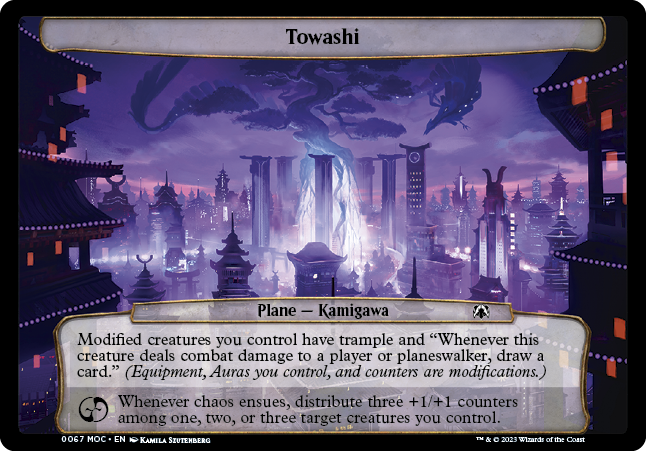
Towashi
Plane — Kamigawa
Modified creatures you control have trample and "Whenever this creature deals combat damage to a player or planeswalker, draw a card." (Equipment, Auras you control, and counters are modifications.)
Whenever chaos ensues, distribute three +1/+1 counters among one, two, or three target creatures you control.
- You choose how many targets the chaos ability has and how the counters are distributed as you put the ability onto the stack. Each target must receive at least one counter.
- If some of the creatures are illegal targets as the chaos ability tries to resolve, the original distribution of counters still applies and the counters that would have been put on the illegal targets are lost. They won't be put instead on a legal target.

Unyaro
Plane — Zhalfir
At the beginning of your end step, if you planeswalked to Unyaro this turn, untap all creatures. They phase out until a player planeswalks. (Treat them and anything attached to them as though they didn't exist.)
Whenever chaos ensues, create two 2/2 white and blue Knight creature tokens with vigilance.
- A creature phased out by Unyaro doesn't phase in during its controller's untap step as normal.
- While a permanent is phased out, it's treated as though it doesn't exist. It can't be the target of spells or abilities, its static abilities have no effect on the game, its triggered abilities can't trigger, it can't attack or block, and so on.
- Phasing out doesn't cause any "leaves the battlefield" abilities to trigger. Similarly, phasing in won't cause any "enters the battlefield" abilities to trigger.
- Any one-shot effects that are waiting "until [this] leaves the battlefield," such as that of Banisher Priest, won't happen when a permanent phases out.
- Any continuous effects with a "for as long as" duration, such as that of Tide Shaper, ignore phased-out objects. Any such effects will expire if their conditions are no longer met after ignoring the phased-out objects.
- Each Aura and Equipment attached to a permanent that's phasing out also phases out. They will phase in with that permanent and still be attached to it. Similarly, permanents that phase out with counters phase in with those counters.
- Choices made for permanents as they entered the battlefield are remembered when they phase in.

The Western Cloud
Plane — Gobakhan
Prevent all damage that would be dealt to creatures and planeswalkers you control.
Whenever chaos ensues, create three tapped Treasure tokens. They each deal 1 damage to each creature and each planeswalker.
- The Treasure tokens deal the damage, not The Western Cloud.
MARCH OF THE MACHINE MULTIVERSE LEGENDS CARD-SPECIFIC NOTES
Returning Keyword: Companion
The ten companions are back to stand beside you on your new adventures. Well, to stand outside the game until you pay to bring them into your hand.
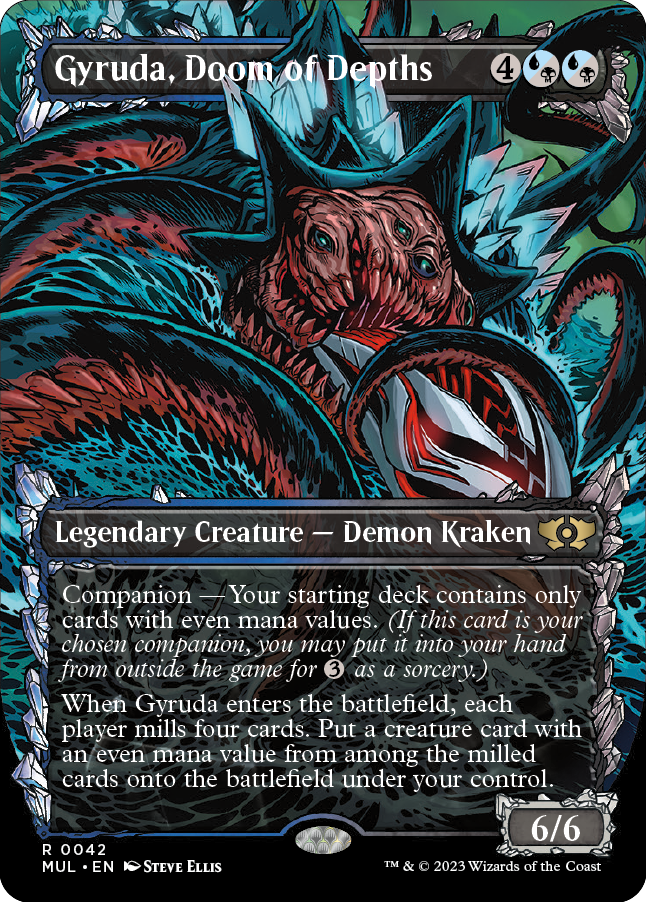
Gyruda, Doom of Depths
{4}{U/B}{U/B}
Legendary Creature — Demon Kraken
6/6
Companion — Your starting deck contains only cards with even mana values. (If this card is your chosen companion, you may put it into your hand from outside the game for {3} as a sorcery.)
When Gyruda enters the battlefield, each player mills four cards. Put a creature card with an even mana value from among the milled cards onto the battlefield under your control.
- Your companion begins the game outside the game. In tournament play, this means your sideboard. In casual play, it's simply a card you own that's not in your starting deck.
- Before shuffling your deck to become your library, you may reveal one card from outside the game to be your companion if your starting deck meets the requirements of the companion ability. You can't reveal more than one. It remains revealed outside the game as the game begins.
- The requirements of the companion ability apply only to your starting deck. They do not apply to your sideboard.
- If more than one player wishes to reveal a companion, the starting player does so first, and players proceed in turn order. Once a player has chosen not to reveal a companion, that player can't change their mind.
- If you reveal a companion outside the game, for as long as it remains there, you may pay {3} any time you could cast a sorcery (that is, you have priority during your main phase and the stack is empty). Once you do, you put it into your hand and behaves like any other card you've brought into the game. For example, if it's discard, countered, or destroyed, it's put into your graveyard, remaining in the game. This is a change from previous rules.
- Paying {3} to put your companion into your hand is a special action. It doesn't use the stack and players can't respond to it. Once you take this action, you may cast that card if it's legal to do so before any other player can take actions.
- The companion's other abilities apply only if the creature is on the battlefield. They have no effect while the companion is outside the game.
- The companion ability has no effect if the card is in your starting deck and creates no restriction on putting a card with a companion ability into your starting deck. For example, Zirda may be in your starting deck even if your other permanent cards don't all have activated abilities.
- You may have one companion in the Commander variant. Your deck, including your commander, must meet its companion requirement. Your companion is not one of your one hundred cards.
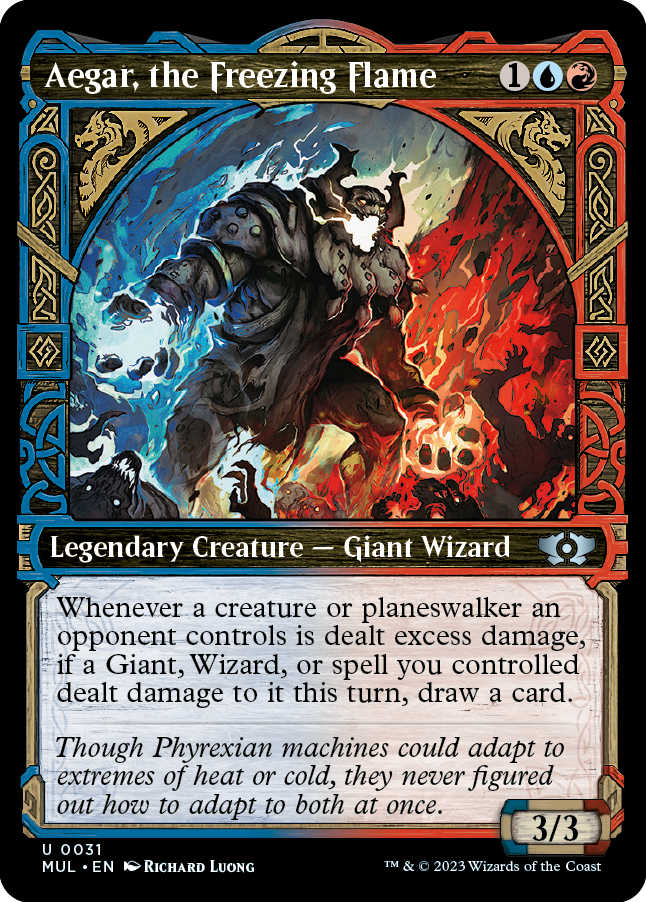
Aegar, the Freezing Flame
{1}{U}{R}
Legendary Creature — Giant Wizard
3/3
Whenever a creature or planeswalker an opponent controls is dealt excess damage, if a Giant, Wizard, or spell you controlled dealt damage to it this turn, draw a card.
- A creature has been dealt excess damage if one or more sources deal more damage to it than the minimum amount of damage required to be lethal damage. In most cases, this means damage greater than its toughness, but consider the damage already dealt to it that turn.
- A planeswalker is dealt excess damage if it's dealt damage greater than its current loyalty.
- Aegar's ability won't trigger when a battle is dealt excess damage. It's not his fault. They didn't exist yet.
- Even 1 damage dealt to a creature from a source with deathtouch is considered lethal damage, so any amount greater than that will cause excess damage to be dealt, even if the total amount of damage isn't greater than the creature's toughness. Note that a source of damage having deathtouch has no effect on damage dealt to planeswalkers.
- It doesn't matter whether a Giant, Wizard, or spell you control deals the excess damage, only that excess damage was dealt and that one of those three things dealt damage to the creature or planeswalker at some point during the turn. For example, if a 4/4 creature an opponent controls is dealt 2 damage by a spell you control and later that turn is dealt 3 damage by a spell another player controls, Aegar's ability will trigger.
- If a permanent is both a creature and a planeswalker, the minimum amount of damage to be considered lethal damage is used to determine if excess damage has been dealt. For example, if a 5/5 creature that's also a planeswalker with three loyalty counters on it is dealt 4 damage, it's been dealt 1 excess damage and Aegar's ability may trigger.
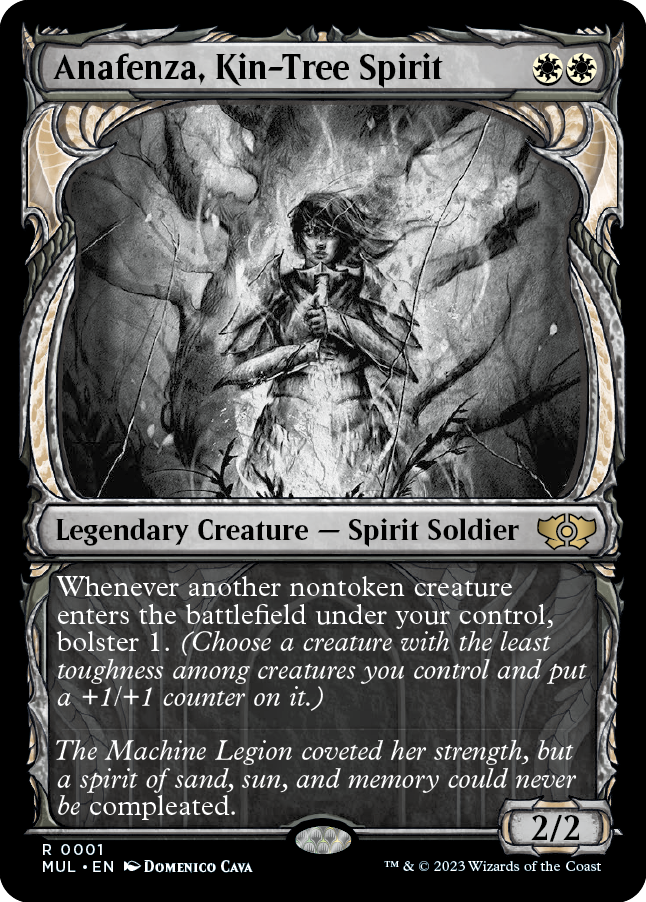
Anafenza, Kin-Tree Spirit
{W}{W}
Legendary Creature — Spirit Soldier
2/2
Whenever another nontoken creature enters the battlefield under your control, bolster 1. (Choose a creature with the least toughness among creatures you control and put a +1/+1 counter on it.)
- Bolster itself doesn't target any creature, though some spells and abilities that bolster may have other effects that target creatures.
- You determine which creature to put counter(s) on as the spell or ability that instructs you to bolster resolves. That could be the creature with the bolster ability, if it's still under your control and has the least toughness. If there's a tie, you choose which creature gets the counter(s).
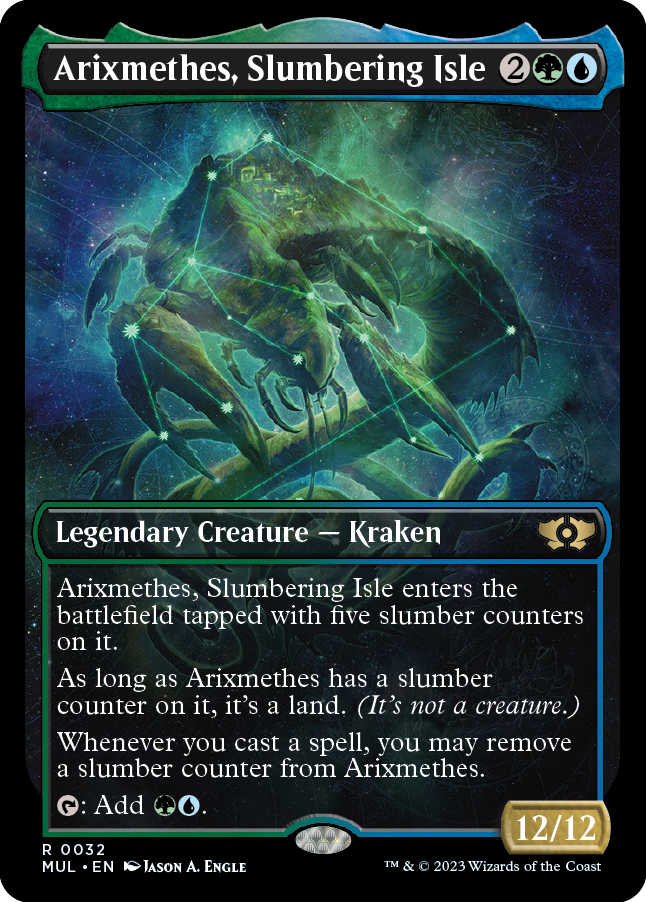
Arixmethes, Slumbering Isle
{2}{G}{U}
Legendary Creature — Kraken
12/12
Arixmethes, Slumbering Isle enters the battlefield tapped with five slumber counters on it.
As long as Arixmethes has a slumber counter on it, it's a land. (It's not a creature.)
Whenever you cast a spell, you may remove a slumber counter from Arixmethes.
{T}: Add {G}{U}.
- Arixmethes can't be played as a land.
- Arixmethes isn't a land until after it has entered the battlefield. Effects such as that of Blood Moon won't affect its enters-the-battlefield ability. Similarly, replacement effects that modify how creatures you control enter the battlefield will see Arixmethes entering as a creature rather than a land. However, triggered abilities (such as landfall abilities) will see that a land has entered the battlefield and not a creature.
- Arixmethes can tap for mana the turn it enters the battlefield as long as it has slumber counters on it. If you can figure out how to untap it, that is.
- While Arixmethes is a land, it's still green and blue, it's still legendary, and its mana value is still 4.
- Arixmethes's effect causing it to be a land overwrites any earlier effects that gave it additional types. For example, a Phyrexian Metamorph that copies Arixmethes will be a land, not an artifact land, until its slumber counters are removed.
- Arixmethes's triggered ability resolves before the spell that caused it to trigger, but after targets have been chosen for that spell. It resolves even if that spell is countered.
- Once Arixmethes is a creature again, it can attack on the same turn as long as you've controlled it since your most recent turn began.
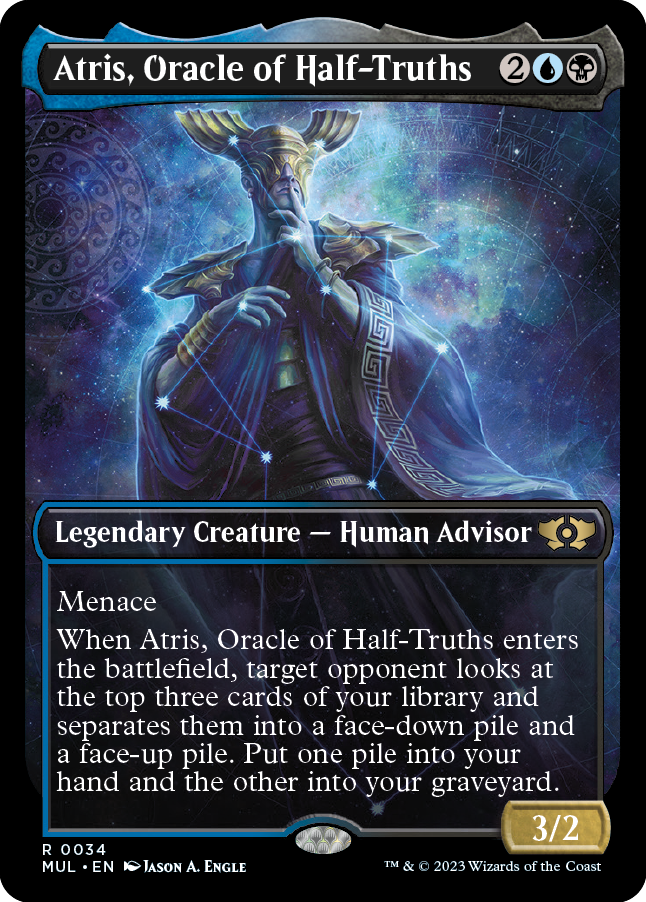
Atris, Oracle of Half-Truths
{2}{U}{B}
Legendary Creature — Human Advisor
3/2
Menace
When Atris, Oracle of Half-Truths enters the battlefield, target opponent looks at the top three cards of your library and separates them into a face-down pile and a face-up pile. Put one pile into your hand and the other into your graveyard.
- You choose just one target opponent to look at the top three cards of your library and put them into piles. Other players can't look, but they may attempt to offer advice without knowing what cards are there. The player who looks may also tell other players truths about those cards, or half-truths, or outright lies.
- You don't have to reveal the cards in the face-down pile if you put them into your hand.
- The opponent may split the cards into one pile of three cards and one pile of zero. The pile of three cards could be the face-up pile or the face-down pile. Sometimes your opponents seem very friendly, but keep in mind which god Atris serves.
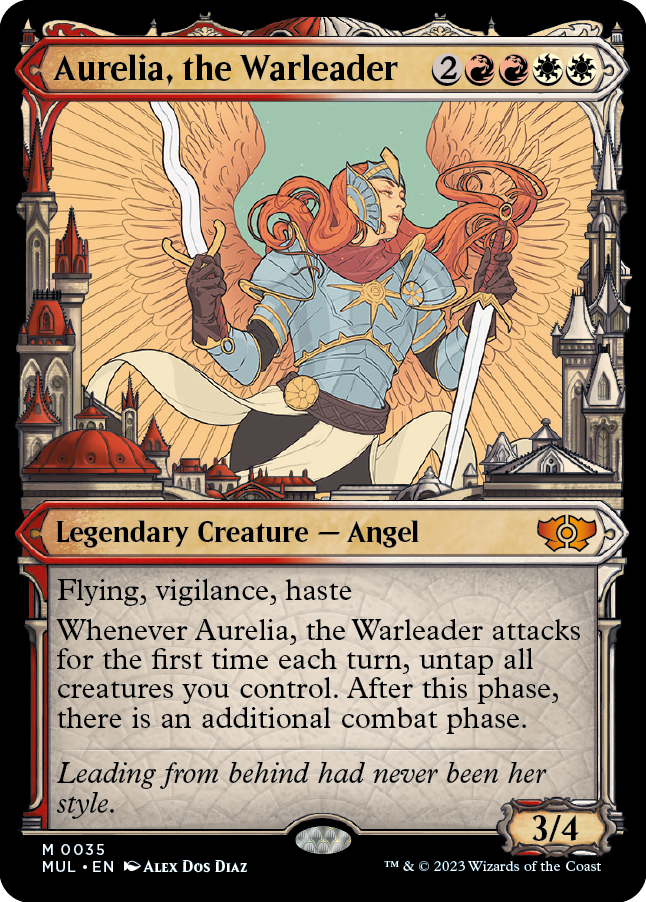
Aurelia, the Warleader
{2}{R}{R}{W}{W}
Legendary Creature — Angel
3/4
Flying, vigilance, haste
Whenever Aurelia, the Warleader attacks for the first time each turn, untap all creatures you control. After this phase, there is an additional combat phase.
- You untap all creatures you control, including ones that aren't attacking.
- You don't have to attack with any creatures during the additional combat phase.
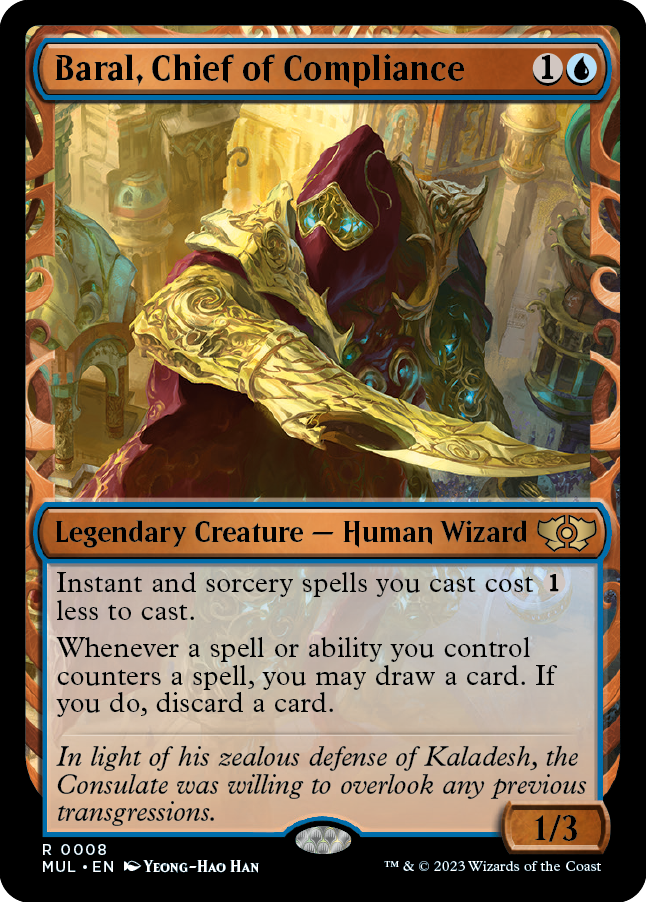
Baral, Chief of Compliance
{1}{U}
Legendary Creature — Human Wizard
1/3
Instant and sorcery spells you cast cost {1} less to cast.
Whenever a spell or ability you control counters a spell, you may draw a card. If you do, discard a card.
- The cost reduction applies only to generic mana in the cost of instant and sorcery spells you cast.
- To determine the total cost of a spell, start with the mana cost or alternative cost you're paying (such as a flashback cost), add any cost increases (such as kicker costs), then apply any cost reductions (such as that of Baral's first ability). The mana value of the spell is determined by only its mana cost, no matter what the total cost to cast that spell was.
- A spell or ability counters a spell only if it specifically contains the word "counter" in its text. If a spell or ability you control causes all the targets of a spell to become illegal, that spell doesn't resolve but it's not countered.
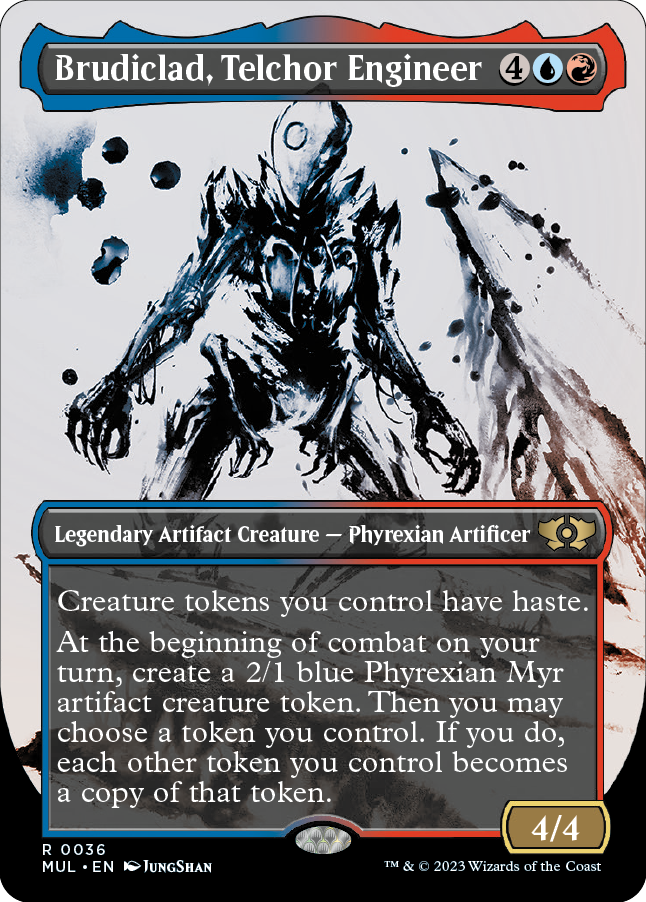
Brudiclad, Telchor Engineer
{4}{U}{R}
Legendary Artifact Creature — Phyrexian Artificer
4/4
Creature tokens you control have haste.
At the beginning of combat on your turn, create a 2/1 blue Phyrexian Myr artifact creature token. Then you may choose a token you control. If you do, each other token you control becomes a copy of that token.
- Once a creature token that came under your control this turn has legally attacked, causing it to lose haste by removing Brudiclad from the battlefield won't cause that token to stop attacking.
- The last effect of Brudiclad's triggered ability affects all tokens you control other than the chosen token, including the token that was just created if that isn't the chosen token.
- All other tokens you control become a copy of the chosen token, even those that aren't of the same type. For example, if you control a Treasure artifact token and choose the Myr token Brudiclad just created, your Treasure will become a copy of the Myr.
- The effect of Brudiclad's triggered ability lasts indefinitely. It continues to apply after Brudiclad leaves the battlefield.
- Brudiclad copies only the values defined as the original token was created (unless that token is copying something else; see below). It doesn't copy whether that token is tapped or untapped, whether it has any counters on it or any Auras and Equipment attached to it, or any non-copy effects that have changed its power, toughness, types, color, or so on.
- If the chosen token is copying something else (for example, if the chosen token was previously affected by Brudiclad's triggered ability), then your tokens become copies of whatever the chosen token copied.

Captain Lannery Storm
{2}{R}
Legendary Creature — Human Pirate
2/2
Haste
Whenever Captain Lannery Storm attacks, create a Treasure token.
Whenever you sacrifice a Treasure, Captain Lannery Storm gets +1/+0 until end of turn.
- You can activate the mana ability of a Treasure even if you have nothing to spend that mana on.
- Captain Lannery Storm's last ability triggers whenever you sacrifice a Treasure for any reason, not just to activate a Treasure's mana ability.
- If you sacrifice Treasures to cast Captain Lannery Storm, its last ability won't trigger for those Treasures.
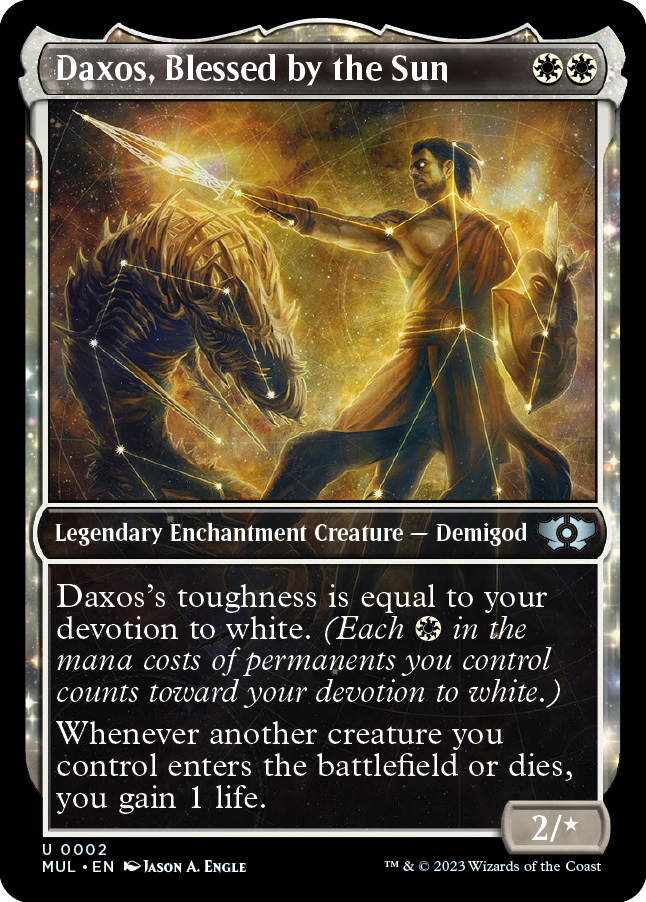
Daxos, Blessed by the Sun
{W}{W}
Legendary Enchantment Creature — Demigod
2/*
Daxos's toughness is equal to your devotion to white. (Each {W} in the mana costs of permanents you control counts toward your devotion to white.)
Whenever another creature you control enters the battlefield or dies, you gain 1 life.
- The ability that defines Daxos's toughness works in all zones, not just the battlefield. As long as Daxos is under your control, the two white mana symbols in its own mana cost will count. In most cases, it'll be at least 2/2.
- Colorless and generic mana symbols ({C}, {X}, {0}, {1}, {2}, and so on) in mana costs of permanents you control don't count toward your devotion to any color.
- Mana symbols in the text boxes of permanents you control don't count toward your devotion to any color.
- Hybrid mana symbols, monocolored hybrid mana symbols, and Phyrexian mana symbols do count toward your devotion to their color(s).
- If an activated ability or triggered ability has an effect that depends on your devotion to a color, you count the number of mana symbols of that color among the mana costs of permanents you control as the ability resolves. The permanent with that ability will be counted if it's still on the battlefield at that time.
- If you put an Aura on an opponent's permanent, you still control the Aura, and mana symbols in its mana cost count towards your devotion.
- If you control a battle and an opponent is its protector, you still control the battle, and mana symbols in its mana cost count toward your devotion.
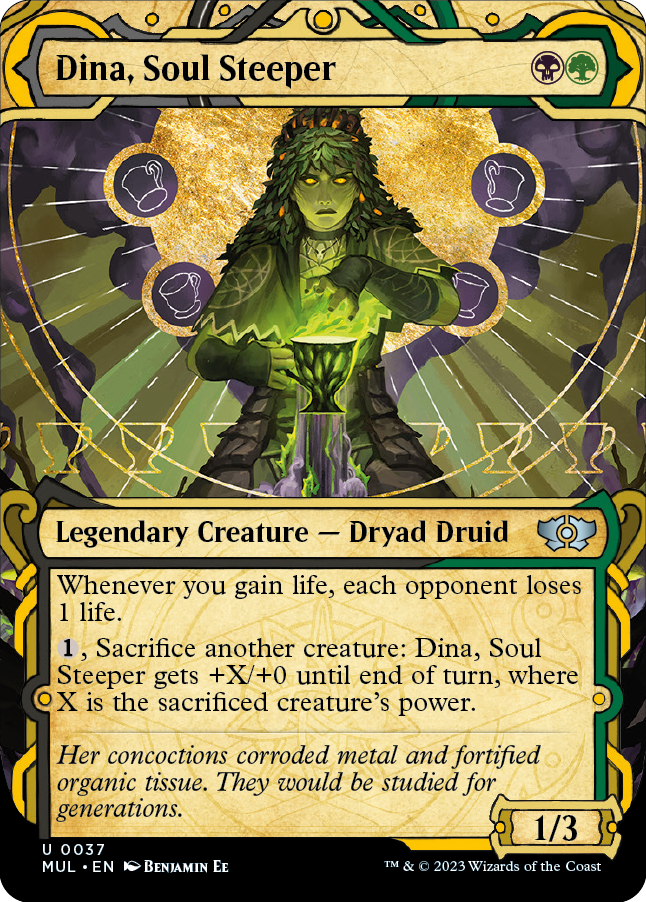
Dina, Soul Steeper
{B}{G}
Legendary Creature — Dryad Druid
1/3
Whenever you gain life, each opponent loses 1 life.
{1}, Sacrifice another creature: Dina, Soul Steeper gets +X/+0 until end of turn, where X is the sacrificed creature's power.
- Dina's first ability triggers only once for each life gain event, no matter how much life was gained.
- When Dina's first ability resolves, each opponent loses only 1 life, no matter how much life was gained.
- Each creature with lifelink dealing combat damage causes a separate life gain event. For example, if two creatures you control with lifelink deal combat damage at the same time, a "whenever you gain life" ability will trigger twice. However, if a single creature you control with lifelink deals combat damage to multiple creatures, players, and/or planeswalkers at the same time (perhaps because it has trample or was blocked by more than one creature), the ability will trigger only once.
- X is the power the creature had when it was on the battlefield, not the power it has in the graveyard.
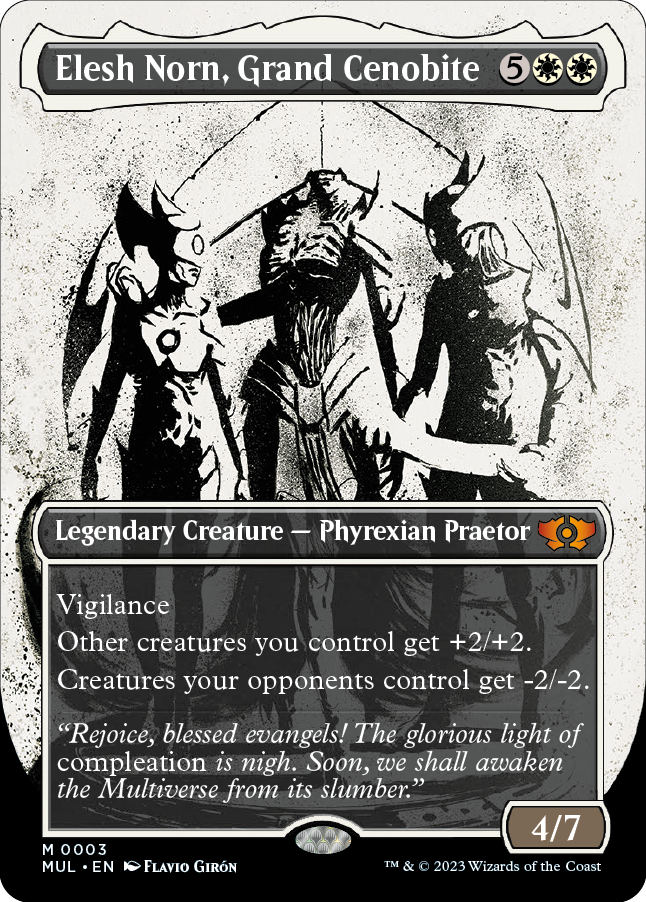
Elesh Norn, Grand Cenobite
{5}{W}{W}
Legendary Creature — Phyrexian Praetor
4/7
Vigilance
Other creatures you control get +2/+2.
Creatures your opponents control get -2/-2.
- If a second Elesh Norn, Grand Cenobite comes under your control, you'll put one into its owner's graveyard due to the "legend rule" at the same time that any of your opponents' creatures getting -4/-4 are put into their owner's graveyard for having 0 or less toughness.
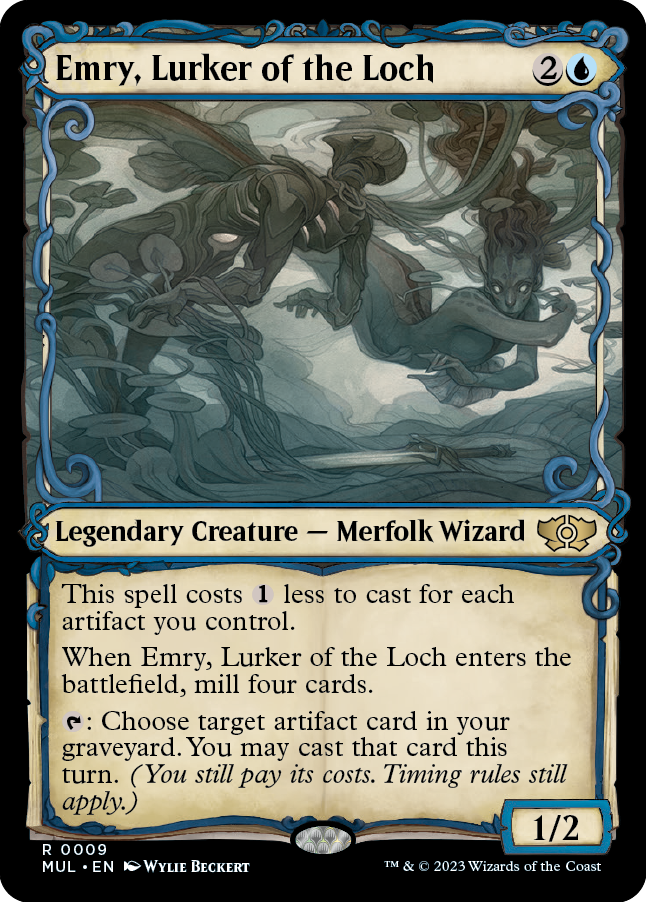
Emry, Lurker of the Loch
{2}{U}
Legendary Creature — Merfolk Wizard
1/2
This spell costs {1} less to cast for each artifact you control.
When Emry, Lurker of the Loch enters the battlefield, mill four cards.
{T}: Choose target artifact card in your graveyard. You may cast that card this turn. (You still pay its costs. Timing rules still apply.)
- To determine the total cost of a spell, start with the mana cost or alternative cost you're paying, add any cost increases, then apply any cost reductions (such as that of Emry). The mana value of the spell remains unchanged, no matter what the total cost to cast it was.
- The cost reduction ability reduces only the generic mana in Emry's cost. The colored mana must still be paid.
- Once you announce that you're casting a spell, no player may take actions until the spell has been paid for. Notably, opponents can't try to change by how much Emry's cost is reduced.
- If Emry's last ability targets an artifact land card, you can't play it. Effects that allow you to "cast" a card don't allow you to play a land card.
- You must follow the normal timing permissions and restrictions for the target artifact card. Unless it has flash, you'll most likely only be able to cast it during your main phase while the stack is empty.
- You'll still pay all costs for a spell cast this way, including additional costs. You may also pay alternative costs if any are available.
- Casting the target card causes it to leave your graveyard and become a new object. You can't cast it again if it returns to your graveyard this turn.
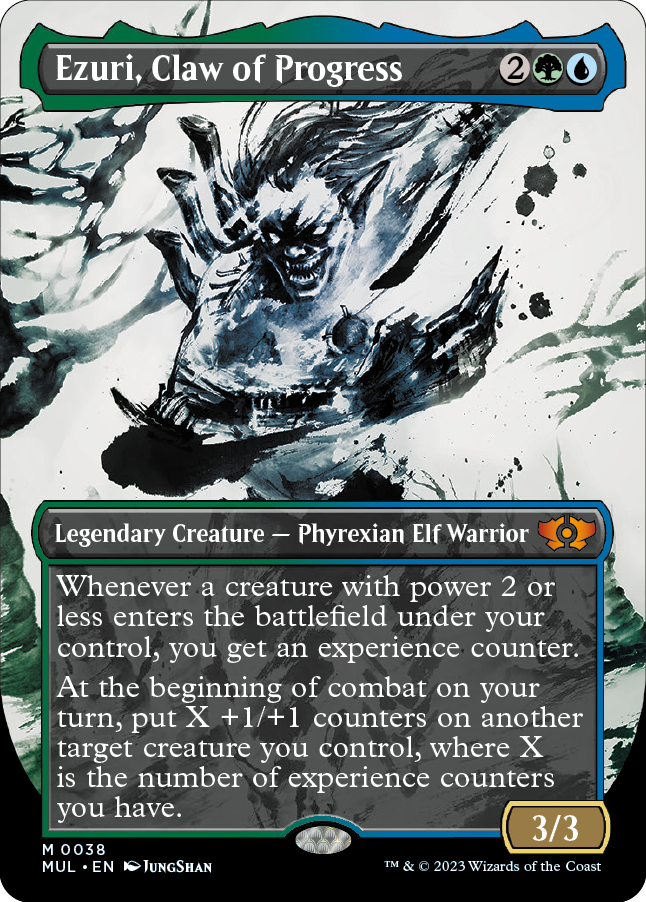
Ezuri, Claw of Progress
{2}{G}{U}
Legendary Creature — Phyrexian Elf Warrior
3/3
Whenever a creature with power 2 or less enters the battlefield under your control, you get an experience counter.
At the beginning of combat on your turn, put X +1/+1 counters on another target creature you control, where X is the number of experience counters you have.
- All experience counters are identical, no matter how you got them. For example, the last ability will count experience counters that you got from the first ability, from another ability, from proliferating, and so on.

Firesong and Sunspeaker
{4}{R}{W}
Legendary Creature — Minotaur Cleric
4/6
Red instant and sorcery spells you control have lifelink.
Whenever a white instant or sorcery spell causes you to gain life, Firesong and Sunspeaker deals 3 damage to target creature or player.
- If a source you control with lifelink deals damage to you, you gain and lose that much life simultaneously. Your life total doesn't change.
- The last ability of Firesong and Sunspeaker can't target a planeswalker or battle.
- A spell causes you to gain life if its cost or effect instructs you to gain life or if an instruction in its cost or effect is modified by a replacement effect and the modified event includes you gaining life. If a spell's cost or effect instructs a source with lifelink you control to deal damage, that spell causes that life gain as well.
- If a white instant or sorcery spell you don't control causes you to gain life, Firesong and Sunspeaker's last ability triggers.
- If you gain an amount of life "for each" of something, that life is gained as one event and Firesong and Sunspeaker's last ability triggers only once.
- Firesong and Sunspeaker's last ability doesn't trigger if a triggered ability of a white instant or sorcery spell or card causes you to gain life, such as the triggered ability of Renewed Faith when it's cycled.
- If a red and white spell you control deals damage to multiple things using the word "deals" only once, Firesong and Sunspeaker's last ability triggers only once. Similarly, if a red and white spell's effect causes it to deal damage to one thing and then deal more damage with a second instance of the word "deals," Firesong and Sunspeaker's last ability triggers twice, and so on.
- If a red and white spell you control deals damage and also instructs you to gain life, Firesong and Sunspeaker's last ability triggers twice.
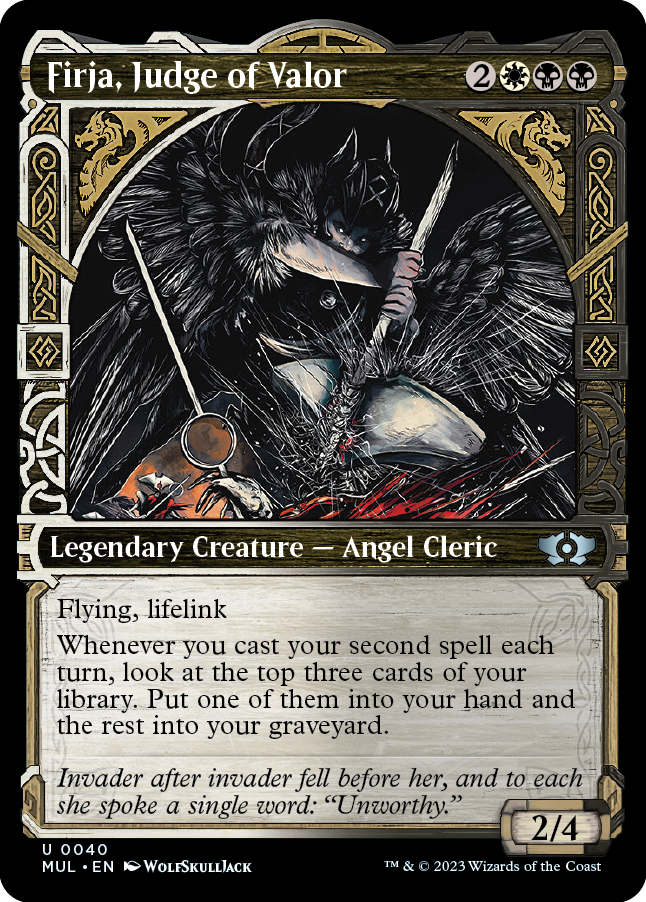
Firja, Judge of Valor
{2}{W}{B}{B}
Legendary Creature — Angel Cleric
2/4
Flying, lifelink
Whenever you cast your second spell each turn, look at the top three cards of your library. Put one of them into your hand and the rest into your graveyard.
- The triggered ability can trigger only once each turn. The ability will resolve before the second spell does. It doesn't matter if the first spell you cast that turn resolved, didn't resolve, was countered, or is still on the stack.
- The triggered ability triggers only if the creature that has it is on the battlefield as you cast your second spell. Spells you cast in a turn before that creature entered the battlefield will count. In other words, the ability won't trigger if the creature with the ability is the second spell you cast during a turn or if you have already cast two or more spells by the time that creature enters the battlefield that turn.
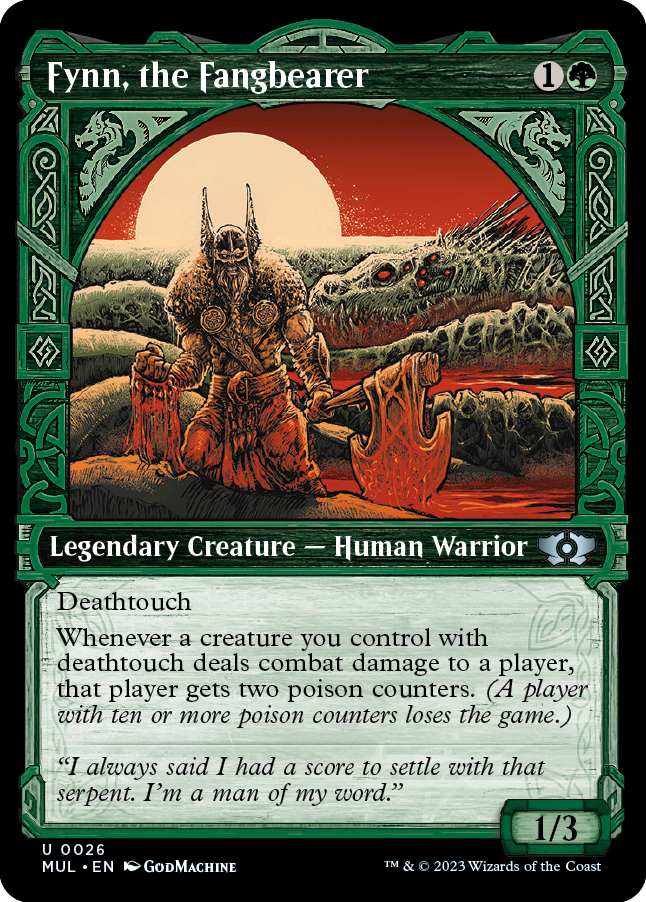
Fynn, the Fangbearer
{1}{G}
Legendary Creature — Human Warrior
1/3
Deathtouch
Whenever a creature you control with deathtouch deals combat damage to a player, that player gets two poison counters. (A player with ten or more poison counters loses the game.)
- Losing the game because a player (preferably an opponent) has ten or more poison counters is a rule of the game. Fynn doesn't have to still be on the battlefield when someone (preferably an opponent) gets their tenth poison counter.

Goreclaw, Terror of Qal Sisma
{3}{G}
Legendary Creature — Bear
4/3
Creature spells you cast with power 4 or greater cost {2} less to cast.
Whenever Goreclaw, Terror of Qal Sisma attacks, each creature you control with power 4 or greater gets +1/+1 and gains trample until end of turn.
- If you cast a creature spell that will enter the battlefield with a number of +1/+1 counters, those counters aren't considered when determining whether Goreclaw reduces that spell's cost. Similarly, effects that will raise the creature's power once it has entered the battlefield won't apply.
- If another creature has an ability that changes its power when it attacks, such as Brawl-Bash Ogre, you may have that ability resolve before Goreclaw's last ability.
- Goreclaw's last ability affects only creatures you control with the appropriate power at the time it resolves. Creatures you begin to control later in the turn won't get either bonus, and a creature you control whose power decreases later in the turn won't lose either bonus.

Grimgrin, Corpse-Born
{3}{U}{B}
Legendary Creature — Zombie Warrior
5/5
Grimgrin, Corpse-Born enters the battlefield tapped and doesn't untap during your untap step.
Sacrifice another creature: Untap Grimgrin and put a +1/+1 counter on it.
Whenever Grimgrin attacks, destroy target creature defending player controls, then put a +1/+1 counter on Grimgrin.
- If Grimgrin's last ability resolves, but the targeted creature isn't destroyed (perhaps because it regenerated or has indestructible), you'll still put a +1/+1 on Grimgrin.

Horobi, Death's Wail
{2}{B}{B}
Legendary Creature — Spirit
4/4
Flying
Whenever a creature becomes the target of a spell or ability, destroy that creature.
- If the creature is the only target of the spell or ability, that spell or ability won't resolve.
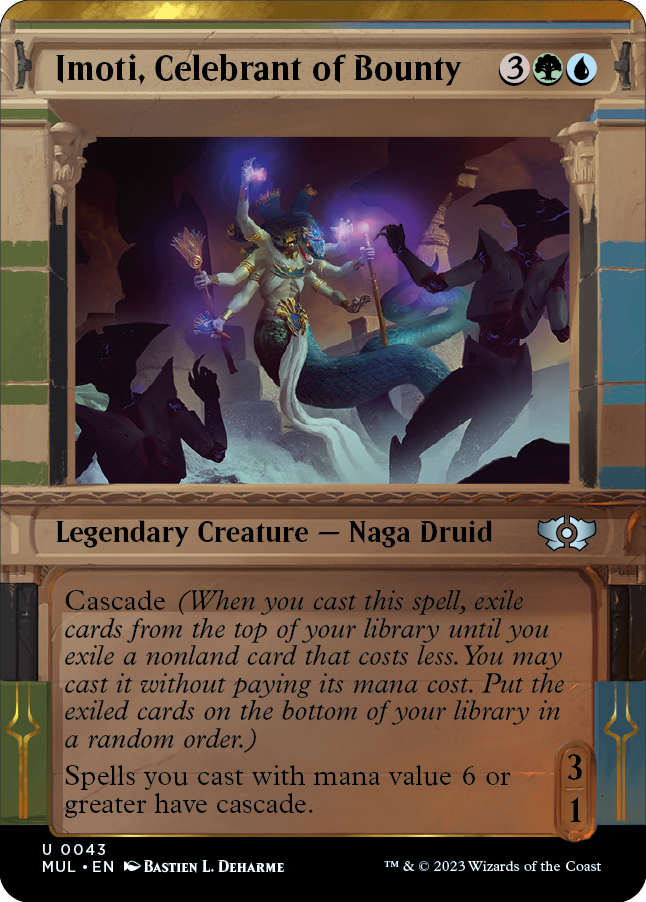
Imoti, Celebrant of Bounty
{3}{G}{U}
Legendary Creature — Naga Druid
3/1
Cascade (When you cast this spell, exile cards from the top of your library until you exile a nonland card that costs less. You may cast it without paying its mana cost. Put the exiled cards on the bottom of your library in a random order.)
Spells you cast with mana value 6 or greater have cascade.
- A spell's mana value is determined only by its mana cost. Ignore any alternative costs, additional costs, cost increases, or cost reductions.
- Cascade triggers when you cast the spell, meaning that it resolves before that spell. If you end up casting the exiled card, it will go on the stack above the spell with cascade.
- When the cascade ability resolves, you must exile cards. The only optional part of the ability is whether or not you cast the last card exiled.
- If a spell with cascade is countered, the cascade ability will still resolve normally.
- You exile the cards face up. All players will be able to see them.
- If you cast a card "without paying its mana cost," you can't choose to cast it for any alternative costs. You can, however, pay additional costs. If the card has any mandatory additional costs, you must pay those to cast the card.
- If the card has {X} in its mana cost, you must choose 0 as the value of X when casting it without paying its mana cost.
- Not only do you stop exiling cards if you exile a nonland card with lesser mana value than the spell with cascade, but the resulting spell you cast must also have lesser mana value. Previously, in cases where a card's mana value differed from the resulting spell, such as with some modal double-faced cards or cards with an Adventure, you could cast a spell with a higher mana value than the exiled card.
- The mana value of a split card is determined by the combined mana cost of its two halves. If cascade allows you to cast a split card, you may cast either half but not both halves.
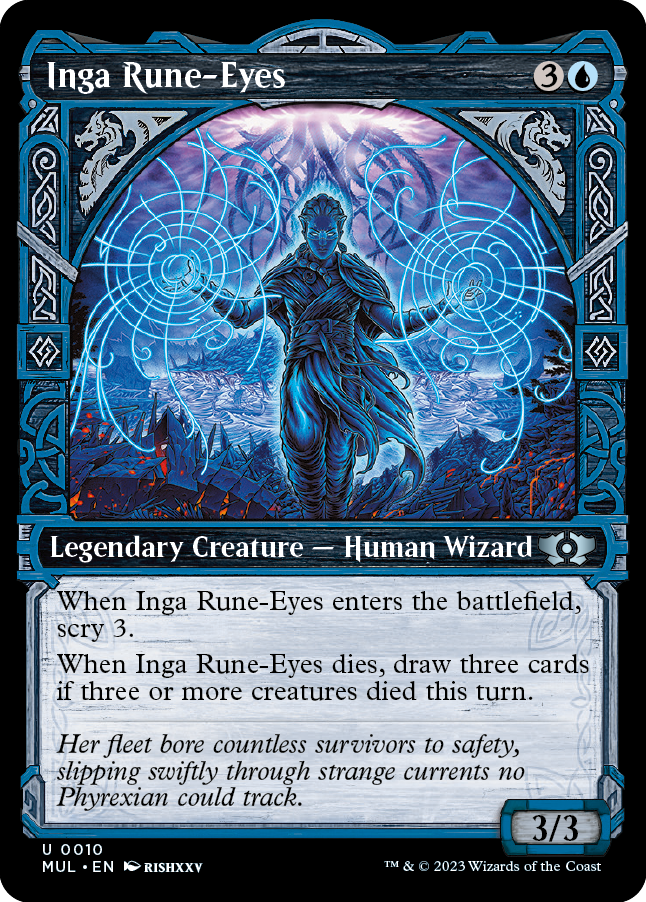
Inga Rune-Eyes
{3}{U}
Legendary Creature — Human Wizard
3/3
When Inga Rune-Eyes enters the battlefield, scry 3.
When Inga Rune-Eyes dies, draw three cards if three or more creatures died this turn.
- The number of creatures that have died that turn is checked as the last ability resolves. Inga Rune-Eyes will count, as will creatures that die at the same time as Inga Rune-Eyes and creatures that die while that ability is on the stack but has not yet resolved.
- The last ability will count any creature that died, no matter who controlled it.

Jegantha, the Wellspring
{4}{R/G}
Legendary Creature — Elemental Elk
5/5
Companion — No card in your starting deck has more than one of the same mana symbol in its mana cost. (If this card is your chosen companion, you may put it into your hand from outside the game for {3} as a sorcery.)
{T}: Add {W}{U}{B}{R}{G}. This mana can't be spent to pay generic mana costs.
- A generic mana cost is represented by numerical symbols ({1}, {2}, and so on) and {X}. You can't spend mana from Jegantha's mana ability on these costs.
- You can spend mana from Jegantha's mana ability to pay for a hybrid symbol such as {2/W}, but only if you choose to pay the colored mana component, not the generic mana component.
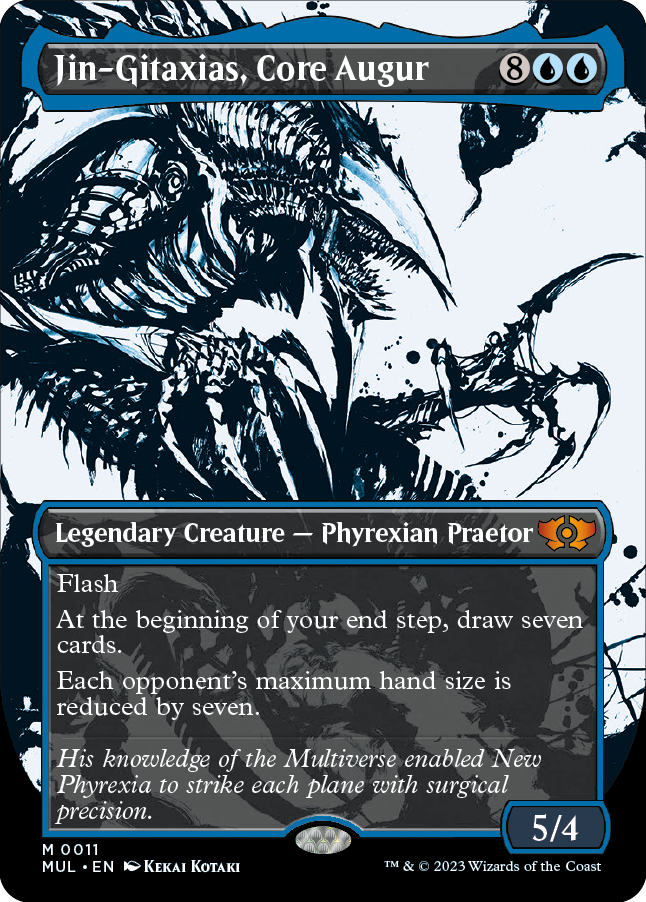
Jin-Gitaxias, Core Augur
{8}{U}{U}
Legendary Creature — Phyrexian Praetor
5/4
Flash
At the beginning of your end step, draw seven cards.
Each opponent's maximum hand size is reduced by seven.
- If a player has more cards in their hand than their maximum hand size during the cleanup step of that player's turn, that player discards until they have that many cards. A player's maximum hand size isn't checked at any time other than their own cleanup step.
- Jin-Gitaxias doesn't affect the maximum hand size of its controller. Because the cleanup step is after the end step, its controller may have to discard some of the cards that were just drawn.
- Unless another spell or ability is affecting your opponent's maximum hand size, Jin-Gitaxias's ability will result in your opponent having a maximum hand size of zero. They will discard each card from their hand during their cleanup step.
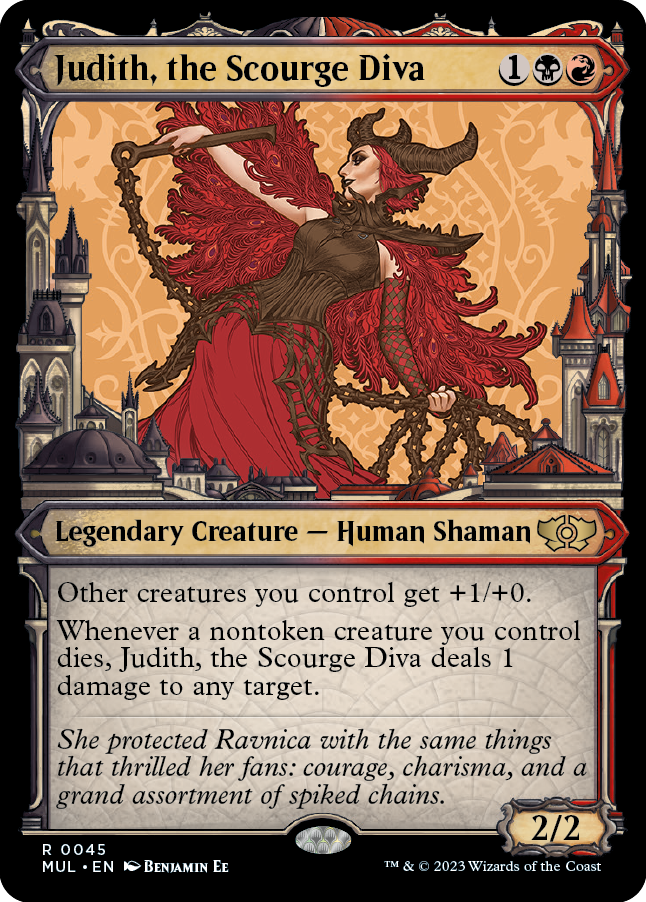
Judith, the Scourge Diva
{1}{B}{R}
Legendary Creature — Human Shaman
2/2
Other creatures you control get +1/+0.
Whenever a nontoken creature you control dies, Judith, the Scourge Diva deals 1 damage to any target.
- Judith's last ability triggers when Judith dies if it's not a token.
- If Judith dies at the same time as one or more other nontoken creatures you control, Judith's ability triggers for each of them.
- If your life total is brought to 0 or less at the same time that nontoken creatures you control are dealt lethal damage, you lose the game before Judith's triggered ability goes on the stack.

Juri, Master of the Revue
{B}{R}
Legendary Creature — Human Shaman
1/1
Whenever you sacrifice a permanent, put a +1/+1 counter on Juri, Master of the Revue.
When Juri dies, it deals damage equal to its power to any target.
- Juri's first ability doesn't allow you to sacrifice any permanents. You'll have to find another way to do that.
- For Juri's second ability, use its power from when it was last on the battlefield to determine how much damage is dealt. If that power was 0 or less, Juri deals no damage.

Kaheera, the Orphanguard
{1}{G/W}{G/W}
Legendary Creature — Cat Beast
3/2
Companion — Each creature card in your starting deck is a Cat, Elemental, Nightmare, Dinosaur, or Beast card. (If this card is your chosen companion, you may put it into your hand from outside the game for {3} as a sorcery.)
Vigilance
Each other creature you control that's a Cat, Elemental, Nightmare, Dinosaur, or Beast gets +1/+1 and has vigilance.
- A creature you control that's more than one of the listed types would get +1/+1 and gain vigilance from Kaheera's last ability.
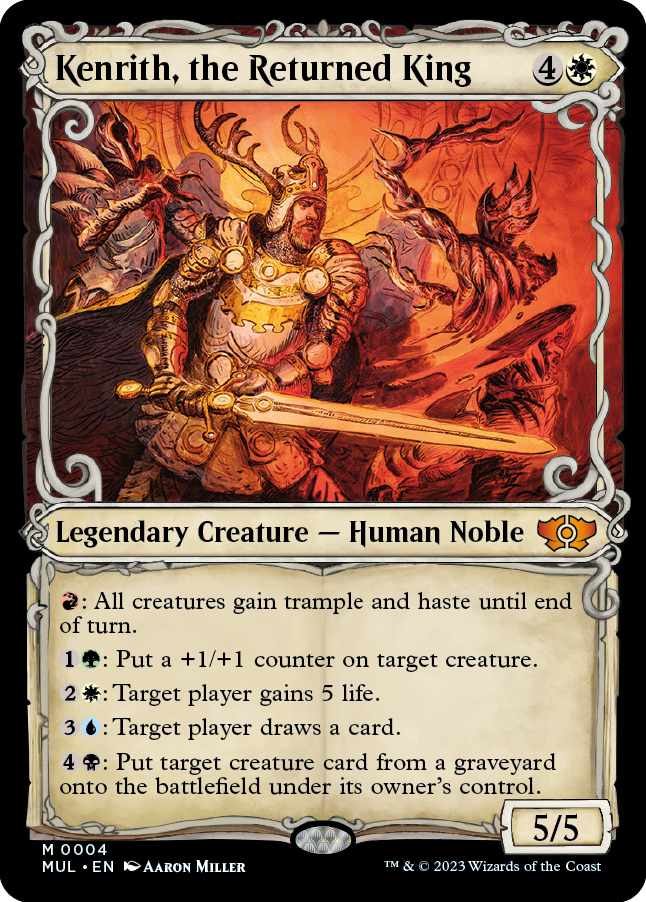
Kenrith, the Returned King
{4}{W}
Legendary Creature — Human Noble
5/5
{R}: All creatures gain trample and haste until end of turn.
{1}{G}: Put a +1/+1 counter on target creature.
{2}{W}: Target player gains 5 life.
{3}{U}: Target player draws a card.
{4}{B}: Put target creature card from a graveyard onto the battlefield under its owner's control.
- Kenrith's first ability affects only creatures on the battlefield at the time it resolves. Creatures that enter the battlefield later in the turn won't gain trample or haste.
- Kenrith's last ability can target a creature card in any player's graveyard. Its owner will control the creature, and it will remain on the battlefield even if you leave the game (if you don't own it).
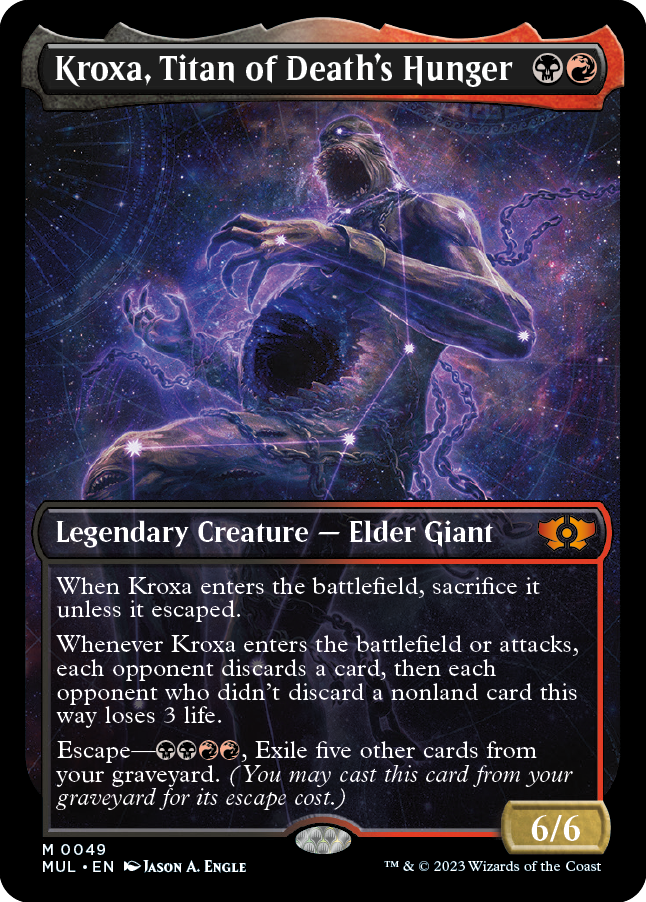
Kroxa, Titan of Death's Hunger
{B}{R}
Legendary Creature — Elder Giant
6/6
When Kroxa enters the battlefield, sacrifice it unless it escaped.
Whenever Kroxa enters the battlefield or attacks, each opponent discards a card, then each opponent who didn't discard a nonland card this way loses 3 life.
Escape—{B}{B}{R}{R}, Exile five other cards from your graveyard. (You may cast this card from your graveyard for its escape cost.)
- To resolve Kroxa's second triggered ability in a multiplayer game, the next opponent in turn order (or, if it's an opponent's turn, the opponent whose turn it is) chooses a card in hand and sets it aside without revealing it. Then each other opponent in turn order does the same. Next, all chosen cards are revealed and discarded at the same time. Finally, each opponent who didn't discard a nonland card loses 3 life.
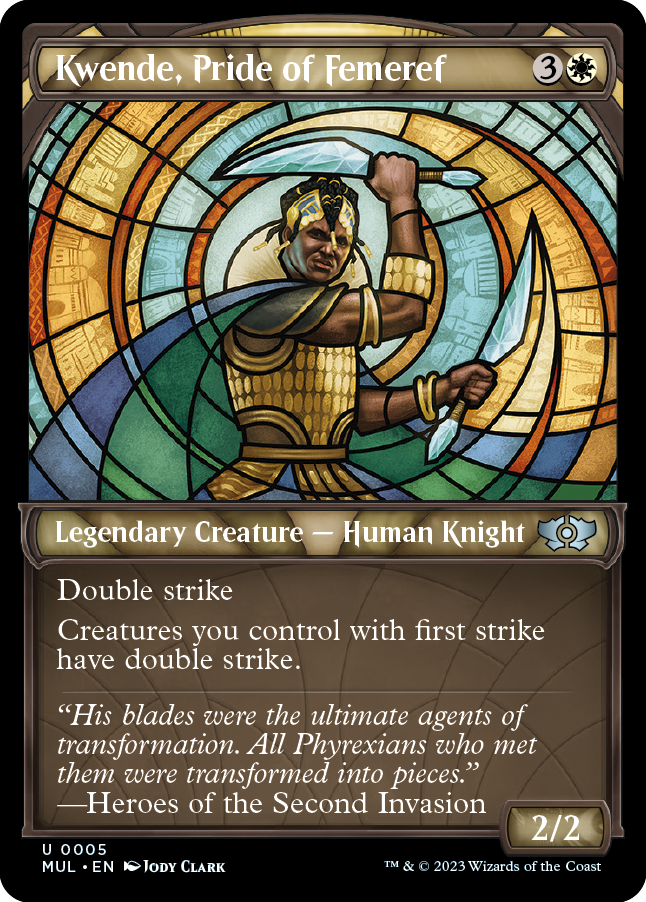
Kwende, Pride of Femeref
{3}{W}
Legendary Creature — Human Knight
2/2
Double strike
Creatures you control with first strike have double strike.
- A creature with first strike and double strike deals combat damage the same as a creature with double strike. It doesn't deal damage three times or before other creatures with first strike.
- If a creature you control gains first strike after Kwende has entered the battlefield, that creature also gains double strike.
- If a creature loses double strike after first strike damage is dealt, it won't deal normal combat damage.
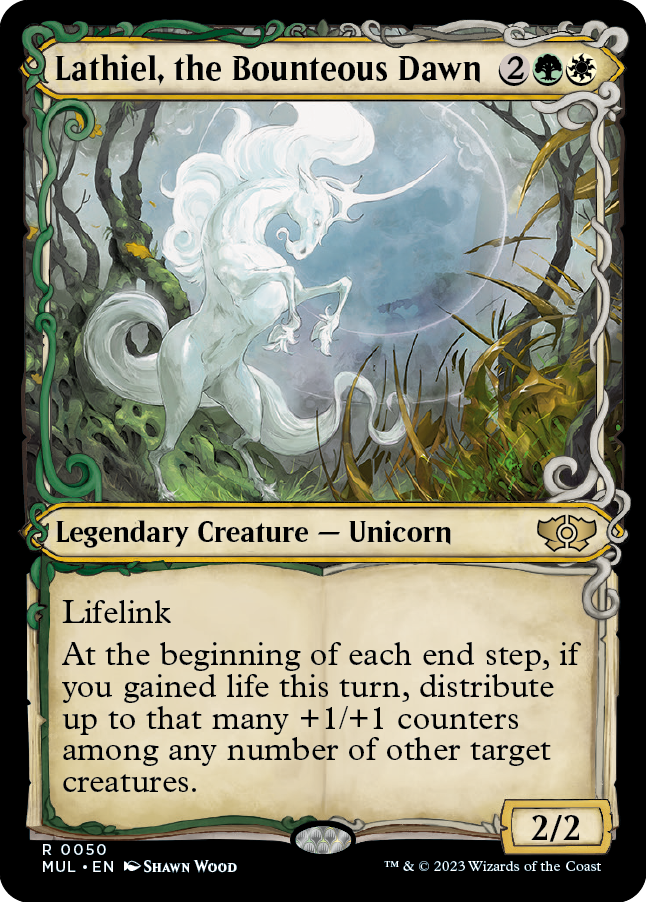
Lathiel, the Bounteous Dawn
{2}{G}{W}
Legendary Creature — Unicorn
2/2
Lifelink
At the beginning of each end step, if you gained life this turn, distribute up to that many +1/+1 counters among any number of other target creatures.
- As each end step begins, if you haven't gained life that turn, Lathiel's triggered ability won't trigger at all. If it does trigger, you choose the targets and how the +1/+1 counters will be distributed as you put the ability on the stack. Each target must receive at least one +1/+1 counter.
- You may choose no targets if you want. In that case, no +1/+1 counters are put on any creature.
- If some, but not all, of the creatures are illegal targets as the triggered ability tries to resolve, the original distribution of counters still applies and the counters that would have been put on illegal targets are lost. If all of the creatures are illegal targets, the ability won't resolve.
- Gaining more life in response to the triggered ability won't change how many counters will be distributed, nor will it change the distribution.
- The triggered ability will consider the total amount of life you've gained that turn, not how your life total has changed. For example, if you start the turn at 10 life, then gain 5 life, and then lose 7 life, you'll distribute five +1/+1 counters, even though your life total is now lower than it was at the beginning of the turn.
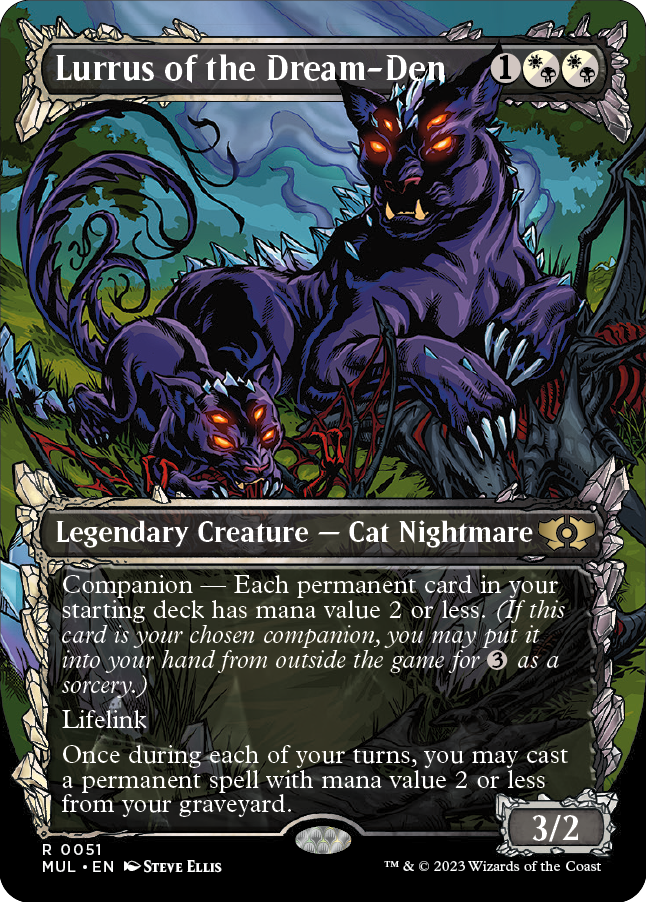
Lurrus of the Dream-Den
{1}{W/B}{W/B}
Legendary Creature — Cat Nightmare
3/2
Companion — Each permanent card in your starting deck has mana value 2 or less. (If this card is your chosen companion, you may put it into your hand from outside the game for {3} as a sorcery.)
Lifelink
Once during each of your turns, you may cast a permanent spell with mana value 2 or less from your graveyard.
- Casting the permanent spell from your graveyard follows the normal rules for casting that spell. You must pay its costs, and you must follow all applicable timing rules. For example, you may cast a creature spell this way by paying its mana cost only during your main phase while the stack is empty.
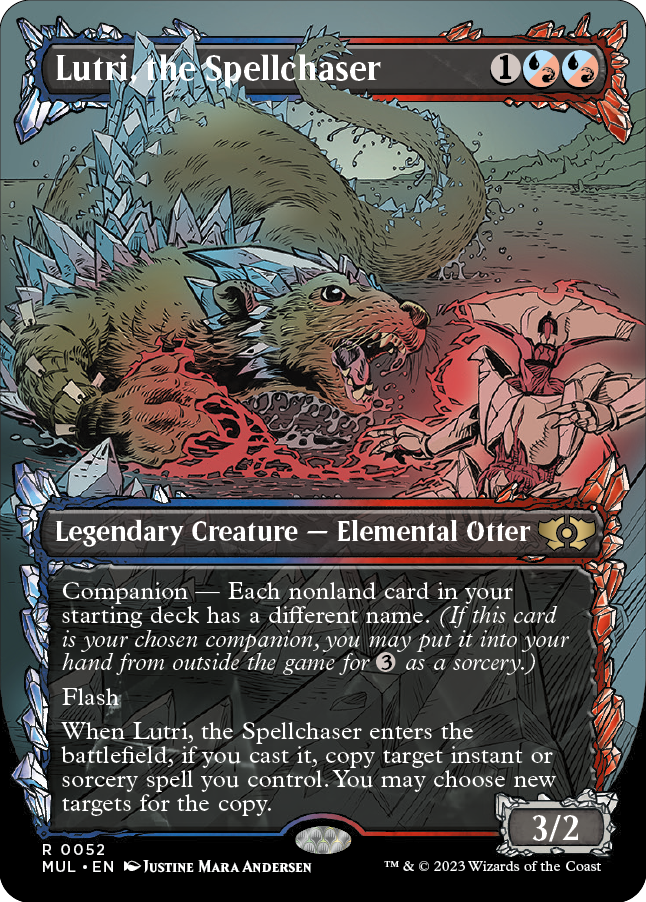
Lutri, the Spellchaser
{1}{U/R}{U/R}
Legendary Creature — Elemental Otter
3/2
Companion — Each nonland card in your starting deck has a different name. (If this card is your chosen companion, you may put it into your hand from outside the game for {3} as a sorcery.)
Flash
When Lutri, the Spellchaser enters the battlefield, if you cast it, copy target instant or sorcery spell you control. You may choose new targets for the copy.
- A copy of a spell is created on the stack, so it's not "cast." Abilities that trigger when a player casts a spell won't trigger.
- If you copy a spell, you control the copy. It will resolve before the original spell does.
- The copy will have the same targets as the spell it's copying unless you choose new ones. You may change any number of the targets, including all of them or none of them. If, for one of the targets, you can't choose a new legal target, then it remains unchanged (even if the current target is illegal).
- If the spell that's copied is modal (that is, it includes a choice from a bulleted list of effects), the copy will have the same mode. A different mode can't be chosen.
- If the spell that's copied has an X whose value was determined as it was cast, the copy will have the same value of X.
- If the spell has damage divided as it was cast, the division can't be changed (although the targets receiving that damage still can). The same is true of spells that distribute counters.
- You can't choose to pay any alternative or additional costs for the copy of the spell. However, effects based on any alternative or additional costs that were paid for the original spell are copied as though those same costs were paid for the copy.
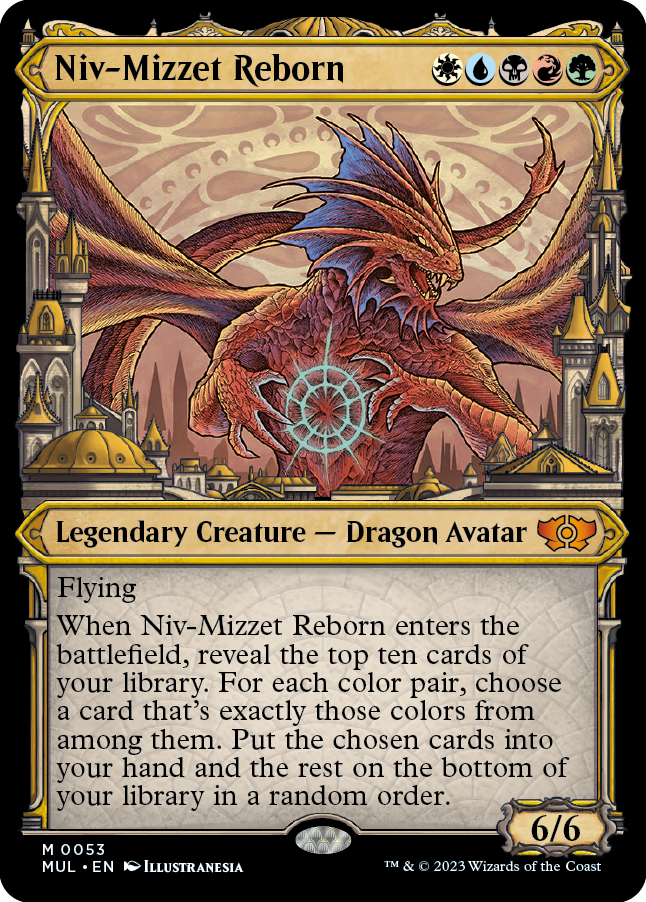
Niv-Mizzet Reborn
{W}{U}{B}{R}{G}
Legendary Creature — Dragon Avatar
6/6
Flying
When Niv-Mizzet Reborn enters the battlefield, reveal the top ten cards of your library. For each color pair, choose a card that's exactly those colors from among them. Put the chosen cards into your hand and the rest on the bottom of your library in a random order.
- A "color pair" is exactly two colors. There are ten color pairs in Magic: white-blue, white-black, blue-black, blue-red, black-red, black-green, red-green, red-white, green-white, and green-blue.
- If the top ten cards of your library don't contain all ten color pairs, you choose as many cards as you can and put those cards into your hand.
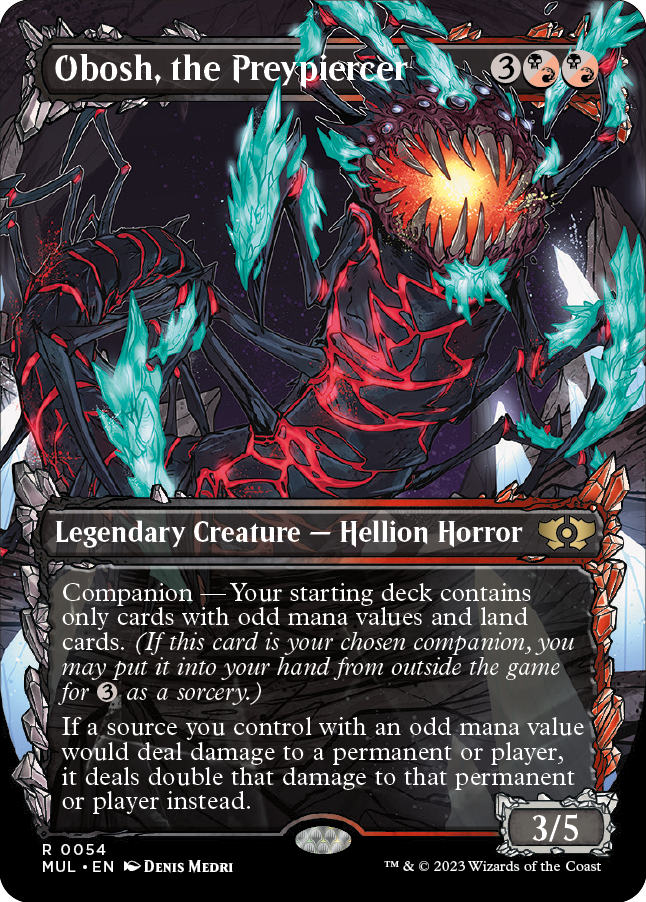
Obosh, the Preypiercer
{3}{B/R}{B/R}
Legendary Creature — Hellion Horror
3/5
Companion — Your starting deck contains only cards with odd mana values and land cards. (If this card is your chosen companion, you may put it into your hand from outside the game for {3} as a sorcery.)
If a source you control with an odd mana value would deal damage to a permanent or player, it deals double that damage to that permanent or player instead.
- The damage is dealt by the same source as the original source of damage. The doubled damage isn't dealt by Obosh unless it was the original source of damage.
- If another effect (or effects) modifies how much damage your creature with an odd mana value would deal—by preventing some of it, for example—the player being dealt damage or the controller of the permanent being dealt damage chooses the order in which any such effects (including Obosh's) apply. If all of the damage is prevented, Obosh's effect no longer applies.
- If damage dealt by a creature you control with an odd mana value is being divided or assigned among multiple permanents and/or players, that damage is divided or assigned before doubling. For example, if you attack with a 5/5 creature with trample and it's blocked by a 2/2 creature, you can assign 2 damage to the blocker and 3 damage to the defending player. Those amounts are then doubled to 4 and 6, respectively.

Raff, Weatherlight Stalwart
{W}{U}
Legendary Creature — Human Wizard
1/3
Whenever you cast an instant or sorcery spell, you may tap two untapped creatures you control. If you do, draw a card.
{3}{W}{W}: Creatures you control get +1/+1 and gain vigilance until end of turn.
- Raff, Weatherlight Stalwart's triggered ability resolves before the spell that caused it to trigger. The ability will resolve even if that spell is countered.

Ragavan, Nimble Pilferer
{R}
Legendary Creature — Monkey Pirate
2/1
Whenever Ragavan, Nimble Pilferer deals combat damage to a player, create a Treasure token and exile the top card of that player's library. Until end of turn, you may cast that card.
Dash {1}{R} (You may cast this spell for its dash cost. If you do, it gains haste, and it's returned from the battlefield to its owner's hand at the beginning of the next end step.)
- You'll create a Treasure token even if that player has no cards left in their library to exile.
- You must still follow all timing restrictions and pay all costs when casting the exiled card. If you exile a land card, you can't play that card.
- If you choose to pay the dash cost rather than the mana cost, you're still casting the spell. It goes on the stack and can be responded to and countered. You can cast a creature spell for its dash cost only when you otherwise could cast that creature spell. Most of the time, this means during your main phase when the stack is empty.
- If you pay the dash cost to cast a creature spell, that card will be returned to its owner's hand only if it's still on the battlefield when its triggered ability resolves. If it dies or goes to another zone before then, it will stay where it is.
- You don't have to attack with the creature with dash unless another ability says you do.
- If a creature enters the battlefield as a copy of or becomes a copy of a creature whose dash cost was paid, the copy won't have haste and won't be returned to its owner's hand.
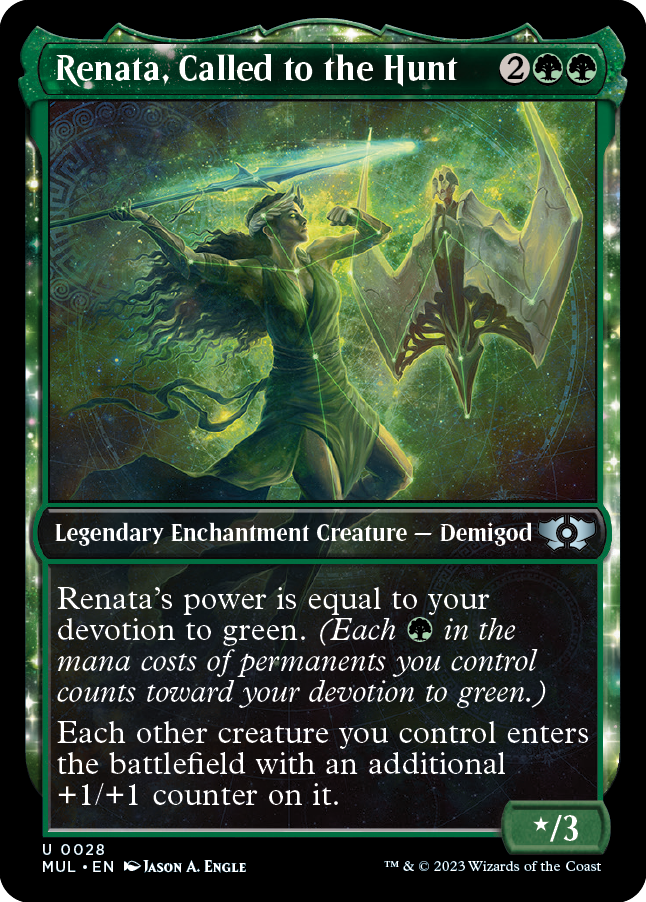
Renata, Called to the Hunt
{2}{G}{G}
Legendary Enchantment Creature — Demigod
*/3
Renata's power is equal to your devotion to green. (Each {G} in the mana costs of permanents you control counts toward your devotion to green.)
Each other creature you control enters the battlefield with an additional +1/+1 counter on it.
- Colorless and generic mana symbols ({C}, {0}, {1}, {2}, {X}, and so on) in mana costs of permanents you control don't count toward your devotion to any color.
- Mana symbols in the text boxes of permanents you control don't count toward your devotion to any color.
- Hybrid mana symbols, monocolored hybrid mana symbols, and Phyrexian mana symbols do count toward your devotion to their color(s).
- If an activated ability or triggered ability has an effect that depends on your devotion to a color, you count the number of mana symbols of that color among the mana costs of permanents you control as the ability resolves. The permanent with that ability will be counted if it's still on the battlefield at that time.
- If you put an Aura on an opponent's permanent, you still control the Aura, and mana symbols in its mana cost count towards your devotion.
- If you control a battle and an opponent is its protector, you still control the battle, and mana symbols in its mana cost count toward your devotion.
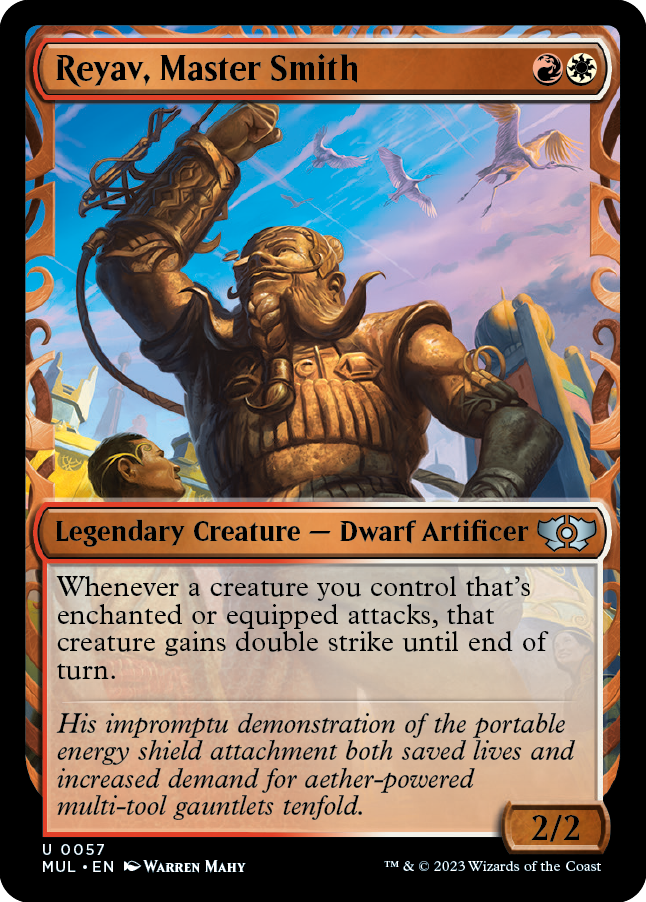
Reyav, Master Smith
{R}{W}
Legendary Creature — Dwarf Artificer
2/2
Whenever a creature you control that's enchanted or equipped attacks, that creature gains double strike until end of turn.
- If a creature you control that's enchanted and equipped attacks, Reyav's ability will trigger only once for that creature. (Don't worry. Multiple instances of double strike are redundant. You're not missing much.)
- The creature needs to be enchanted or equipped at the moment it's declared as an attacker to cause Reyav's ability to trigger. If the creature is no longer enchanted or equipped (or no longer attacking) as the ability tries to resolve, the ability still resolves.
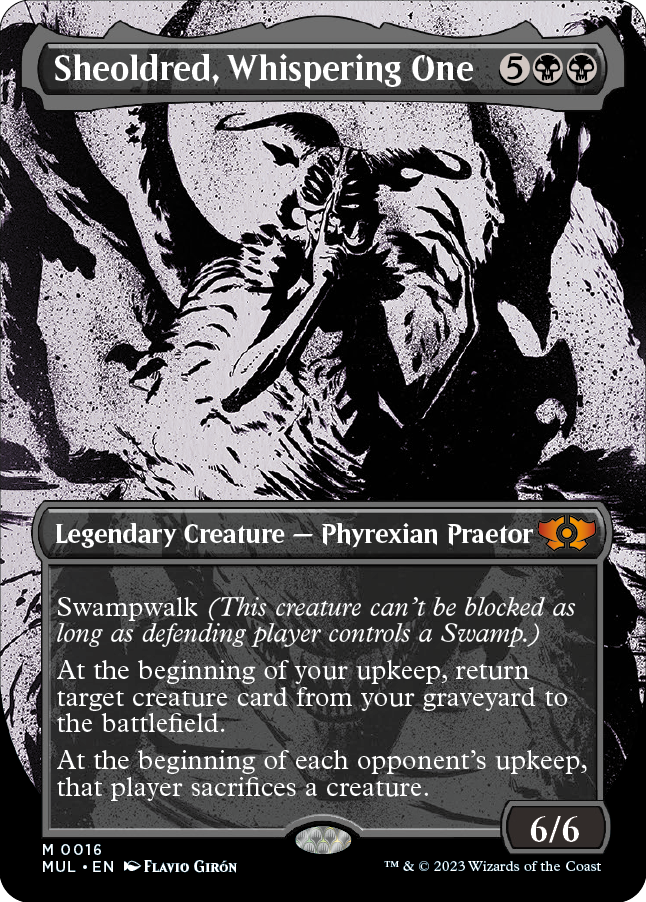
Sheoldred, Whispering One
{5}{B}{B}
Legendary Creature — Phyrexian Praetor
6/6
Swampwalk (This creature can't be blocked as long as defending player controls a Swamp.)
At the beginning of your upkeep, return target creature card from your graveyard to the battlefield.
At the beginning of each opponent's upkeep, that player sacrifices a creature.
- If another triggered ability during your upkeep causes you to sacrifice a creature, such as that of Lord of the Pit, you won't be able to target it with Sheoldred's triggered ability as that ability is put on the stack.
- The opponent whose upkeep it is chooses a creature to sacrifice when Sheoldred's second triggered ability resolves.
- In a Two-Headed Giant game, the last ability will trigger twice at the beginning of the opposing team's upkeep, once for each player on that team. Each player sacrifices only a creature they control.
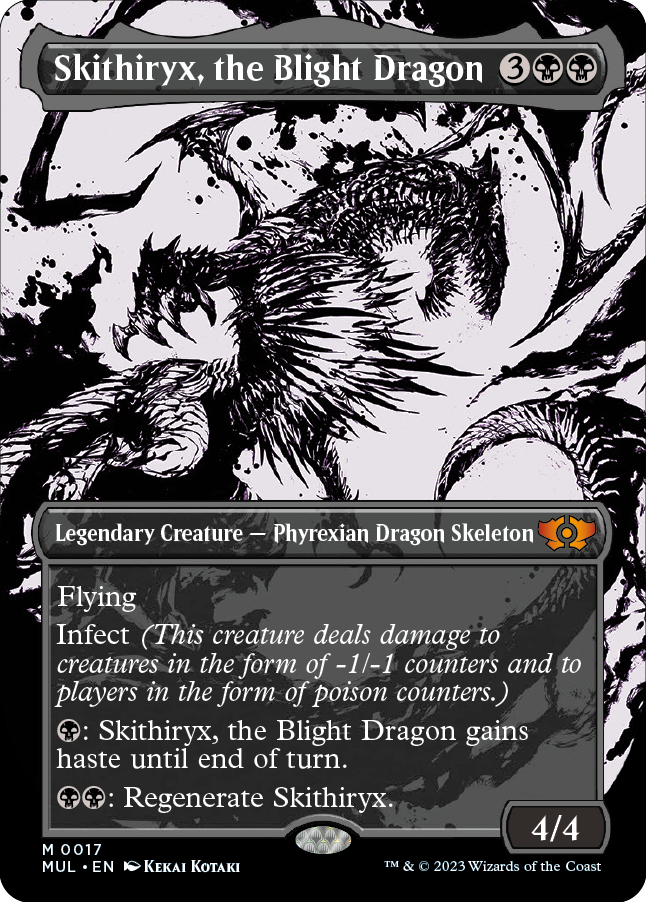
Skithiryx, the Blight Dragon
{3}{B}{B}
Legendary Creature — Phyrexian Dragon Skeleton
4/4
Flying
Infect (This creature deals damage to creatures in the form of -1/-1 counters and to players in the form of poison counters.)
{B}: Skithiryx, the Blight Dragon gains haste until end of turn.
{B}{B}: Regenerate Skithiryx.
- Damage that a creature with infect deals doesn't result in damage being marked on a creature or a player losing life. Instead, it results in that many -1/-1 counters being put on that creature or that many poison counters being given to that player. Damage dealt to planeswalkers still results in that planeswalker losing that many loyalty counters.
- A player who has ten or more poison counters loses the game. This is a state-based action.
- The -1/-1 counters remain on the creature indefinitely. They're not removed if the creature regenerates or the turn ends.
- Damage from a source with infect is damage in all respects. If the source with infect also has lifelink, damage dealt by that source also causes its controller to gain that much life. Damage from a source with infect can be prevented or redirected. Abilities that trigger on damage being dealt will trigger if a source with infect deals damage, if appropriate.
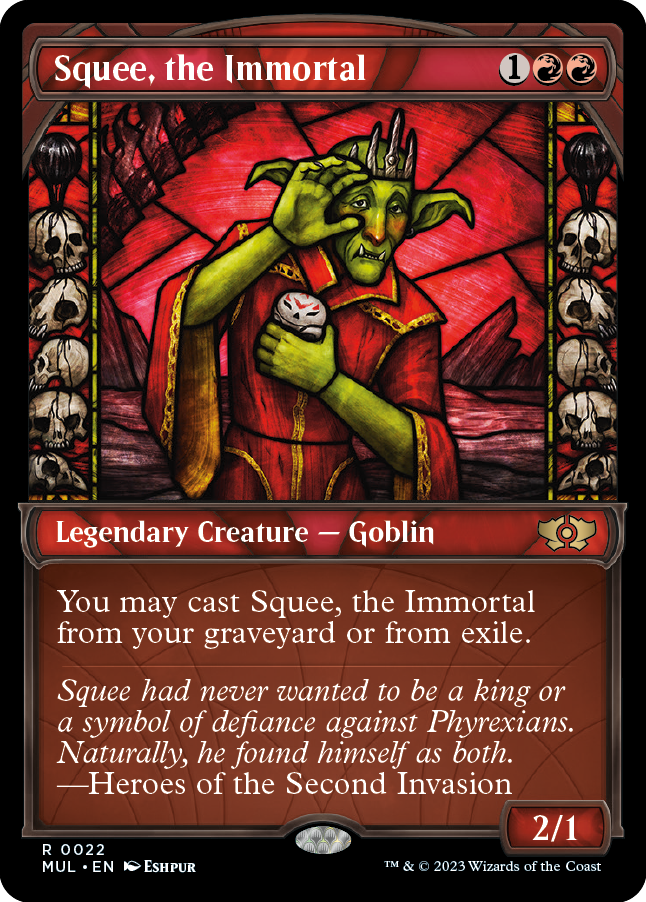
Squee, the Immortal
{1}{R}{R}
Legendary Creature — Goblin
2/1
You may cast Squee, the Immortal from your graveyard or from exile.
- Squee's ability doesn't prevent you from casting Squee from any other zone.
- You must follow the normal timing permissions and restrictions and pay its cost to cast Squee from your graveyard or from exile.
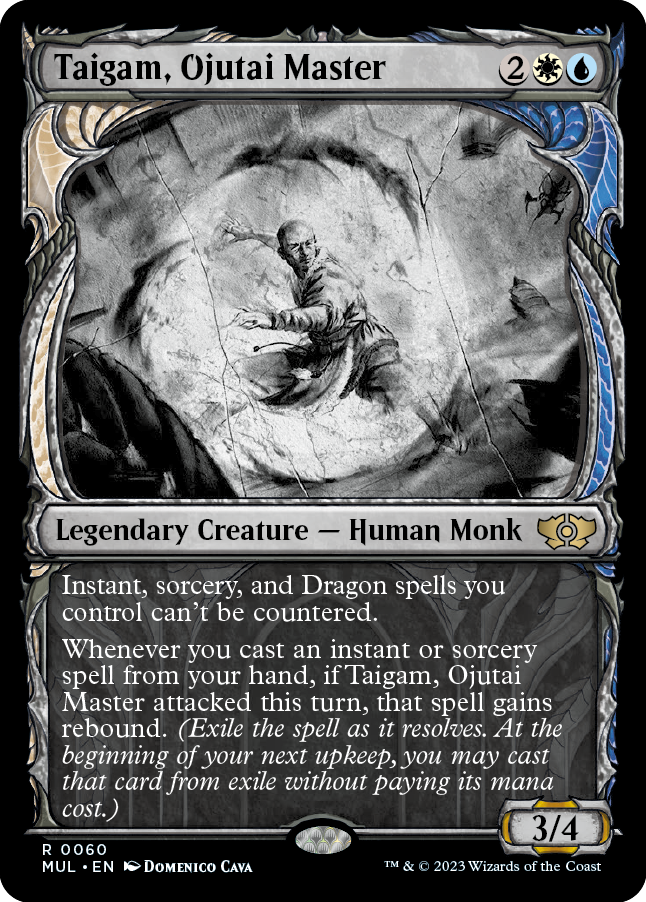
Taigam, Ojutai Master
{2}{W}{U}
Legendary Creature — Human Monk
3/4
Instant, sorcery, and Dragon spells you control can't be countered.
Whenever you cast an instant or sorcery spell from your hand, if Taigam, Ojutai Master attacked this turn, that spell gains rebound. (Exile the spell as it resolves. At the beginning of your next upkeep, you may cast that card from exile without paying its mana cost.)
- If Taigam leaves the battlefield after it attacks, its last ability won't trigger whenever you cast an instant or sorcery spell from your hand this turn. If it leaves the battlefield after the spell has gained rebound, that spell will still have rebound. Once the card is exiled, rebound's delayed triggered ability will trigger at the beginning of your next upkeep even if you no longer control Taigam.
- If Taigam is killed in response to you casting a spell, the ability will still trigger and your spell will gain rebound if Taigam attacked.
- Casting the card again due to rebound's delayed triggered ability is optional. If you choose not to cast the card, or if you can't (perhaps because there are no legal targets available), the card will stay exiled. You won't get another chance to cast it on a future turn.
- If a spell with rebound that you cast from your hand doesn't resolve for any reason (either because another spell or ability counters it or because all its targets are illegal as it tries to resolve), none of its effects will happen, including rebound. The spell will be put into its owner's graveyard and you won't get to cast it again on your next turn.
- If a replacement effect (such as the one created by Rest in Peace) would cause a spell with rebound that you cast from your hand to be put somewhere other than into your graveyard as it resolves, you can choose whether to apply the rebound effect or the other effect as the spell resolves.
- If a spell moves itself into another zone as part of its resolution (as Teferi's Protection, All Suns' Dawn, and Beacon of Unrest do), rebound won't get a chance to apply.
- At the beginning of your upkeep, all delayed triggered abilities created by rebound effects trigger. You may handle them in any order. A spell you cast this way resolves before you can cast the next one, so one rebounded spell can't target another. Timing restrictions based on the card's type (if it's a sorcery) are ignored. Other restrictions, such as "Cast [this spell] only during combat," must be followed.
- If you cast a card from exile, it will go to its owner's graveyard when it resolves, fails to resolve, or is countered. It won't go back to exile.
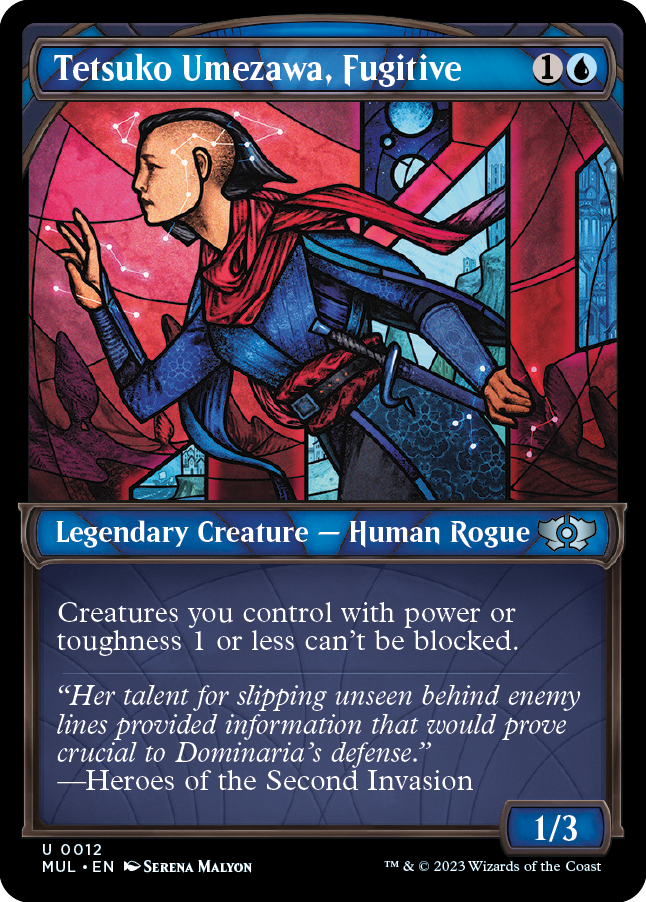
Tetsuko Umezawa, Fugitive
{1}{U}
Legendary Creature — Human Rogue
1/3
Creatures you control with power or toughness 1 or less can't be blocked.
- Once a creature you control has been blocked, changing its power to 1 or less won't cause it to become unblocked. Changing its toughness to 1 won't cause it to become unblocked, and changing its toughness to less than 1 will cause it to die.
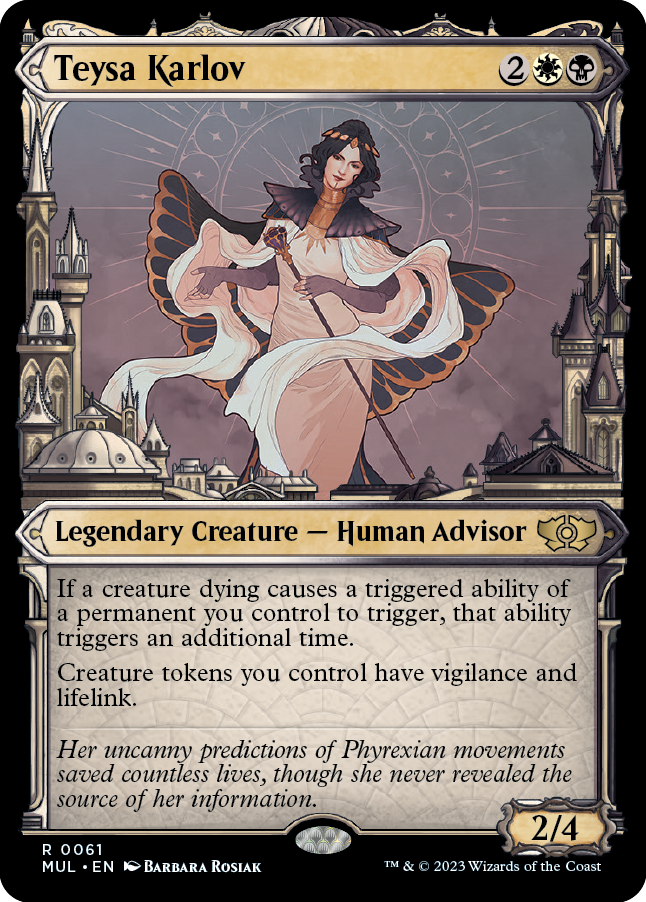
Teysa Karlov
{2}{W}{B}
Legendary Creature — Human Advisor
2/4
If a creature dying causes a triggered ability of a permanent you control to trigger, that ability triggers an additional time.
Creature tokens you control have vigilance and lifelink.
- Teysa affects a creature's own "when this creature dies" triggered abilities as well as other triggered abilities that trigger when that creature dies. Such triggered abilities start with "when" or "whenever."
- Teysa's effect doesn't copy the triggered ability; it just causes the ability to trigger twice. Any choices made as you put the ability onto the stack, such as modes and targets, are made separately for each instance of the ability. Any choices made on resolution, such as whether to pay a cost for that triggered ability, are also made separately.
- The trigger event doesn't have to specifically refer to "creatures." In these cases, the trigger event may also refer to something being "put into a graveyard from the battlefield." For example, an ability that triggers "whenever an artifact is put into a graveyard from the battlefield" would trigger twice if an artifact creature dies while Teysa Karlov is on the battlefield.
- An ability that triggers when a creature "leaves the battlefield" will trigger twice if that creature leaves the battlefield by dying.
- An ability that triggers on an event that causes a creature to die doesn't trigger twice. For example, an ability that triggers "whenever you sacrifice a creature" triggers only once.
- Look at each creature as it exists on the battlefield, taking into account continuous effects, to determine whether any triggered abilities will trigger multiple times. For example, if a land that has become a creature dies, an ability that triggers when it dies triggers twice.
- If a creature dying at the same time that another permanent you control leaves the battlefield causes a triggered ability of that permanent to trigger, that ability triggers an additional time.
- If a creature dying at the same time as Teysa (including Teysa itself dying) causes a triggered ability of a permanent you control to trigger, that ability triggers an additional time.
- If you somehow control two Teysas, a creature dying causes abilities to trigger three times, not four. A third Teysa causes abilities to trigger four times, a fourth causes abilities to trigger five times, and so on. This also means that if you control Teysa and cast a second one, an ability that triggers when it dies due to the "legend rule" triggers three times.
- An ability of a permanent that triggers when a card is put into a graveyard "from anywhere" triggers twice only if Teysa and that permanent are both still on the battlefield immediately after the creature has died.
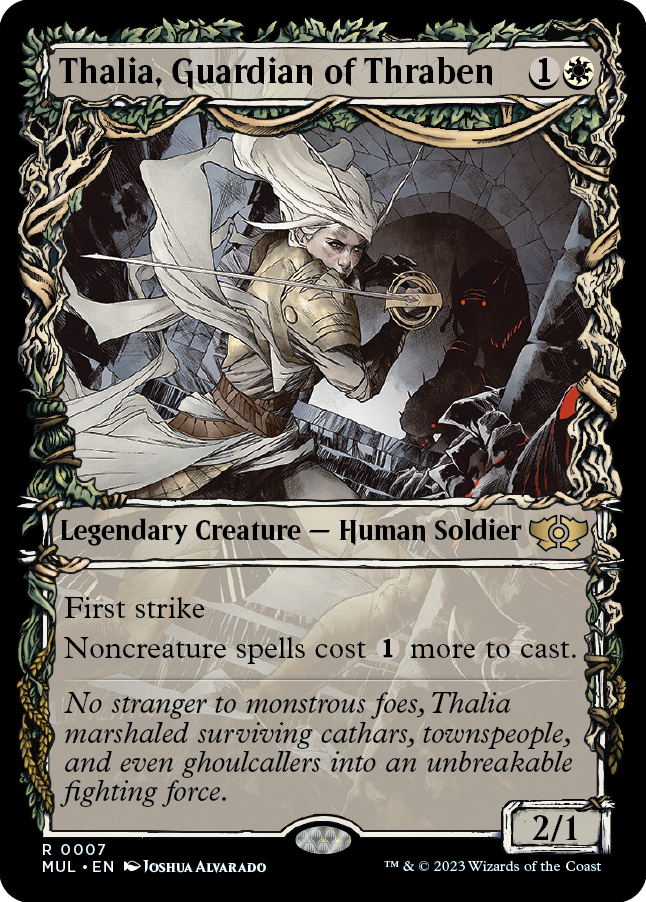
Thalia, Guardian of Thraben
{1}{W}
Legendary Creature — Human Soldier
2/1
First strike
Noncreature spells cost {1} more to cast.
- Thalia's ability affects each spell that's not a creature spell, including your own.
- To determine the total cost of a spell, start with the mana cost or alternative cost you're paying, add any cost increases, then apply any cost reductions. The mana value of the spell remains unchanged, no matter what the total cost to cast it was.
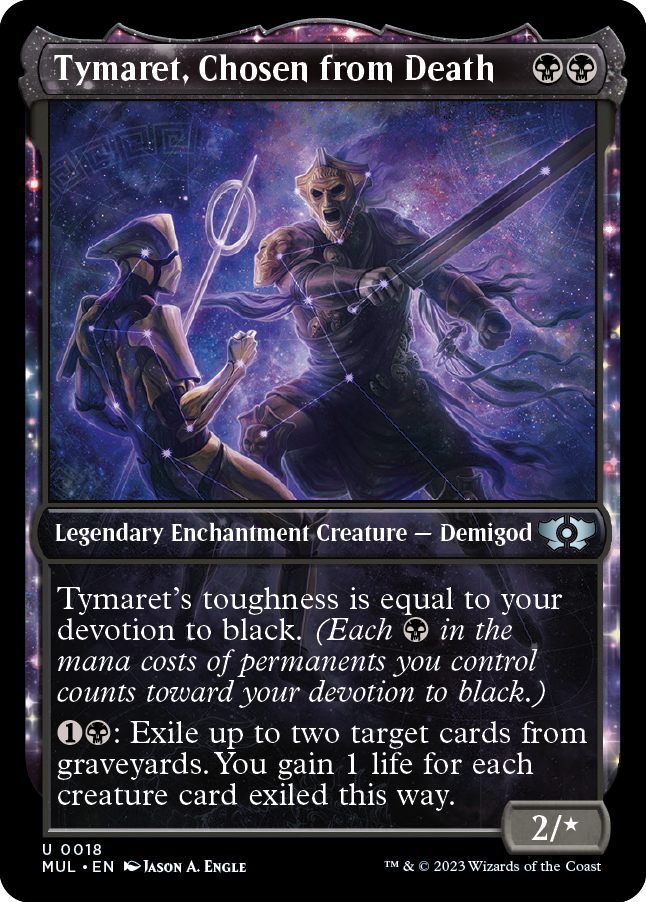
Tymaret, Chosen from Death
{B}{B}
Legendary Enchantment Creature — Demigod
2/*
Tymaret's toughness is equal to your devotion to black. (Each {B} in the mana costs of permanents you control counts toward your devotion to black.)
{1}{B}: Exile up to two target cards from graveyards. You gain 1 life for each creature card exiled this way.
- The ability that defines Tymaret's toughness works in all zones, not just the battlefield. As long as Tymaret is under your control, the two black mana symbols in its own mana cost will count. In most cases, it'll be at least 2/2.
- Colorless and generic mana symbols ({C}, {0}, {1}, {2}, {X}, and so on) in mana costs of permanents you control don't count toward your devotion to any color.
- Mana symbols in the text boxes of permanents you control don't count toward your devotion to any color.
- Hybrid mana symbols, monocolored hybrid mana symbols, and Phyrexian mana symbols do count toward your devotion to their color(s).
- If an activated ability or triggered ability has an effect that depends on your devotion to a color, you count the number of mana symbols of that color among the mana costs of permanents you control as the ability resolves. The permanent with that ability will be counted if it's still on the battlefield at that time.
- If you put an Aura on an opponent's permanent, you still control the Aura, and mana symbols in its mana cost count towards your devotion.
- If you control a battle and an opponent is its protector, you still control the battle, and mana symbols in its mana cost count toward your devotion.
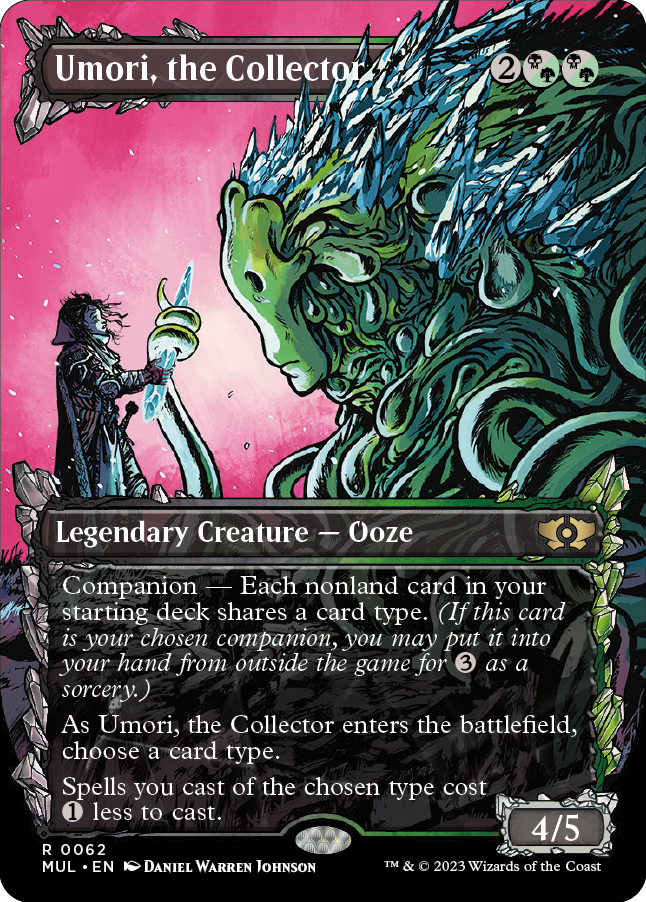
Umori, the Collector
{2}{B/G}{B/G}
Legendary Creature — Ooze
4/5
Companion — Each nonland card in your starting deck shares a card type. (If this card is your chosen companion, you may put it into your hand from outside the game for {3} as a sorcery.)
As Umori, the Collector enters the battlefield, choose a card type.
Spells you cast of the chosen type cost {1} less to cast.
- Umori's last ability doesn't change the mana cost or mana value of any spell. It changes only the total cost you pay.
- That ability can't reduce the amount of colored mana you pay for a spell. It reduces only the generic component of that cost.
- If there are additional costs to cast a spell, or if the cost to cast a spell is increased by an effect (such as the one created by Thalia, Guardian of Thraben's ability), apply those increases before applying cost reductions.
- The cost reduction can apply to alternative costs such as flashback costs.
- If a spell you cast has {X} in its mana cost, you choose the value of X before calculating the spell's total cost. For example, if a spell's mana cost is {X}{R}, you could choose 2 as the value of X and pay {1}{R} to cast the spell.

Urabrask the Hidden
{3}{R}{R}
Legendary Creature — Phyrexian Praetor
4/4
Creatures you control have haste.
Creatures your opponents control enter the battlefield tapped.
- Urabrask the Hidden gives itself haste while it's on the battlefield.
- If a creature an opponent controls enters the battlefield at the same time that Urabrask the Hidden enters the battlefield under your control, Urabrask's effect doesn't apply to your opponent's creature.
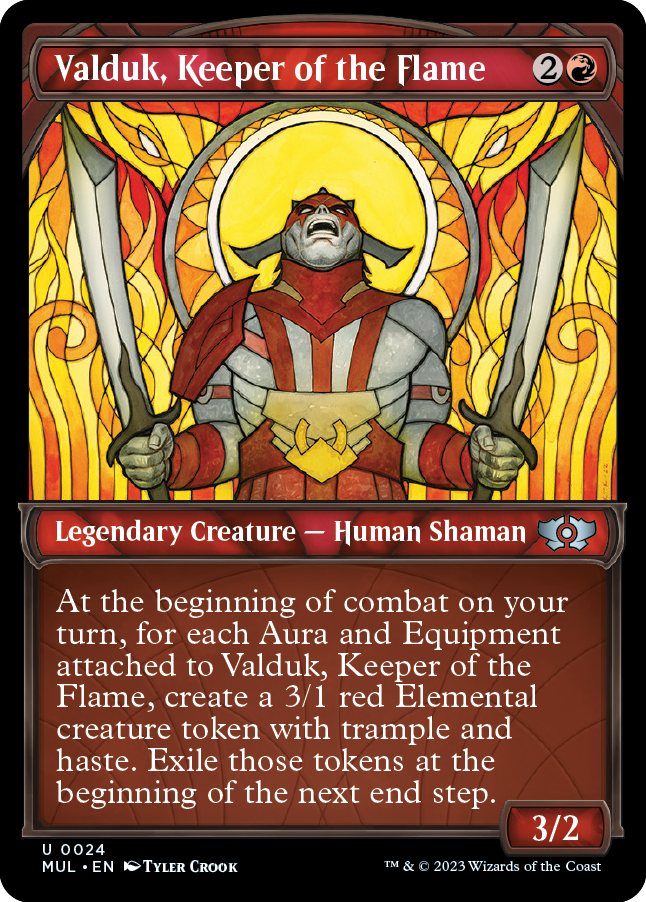
Valduk, Keeper of the Flame
{2}{R}
Legendary Creature — Human Shaman
3/2
At the beginning of combat on your turn, for each Aura and Equipment attached to Valduk, Keeper of the Flame, create a 3/1 red Elemental creature token with trample and haste. Exile those tokens at the beginning of the next end step.
- Valduk counts all Auras and Equipment attached to it, not only Auras and Equipment you control.
- If Valduk leaves the battlefield after its ability has triggered but before it resolves, use the number of Auras and Equipment that were last attached to it before it left the battlefield to determine how many tokens to create.
- If Valduk leaves the battlefield after its ability has resolved, the tokens are still exiled at the beginning of the next end step.
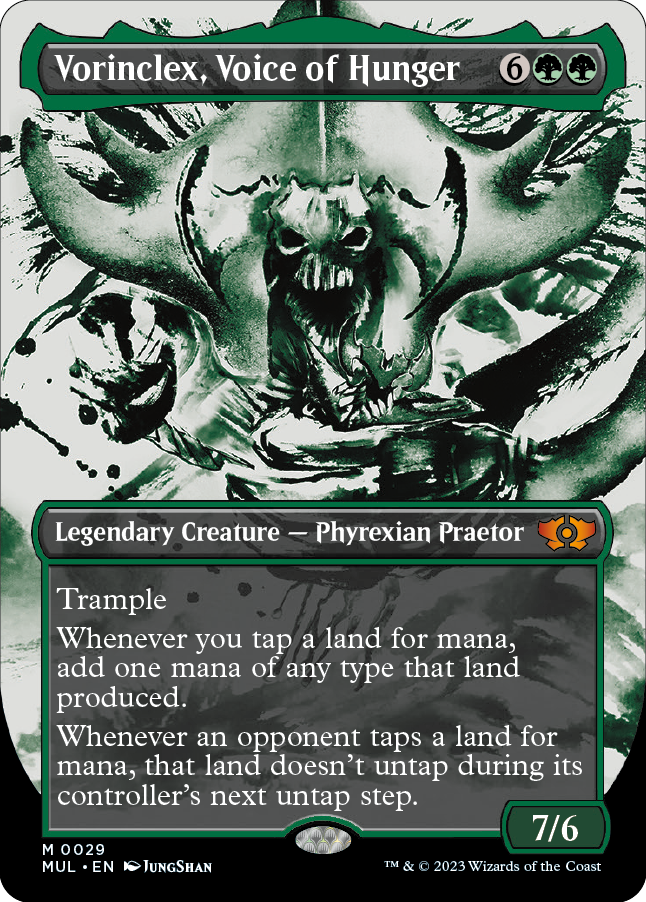
Vorinclex, Voice of Hunger
{6}{G}{G}
Legendary Creature — Phyrexian Praetor
7/6
Trample
Whenever you tap a land for mana, add one mana of any type that land produced.
Whenever an opponent taps a land for mana, that land doesn't untap during its controller's next untap step.
- The types of mana are white, blue, black, red, green, and colorless.
- If a land you control produces multiple mana of more than one type, Vorinclex's first triggered ability adds one mana of only one of those types. You choose which of those types it adds.
- If Vorinclex leaves the battlefield after its second ability has triggered, that ability still resolves and the affected land won't untap during its controller's next untap step.
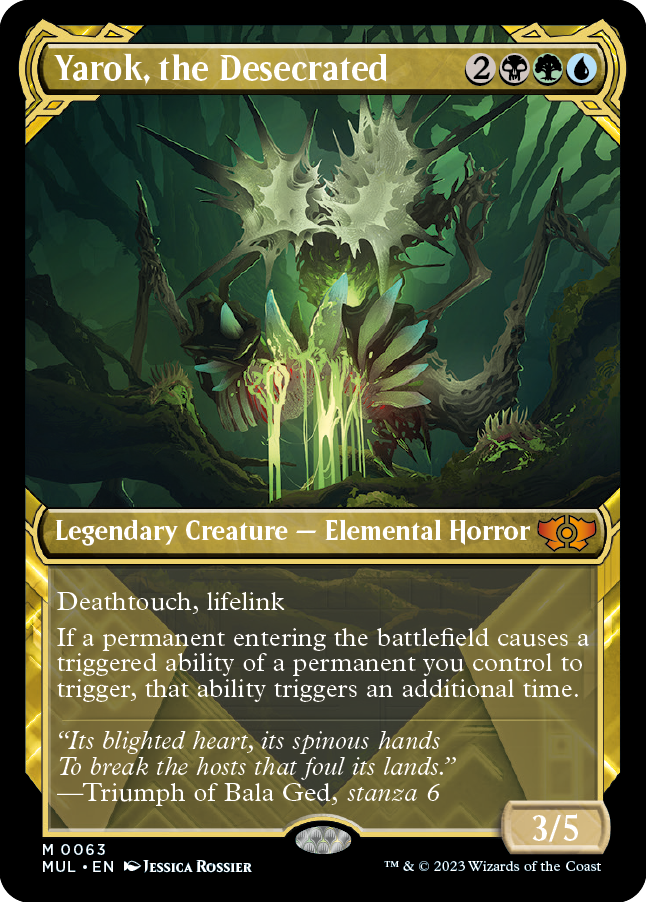
Yarok, the Desecrated
{2}{B}{G}{U}
Legendary Creature — Elemental Horror
3/5
Deathtouch, lifelink
If a permanent entering the battlefield causes a triggered ability of a permanent you control to trigger, that ability triggers an additional time.
- Yarok affects a permanent's own enters-the-battlefield triggered abilities as well as other triggered abilities that trigger when that permanent enters the battlefield. Such triggered abilities start with "when" or "whenever."
- Replacement effects are unaffected by Yarok's ability. For example, a creature that enters the battlefield with one +1/+1 counter on it won't receive an additional +1/+1 counter.
- Abilities that apply "as [this creature] enters the battlefield," such as choosing a color with Diamond Knight, are also unaffected.
- You don't need to control the permanent entering the battlefield, only the permanent that has the triggered ability.
- Yarok's effect doesn't copy the triggered ability; it just causes the ability to trigger twice. Any choices made as you put the ability onto the stack, such as modes and targets, are made separately for each instance of the ability. Any choices made on resolution, such as whether to put counters on a permanent, are also made individually.
- If you somehow control two Yaroks, a permanent entering the battlefield causes abilities to trigger three times, not four. A third Yarok causes abilities to trigger four times, a fourth causes abilities to trigger five times, and so on.
- If a permanent entering the battlefield at the same time as Yarok (including Yarok itself) causes a triggered ability of a permanent you control to trigger, that ability triggers an additional time.
- If a triggered ability is linked to a second ability, additional instances of that triggered ability are also linked to that second ability. If the second ability refers to "the exiled card," it refers to all cards exiled by instances of the triggered ability.
- In some cases involving linked abilities, an ability requires information about "the exiled card." When this happens, the ability gets multiple answers. If these answers are being used to determine the value of a variable, the sum is used. For example, if Elite Arcanist's enters-the-battlefield ability triggers twice, two cards are exiled. The value of X in the activation cost of Elite Arcanist's other ability is the sum of the two cards' mana values. As the ability resolves, you create copies of both cards and can cast none, one, or both of the copies in any order.
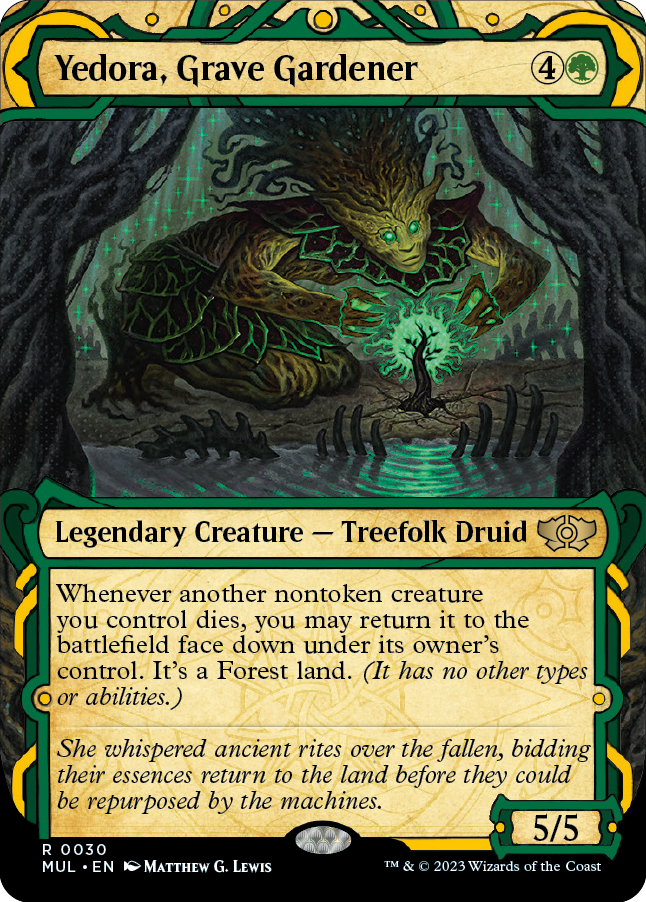
Yedora, Grave Gardener
{4}{G}
Legendary Creature — Treefolk Druid
5/5
Whenever another nontoken creature you control dies, you may return it to the battlefield face down under its owner's control. It's a Forest land. (It has no other types or abilities.)
- The face-down card has no name or colors. Its only type is land, its only subtype is Forest, and its only ability is "{T}: Add {G}."
- If the face-down card has morph, you can pay its morph cost to turn it face up.
- If one of these Forests is turned face up, the effect making it a Forest land will expire. The face-up permanent will again have its printed name, type line, mana cost, abilities, and so on.
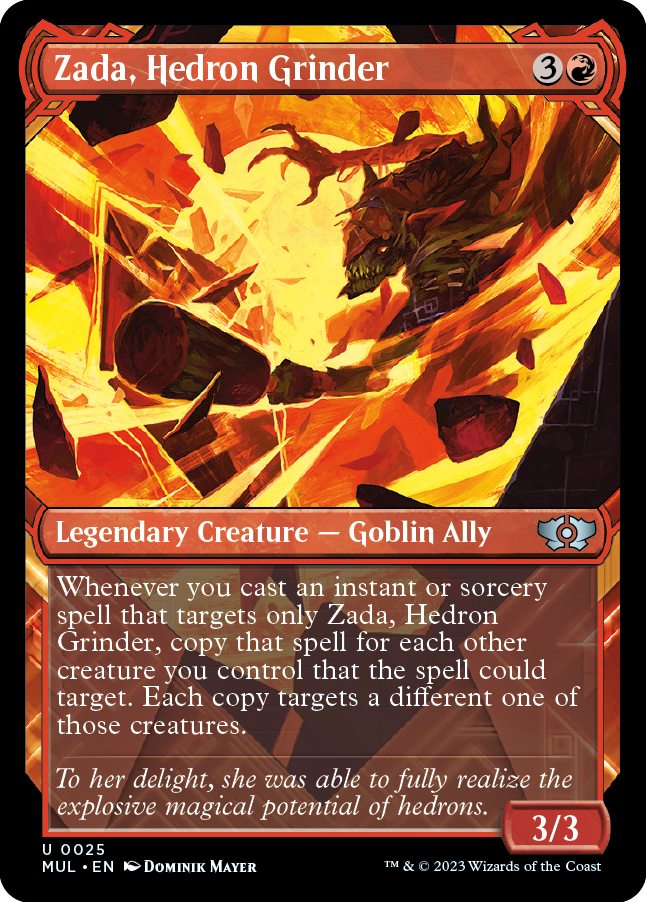
Zada, Hedron Grinder
{3}{R}
Legendary Creature — Goblin Ally
3/3
Whenever you cast an instant or sorcery spell that targets only Zada, Hedron Grinder, copy that spell for each other creature you control that the spell could target. Each copy targets a different one of those creatures.
- Zada's ability triggers whenever you cast an instant or sorcery spell that targets only Zada and no other object or player.
- If you cast an instant or sorcery spell that has multiple targets, but it's targeting only Zada with all of them, Zada's ability will trigger. The copies will similarly each be targeting only one of your other creatures. You can't change any of the copy's targets to other creatures.
- Any creature you control that couldn't be targeted by the original spell (due to shroud, protection abilities, targeting restrictions, or any other reason) is just ignored by Zada's ability.
- You control all the copies. You choose the order the copies are put onto the stack. The original spell will be on the stack beneath those copies and will resolve last.
- The copies that the ability creates are created on the stack, so they're not cast. Abilities that trigger when a player casts a spell (like Zada's ability itself) won't trigger.
- If the spell that's copied is modal (that is, it says "Choose one —" or the like), the copies will have the same mode. You can't choose a different one.
- If the spell that's copied has an X whose value was determined as it was cast (like Rolling Thunder does), the copies have the same value of X.
- The controller of a copy can't choose to pay any alternative or additional costs for the copy. However, effects based on any alternative or additional costs that were paid for the original spell are copied as though those same costs were paid for the copy.
Magic: The Gathering, Magic, Innistrad, Kamigawa, New Capenna, Dominaria, The Brothers' War, and Phyrexia are trademarks of Wizards of the Coast LLC in the USA and other countries. ©2023 Wizards.

